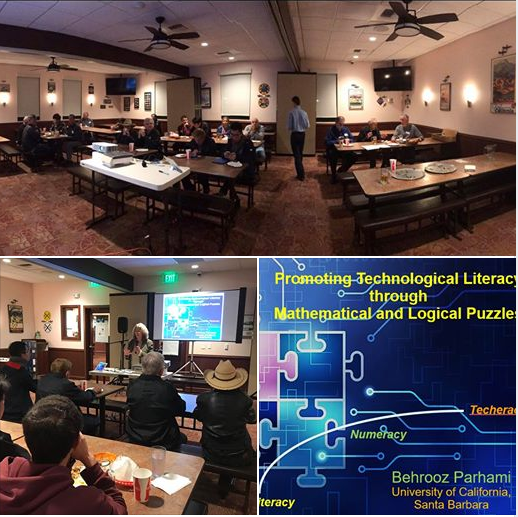
Menu:
Behrooz Parhami's Web Page for IEEE CCS Technical Talks

Institute of Electrical and Electronics Engineers,
California Central Coast Section
(Covering Santa Barbara and San Luis Obispo)
Page last updated on 2023 December 07
This page is now part of IEEE Central Coast Section's history and will no longer be updated. It lists IEEE CCS technical talks for the 5-year period 2019-2023. I established the page as IEEE CCS Education Chair to record our scheduled and planned technical talks and to provide a resource for communication among CCS officers and IEEE members. I continued to update the page throughout 2023, after I had stepped down as IEEE CCS Education Chair.
Direct Links
Activities Under Consideration
Calendar of Technical Talks for 2023
Calendar of Technical Talks for 2022
Calendar of Technical Talks for 2021
Calendar of Technical Talks for 2020
Calendar of Technical Talks for 2019
Previews of Upcoming Events (Chronological order)
Reports on Past Events (Newest-first)
Activities Under Consideration
Short courses: 5G/6G phone systems
Possible tours: UCSB labs; Cal Poly labs; JPL; FLIR Systems; ATK Space Probes
Possible sources of speakers: Skyworks Solutions, Newberry Park;
Observatories: Las Campanas; Mt. Wilson
Calendar of Technical Talks for 2023
IEEE CCS tech talks are usually on the third Wednesday of each month.
01/18 Behrooz Parhami, UCSB, ECE ("Women in Science and Engineering: A Tale of Two Countries")
02/15 Sriram Krishnamoorthy, UCSB, Materials ("Gallium Oxide: Emerging Semiconductor Material for Power Electronics")
03/15 Kristen W. Sneddon, SBCC, EPS ("Sustainability and Resilience: Pedagogy to Policy")
04/19 Nina Miolane, UCSB, ECE ("Geometric Learning for Shape Analysis from Bioimaging Data")
05/17 Behrooz Parhami, UCSB, ECE ("Lagrange Points and Their Significance to Space Applications")
06/21 Kedar Madineni, Teledynt FLIR ("Solving Real-World Problems Using Thermal Imagery and AI Algorithms")
07/19 Ambuj Singh, UCSB, CS ("From Brain to AI/ML and Back")
08/16 Gregory C. Dyer, Resonant ("XBAR and the 5G Acoustic Filter Landscape")
09/20 Brad Paden, LaunchPoint ("Adventures in Mechatronics")
10/18 Wayne Rothermich, Retired from Seymour Duncan ("The Physics of Electric Guitar Pick-Ups")
11/15 William S. Dinklage, SBCC, EPS, and Stephen Honikman, Electriq Power ("Microgrids in the Goleta Load Pocket and Their Role in the Green Energy Revolution")
12/06 Paul Leonardi, UCSB, Technology Management ("Helping Employees Succeed with Generative AI")
Calendar of Technical Talks for 2022
01/19 Behrooz Parhami "Interconnection Networks for Parallel Processors and Data Centers")
02/16 UCSB Physics Circus ("Fun, Informative Electricity and Other Physics Demos"), bring the kids!
03/16 Tim Sherwood, UCSB, CS ("Temporal Computing: From Machine Learning to Superconducting Logic")
04/20 Sumita Pennathur, UCSB, ME ("MEMS-Based Innovations for Optimized Management of Type I Diabetes")
05/18 Nina Miolane, UCSB, ECE (postponed to October 19, 2022)
05/18 Behrooz Parhami, UCSB, ECE ("Hybrid Digital-Analog Number Representation in Computing and in Nature")
06/15 William Wang, UCSB, CS ("Self-Supervised Language-and-Vision Reasoning")
07/20 Yufei Ding, UCSB, CS ("Full-stack System Optimization for Quantum Computing")
08/17 Lei Li, UCSB, CS ("Breaking the Language Barrier with Neural Machine Translation")
09/08 IEEE panel on LinkedIn ("IEEE 5G Demystified: Hype vs. Reality of 5G")
09/13 John C. Mather, Nobelist ("Opening the Infrared Treasure Chest with JWST")
09/21 Somayeh Dodge, UCSB, Geography ("Movement Data Science for Human Mobility and Animal Ecology Applications")
10/01-31 Ten IEEE courses available at the discount rate of $10 each through the end of October
10/19 Behrooz Parhami, UCSB, ECE ("A Realistic Assessment of Intelligent Behavior and Machine Learning")
11/16 Leonard Chen, Raytheon, Goleta ("Sensing Across the Infrared Spectrum")
12/20 Roland Geyer, UCSB, Bren School ("The Business of Less: The Role of Companies and Households on a Planet in Peril")
Calendar of Technical Talks for 2021
01/20 Misha Sra, UCSB, CS (Title: "Perceptual Engineering")
02/17 Kerem Camsari, UCSB, ECE (Title: "Understanding Quantum Computing Through Negative Probabilities")
02/22 Valerie E. Taylor (Special event, courtesy of IEEE Santa Clara Valley Section)
03/17 Behrooz Parhami (Title: "Eight Key Ideas in Computer Architecture from Eight Decades of Innovation")
04/21 Ramtin Pedarsani (Title: "Efficient Transportation in the Face of a Pandemic")
05/03 Li-C. Wang (Title: "Machine Learning for Test Data Analytics")
05/04 Momin Quddus (Title: "Bitcoin, Blockchain & Cryptocurrency in Simple Terms")
05/19 Farinaz Koushanfar (Title: "Machine Learning on Encrypted Data: Hardware to the Rescue")
06/16 Momin Quddus (Title: "Bitcoin, Blockchain & Cryptocurrency, in Simple Terms")
07/21 Momin Quddus (Title: "EV Technology and Its Implications on Climate Change")
08/18 Faramarz Davarian (Title: "Connecting with the Moon: Can We Provide Communications Connectivity for Human Presence on the Moon Similar to What We Have on Our Planet?")
09/15 Jared Call, Eve J. Pereira, Harvey Elliott (Title: "Connecting with Mars: The Evolution of Relay Telecommunication Networks for Mars")
09/18 Dan Hart (Title: "The New Era of Space Architecture"), sponsored by IET
09/30 Behrooz Parhami (Title: "Eight Key Ideas in Computer Architecture from Eight Decades of Innovation"), IEEE Computer Society DVP Program
09/30 Behrooz Parhami (Title: "Recursive Synthesis of Digital Circuits"), IEEE Computer Society DVP Program
10/20 Tevfik Bultan (Title: "Software, Logic, and Security")
10/24-27 International (Virtual) Conference on Computer Design (free for everyone)
11/11 Behrooz Parhami (Title: "Eight Key Ideas in Computer Architecture from Eight Decades of Innovation"), IEEE CS DVP Program & IEEE Denver Section
11/17 Megan Valentine (Title: "Exceptional Soft Materials, Inspired by Nature")
12/15 Kristin Bell (Title: "Bringing Entrepreneurial Ideas to Life to Build and Scale New Businesses")
Calendar of Technical Talks for 2020
[Events on the third Wednesday of each month, unless otherwise noted; Click on the date for details]
01/15 Payam Heydari, UC Irvine ("Shattering Fundamental Design Barriers of End-to-End Ultrahigh Data-Rate Transceivers: Direct Modulation in RF Domain")
02/03 Special Monday event: 3D-printer demo at Goleta Public Library, 500 N. Fairview, Goleta, 5:30 PM
02/19 Jerry Gibson, UCSB, ECE ("Compression of Everything")
03/18 Aycan Hacioglu ("Data Analysis and Visualization with MATLAB for Beginners"), on-line, 5:30-8:00 PM
04/15 (postponed) Chandra Krintz, UCSB, CS ("Advancing Agriculture and Conservation Science with the Cloud and Big Data Analytics")
05/20 (postponed) Ramtin Pedarsani, UCSB, ECE (Area: Self-driving cars)
04-07 Selected Webinars: Alternative learning opportunities for the stay-at-home and social-distancing period
06/17 Di Liang, HP Enterprise ("Photonics in High-Performance Computing")
07/15 (postponed) Sumita Pennathur, UCSB, ME (Area: bioeng., nanotech, thermal sci., fluid mech.)
07/15 Behrooz Parhami, UCSB, ECE ("Recursive Synthesis of Digital Circuits: Advantages and Examples")
08/19 Eckart Meiburg, UCSB, ME ("Modeling the Pacific Ocean on the Computer")
09/16 Luke Theogarajan, UCSB, ECE ("Electronics Meets Biology")
10/21 Yangying Zhu, UCSB, ME ("Microscale Thermal-Fluids Engineering for Next-generation Energy and Electronic Systems")
11/18 Rich Wolski, UCSB, CS ("Experiences with IoT and The New Internet as a Platform of Things")
12/09 Mark Goldstein, IEEE CS Phoenix Chapter ("Next-Generation Wireless Overview & Outlook")
12/16 Jessica Santana, UCSB, TMP ("Using Natural Language Processing to Measure Ethical Convergence in Scientific Discourse")
Calendar of Technical Talks for 2019
[Events on the third Wednesday of each month; Click on the date for details]
02/20 Behrooz Parhami, UCSB ("Promoting Technological Literacy through Mathematical and Logical Puzzles")
03/20 Walter L. Whipple, former Chair of IEEE CCS ("Job Shopping for Fun and Profit")
04/17 Pradeep Sen, UCSB ("Monte Carlo Denoising")
05/15 Katie Byl, UCSB ("Mesh-Based Tools to Analyze Deep Reinforcement Learning Policies for Underactuated Biped Locomotion")
06/19 B. S. Manjunath, UCSB ("Computer Vision, Deep Learning and Big Data: Opportunities and Challenges")
07/17 Dmitri Strukov, UCSB ("Alternative Computing with Memristors")
08/21 Tali Freed, Cal Poly SLO ("UAV-RFID for Outdoor Applications")
09/18 Yasamin Mostofi, UCSB ("Robotics Meet Wireless Communications: Opportunities and Challenges")
10/16 Mahnoosh Alizadeh, UCSB ("Sustainable Electric Transportation Systems")
11/20 Roger Helkey, UCSB ("Using Photonics to Make More Energy Efficient Data Centers & Communication")
12/18 Dennis Horwitz, Micronor Inc. ("Awesome Photons—A Fiber Optic Technology Update"), joint with ASME
Previews of Upcoming Events
Speaker to be rescheduled: Nicholas Hogasten
Affiliation: Teledyne FLIR Systems
Title: "Video Signal Processing for Thermal Imaging Applications"
Date/Time: Originally scheduled for Wednesday, October 18, 2023 (to be rescheduled)
Venue: TBD
Links: Event page & registration (forthcoming)
Preview: Thermal Imaging presents its own set of interesting video signal processing problems. In this talk we will review some of them and look at potential solutions. The main purpose of the presentation is to get students or early career scientist excited about the possibilities of thermal imaging but anyone curious about sensing in more exotic wavebands should learn something. We will cover some basics on why thermal imagers have different properties and problem sets than typical reflected light imagers and some signal reconstruction solutions to overcome those problems. We will also look at some physical world phenomenology for which LWIR/MWIR imagers are particularly well suited. All topics will be illustrated with images and videos.
Speaker's bio: Nicholas Hogasten is a transplanted Swede living with his wife and two college-age daughters in Santa Barbara, CA. He has 20+ years of experience in thermal imaging and is currently a Technical Fellow serving as Head of Digital at Teledyne FLIR in Goleta, CA. He has functioned in numerous senior technical leadership position at FLIR & Teledyne FLIR, is an inventor on more than 80 issued US patents, and has co-authored two peer-reviewed papers. Most of his technical contributions are in the field of video signal processing but also include optics, systems, and ROIC design. His technical interests are broad and include multispectral applications, computational imaging, and AI. When not working he enjoys hiking (leisurely), cooking (eclectically), and dancing Argentine tango (with great difficulty).
Reports on Past Events
December 2023 speaker: Dr. Paul Leonardi
Affiliation: UCSB Department of Technology Management
Title: "Helping Employees Succeed with Generative AI"
Date/Time: Wednesday, December 06, 2023, 6:30 PM
Venue: Mulligan's Cafe at Santa Barbara Golf Club, 3500 McCaw Ave.
Links: Registration & event page; Speaker's Web site
The venue for this year's holiday banquet and tech talk was Mulligan's Cafe & Bar at Santa Barbara Golf Club. After a cocktail hour with hors d'oeuvres, dinner was served. The guest speaker, Dr. Paul Leonardi, Duca Family Professor & Chair of UCSB's Technology Management Department, spoke under the title "Helping Employees Succeed with Generative AI."
Recent news stories tout the productivity-amplifying and time-saving potential of generative AI tools like ChatGPT. But the reality is that most companies are not seeing such gains. Leonardi outlined the unique challenges that large language models (LLMs) present, including the fact that, by the very nature of their design, they're constantly changing.
Leonardi explained his practical STEP framework, which he developed by working with top companies that have successfully implemented GenAI to empower employees. He discussed how to create new avenues for value creation through improving employee experiences and turning attractive productivity numbers from potential into reality.
Speaker's bio: Paul Leonardi is the Duca Family Professor of Technology Management at UC Santa Barbara and Chair of the Department of Technology Management. His research, teaching, and consulting focus on helping companies to create and share knowledge more effectively. To do this, he examines on how implementing new technologies and harnessing the power of informal social networks can help companies take advantage of their knowledge assets to create innovative products and services. He is a frequent speaker on topics of innovation, change management, leading remote and global teams, and market validation. In addition to speaking and consulting, he has published over 80 articles and chapters in peer-reviewed journals and management outlets, including Harvard Business Review and Sloan Management Review. His latest book, The Digital Mindset: What it Takes to Thrive in the Age of Data, Algorithms, and AI, presents two decades worth of research into the skills that lead to performance and innovation in today's workplace.
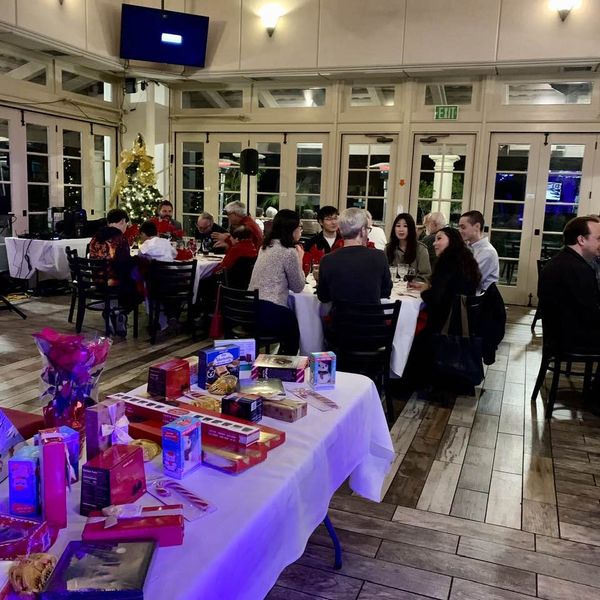
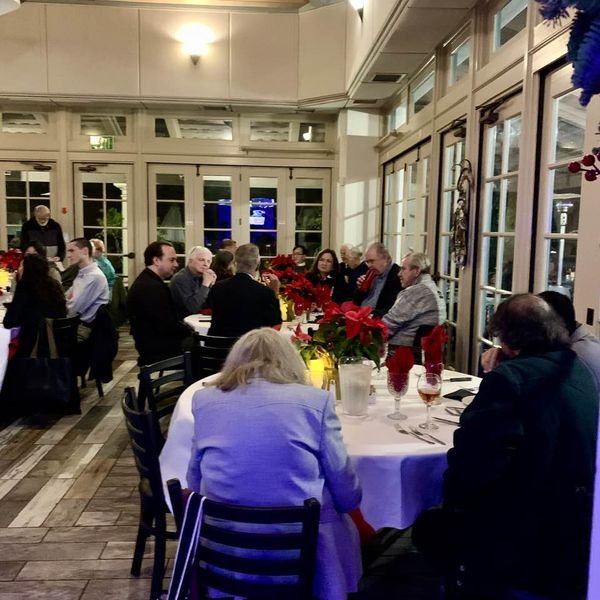
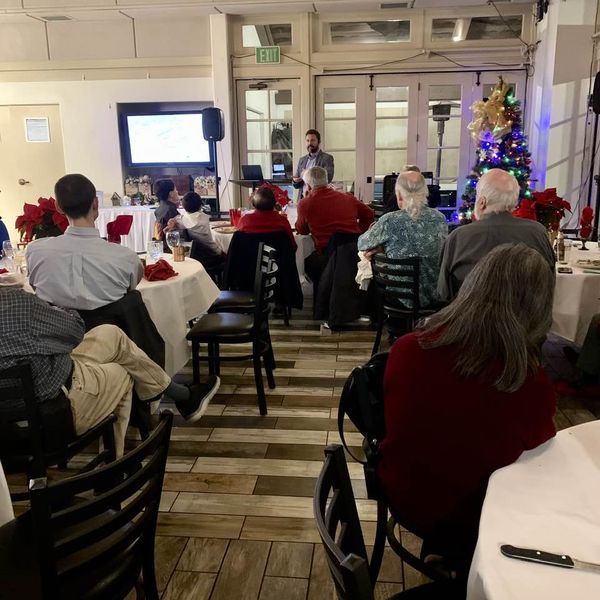
November 2023 speakers: William S. Dinklage & Stephen Honikman
Affiliation: Santa Barbara City College EPS & Electriq Power
Title: "Microgrids in the Goleta Load Pocket and Their Role in the Green Energy Revolution"
Date/Time: Wednesday, November 15, 2023, 6:00 PM
Venue: Rusty's Pizza events room, 5934 Calle Real, Goleta, CA (also via WebEx)
Links: IEEE CCS event page
The Goleta Load Pocket is the segment of the Western grid between Gaviota and Lake Casitas, served mainly by two 220 kV transmission lines from Ventura that cross over the Santa Ynez Range into Goleta. Three big problems with this are that 1) the entire service region is vulnerable to power outage through natural disaster or Public Safety Power Shutoffs (PSPS events); 2) while the City and County of Santa Barbara can obtain renewable generated electricity through the relevant Community Choice Aggregation service providers this does nothing to provide resilience in the event of widespread outage and doesn't specifically advance local/rooftop residential or commercial solar installation and much of the Goleta Load Pocket is still reliant on non-locally generated electricity; 3) For SB to achieve carbon neutrality by its goal of 2035 it will have to have replaced its cars and trucks with electric vehicles, likely more than doubling its electricity consumption and putting more strain on the current transmission and distribution system to and within the Goleta Load Pocket.
In this talk you will learn how solar microgrids, including behind-the-meter microgrids and larger, community microgrids can solve these problems. Two of the largest behind-the-meter microgrids in the Goleta Load Pocket are the rooftop solar array and battery storage system at Direct Relief and fourteen locations within the Santa Barbara Unified School District. The Energy and Natural Resources class at SBCC is currently examining the feasibility of building a solar microgrid on the SBCC campus. The City of Santa Barbara, with help from Electriq Power, has established Santa Barbara Home Power, which will help to finance low and moderate income residences to develop residential microgrids. Ultimately, a large community microgrid could serve the entire Goleta Load Pocket, but this will require communication among all the behind-the-meter microgrids, and the current regulatory framework does not support this. This talk will discuss some of these developments and their contributions to greening the energy supply in the Goleta Load Pocket and will illuminate some of the challenges in continuing to move forward.
October 2023 speaker: Wayne Rothermich
Affiliation: Retired from Seymour Duncan
Title: "The Physics of Electric Guitar Pick-Ups: A Tale of Six Magnets and a Coil"
Date/Time: Wednesday, October 18, 2023, 6:00 PM
Venue: Rusty's Pizza events room, 5934 Calle Real, Goleta, CA (also via WebEx)
Links: IEEE CCS event page
Nicholas Hogasten (Teledyne FLIR) was to speak under the title "Video Signal Processing for Thermal Imaging Applications." Due to the speaker not showing up, Wayne Rothermich, who has retired from Seymour Duncan, gave an impromptu talk about guitar pick-ups, viz., electronic devices that convert string vibrations to electric currents that are supplied to amplifiers.
There are many different kinds of guitar pick-ups, which differ in sound quality and other audio parameters. With metal strings, magnets are used to pick up the vibrations. In the case of acoustic guitars featuring non-metal strings, other methods, such as those based on piezoelectric properties, are used. A guitar may be outfitted with multiple pick-ups, which would allow the player to switch between them or use a combination of their outputs.
Master guitar players may order custom pick-ups according to their personal preferences. They bring their ideas to special technical advisers who translate them to appropriate pick-up designs. These custom orders usually cost several times the typical ~$100 mass-produced pick-up models.
Overall, this was a highly-informative impromptu talk. IEEE CCS has been experimenting with WebEx streaming of its technical talks for the benefit of those who cannot attend in person. I was a beneficiary of this option tonight. The sound quality was quite good after the talk began, but Images were fuzzy at times.
[Seymour Duncan Web site] [Seymour Duncan post about Wayne Rothermich]
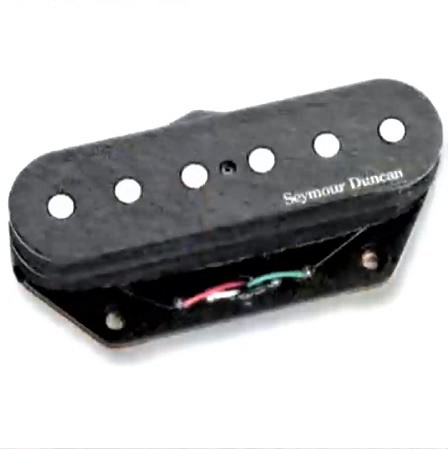
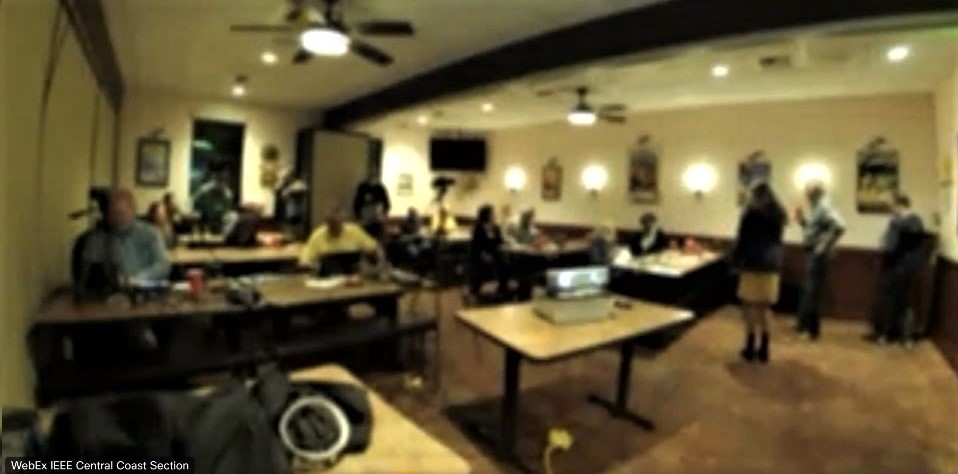
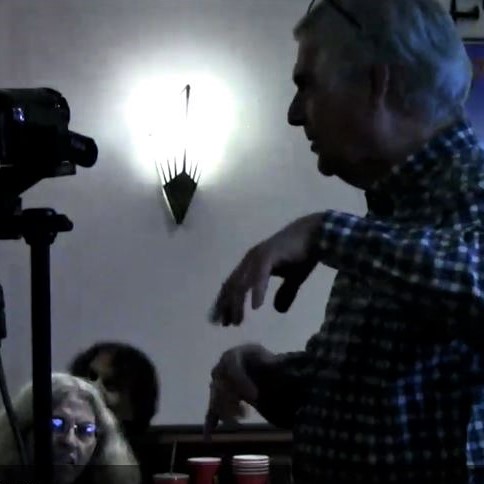
September 2023 speaker: Dr. Brad Paden
Affiliation: Chief Scientist & Co-Founder of LaunchPoint Electric Propulsion Solutions
Title: "Adventures in Mechatronics"
Date/Time: Wednesday, September 20, 2023; 6:00 PM
Venue: Rusty's Pizza events room, 5934 Calle Real, Goleta, CA
Links: IEEE CCS Event page
Dr. Brad Paden (Chief Scientist & Co-Founder of LaunchPoint Electric Propulsion Solutions; UCSB Emeritus Professor of Mechanical Engineering) spoke under the title "Adventures in Mechatronics." There were 32 in-person attendees and a few tuning in via WebEx.
The talk's focus was on the creativity and challenges associated with the invention and design of mechatronic devices. Example systems included a maglev transportation system, a guided-catheter system, an oxygen concentrator, maglev artificial hearts, high-speed switching mechanisms including an electronic engine valve, high-power-density motors, and an energy storage system, along with blue-sky ideas such as electromagnetic launch. While modeling, control and optimization are essential ingredients in mechatronic systems, the large design and application spaces of mechatronic systems compel us to place a high value on innovation at the level of system architectures. This point was illustrated throughout the talk.
Speaker's bio: Dr. Brad Paden is Chief Scientist & Co-Founder of LaunchPoint Electric Propulsion Solutions and a Fellow of IEEE, ASME, and AIMBE. He also serves as a Technical Advisor to Seismic Capital and Gravity Power. Dr. Paden is Emeritus Professor in UCSB Department of Mechanical Engineering. His expertise includes nonlinear control theory, electric machine design, and robotics. Dr. Paden was a Visiting Fellow with the Department of Mathematics, University of Western Australia, in 1988. He received the Kalman Best Paper Award from ASME Journal of Dynamic Systems, Measurement, and Control in 1993, the IEEE Control System Society Technology Award in 2001, and the ASME Dynamic Systems and Control Division Charles S. Draper Award for Innovative Practice in 2010. He has co-authored over 100 technical papers and 24 patents, which can be found on Google Scholar. Dr. Paden received BS, MS, and PhD degrees in Electrical Engineering and Computer Science from UC Berkeley, in 1978, 1982, and 1985, respectively.
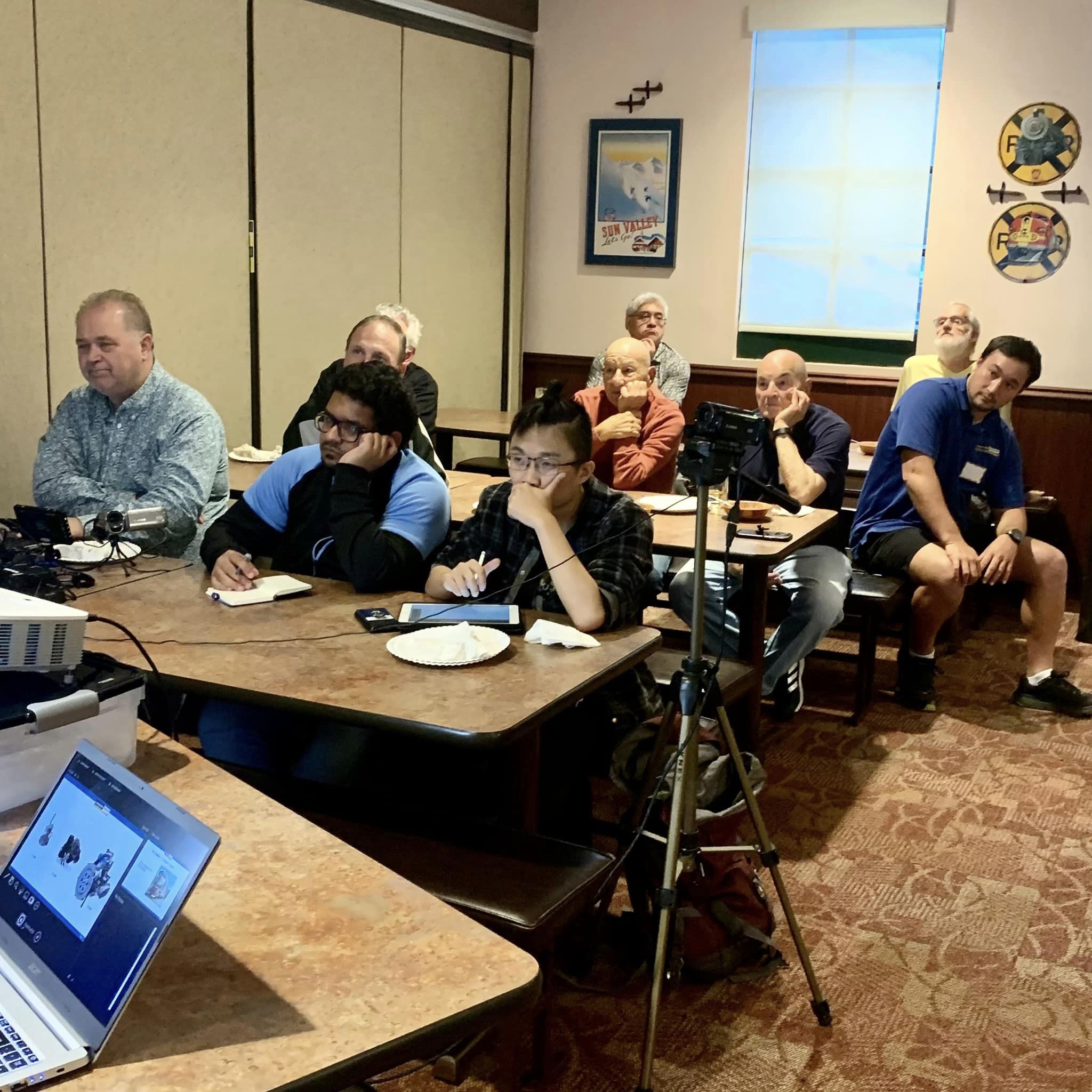
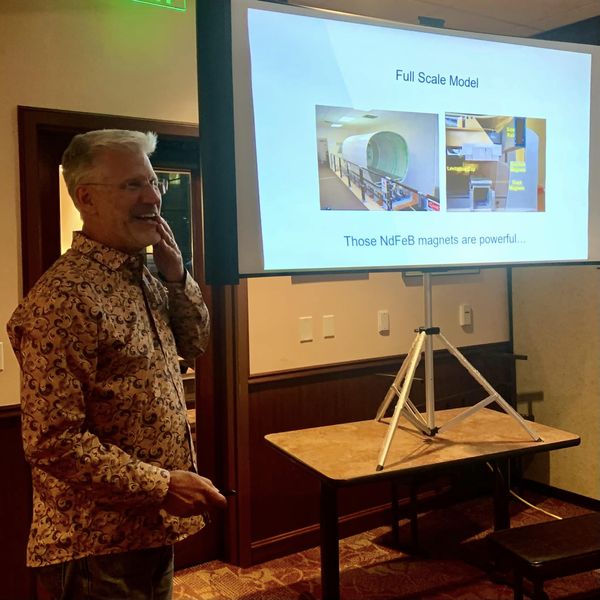
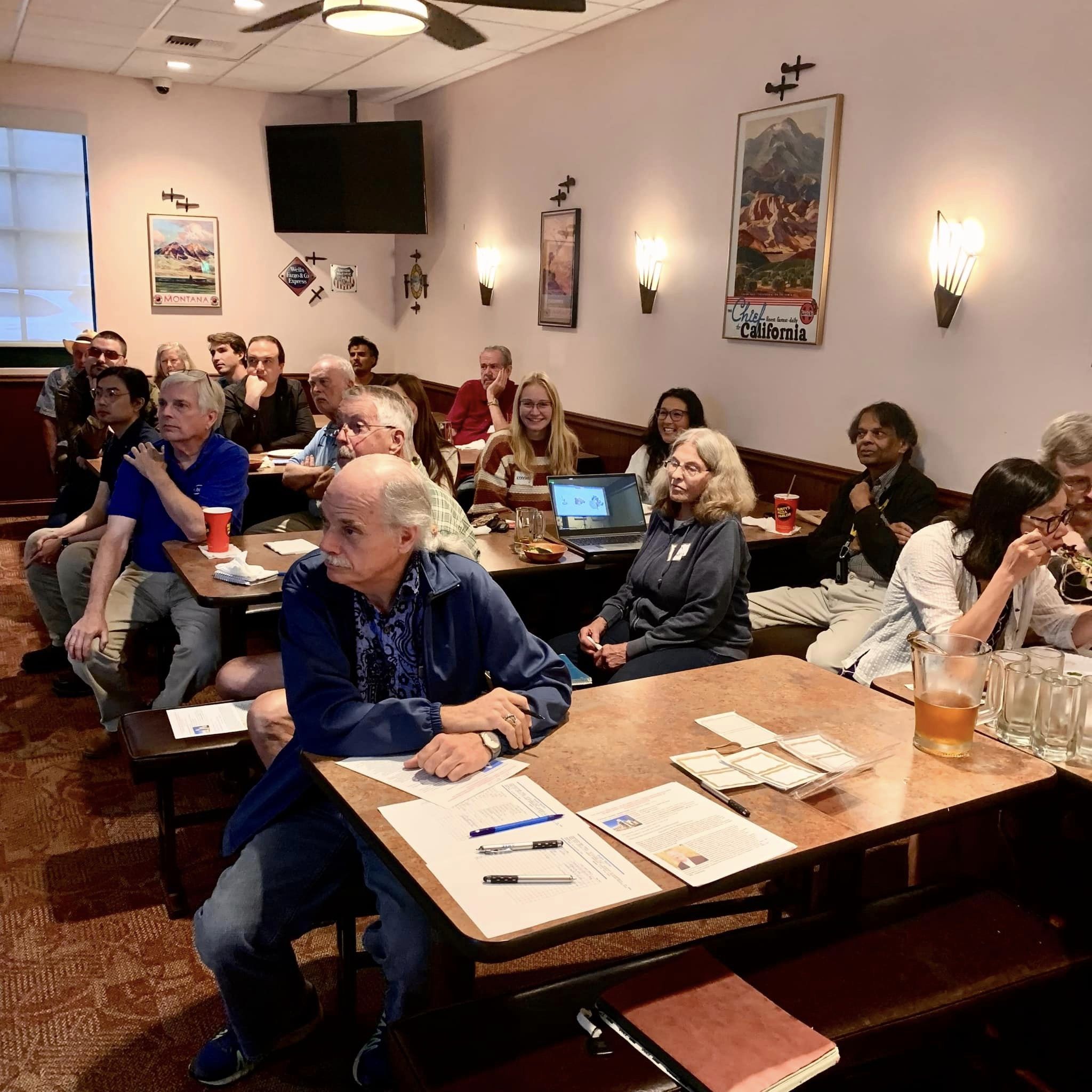
August 2023 speaker: Dr. Gregory C. Dyer
Affiliation: Principal Device Engineer and Manager at Resonant, a Murata Company
Title: "XBAR and the 5G Acoustic Filter Landscape"
Date/Time: Wednesday, August 16, 2023; 6:00 PM
Venue: Rusty's Pizza events room, 5934 Calle Real, Goleta, CA
WebEx link for on-line attendance: Provided to those who register
Links: IEEE CCS event page (Registration & info)
This event was hybrid: In-person at Rusty's Pizza in Goleta and on-line via WebEx.
Acoustic filters are foundational components of the radio frequency front end (RFFE) modules that enable today's compact, high performance, wide bandwidth mobile phones. These passive devices are composed of acoustic resonator networks that have a high selectivity, low-loss bandpass RF filter response. Additionally, state-of-the-art acoustic filters have footprints of less than 1 square millimeter while operating at input power levels on the order of 1 Watt. In this talk, Dr. Dyer surveyed the core acoustic filter technologies, with an emphasis on transversely excited bulk acoustic resonator (XBAR) filters. He discussed acoustic resonator and filter physics and highlighted the differentiating attributes that the XBAR technology provides for Fifth Generation (5G) telecommunications and beyond.
I had to leave the event early to make it to another meeting, so the report above is based on the speaker's abstract.
Speaker's Bio: Dr. Gregory C. Dyer is a Principal Device Engineer and Manager at Resonant, a Murata Company. He holds a BA degree in physics and Russian from Grinnell College and a PhD in condensed matter physics from UCSB. He has over a decade of experience with research laboratories and in industry product development, spanning the electromagnetic spectrum from VHF to infrared, at both the component and system levels. He is currently a core team member in the development of transversely excited bulk acoustic resonator (XBAR) filters that achieve best-in-class loss, selectivity, and power performance. His research interests have encompassed RF acoustic filters and sensors, low dimensional electronic structures, applied electromagnetics, and THz and mmWave detectors and devices. He has authored 14 peer reviewed manuscripts and has more than two dozen patents pending in the domain of RF, mmWave, and THz device physics.
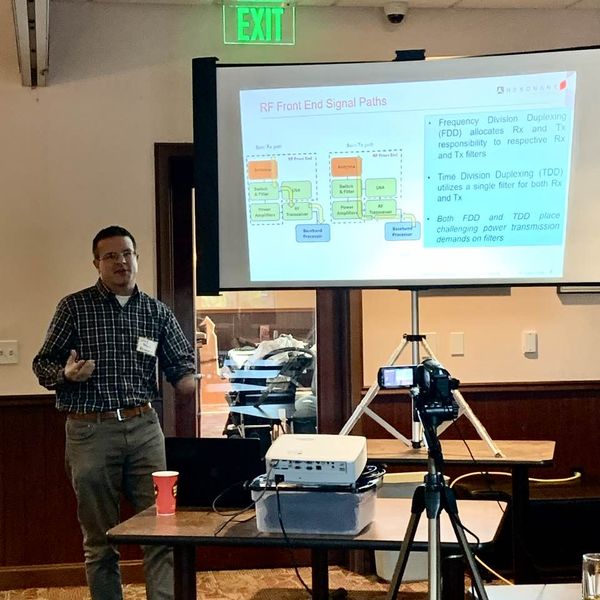
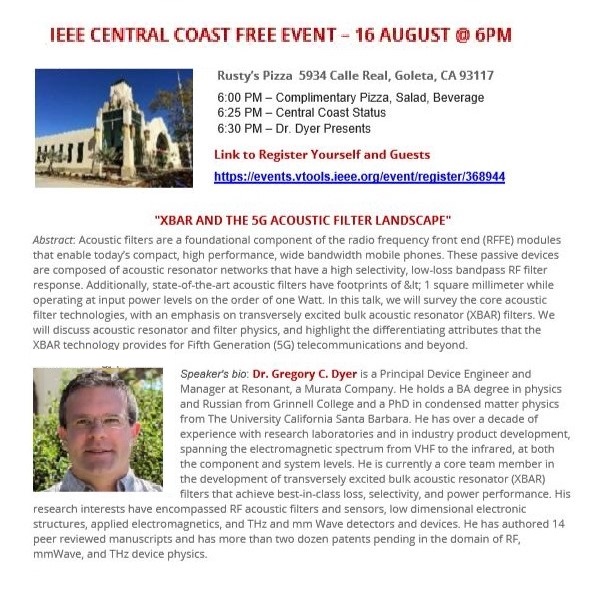
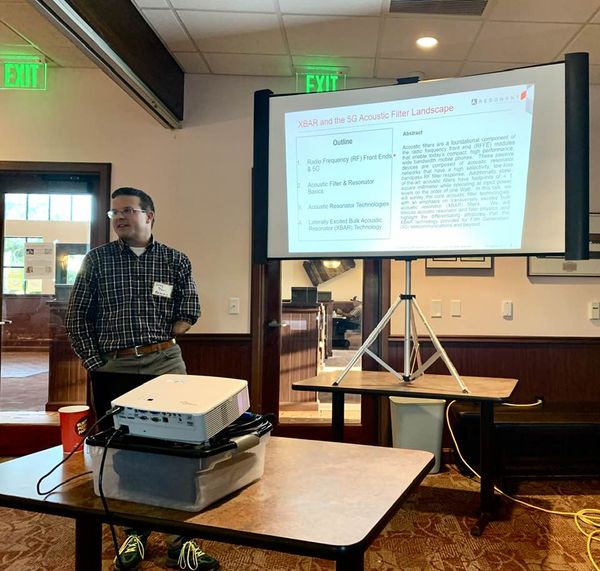
July 2023 speaker: Dr. Ambuj Singh
Affiliation: UCSB Computer Science Department
Title: "From Brain to AI/ML and Back"
Date/Time: Wednesday, July 19, 2023; 6:00 PM
Venue: Rusty's Pizza events room, 5934 Calle Real, Goleta, CA
Links: IEEE CCS event page; Speaker's Web page
UCSB Distinguished Professor of Computer Science Dr. Ambuj Singh spoke under the title "From Brain to AI/ML and Back." There were ~25 in-person attendees and a few connecting via a trial Zoom set-up, with some limitations, being tried for the first time, in the hopes of making future events hybrid to allow broader participation of members in our vast geographic region.
Artificial intelligence and machine learning (AI/ML) have been extremely successful in predicting, optimizing, and controlling the behavior of complex interacting systems. Robustness and explainability of existing AI/ML methods, however, remain big challenges, and clearly new approaches are needed. The human brain motivated the early development of the field of deep learning and neuroscientific concepts have contributed to the profound success of deep learning algorithms across many areas.
The next leap in AI/ML may again come from a deeper understanding of modularity, robustness, and adaptability of brain architectures. Some of the challenges along this goal are to analyze and integrate heterogeneous brain signals across modalities, tasks, and subjects; decipher brain organizational structures; engineer novel deep learning architectures; and apply the insights into platforms that can effectively interact, support, and collaborate with humans.
Dr. Singh discussed some recent methods that integrate multimodal brain data to infer brain subnetworks, understand heterogeneity, learn representations of dynamic brain signals, and reconstruct complex high-fidelity imagery from input brain signals. Dr. Singh's group used data from an experimental set-up that included many individuals being exposed to different images, with their brain activities monitored via fMRI. It was demonstrated that the process is reversible (that is, converting the signals to images) with surprisingly high fidelity. Details can be found in the paper cited and linked below.
Reference: Lin, S., T. Sprague, and A. K. Singh, "Mind Reader: Reconstructing Complex Images from Brain Activities," Proc. 36th Conf. on Neural Information Processing Systems, 2022. [PDF]
Speaker's Bio: Ambuj K. Singh is a Distinguished Professor of Computer Science at UCSB, with a part-time appointment in the Biomolecular Science and Engineering Program. He received a B.Tech. degree from Indian Institute of Technology, Kharagpur, and a PhD degree from University of Texas at Austin. His research interests are broadly in the areas of network science, machine learning, social networks, and bioinformatics. He has published 250 technical papers over his career. He has led several multidisciplinary projects including UCSB's Information Network Academic Research Center funded by the US Army, NSF-funded Interdisciplinary Graduate Education Research and Training (IGERT) program on Network Science, and the Multidisciplinary University Research Initiative (MURI) on Network Science of Teams funded by US Army. He has worked with over 50 graduate and postdoctoral students over his career, including over 30 PhD students.
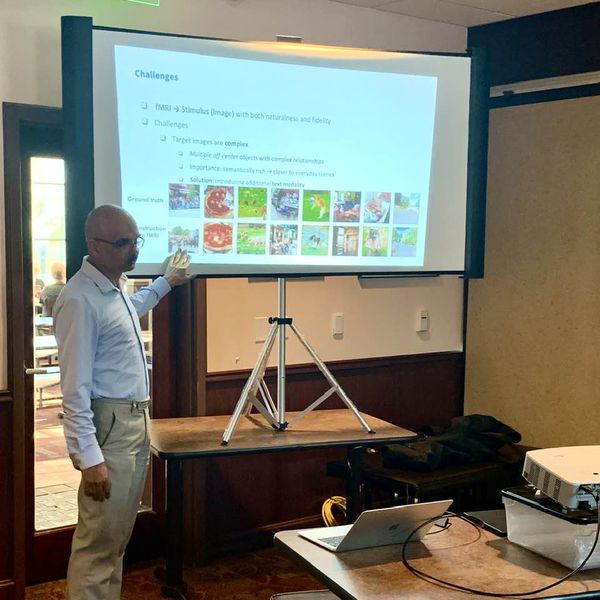
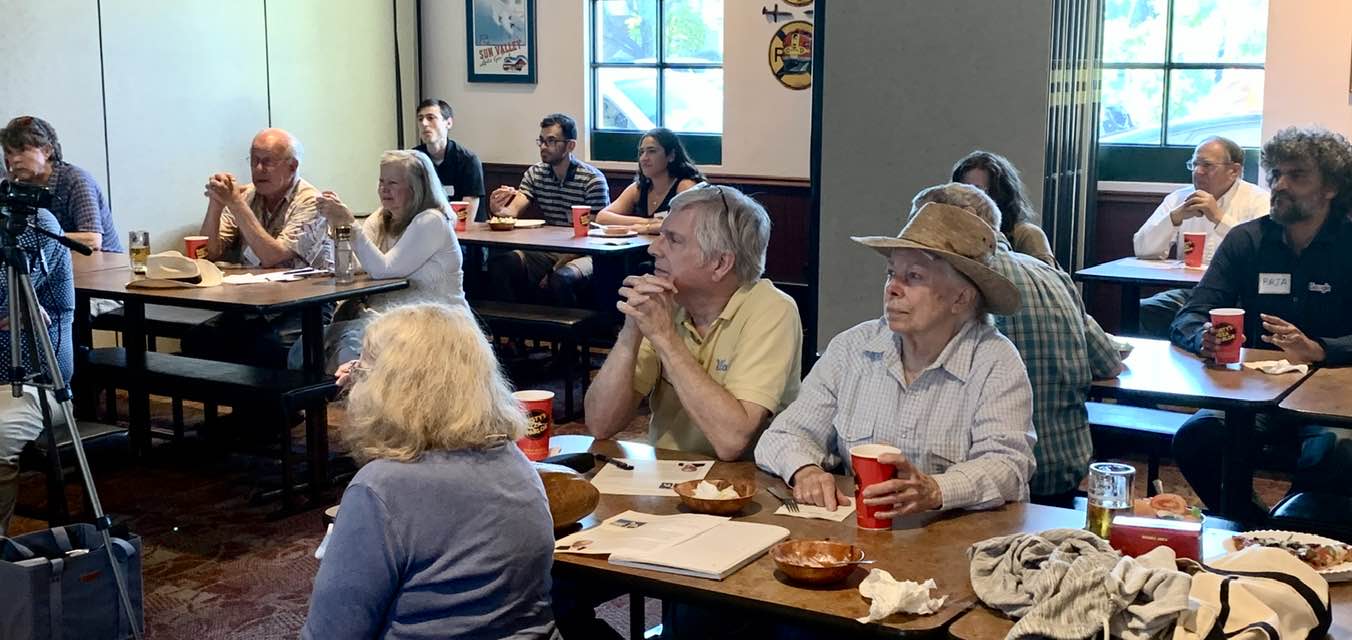
June 2023 speaker: Kedar Madineni
Affiliation: Teledyne FLIR, Goleta
Title: "Solving Real-World Problems Using Thermal Imagery and AI Algorithms"
Date/Time: Wednesday, June 21, 2023; 6:00 PM
Venue: Rusty's Pizza events room, 5934 Calle Real, Goleta, CA
Links: IEEE CCS event page
Summary: This talk introduced the breadth of Real-world problems that are being solved using Teledyne FLIR's infrared cameras and deep-learning techniques. It peeked into the approaches, advantages, and use in mission-critical applications.
Speaker's Bio: Kedar Madineni is a Sr. Principal AI/ML Architect and Engineering Leader in the Digital Solutions group with Teledyne FLIR systems. He has 30+ years of experience in embedded systems spanning Networking, Telecommunications, Storage and AI/ML technologies. He has inventions and patents in the field of Telecommunications, AI/ML approaches and algorithms. He received his M.S degree in Electrical Engineering from LSU, Baton Rouge, with research focus in Artificial Neural Networks. Prior to that, he was a Research Member of the Education and Research in Networking (ERNET) group at IIT Madras, instrumental in building an indigenous protocol stack and applications for the first internet backbone-nodes in India.
May 2023 speaker: Dr. Behrooz Parhami
Affiliation: UCSB Department of Electrical and Computer Engineering
Title: "Lagrange Points and Their Significance to Space Applications"
Date/Time: Wednesday, May 17, 2023; 6:00 PM PST
Venue: Rusty's Pizza events room, 5934 Calle Real, Goleta, CA (~25 attendees)
Links: IEEE CCS event page; Speaker's Web site
Dr. Parhami began by stressing that the talk's subject matter is outside his areas of expertise. Having learned about Lagrange Points from a video clip by astrophysicist Neil deGrasse Tyson, he decided to pursue the topic and to share what he discovered with others.
Application of math to physics has given rise to the field of mathematical physics. Dr. Parhami introduced one problem in this domain, its solution, and a few notable applications to Earth observation, monitoring of the Sun, and space telescopes.
The problem addressed is an instance of the three-body problem, which is super-difficult to solve in general. However, when one of the bodies is much smaller than the other two, so that its gravitational pull can be neglected (e.g., a satellite, compared with the Earth and the Moon), the problem becomes tractable. For each pair of heavy objects, with one rotating around the other, there are five special Lagrange Points in space. These points were introduced and related to the applications cited above.
Speaker's bio: Behrooz Parhami (PhD, UCLA 1973) is Professor of Electrical and Computer Engineering, and former Associate Dean for Academic Personnel, College of Engineering, at University of California, Santa Barbara, where he teaches and does research in computer arithmetic, parallel processing, and dependable computing. A Life Fellow of IEEE, a Fellow of IET and British Computer Society, and recipient of several other awards (including a most-cited paper award from J. Parallel & Distributed Computing), he has written six textbooks and more than 300 peer-reviewed technical papers. Professionally, he is an IEEE Computer Society Distinguished Visitor, serves on journal editorial boards and conference program committees, is passionate about puzzles, outreach efforts, & gender equity, and is active in technical consulting.
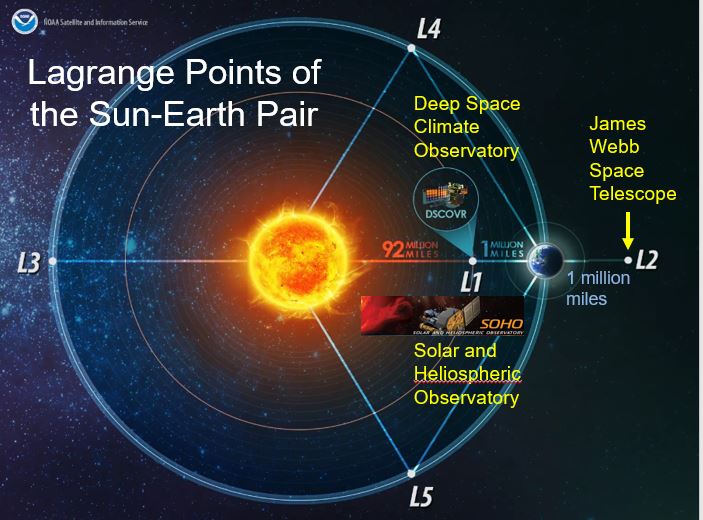
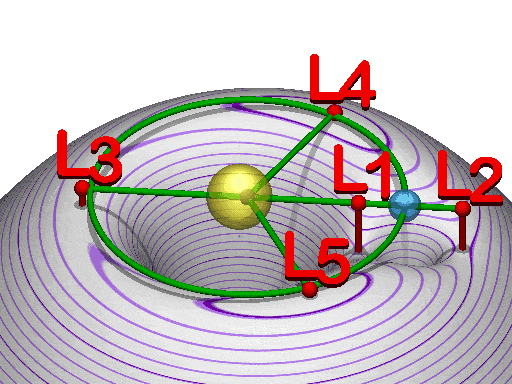
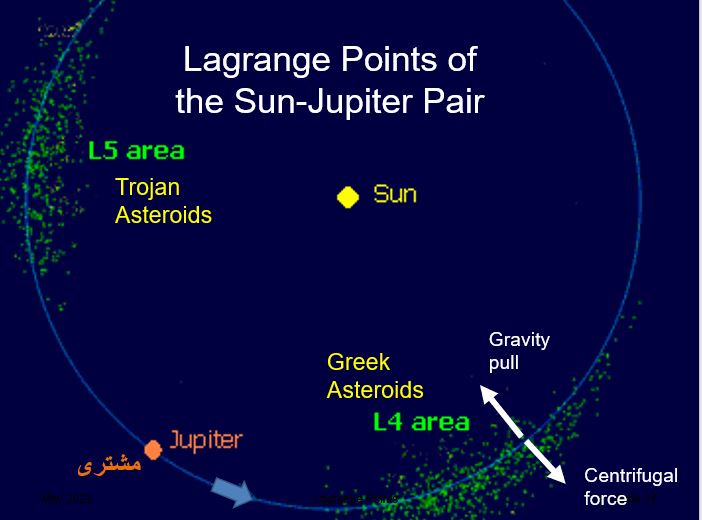
April 2023 speaker: Dr. Nina Miolane
Affiliation: UCSB Electrical and Computer Engineering Department
Title: "Geometric Learning for Shape Analysis from Bioimaging Data"
Date/Time: Wednesday, April 19, 2023; 6:00 PM PDT
Venue: Rusty's Pizza, events room, 5934 Calle Real (just to the east of Fairview Ave.), Goleta, CA 93117
Links: IEEE CCS event page; Speaker's UCSB ECE page; Speaker's personal page
Advances in bioimaging techniques have enabled us to access the 3D shapes of a variety of structures: organs, cells, proteins. Since biological shapes are related to physiological functions, statistical analyses in biomedical research are poised to incorporate more shape data. This leads to the question: How do we define quantitative descriptions of shape variability from images?
Mathematically, landmarks' shapes, curve shapes, surface shapes, or shapes of objects in images are data that belong to non-Euclidean spaces, for example to Lie groups or quotient spaces. In this context, Dr. Miolane has introduced "Geometric statistics," a statistical theory on non-Euclidean spaces. In tonight's talk, she presented studies showing the theory and applications of Geometric Statistics to the analysis of biomedical shape data.
Other aspects of Dr. Miolane's research, which she discussed, include using data that is less costly to obtain (e.g., characteristics of a person's gait) for predicting the onset of Alzheimer's and other diseases in future.
Speaker's bio: Nina Miolane received her MS in Mathematics from Ecole Polytechnique (France) & Imperial College (UK), and her PhD in Computer Science from INRIA (France) in collaboration with Stanford University. She was an instructor in the French Army for a year and was decorated for succeeding in a commando training program. After her studies, Nina spent two years at Stanford University in Statistics as a postdoctoral fellow, and worked as a deep learning software engineer in the Silicon Valley.
At UCSB, Nina directs the BioShape Lab, whose goal is to explore the "geometries of life." Her research investigates how the shapes of proteins, cells, and organs relate to their biological functions, how abnormal shape changes correlate with pathologies, and how these findings can help design new automatic diagnosis tools. Her team also co-develops the open-source Geomstats library, a software that provides methods at the intersection of geometry and machine learning, to compute with geometric data such as biological shape data.
Nina is a co-author of the book Riemannian Geometric Statistics For Medical Imaging and a co-inventor on patents in computational medicine. Her research funding includes an NIH R01 grant on Biological and Mathematical Science and the NSF SCALE MoDL grant on Mathematical and Scientific Foundations of Deep Learning. Nina was the recipient of the L'Oreal-Unesco for Women in Science Award and is involved in outreach initiatives in France and in the US. In her free time, Nina adventures in the golden state's outdoors, hiking in the mountains, riding motorcycles along the coast, or piloting single-engine airplanes.
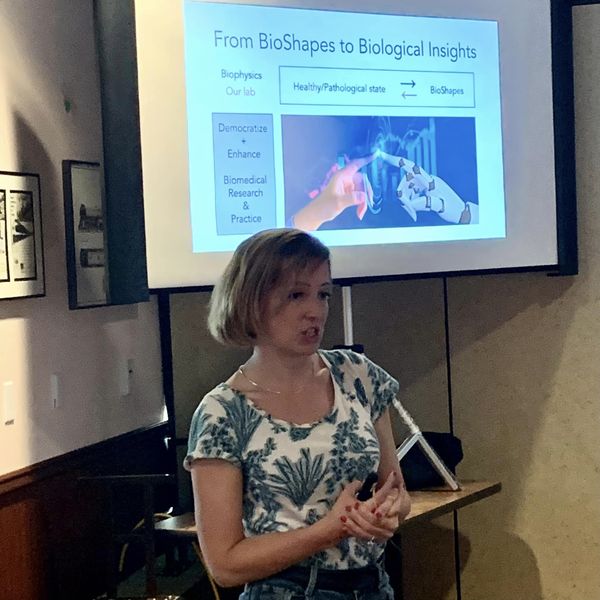
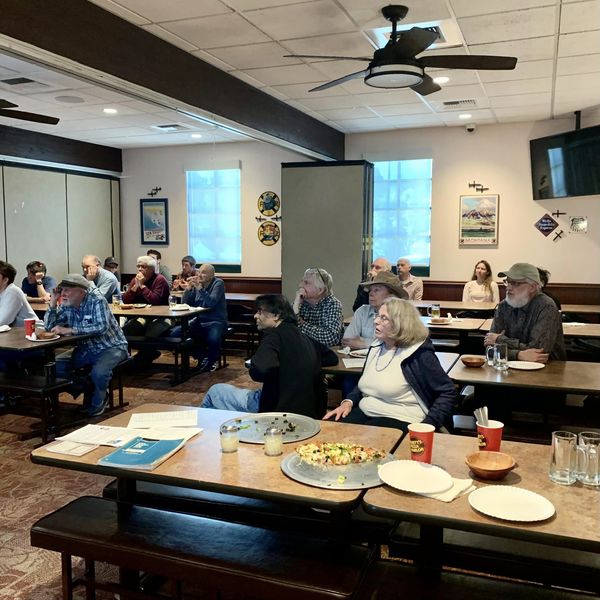
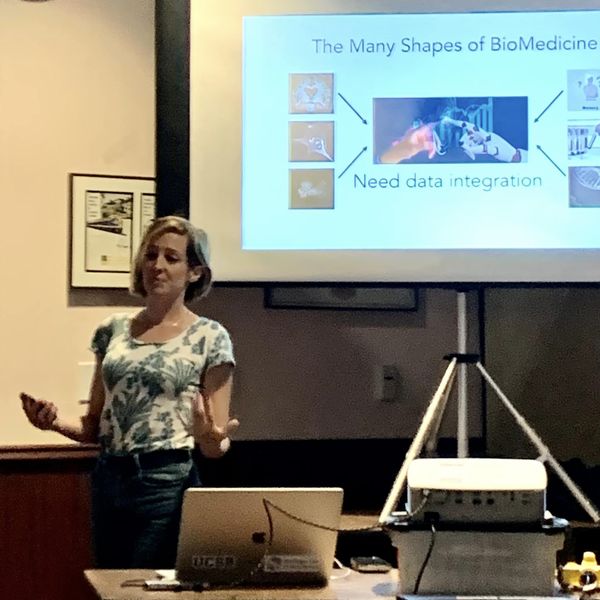
March 2023 speaker: Dr. Kristen W. Sneddon
Affiliation: Santa Barbara City College, EPS
Title: "Sustainability and Resilience: Pedagogy to Policy"
Date/Time: Wednesday, March 15, 2023; 6:00 PM PST
Venue: Events Room at Rusty's Pizza, 5934 Calle Real, Goleta, CA 93117
Links: IEEE CCS event page; Speaker's Web site
According to the Intergovernmental Panel on Climate Change, scientific evidence for warming of Earth's climate system is unequivocal. Faced with the evidence of a rapidly-changing world, it is natural to wonder what can we actually do. As a scientist and member of SB City Council, Dr. Sneddon is in a unique position to present both sides of the debate: the science and policies that can be implemented practically within the constraints on a city's budgetary and jurisdictional constraints.
The focus of the talk was on resilience and sustainability. Over the past five years, our region has experienced historic heat, drought, fire, debris flows, floods, and even snow. It was refreshing to hear about how the City of Santa Barbara is planning for a rapidly-changing climate in terms of energy choices, water management, sea-level rise, diversion of organics, carbon neutrality, climate action, resilience planning, and climate justice.
Speaker's bio: Kristen Sneddon is an Earth and Planetary Science Instructor at Santa Barbara City College, where she teaches Environmental Geology and field courses. Kristen is also a Santa Barbara City Councilmember, serving as Chair of the Council's Sustainability Committee, Council liaison to the Santa Barbara Water Commission, Vice-Chair of the Cachuma Operations and Management Board, and former Chair of the Santa Barbara Sea-level Rise Adaptation Plan Subcommittee. She earned her BSc from UCLA in Applied Geophysics, her MSc in Environmental Geophysics from Colorado School of Mines, and has published research with the USGS on GPR investigations of groundwater contamination. She lives with her husband, Chris, and their three children in Santa Barbara.
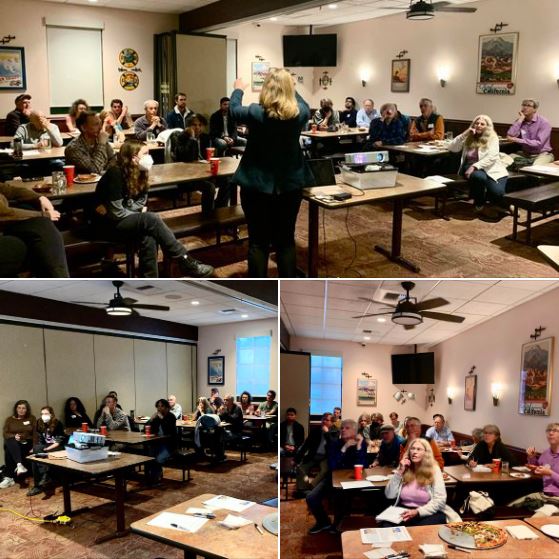
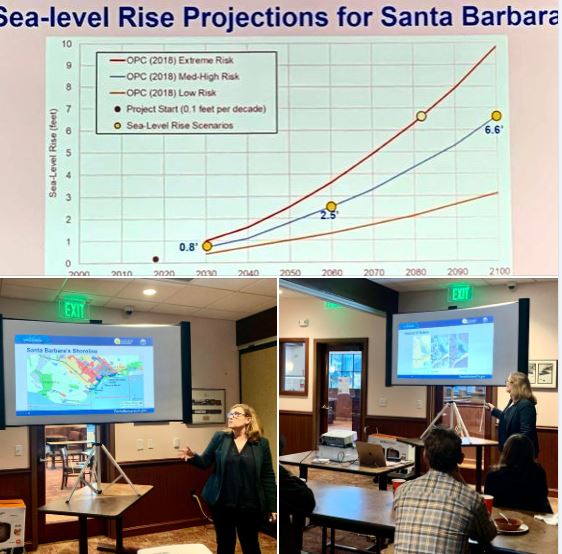
Febuary 2023 speaker: Dr. Sriram Krishnamoorthy
Affiliation: UCSB Materials Department
Title: "Gallium Oxide: Emerging Semiconductor Material for Power Electronics"
Date/Time: Wednesday, February 15, 2023; 6:00 PM PST
Venue: Events Room at Rusty's Pizza, 5934 Calle Real, Goleta, CA 93117
Links: IEEE CCS event page; Speaker's Web site
Dr. Sriram Krishnamoorthy (UCSB, Materials) spoke on "Gallium Oxide: Emerging Semiconductor Material for Power Electronics." There were 17 attendees.
Beta-Gallium Oxide is an emerging ultra-wide band gap semiconductor with a predicted critical breakdown field much higher than the commercial wide band gap semiconductors such as Gallium Nitride and Silicon Carbide. The key attractive feature is the availability of single crystal large area bulk substrates. Dr. Krishnamoorthy's talk began with the motivation for pursuing research on ultra-wide band gap semiconductors for applications in power electronics. Key results in epitaxial growth and device performance were highlighted. The main theme of the talk was to highlight and discuss the interrelationship between material properties, material processing, and device performance. The future outlook for Gallium Oxide in achieving its theoretical potential, as well as the key challenges & limitations, were also discussed.
Speaker's bio: Dr. Sriram Krishnamoorthy is a Mehrabian Career Development Chair Assistant professor in UCSB's Materials Department, where his group works at the intersection of materials, electrical engineering, and physics to study and engineer next-generation (ultra)wide band gap semiconductors such as Gallium Oxide. His research interests are in the areas of epitaxial growth, electronic transport, design/modeling, micro/nano fabrication, and characterization of electronic/optoelectronic devices for a wide range of applications such as power electronics, high frequency electronics and ultra-violet optoelectronics.
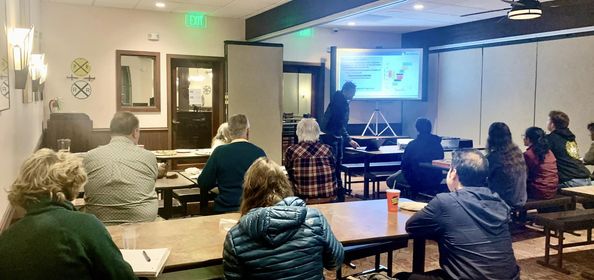
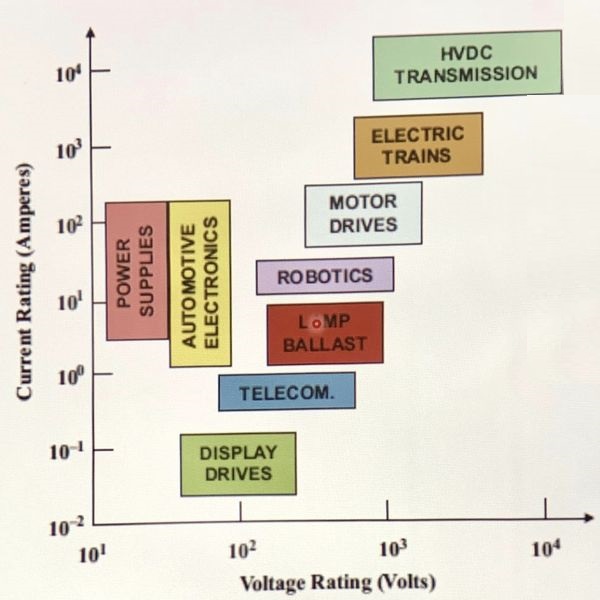
January 2023 speaker: Dr. Behrooz Parhami
Affiliation: UCSB Department of Electrical and Computer Engineering
Title: "Women in Science and Engineering: A Tale of Two Countries"
Date/Time: Wednesday, January 18, 2023; 6:00 PM PST
Venue: Rusty's Pizza events room, 5934 Calle Real, Goleta, CA (~25 attendees)
Links: IEEE CCS event page; Speaker's Web site; Speaker's PDF slides
Despite poor retention and advancement prospects, as well as female-unfriendly workplaces and corporate policies, women continue to flock to and excel in STEM (science, technology, engineering, mathematics) fields. Based on data and narratives from the United States and Iran, the speaker identified roadblocks to the engagement of women in STEM careers. Using the two countries, different as they are in many respects, as examples is instructive, because this side-by-side comparison shows that undesirable outcomes in the domain of women in STEM fields can and do occur for vastly different reasons. The talk concluded by discussing what each country can learn from the other one in removing roadblocks to women in science and engineering.
Speaker's bio: Behrooz Parhami (PhD, UCLA 1973) is Professor of Electrical and Computer Engineering, and former Associate Dean for Academic Personnel, College of Engineering, at University of California, Santa Barbara, where he teaches and does research in computer arithmetic, parallel processing, and dependable computing. A Life Fellow of IEEE, a Fellow of IET and British Computer Society, and recipient of several other awards (including a most-cited paper award from J. Parallel & Distributed Computing), he has written six textbooks and more than 300 peer-reviewed technical papers. Professionally, he is an IEEE Computer Society Distinguished Visitor, serves on journal editorial boards and conference program committees, is passionate about puzzles, outreach efforts, & gender equity, and is active in technical consulting.
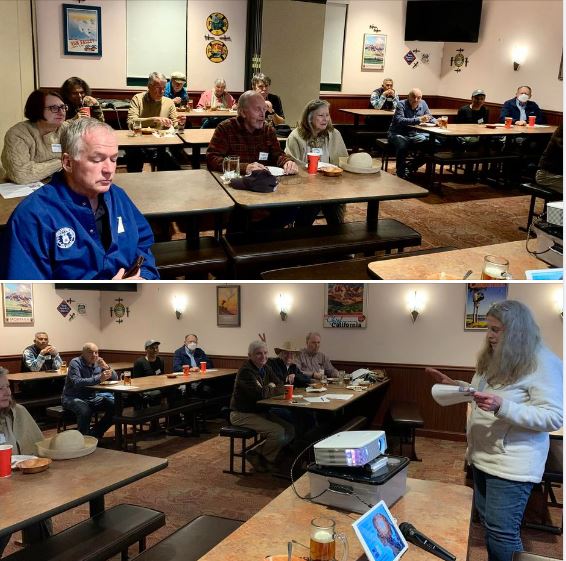
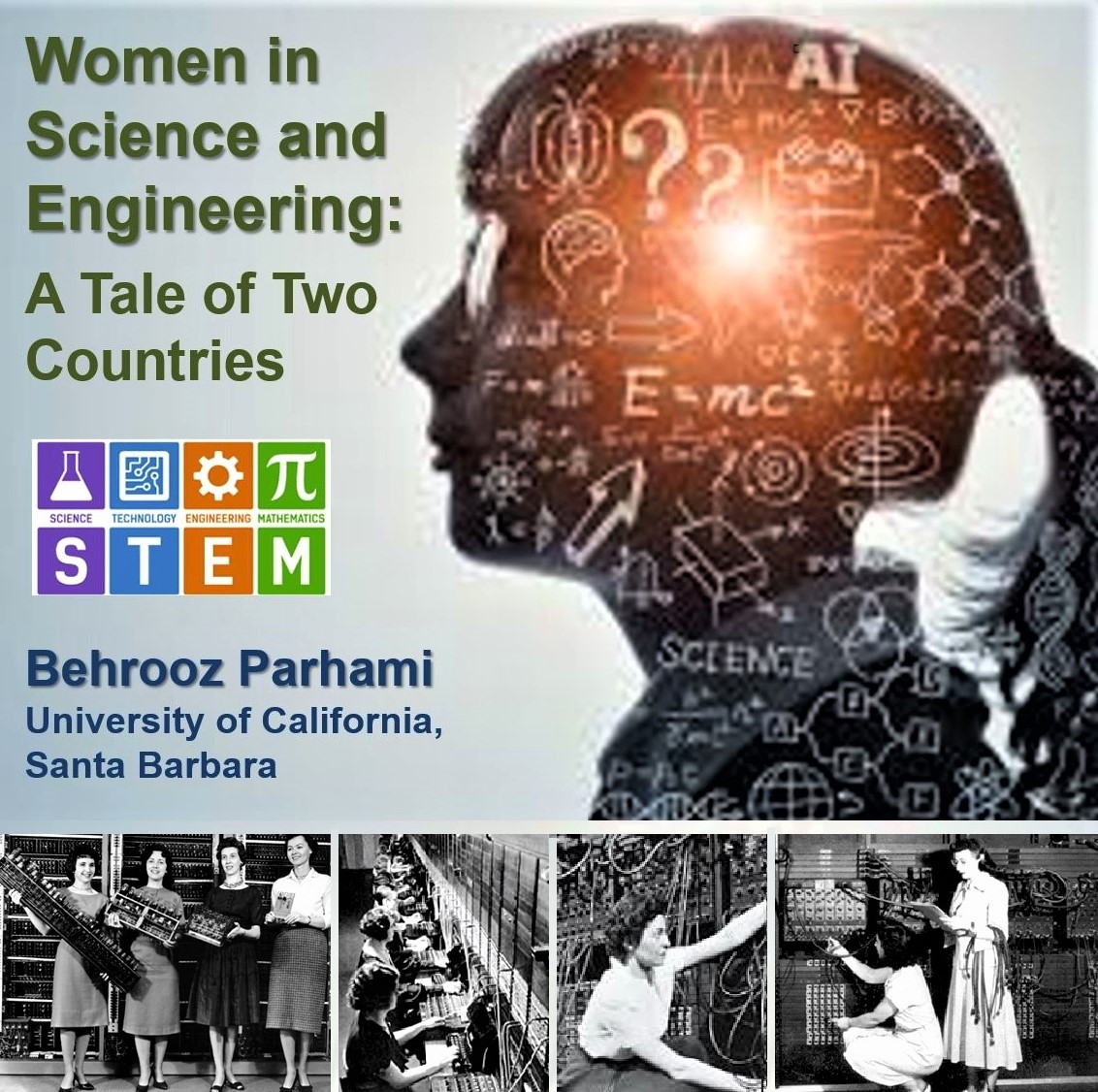
December 2022 speaker: Dr. Roland Geyer
Affiliation: UCSB Bren School of Environmental Science & Management
Title: "The Business of Less: The Role of Companies and Households on a Planet in Peril"
Date/Time: Tuesday, December 20, 2022; 6:30 PM PST (Special Holiday Banquet)
Venue: Muligan's Cafe & Bar at SB Golf Club (3500 McCaw Ave., Santa Barbara, CA 93105)
Links: Registration; Speaker's Web site
Since its inception thirty years ago, environmental sustainability has been based on the concepts of "eco-efficiency" and "win-win." Despite countless eco-efficiency and win-win efforts across the world, the state of the natural environment has further degraded instead of improved. Dr. Geyer began his talk by defining four periods that preceded today's situation.
1. The rise of mass production and its attendant economy of scale, as exemplified by Ford Model-T.
2. The rise of mass pollution, as city after city in the world became nearly unlivable (London, Los Angeles).
3. The rise of mass resistance, as people began to see the scale of environmental disasters (Earth Day).
4. The rise of corporate sustainability, or the misguided idea that businesses can be part of the solution.
Dr. Geyer explained why our current approach to environmental sustainability was doomed to fail and introduced a new set of principles that together provide a road map, for businesses and for households, to a world in which human prosperity and a healthy environment are no longer at odds.
As an example, eco-efficiency hasn't worked, because we tend to use the environmental-impact gains to make/use more of everything. Another problem is measuring impact in relative terms (per pair of sneakers, or per piece of garment). Such a relative gain is easily wiped out by a significant growth in the market.
There are a few signs of hope, though. Improvement in technology, for example, is making recycling easier and more cost-effective. Dr. Geyer recommended a visit to the SB-County-operated Tajiguas landfill (26 miles west of the city of Santa Barbara, along US 101), and its state-of-the-art recovery center, with some of the equipment imported from Europe.
There were ~40 attendees for the talk and the associated Holiday Banquet.
Speaker's bio: Roland Geyer is Professor of Industrial Ecology at UCSB's Bren School of Environmental Science and Management. He is working with a wide range of governmental organizations, NGOs, trade associations, and companies on environmental sustainability issues. Roland has won multiple awards for his work, including the International Statistic of the Year from the Royal Statistical Society, and his work has been covered widely in the media, including worldwide appearances on radio and television shows. Roland has a graduate degree in physics and a PhD in engineering. Learn more about him and his work on his personal Web site.
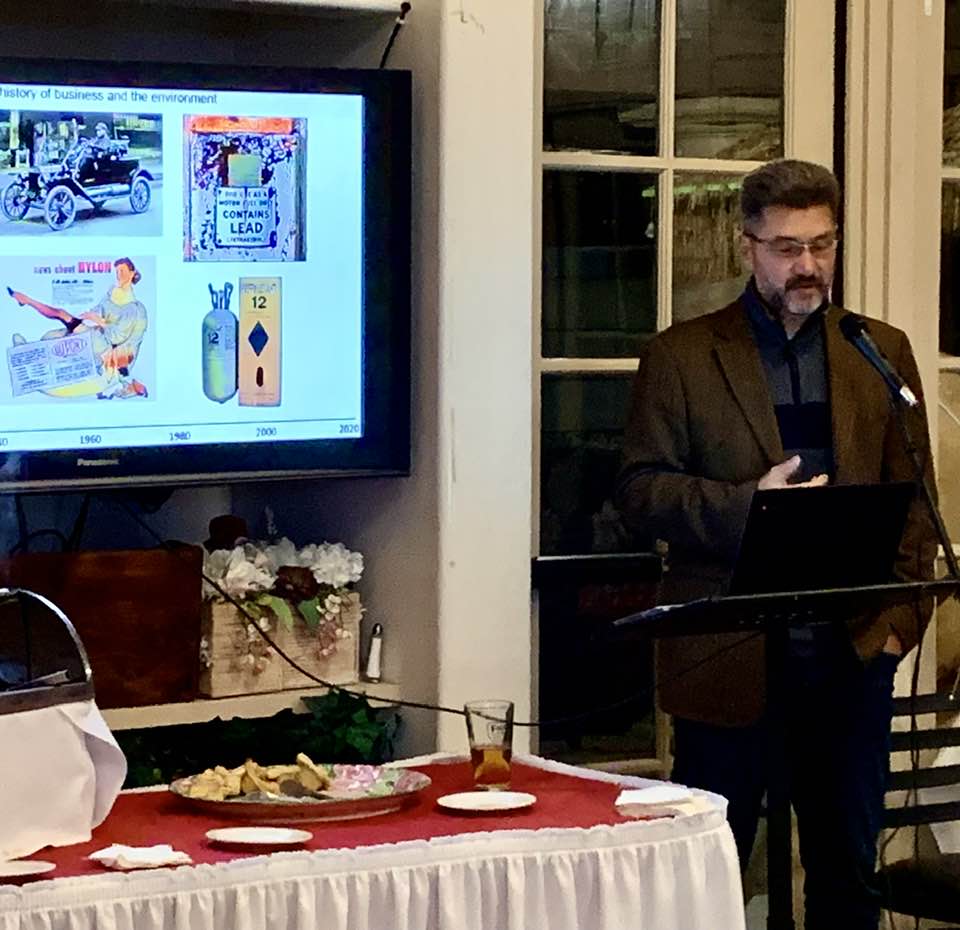
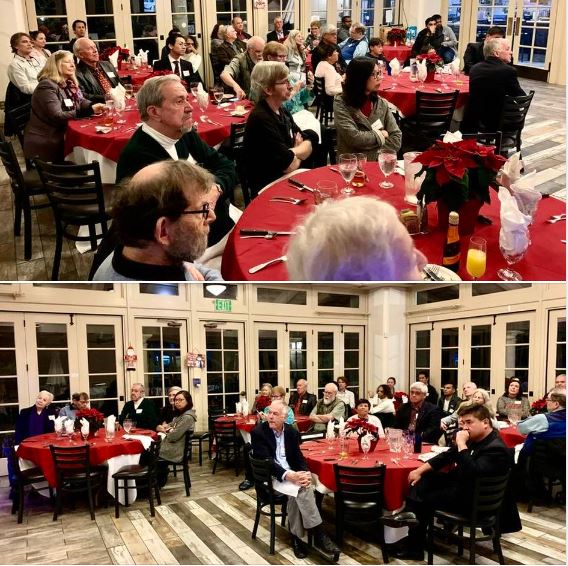
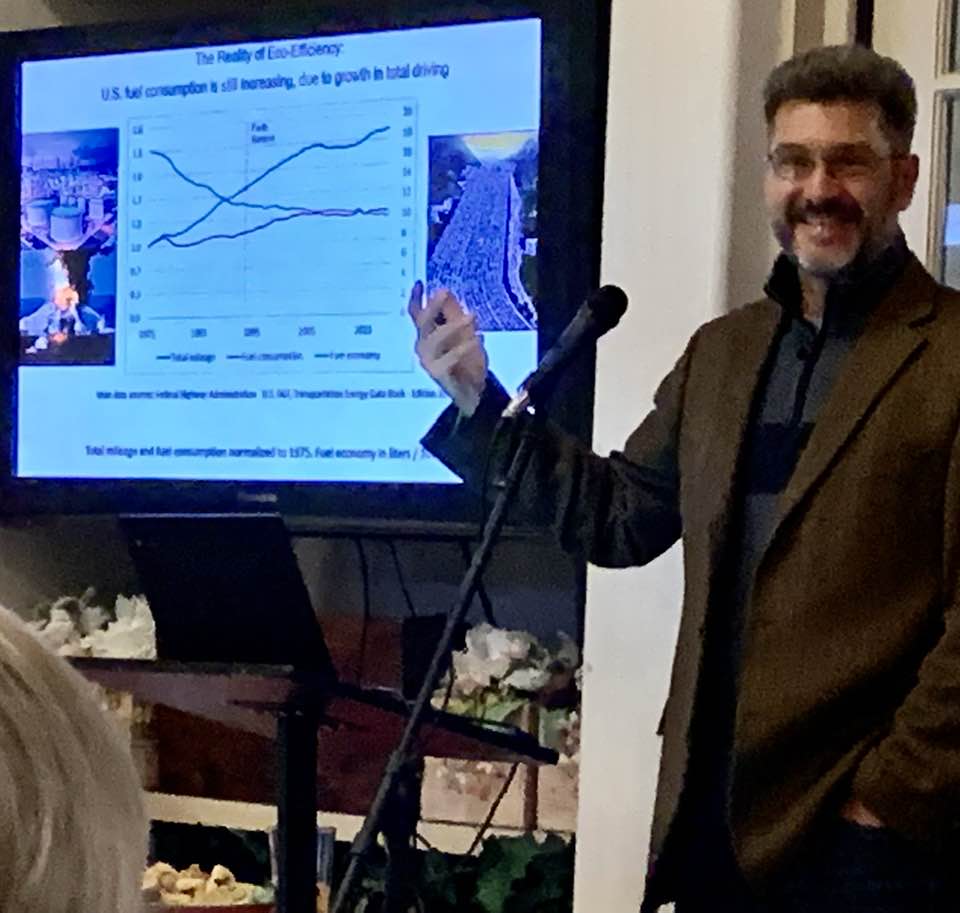
November 2022 speaker: Dr. Leonard Chen
Affiliation: Raytheon, Goleta
Title: "Sensing Across the Infrared Spectrum"
Date/Time: Wednesday, November 16, 2022; 6:00 PM PDT
Venue: Rusty's Pizza (Hollister Ave. at Turnpike Rd.), Goleta, CA 93111
Links: IEEE CCS event page; Speaker's LinkedIn page
In applications from smart phones to industrial machine vision, the past decade has seen an exponentially increasing demand for larger-format cameras with greater functionality. This is also true of infrared (IR) cameras used in commercial and astronomy systems, where in addition to format size, there is need for increased sensitivity, higher dynamic range, faster frame rates, and improved image processing across the entire infrared spectrum. Dr. Chan discussed the basic principles of an IR sensor and looked at the short-wave infrared (SWIR), mid-wave infrared (MWIR), long wave infrared (LWIR), and very long wave infrared (VLWIR) bands of the electromagnetic spectrum. Current commercial and astronomical applications were addressed. Dr. Chan offered a few demos at the end of his talk, including capturing live images from the room and the audience, using a couple of different infrared cameras.
Speaker's bio: Dr. Leonard Chen is a Director of Technology Development for Raytheon Intelligence & Space. Some of his responsibilities include developing technology strategy, overarching tech roadmaps, and planning and coordinating research & development projects. He has more than 30 years of experience at Raytheon, with technical expertise in integrated circuit design, focal plane arrays, and systems engineering. He is a Fellow of SPIE and holds several patents.
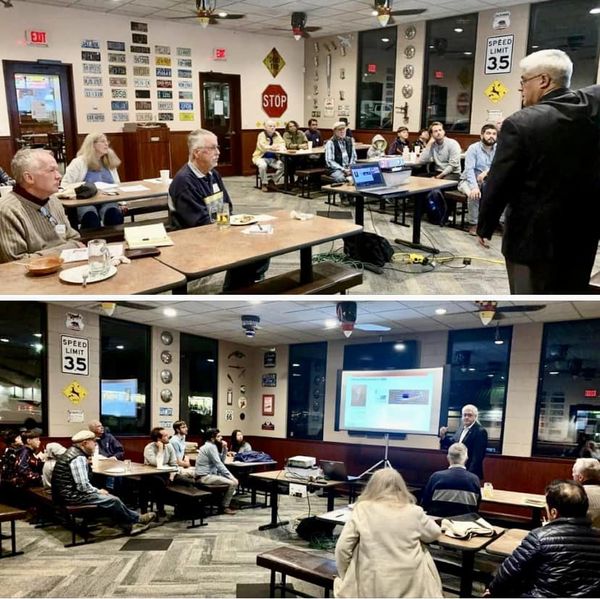
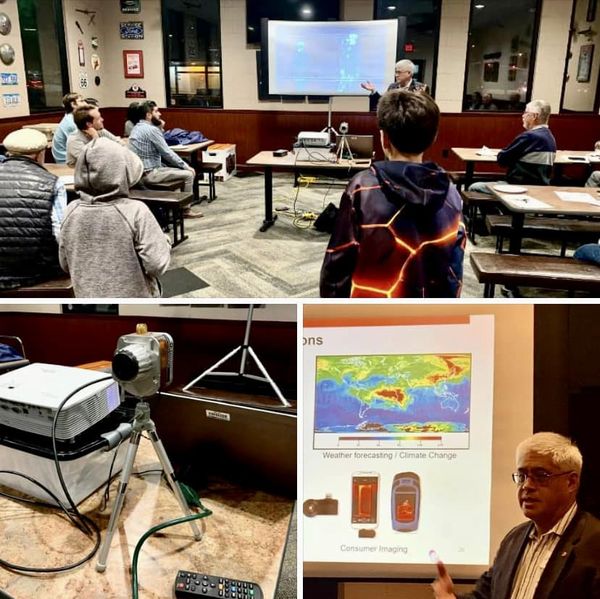
October 2022 speaker: Dr. Behrooz Parhami
Affiliation: UCSB, Department of Electrical and Computer Engineering
Title: "A Realistic Assessment of Intelligent Behavior and Machine Learning"
Date/Time: Wednesday, October 19, 2022; 6:00 PM PDT
Venue: Rusty's Pizza, events room, 5934 Calle Real (just to the east of Fairview Ave.), Goleta, CA 93117
Links: IEEE CCS event page; Speaker's Web page
Defining artificial intelligence (AI), or plain intelligence for that matter, has proven more difficult than expected. Many people have thrown up their arms, taking the position that, even though we can't define AI, we'll recognize it when we see it! Despite the cycles of hype and disappointment in achieving general AI, success stories abound in making machines behave intelligently in limited domains. Examples include vehicle routing (Uber), logistics (airport gate assignments), and game-playing (Chess, GO). Meanwhile, we still have a long way to go in building machines that can pass the Turing test, as well as in domains such as machine translation, which may require the same, or even greater, capabilities. In recent years, we have come to realize that, as great as the technical challenges are in developing general AI, an even greater challenge is developing awareness and dealing with social implications of massive data repositories and automated decision-making. After collecting petabytes of data on each of us, there is no guarantee that machines, or their masters, will use the data to offer better services and optimal outcomes, rather than controlling and shaping our economic and social behaviors. A key consideration is thus ensuring a balance between facilitating technical progress and ensuring fairness and social justice.
Speaker's bio: Behrooz Parhami (PhD, UCLA 1973) is Professor of Electrical and Computer Engineering, and former Associate Dean for Academic Personnel, College of Engineering, at University of California, Santa Barbara, where he teaches and does research in computer arithmetic, parallel processing, and dependable computing. A Life Fellow of IEEE, a Fellow of IET and British Computer Society, and recipient of several other awards (including a most-cited paper award from J. Parallel & Distributed Computing), he has written six textbooks and more than 300 peer-reviewed technical papers. Professionally, he is an IEEE Computer Society Distinguished Visitor, serves on journal editorial boards and conference program committees, is passionate about puzzles, outreach efforts, & gender equity, and is active in technical consulting.
October 2022 IEEE Courses at a Discount
Ten IEEE courses at $10 each, to celebrate IEEE Day (October 4)
Date/Time: Through the end of October
Venue: On-line
Links: List of courses & registration
Use code ILNIEEEDAY22 at checkout on the IEEE Learning Network to save on the eligible eLearning content
September 2022 speaker: Dr. Somayeh Dodge
Affiliation: UCSB, Geography Department
Title: "Movement Data Science for Human Mobility and Animal Ecology Applications"
Date/Time: Wednesday, September 21, 2022; 6:00 PM PDT
Venue: Rusty's Pizza, events room, 5934 Calle Real (just to the east of Fairview Ave.), Goleta, CA 93117
Links: IEEE CCS event/registration page; Speaker's Personal Web page
Today, data and data analytics pervade all domains of human activity. Geography and, more generally, spatial information, are no exception. Early geographic information systems date back to the 1960s, but the field has undergone seismic shifts with the emergence of big-data mindset, tools, and applications. Speaking under the title "Movement Data Science for Human Mobility and Animal Ecology Applications," Dr. Somayeh Dodge (UCSB Geography) reviewed the basics of geographic-information handling and a few key applications of movement data science.
Intentional movement through space is one of the traits shared by humans and animals to perform activities. Movement of individuals is fundamental to the dynamics of ecosystems, cities, and environments, and can be utilized as a key to the understanding and modeling of environmental and behavioral variability in social and ecological systems. As a result of ubiquitous tracking and the increasing access to movement data in both trajectory and aggregate forms, a number of disciplines, from animal ecology to urban planning, from biology to geography and public health, share an interest in understanding movement and activity patterns of humans and animals in natural and built environments.
While there is a shared interest in geography and ecology to understand and model movement behavior with respect to geographic space, there has been little cross-fertilization across these disciplines. Dr. Dodge reviewed recent advances in computational movement analytics from the lens of geographic information science, arguing for a convergent movement data science to study and map movement across the human and animal divide.
Technical bio: Dr. Somayeh Dodge is an Assistant Professor of Spatial Data Science and leads the MOVE Research Lab in the Department of Geography at UCSB. She received her PhD degree in Geography with a specialization in Geographic Information Science (GIScience) from the University of Zurich, Switzerland, in 2011. She holds an MS degree in GIS Engineering and a BS degree in Geomatics Engineering from the KNT University of Technology, Iran. Dr. Dodge is a recipient of the prestigious CAREER award from the US National Science Foundation (NSF) in 2021, and the 2022 Emerging Scholar Award from the Spatial Analysis and Modeling Specialty Group of the American Association of Geographers (AAG). Her NSF-supported research focuses on developing data-driven analytics, knowledge discovery and modeling approaches, and visualization techniques to study movement in human and ecological systems. Her work has appeared in a number of high-ranked journals including Methods in Ecology and Evolution, International Journal of Geographic Information Science (IJGIS), Philosophical Transactions of the Royal Society B, Movement Ecology, Cartography and Geographic Information Science (CaGIS), and Computers, Environment and Urban Systems (CEUS). Dr. Dodge currently serves on the Board of Directors of the University Consortium for Geographic Information (UCGIS), and as the Co-Editor in Chief of the Journal of Spatial Information Science. Before joining UCSB in July 2019, Dr. Dodge served on the faculties of the University of Minnesota, Twin Cities (2016-2019) and University of Colorado, Colorado Springs (2013-2016). Prior to that, she was a postdoctoral fellow at the Department of Civil, Environmental, and Geodetic Engineering at The Ohio State University.
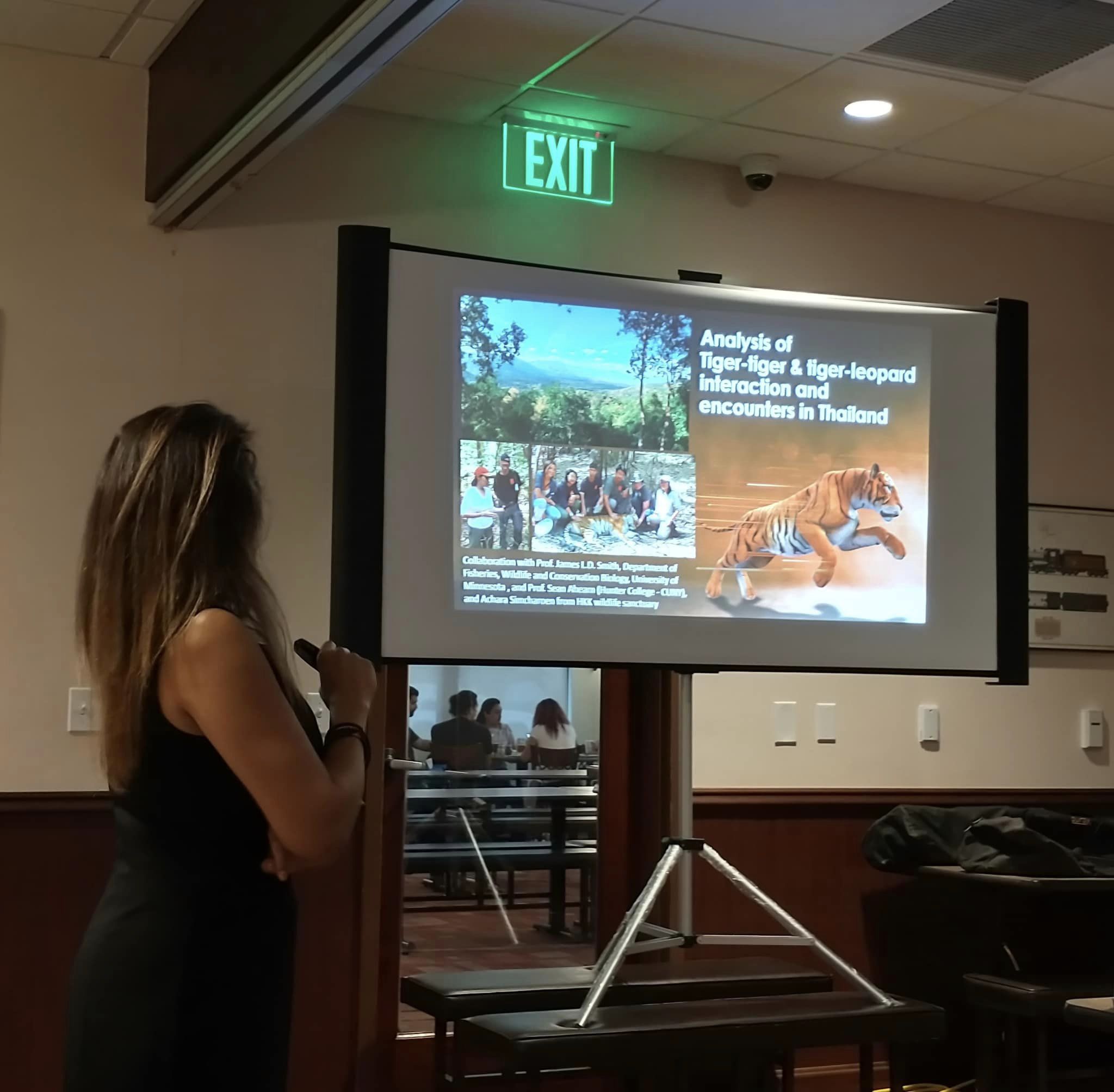
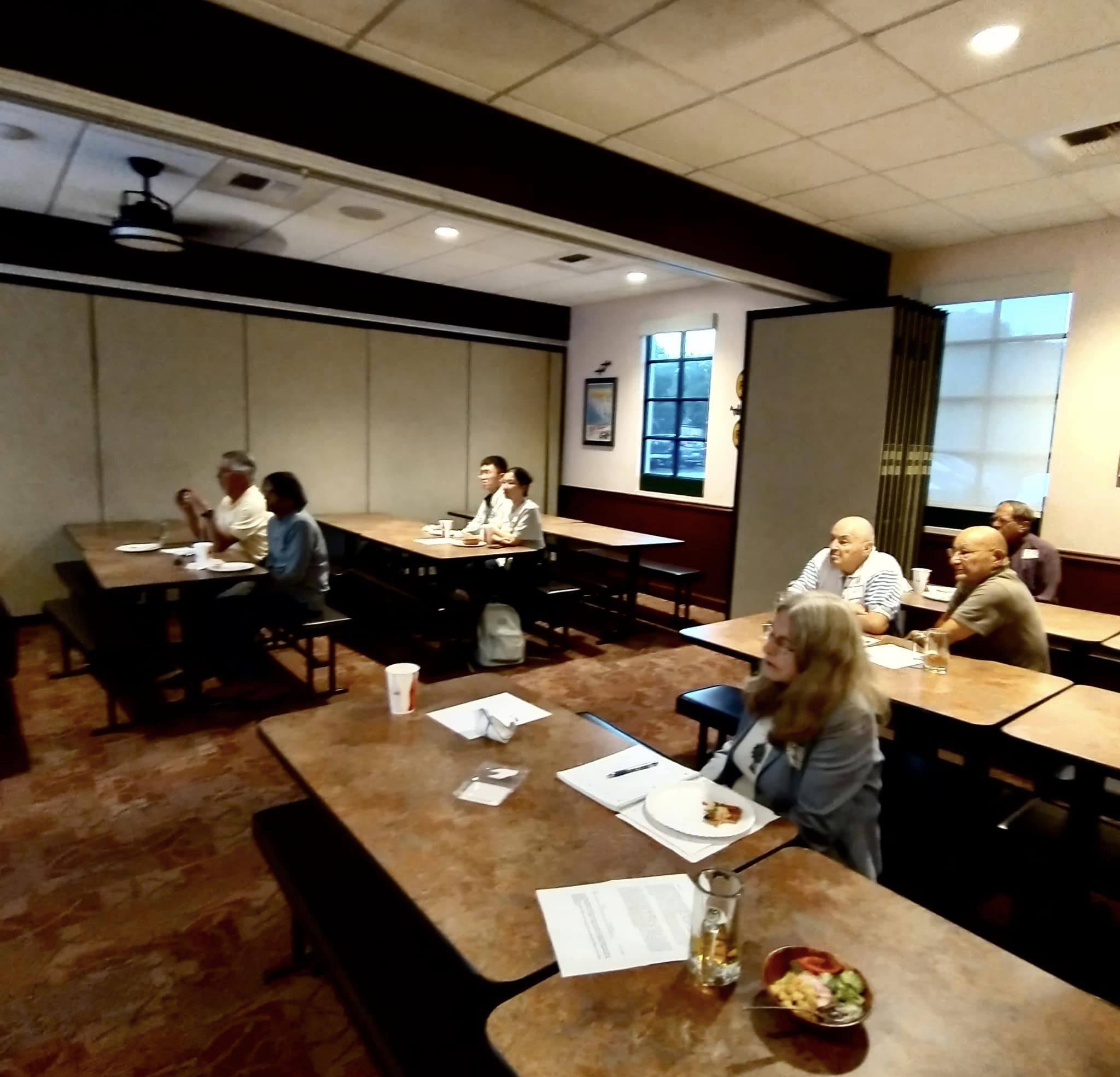
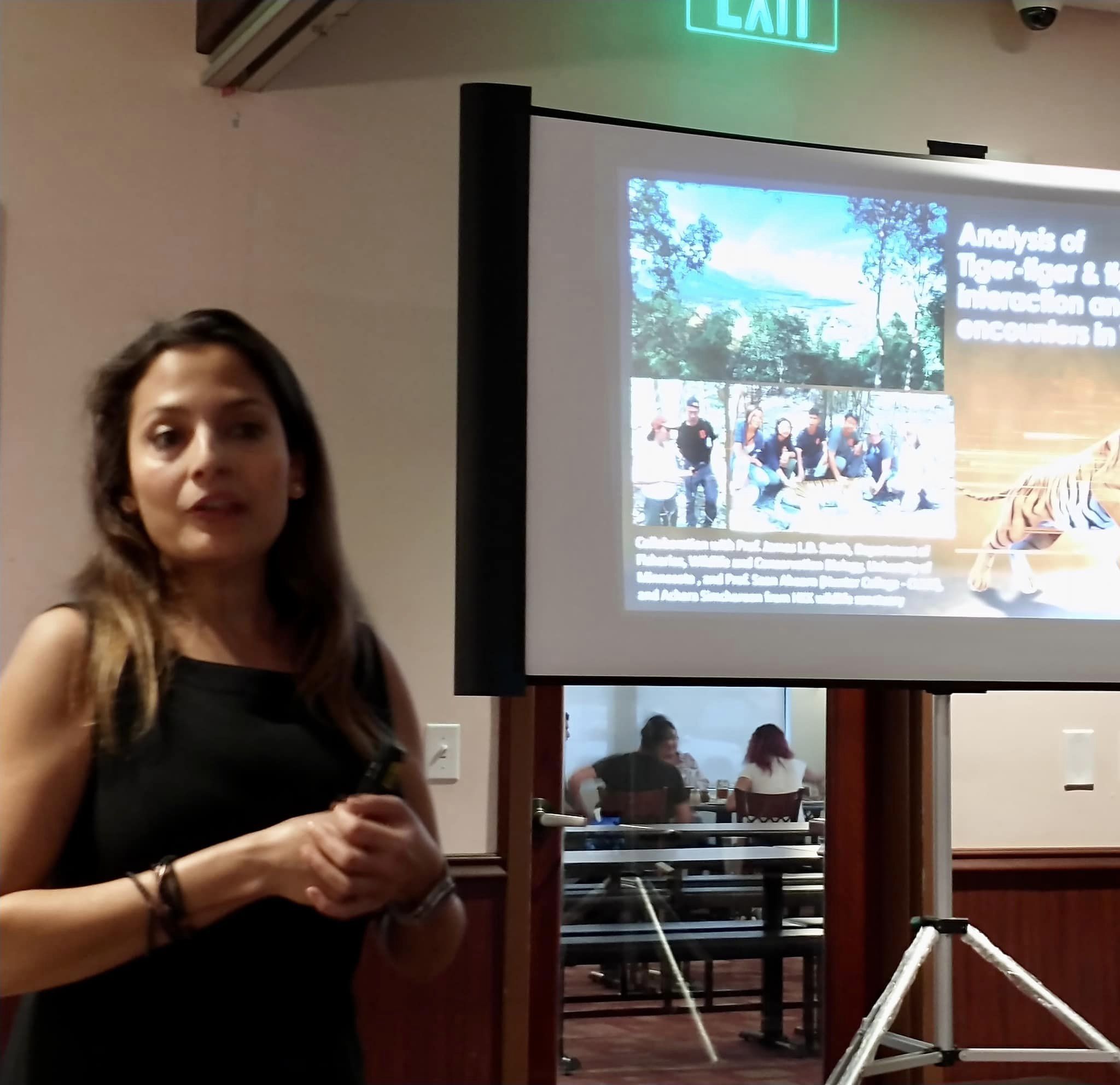
Special September 2022 presentation on JWST
Title: "Opening the Infrared Treasure Chest with JWST"
Date/Time: Tuesday, Septembert 13, 2022; 5:00 PM PDT
Venue: In person and via YouTube
Links: Recording (69-minute video)
In this talk, presented under the auspices of the National Air and Space Museum's John H. Glenn Lecture in Space History, Nobel Laureate and James Webb Space Telescope senior project manager John C. Mather discussed his groundbreaking research on JWST, the product of efforts by some 20,000 people.
Launched in 2021, with science operations beginning in 2022, JWST will peer into the past to find the first objects that formed after the Big Bang, the first black holes, the growth of galaxies, the formation of stars & planetary systems, and more. One hundred times more powerful than the celebrated Hubble Space Telescope, JWST could observe a 1 cm^2 bumblebee at the Earth-Moon distance, in reflected sunlight and thermal emission and promises to reveal more wonders of our universe.
Special September 2022 panel discussion on 5G
Title: "IEEE 5G Demystified: Hype vs. Reality of 5G"
Date/Time: Thursday, Septembert 08, 2022; 9:00 AM PDT
Venue: Virtual, on LinkedIn
Links: Recording (62-minute video)
This panel discussion by IEEE Educational Activities on LinkedIn Live had more than 1300 attendees.
Despite being hyped at a fever pitch for several years now, with terms such as "ultra-wideband" and "extended range," 5G's impact on everyday life has been rather limited. This IEEE panel discussion brought together experts David Witkowski, Joe Madden, Prakash Sangam, and Monisha Ghosh for a discourse on the challenges created by how the wireless carriers promote 5G, and what the real value of 5G technology is likely to be.
It seems that 5G's greater coverage is a boon in rural settings; most other users don't experience much difference in 5G vs. 4G. As we prepare for the onslaught of hype on 6G, we need to understand that 5G's impact is mostly in the domain of communication infrastructure, rather than consumers or phones.
August 2022 speaker: Dr. Lei Li
Affiliation: UCSB Computer Science Department
Title: "Breaking the Language Barrier with Neural Machine Translation"
Date/Time: Wednesday, August 17, 2022; 6:00 PM PDT
Venue: Rusty's Pizza, events room, 5934 Calle Real (just to the east of Fairview Ave.), Goleta, CA 93117
Links: IEEE CCS event page (registration); Speaker's personal Web page
Machine translation (MT) is the holy grail of AI. It was first viewed as one of the easier tasks for intelligent machines but then revealed its complexity, establishing itself among the most-challenging AI problems. Speaking under the title "Breaking the Language Barrier with Neural Machine Translation," Dr. Lei Li (UCSB CS) presented an overview of machine translation's 7.5-decade history, followed by his team's work on neural-network-based machine translation.
Machine translation has been instrumental in modern global business and daily life. A recent study has shown machine translation to be responsible for a 10% rise in trade on global e-commerce platforms. In recent years, powered by deep learning methods, machine translation has seen dramatic progress. Dr. Li discussed recent advances of MT technologies and models for bilingual translation, also briefly alluding to multilingual and speech-to-text translation scenarios, as well as challenges ahead in the domain of MT for every language.
Dr. Li discussed some of the remaining challenges in MT, using examples from various languages. In languages with vast amounts of textual material in original and translated forms, the learning process for neural-network translation is straightforward, but even there, many problems remain because of inherent ambiguity and imprecision in natural languages.
Tech bio: Dr. Lei Li is an assistant professor of Computer Science at UCSB. He has research interests in natural language processing, machine translation, and AI-powered drug discovery. He received his BS from Shanghai Jiao Tong University and PhD from Carnegie Mellon University. His dissertation work on fast algorithms for mining co-evolving time series was awarded ACM KDD best dissertation (runner up). His recent work on AI writer Xiaomingbot received 2nd-class award of Wu Wen-tsun AI prize in 2017. He is a recipient of Association for Computational Linguistics 2021 best paper award, China Computer Federation Young Elite award in 2019, and CCF distinguished speaker in 2017. His team won first places for five language translation directions and the best in corpus filtering challenge in WMT 2020. Previously, he worked at UC Berkeley's EECS Department, Baidu's Institute of Deep Learning in Silicon Valley, and at ByteDance as the founding director of AI Lab. He has served as Associate Editor of IEEE Trans. PAMI and as organizer and area chair or senior PC for multiple conferences, including KDD, ACL, EMNLP, NeurIPS, AAAI, IJCAI, WSDM, and CIKM. He has published over 100 technical papers in ML, NLP, and data mining and holds more than 10 patents. He has launched ByteDance's machine translation system (VolcTrans) and many of his algorithms have been deployed in production (e.g., Tiktok, Toutiao, and Lark), serving billions of users.
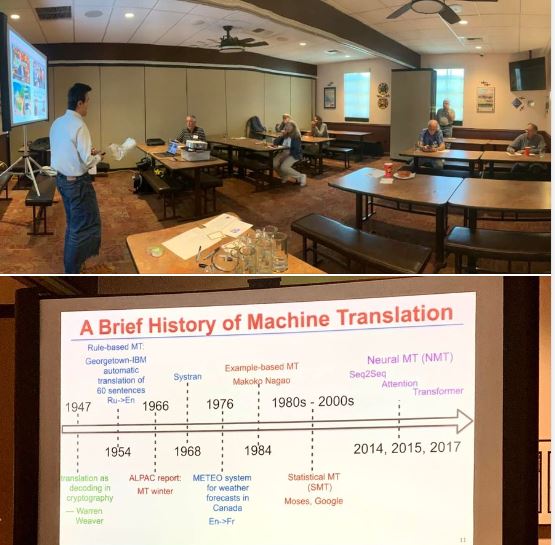
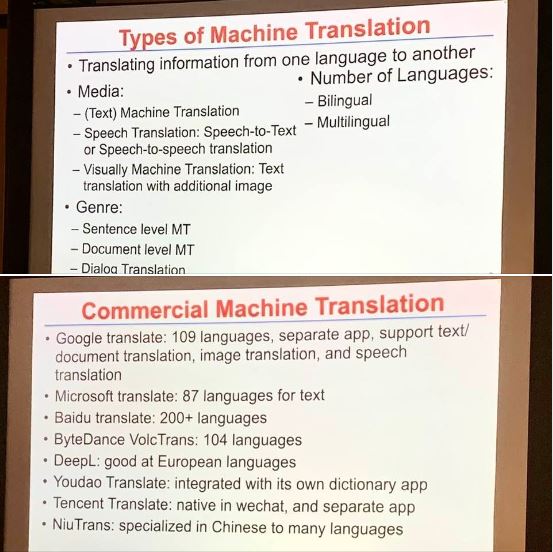
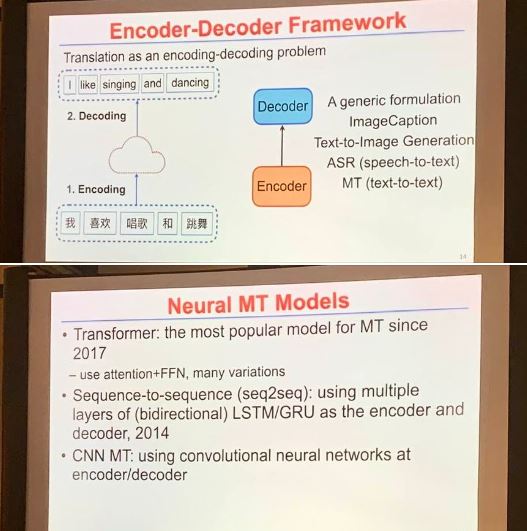
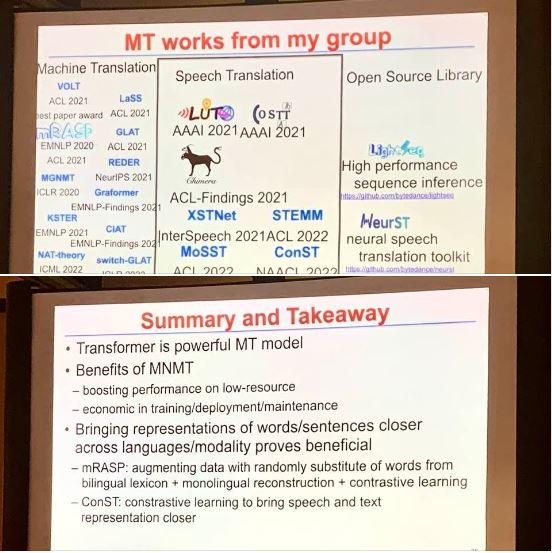
July 2022 speaker: Dr. Yufei Ding
Affiliation: UCSB Computer Science Department
Title: "Full-stack System Optimization for Quantum Computing"
Date/Time: Wednesday, July 20, 2022; 6:00 PM PDT
Venue: Rusty's Pizza, events room, 5934 Calle Real (just to the east of Fairview Ave.), Goleta, CA 93117
Links: IEEE CCS event page; Speaker's personal Web page
Speaking under the title "Full-stack System Optimization for Quantum Computing," Dr. Yufei Ding (UCSB CS/ECE) presented her team's interesting work, which is contributing to the second quantum revolution, the transition from quantum theory to quantum engineering or practical quantum computing. Along this path, we need methodologies for transferring the knowledge we have gained in building classical computing systems to the new context. Examples of gaps to be filled include general compiler support with efficient qubit mapping, domain-specific compiler designs enabled by new intermediate representations, design flow for quantum accelerators, and automatic surface code synthesis for fault-tolerant quantum computing.
Technical bio: Dr. Yufei Ding joined UCSB's Department of Computer Science (with a joint appointment in the Department of Electrical & Computer Engineering) as an Assistant Professor in November 2017. She received her PhD in Computer Science from North Carolina State U., and BS and MS in Physics from U. Science and Technology of China and the College of William and Mary, respectively. Her research interests lie in the broad fields of domain-specific language design, architecture and compiler optimization, and hardware acceleration. Her current research focuses on building high-performance, energy-efficient, and high-fidelity programming frameworks for emerging technologies such as quantum computing, machine learning, and deep learning. She is a recipient of NSF CAREER Award (2020), IEEE Computer Society TCHPC Early Career Researchers Award for Excellence in High Performance Computing (2019), NCSU Computer Science Outstanding Dissertation Award (2018), NCSU Computer Science Outstanding Research Award (2016), and Distinguished Paper Award at OOPLSA (2020).
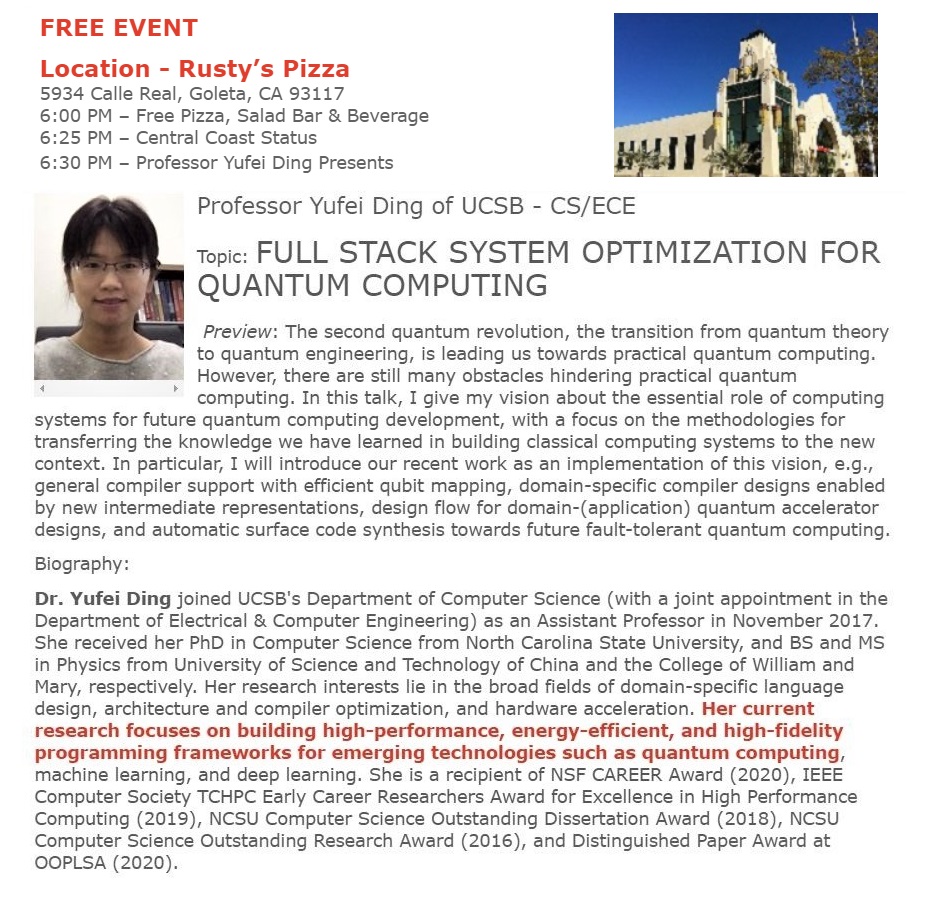
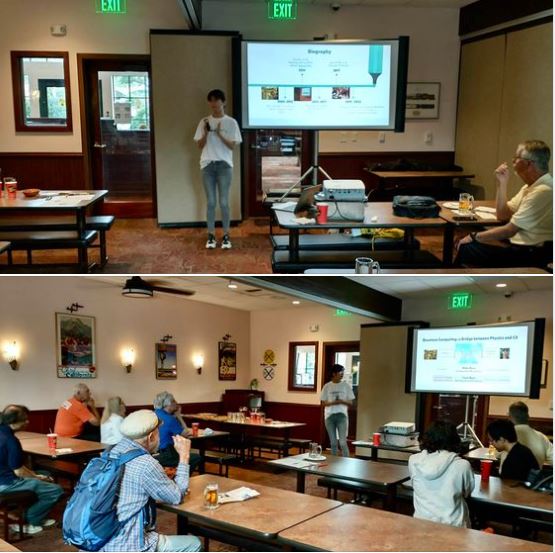
June 2022 speaker: Dr. William Wang
Affiliation: UCSB Computer Science Department
Title: "Self-Supervised Language-and-Vision Reasoning"
Date/Time: Wednesday, June 15, 2022; 6:00 PM PDT
Venue: Rusty's Pizza, events room, 5934 Calle Real (just to the east of Fairview Ave.), Goleta, CA 93117
Links: IEEE CCS event page; Speaker's personal Web page
Speaking under the title "Self-Supervised Language-and-Vision Reasoning," Dr. William Wang (Computer Science Dept., UCSB) introduced his team's recent work on visually-grounded language reasoning via the studies of vision-and-language navigation, emphasizing three benefits of self-supervised learning:
- improving generalization in unseen environments;
- creating counterfactuals to augment observational data;
- enabling transfer learning for challenging settings.
A key challenge for Artificial Intelligence research is going beyond static observational data and considering more-challenging settings that involve dynamic actions and incremental decision-making. Dr. Wang considered the problem of an autonomous agent navigating in an environment known to it via images captured in real time (no floorplans, maps, overhead views, or GPS) as it follows word instructions about how to get to a desired destination.
Here is an example of word instructions: "Leave the living room. Go through the hallway with paintings on the wall and head to the kitchen. Stop next to the wooden dining table." With each action, such as turning left/right or moving forward, the environment, as seen by the agent, changes. Success is determined primarily by whether or not the agent reaches the destination and secondarily by various other figures of merit.
Dr. Wang concluded by briefly introducing other reasoning problems that his groups are tackling.
Technical bio: Dr. William Wang (PhD, CMU) is the Duncan and Suzanne Mellichamp Chair in Artificial Intelligence and Designs, and an Associate Professor in the Department of Computer Science at UCSB. He is the Director of UCSB's Natural Language Processing group, and Center for Responsible Machine Learning. He has broad interests in machine learning approaches to data science, including statistical relational learning, information extraction, computational social science, speech, and vision. He has published more than 100 papers at leading NLP/AI/ML conferences and journals, and received best paper awards (or nominations) at ASRU 2013, CIKM 2013, EMNLP 2015, and CVPR 2019, a DARPA Young Faculty Award (Class of 2018), IEEE AI's 10 to Watch (2020), NSF CAREER Award (2021), two Google Faculty Research Awards (2018, 2019), three IBM Faculty Awards (2017-2019), two Facebook Research Awards (2018, 2019), an Amazon AWS Machine Learning Research Award, a JP Morgan Chase Faculty Research Award, an Adobe Research Award in 2018, and the Richard King Mellon Presidential Fellowship in 2011. His work and opinions appear in major tech media outlets such as Wired, VICE, Scientific American, Fortune, Fast Company, NPR, NASDAQ, The Next Web, Law.com, and Mental Floss. He is an elected member of IEEE Speech & Language Processing Technical Committee (2021-2023) and a member of ACM Future of Computing Academy.
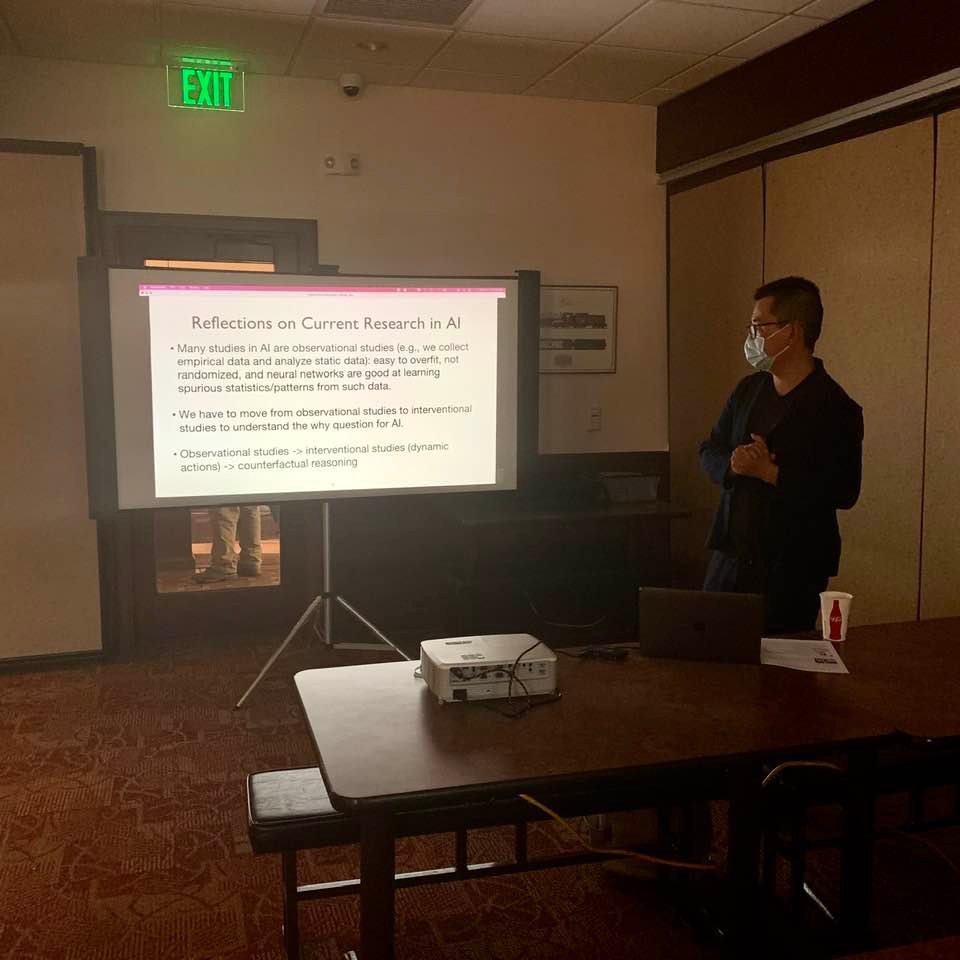
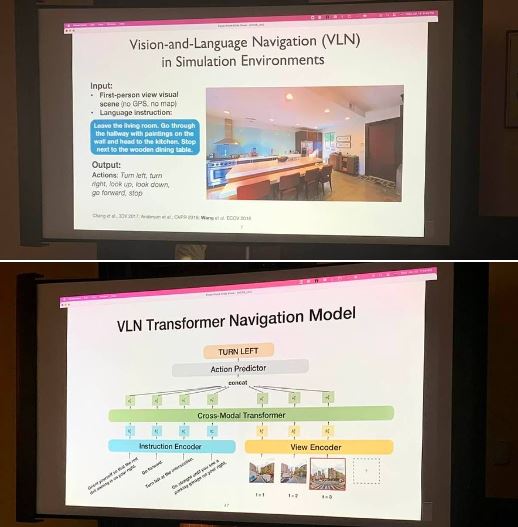
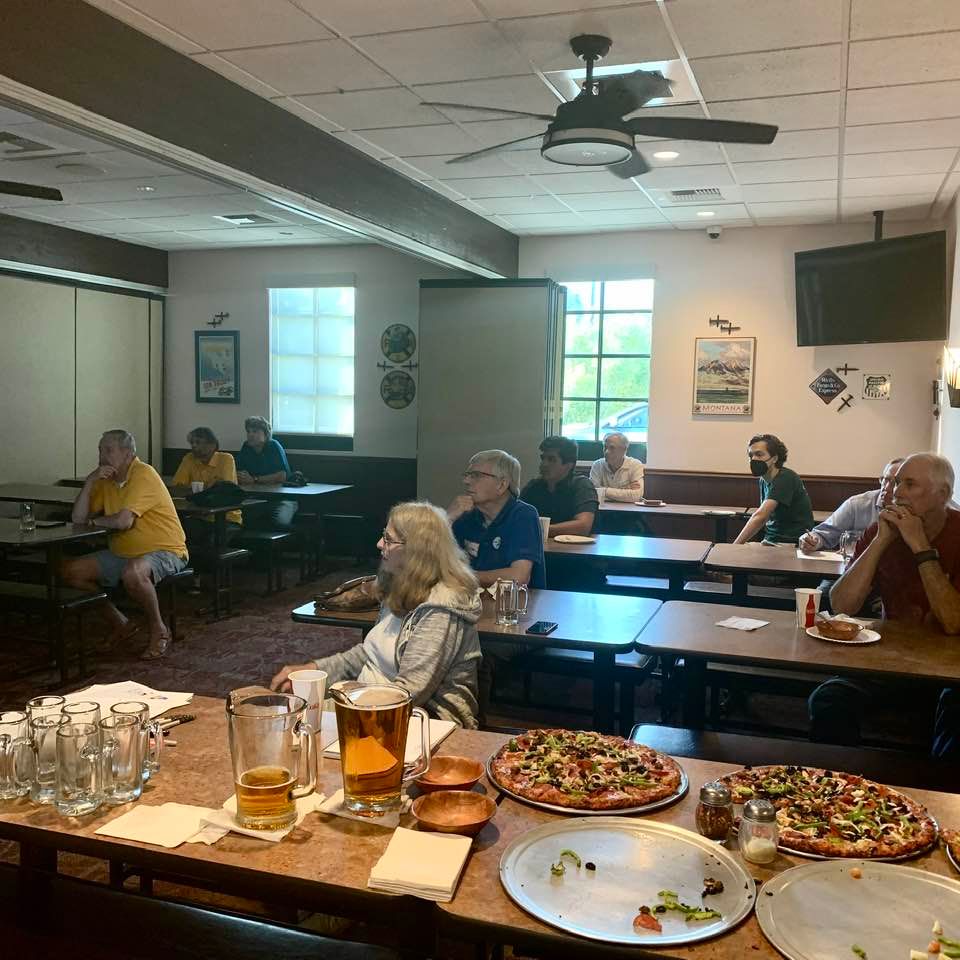
May 2022 speaker: Dr. Behrooz Parhami
Affiliation: UCSB Electrical and Computer Engineering Department
Title: "Hybrid Digital-Analog Number Representation in Computing and in Nature"
Date/Time: Wednesday, May 18, 2022; 6:00 PM PST
Venue: Rusty's Pizza, events room, 5934 Calle Real (just to the east of Fairview Ave.), Goleta, CA 93117
Links: IEEE CCS event page; Speaker's home page; Speaker's publications page
Tonight, in an in-person event with 15 attendees, held at the Calle Real Rusty's Pizza in Goleta, Dr. Behrooz Parhami (Professor of Electrical and Computer Engineering, UCSB) spoke under the title "Hybrid Digital-Analog Number Representation in Computing and in Nature," a last-minute substitute talk due to illness of the originally-scheduled speaker.
The discovery that mammals use a multi-modular method akin to residue number system (RNS), but with continuous residues or digits, to encode position information led to the award of the 2014 Nobel Prize in Medicine. After a brief review of the evidence in support of this hypothesis, and how it relates to RNS, Dr. Parhami enumerated the properties of continuous-digit RNS, and discussed results on the dynamic range, representational accuracy, and factors affecting the choice of the moduli, which are themselves real numbers. He then took a step back and briefly explored hybrid digital-analog number representations and their robustness and noise-immunity advantages more generally. He concluded with suggestions for further research on important open problems in the domain of hybrid digital-analog number representation and processing.
Speaker's bio: Behrooz Parhami (PhD, UCLA 1973) is Professor of Electrical and Computer Engineering, and former Associate Dean for Academic Personnel, College of Engineering, at University of California, Santa Barbara, where he teaches and does research in the field of computer architecture: more specifically, in computer arithmetic, parallel processing, and dependable computing. A Life Fellow of IEEE, a Fellow of IET and British Computer Society, and recipient of several other awards (including a most-cited paper award from J. Parallel & Distributed Computing), he has written six textbooks and more than 300 peer-reviewed technical papers. Professionally, he serves on journal editorial boards (including for 3 different IEEE Transactions) and conference program committees, and he is also active in technical consulting.
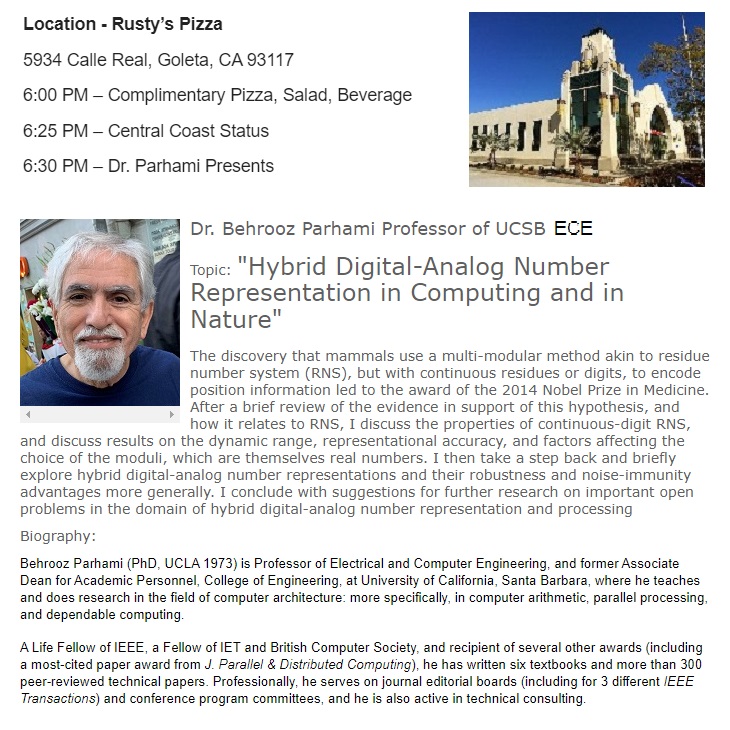
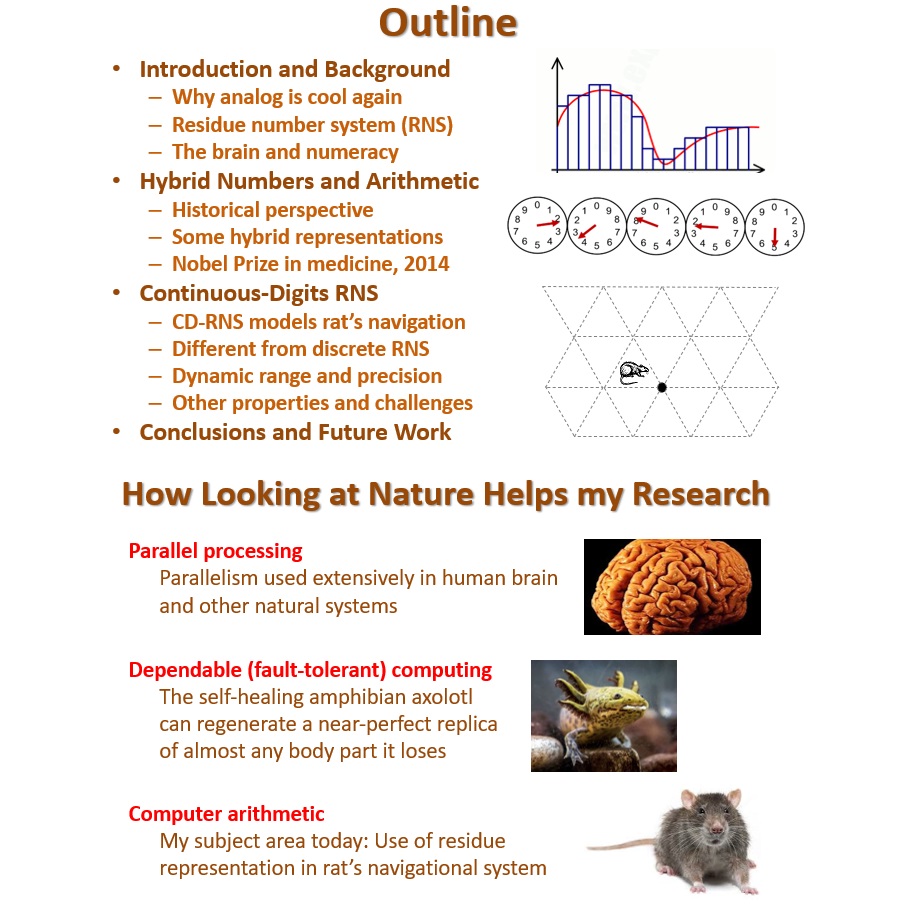
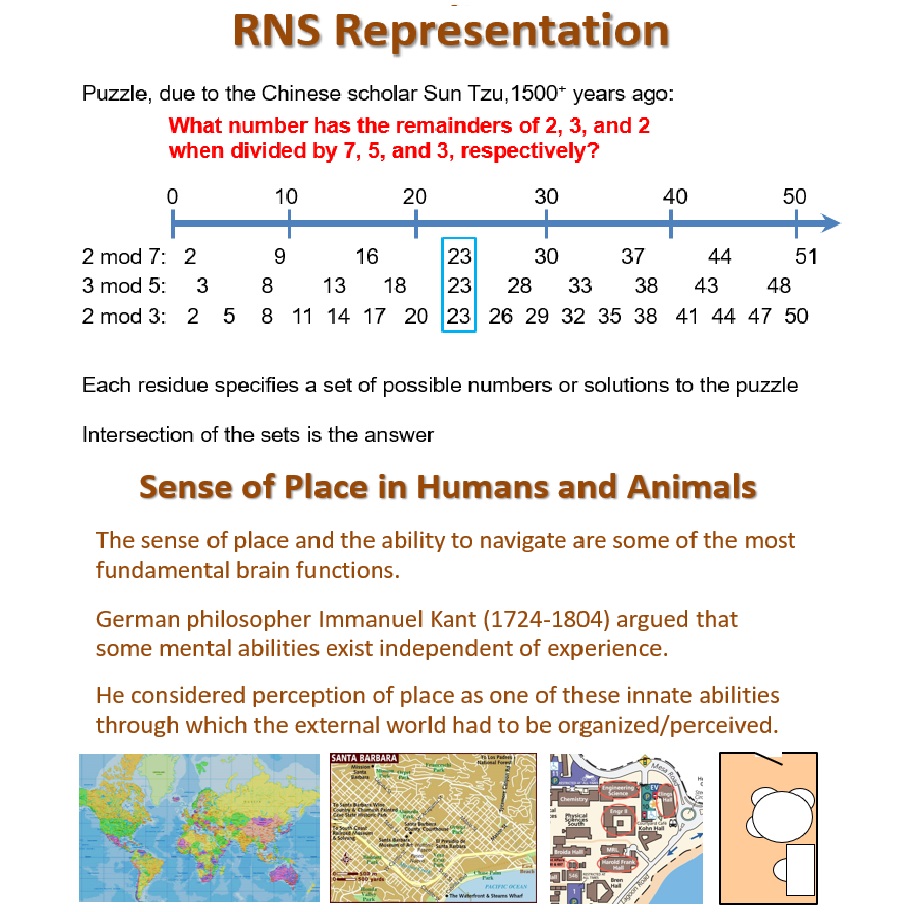
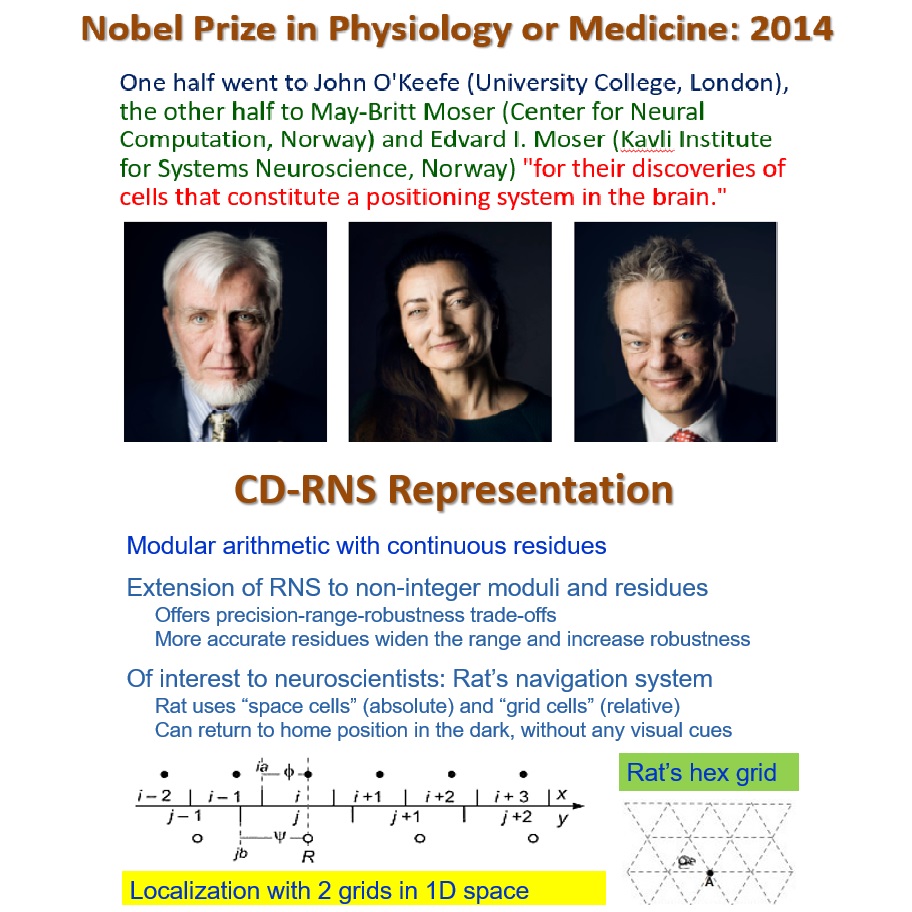
April 2022 speaker: Dr. Sumita Pennathur
Affiliation: UCSB Mechanical Engineering Department
Title: "MEMS-Based Innovations for Optimized Management of Type I Diabetes"
Date/Time: Wednesday, April 20, 2022; 6:00 PM PST
Venue: Rusty's Pizza, events room, 5934 Calle Real (just to the east of Fairview Ave.), Goleta, CA 93117
Links: Registration; Speaker's Web page
Tonight, in an in-person event with 22 attendees, held at the Calle Real Rusty's Pizza in Goleta, Dr. Sumita Pennathur (Professor of Mechanical Engineering, UCSB) spoke under the title "MEMS-Based Innovations for Optimized Management of Type I Diabetes."
Dr. Pennathur began talking without the benefit of her PowerPoint slides, while her team worked on three different laptop computers to see if any one of them could properly interface with the digital projector. She did a great job of holding the audience's interest and attention, telling stories about her background (her name Sumita, she said jokingly, reflects her education at Stanford U. and MIT) and what motivates her in doing her work at UCSB and at start-up companies she has founded.
Once she regained the use of her PowerPoint presentation, Dr. Pennathur recapped the points she had made orally and moved on to discuss some of the details of devices she has developed and built to assist in frequent self-monitoring of blood glucose levels and appropriate insulin adjustment & administration in order to avoid hypo- and hyperglycemia and life-threatening diabetic ketoacidosis.
Artificial pancreas systems now on the market do allow real-time communication between continuous glucose monitors and insulin pumps for closed-loop delivery, but they are bulky, require a separate wearable glucose sensor on the body to achieve closed-loop operation, and have suboptimal delivery. Hence, the need for a small-footprint, low-power, and easy-to-use artificial pancreas system that takes advantage of recent advances in microfluidics and microfabrication.
Technical bio: Dr. Pennathur is UCSB Professor of Mechanical Engineering, with degrees from Stanford (PhD) and MIT (MS, BS). Since arriving at UCSB, Dr. Pennathur has contributed significantly to the fields of nanofluidics and interfacial science. She has performed pioneering work in both theoretical and experimental characterization of fluid flow in MEMS and NEMS devices. These contributions have been disseminated in the form of over 60 archival journal publications, books or conference papers, 6 patent applications, and more than 80 invited presentations. Notable awards include the DARPA Young Faculty Award (2008), UC Regents Junior Faculty Fellowship (2009), Presidential Early Career Award in Science and Engineering (2010), Santa Barbara Chamber of Commerce Innovator of the Quarter Award (2012), and the ADA Pathway to Stop Diabetes Visionary Award (2017). Her work has led her to found many companies -- Asta Fluidics, Alveo Technologies and, more recently, Laxmi Therapeutic Devices, where she is currently CEO.
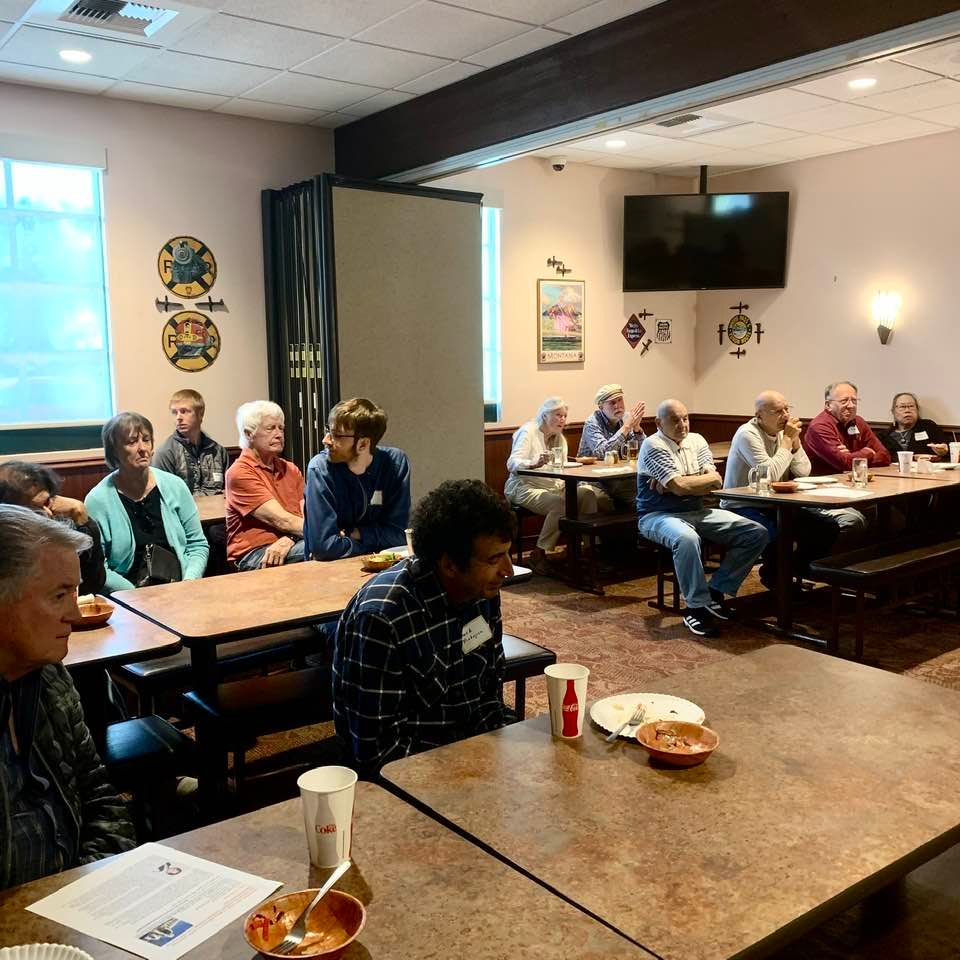
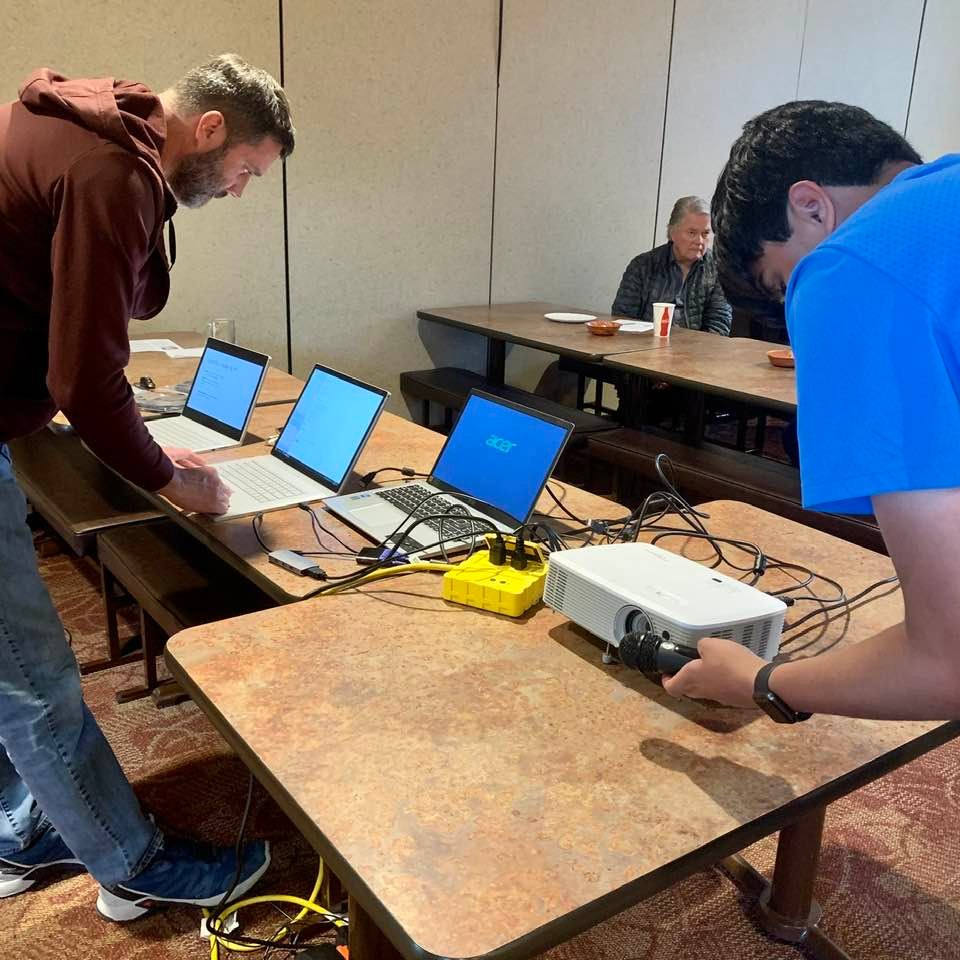
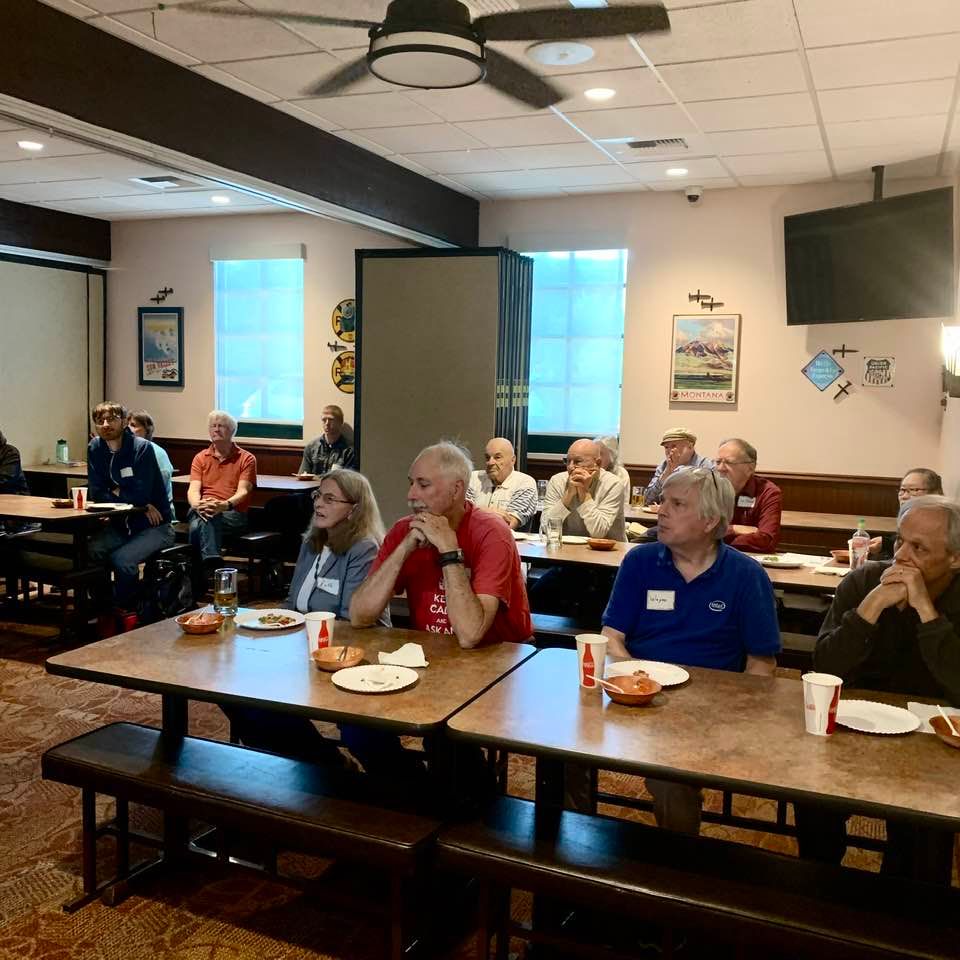
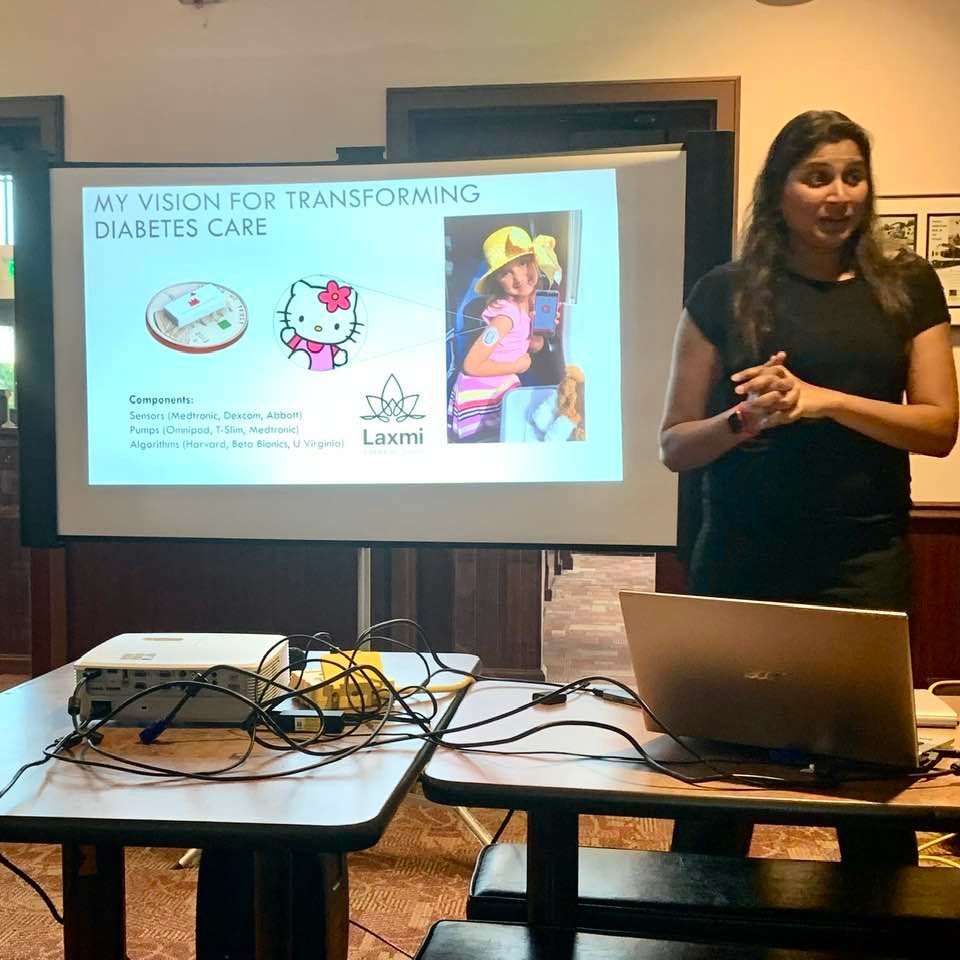
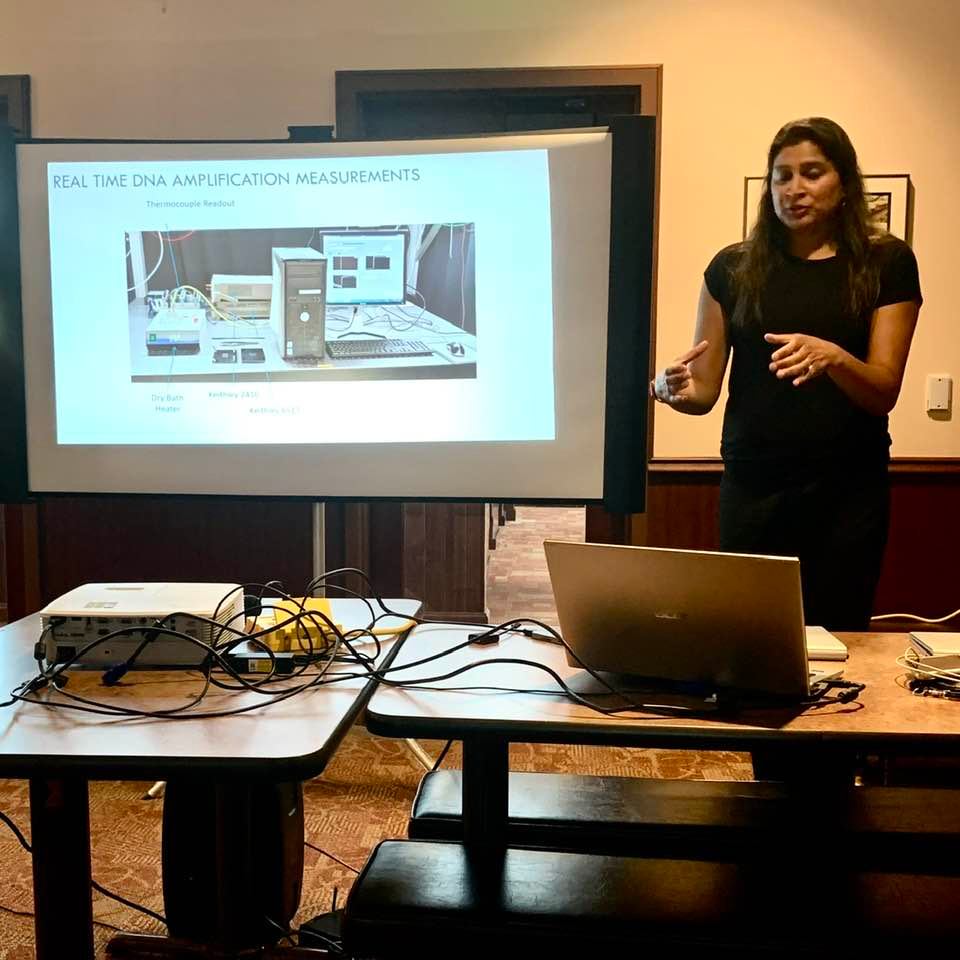
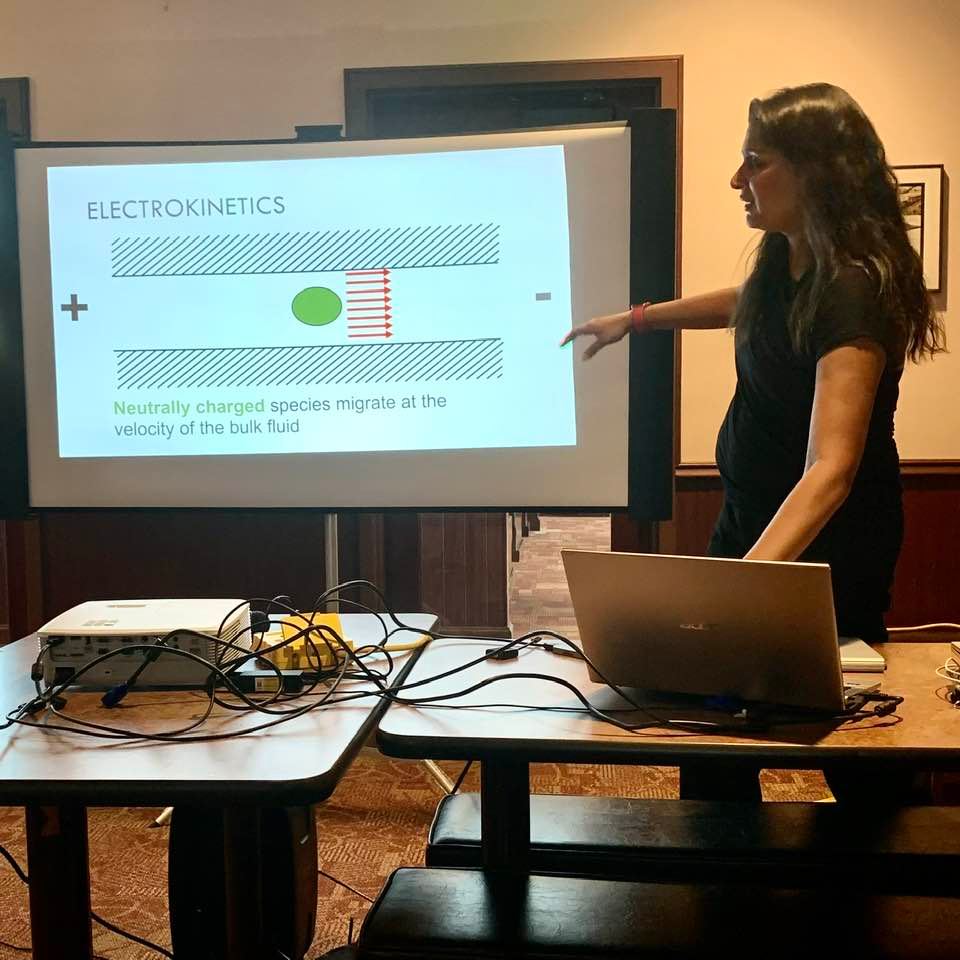
March 2022 speaker: Dr. Tim Sherwood
Affiliation: UCSB Computer Science Department
Title: "Temporal Computing: From Machine Learning to Superconducting Logic"
Date/Time: Wednesday, March 16, 2022; 6:00 PM PST
Venue: Rusty's Pizz, events room, 5934 Calle Real, Goleta, CA 93117
Links: IEEE CCS event page; Speaker's Web page
In an in-person event with ~25 attendees, held at Rusty's Pizza in Goleta, Dr. Tim Sherwood (UCSB CS) spoke under the title "Temporal Computing: From Machine Learning to Superconducting Logic."
Dr. Sherwood began by reviewing advances in computer technology and the computer industry over the past four decades as a lead-up to asking the question, "Where will computing be in four decades?" This is what university research is all about: laying down the foundations for building cheaper, faster, and more energy-efficient systems, now that existing technologies are struggling to offer continued exponential advances.
With existing digital technologies, signal propagation delay is a hindrance, an extra challenge to be dealt with in order to build faster systems and algorithms. Rather than fight against it, what if we could instead twist this delay into something actually useful, as already done by nature? Over the past several years Dr. Sherwood's labs have been developing a new foundation for computation based entirely on controlled signal delay that operates through the application of simple but powerful temporal operators (similar in spirit to AND, OR, and NOT but operating instead through signal delay alone).
While the idea of computing with time is theoretically interesting, Dr. Sherwood's group has shown it to be also surprisingly efficient in practice. Drawing insights from programming languages, machine learning, circuit design, information theory, cognitive science, and formal methods, Dr. Sherwood described a new energy-efficient method of temporal computation, based on MIN, MAX, INCREMENT, and INHIBIT operations, that appears to both closely match edge- and pulse-based forms of computing and lead to natural application in common learning and classification tasks.
While near term, Dr. Sherwood's group has shown temporal computing to lead to efficient implementations under traditional technologies, their most-recent work has revealed even more opportunities for realizing temporal-coded computations in superconducting logic. The latter extension is joint work between UC Santa Barbara (CS and ECE), Lawrence Berkeley National Laboratory, MIT Lincoln Laboratory, and National Institute of Standards and Technology.
About the speaker: Dr. Timothy Sherwood (BS, 1998, UC Davis, MS & PhD, 2003, UCSD, all in computer sci. & eng.) is a Professor of Computer Science, an affiliate of Electrical and Computer Engineering, and a member of UCSB's Institute for Energy Efficiency. He specializes in the development of processors exploiting novel technologies or provable properties. In 2013 he co-founded Tortuga Logic to bring rich security analysis to the hardware and embedded system design processes. He is a recipient of UCSB Academic Senate's Teaching and Mentoring Awards, winner of ACM SIGARCH's Maurice Wilkes Award, an ACM Distinguished Scientist, an IEEE Fellow, and co-recipient of 17 different "best paper" or "top pick" article awards.
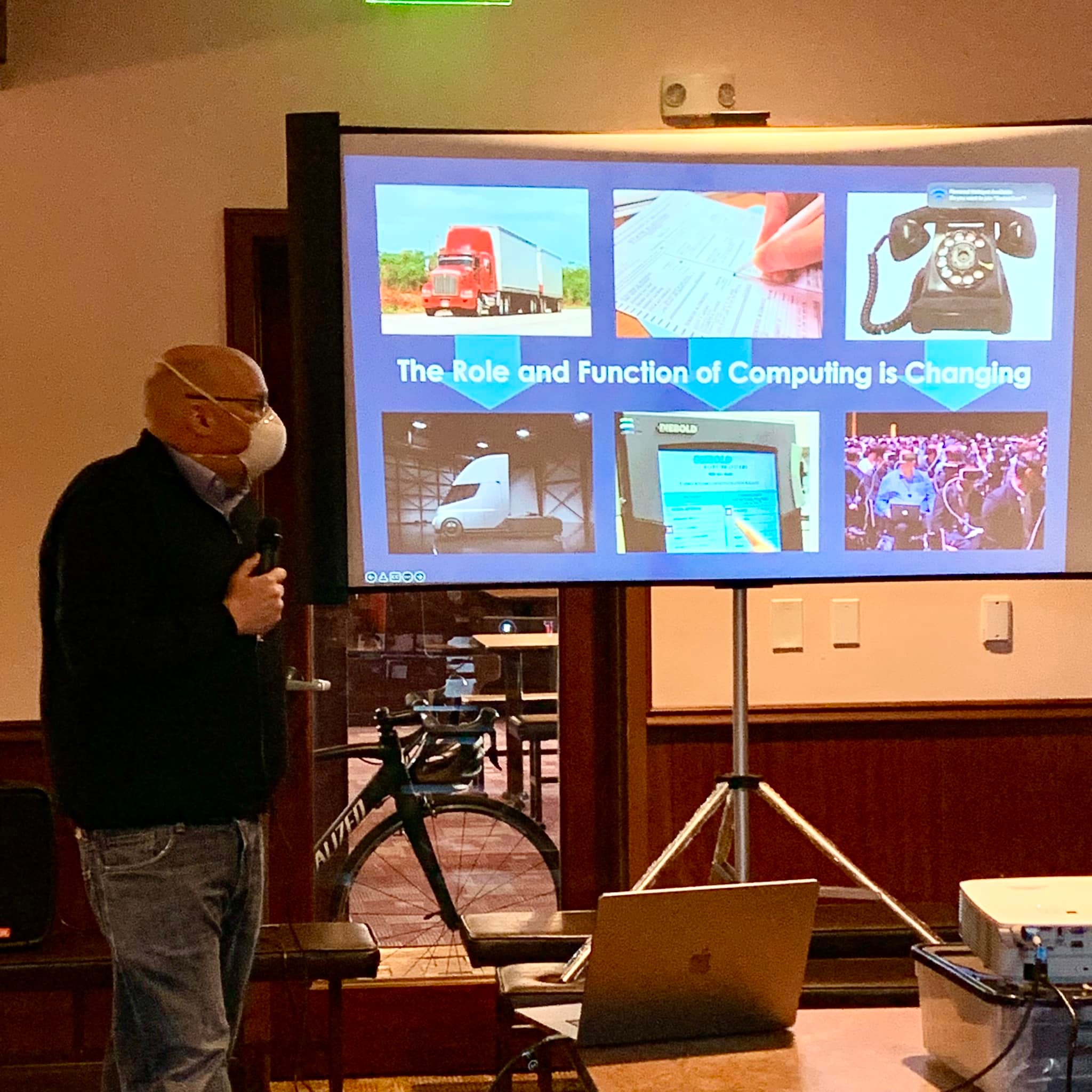
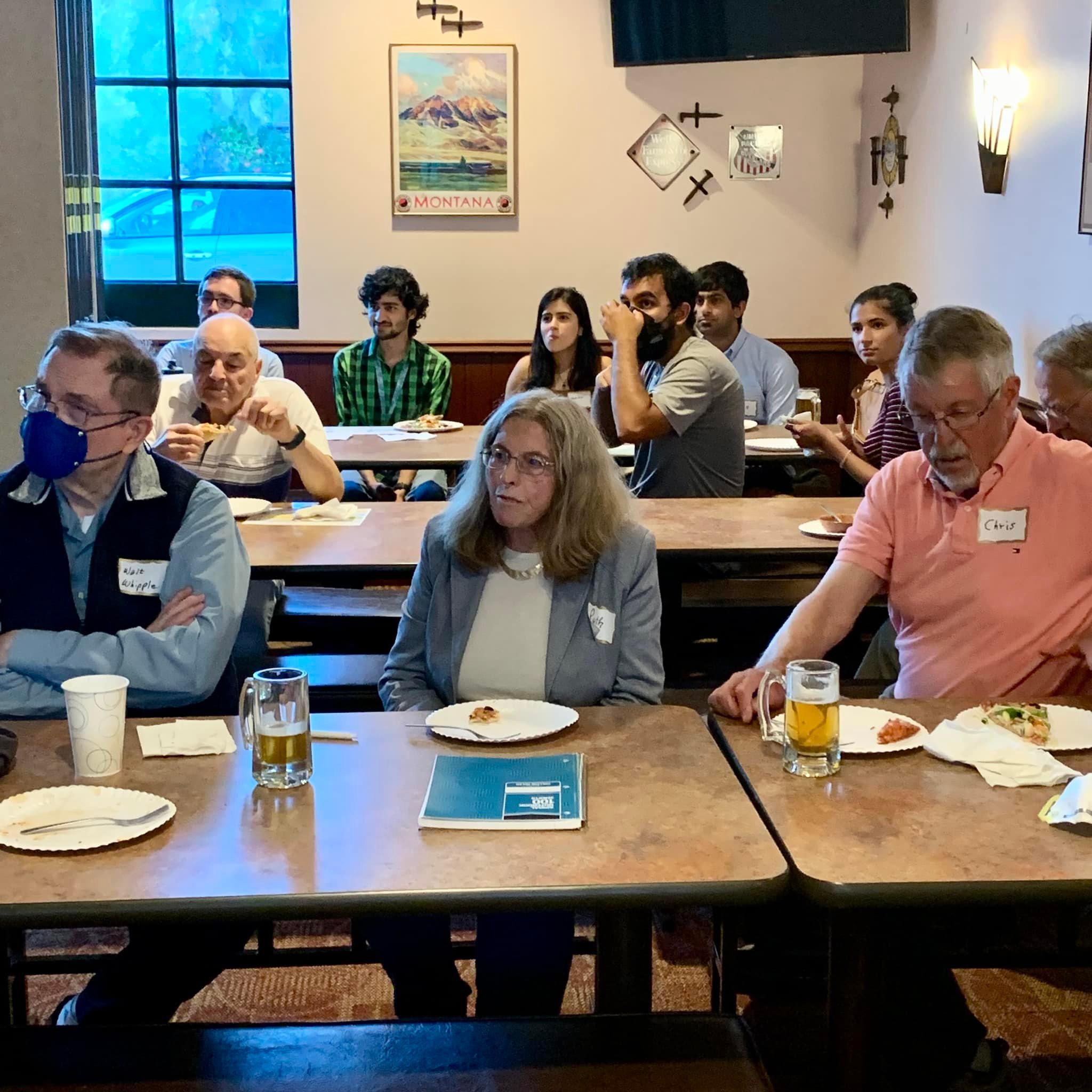
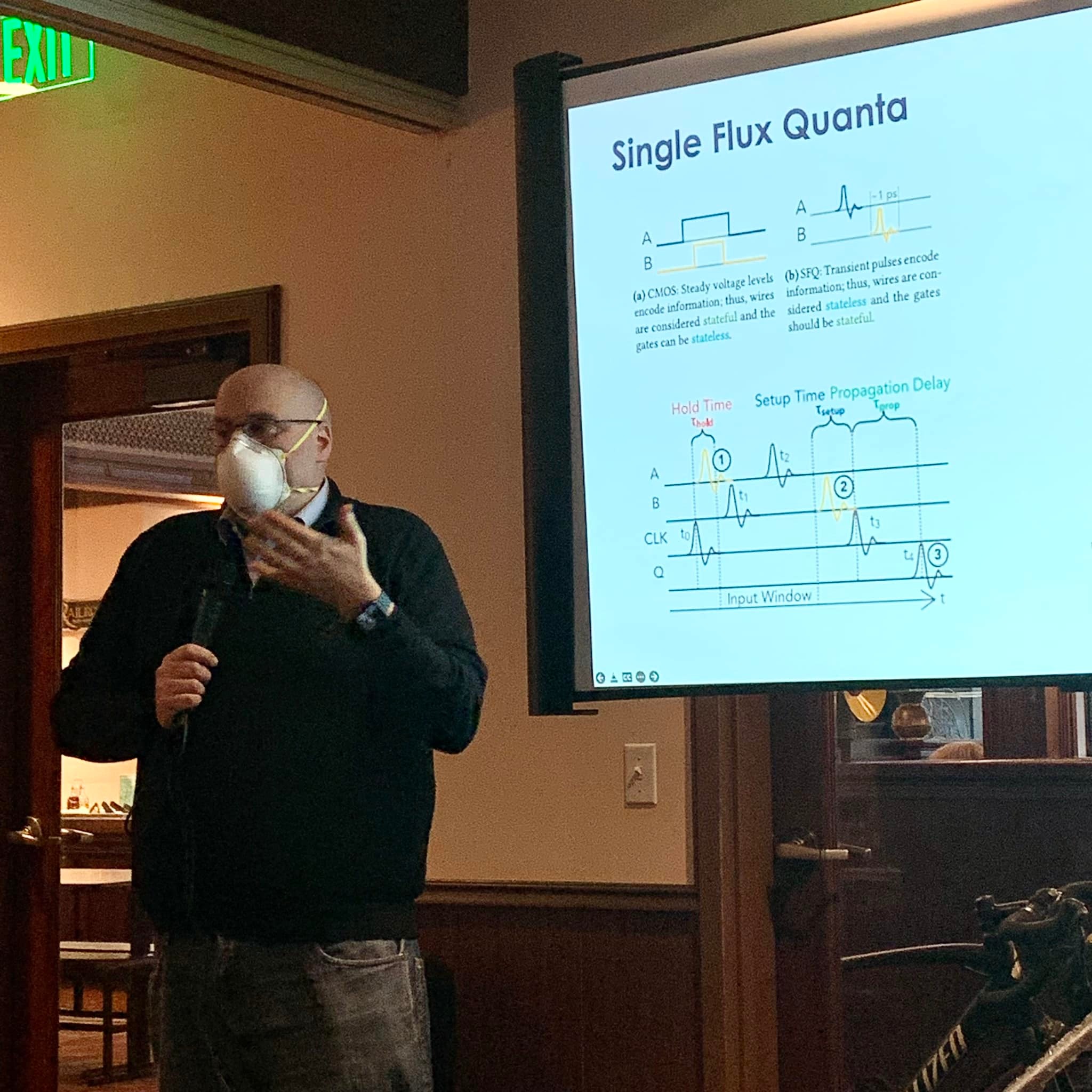
February 2022 presenter: UCSB Physics Circus
Affiliation: UCSB Department of Physics Outreach Program
Title: "Fun, Informative Electricity and Other Physics Demos" (Bring the kids!)
Date/Time: Wednesday, February 16, 2022; 6:00 PM PST
Venue: Rusty's Pizza, events room, 5934 Calle Real (just to the east of Fairview Ave.), Goleta, CA 93117
Links: IEEE CCS event page; Physics Circus Demos List
UCSB Physics Circus (an outreach program of UCSB's Department of Physics) joined us at the Goleta Rusty's Pizza on Calle Real for a number of fun physics demos for the ~40 attendees. This was our second in-person event since the onset of the COVID-19 pandemic (the previous one being our holiday banquet on December 15, 2021). We had asked members and guests to bring their children along, and they did!
For decades the Physics Circus has been a wonderful opportunity for UCSB students to creatively express anything that animates them about physics. Members of Physics Circus, mentored by Professor Jean Carlson, share their joy of physics with school children and others who are curious about underlying principles of physical phenomena.
Physics graduate student George Hulsey led student volunteers (Sabrina Brickner, Brian Ly, Fernanda Vasquez Sanchez, David Jiang, Raymond Hughes) who presented demos in the areas of angular momentum, sound, air pressure, alternating current, static electricity, magnetism, and cooling with liquid nitrogen.
There were lots of questions, including from the little ones, during the demos and at the end of the presentations. A few future scientists may have been fashioned tonight, thanks to enthusiastic and knowledgeable physics students from UCSB.
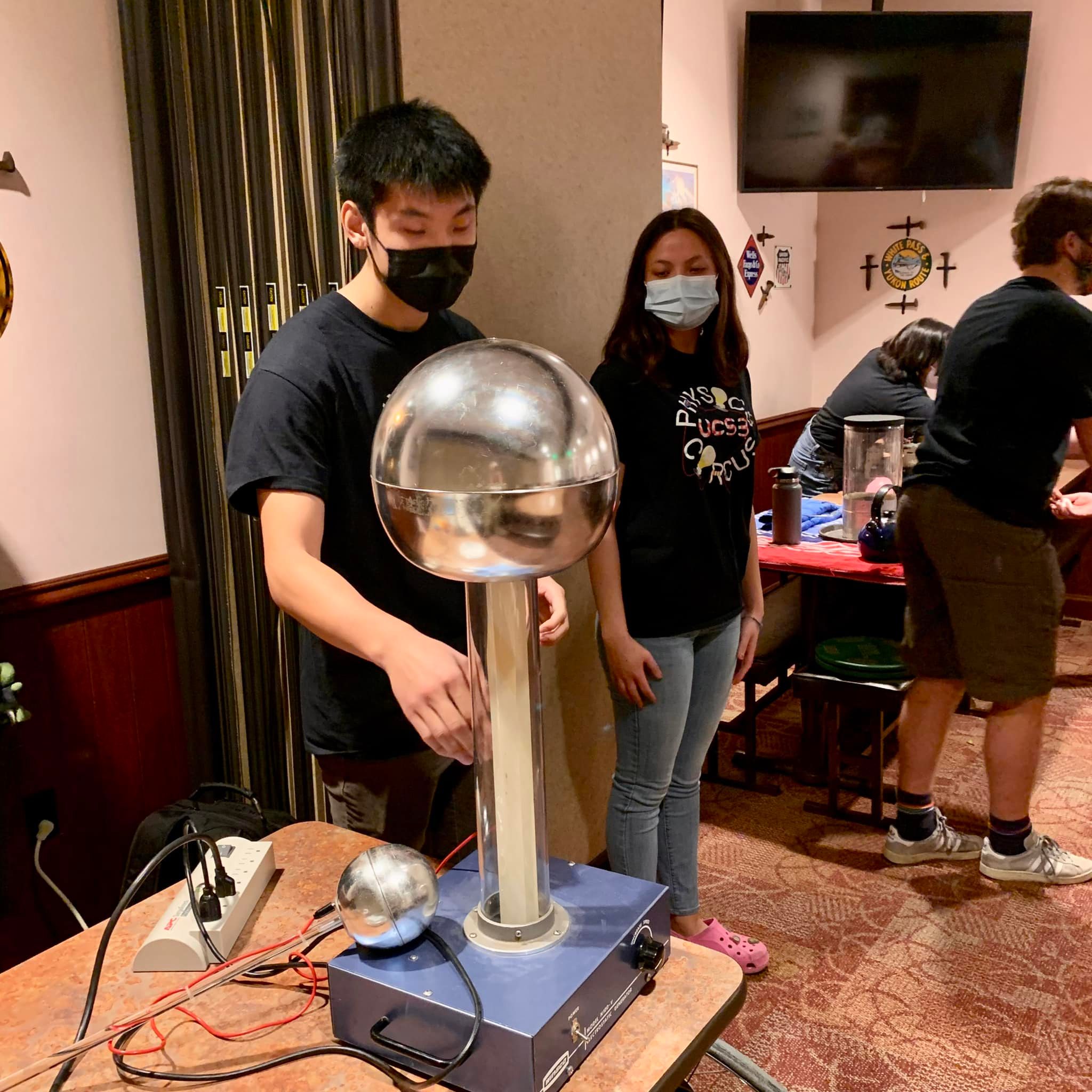
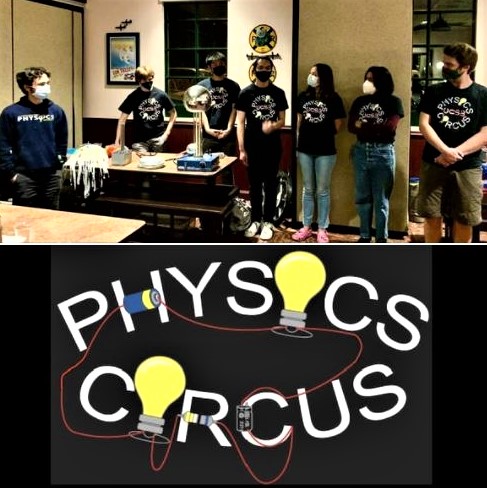
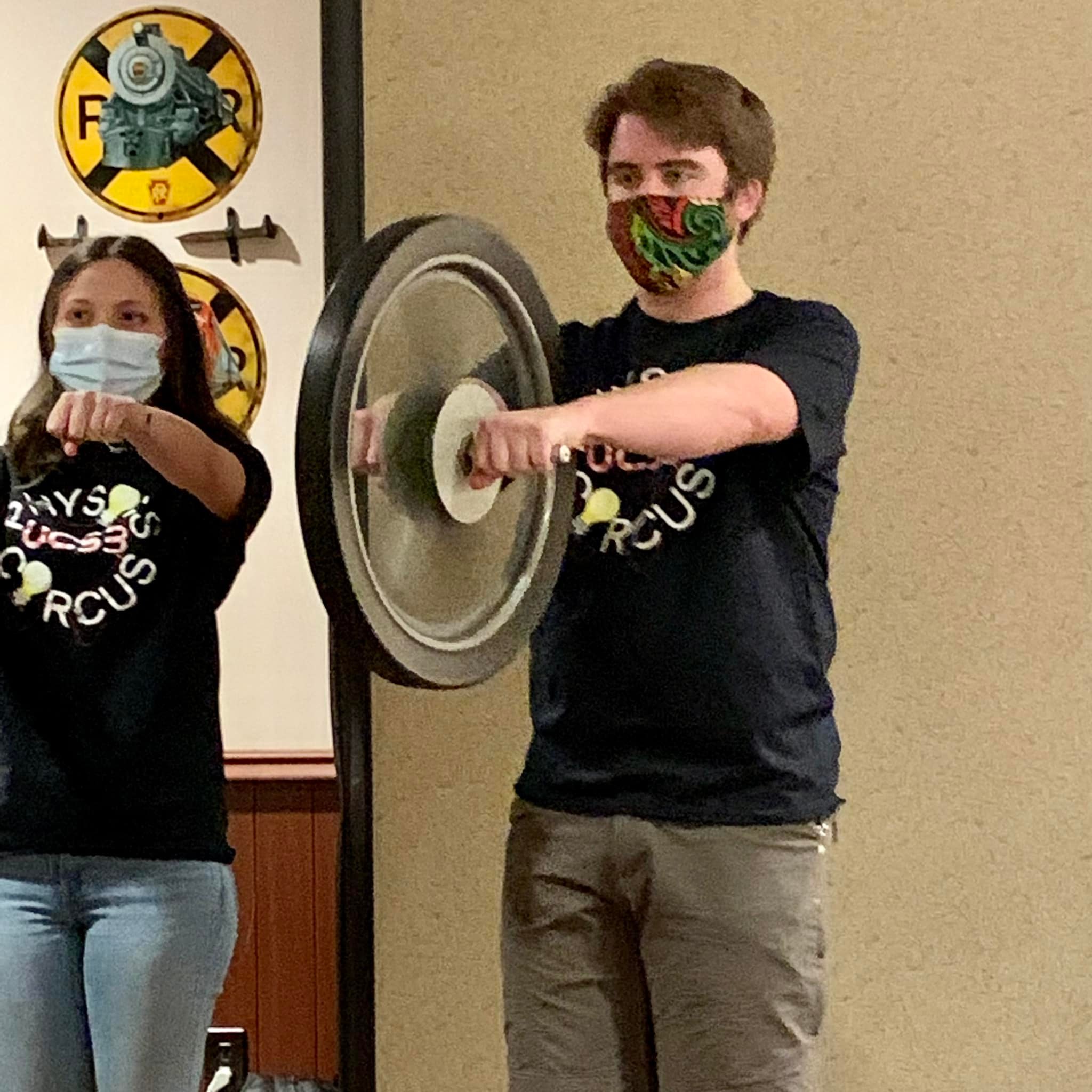
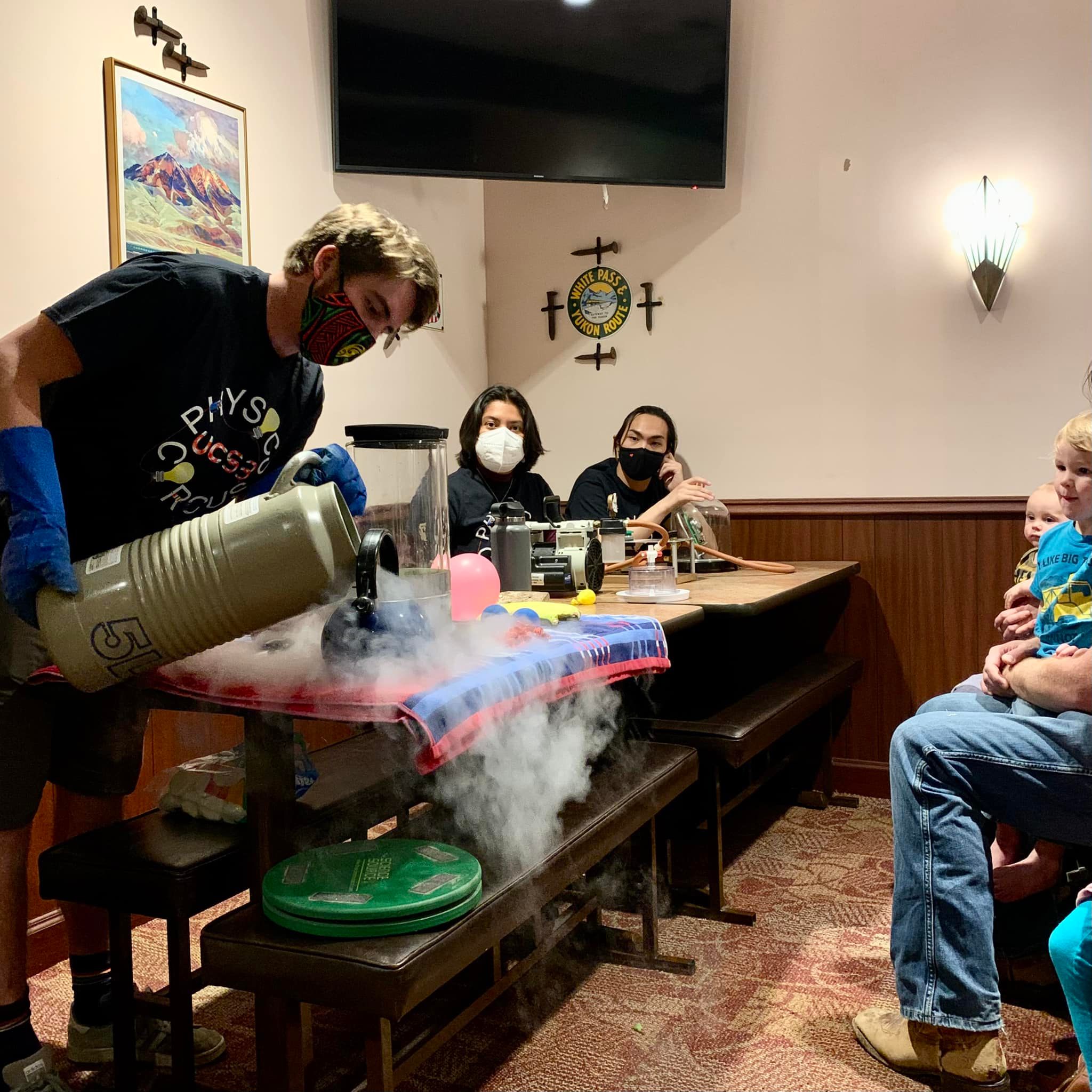
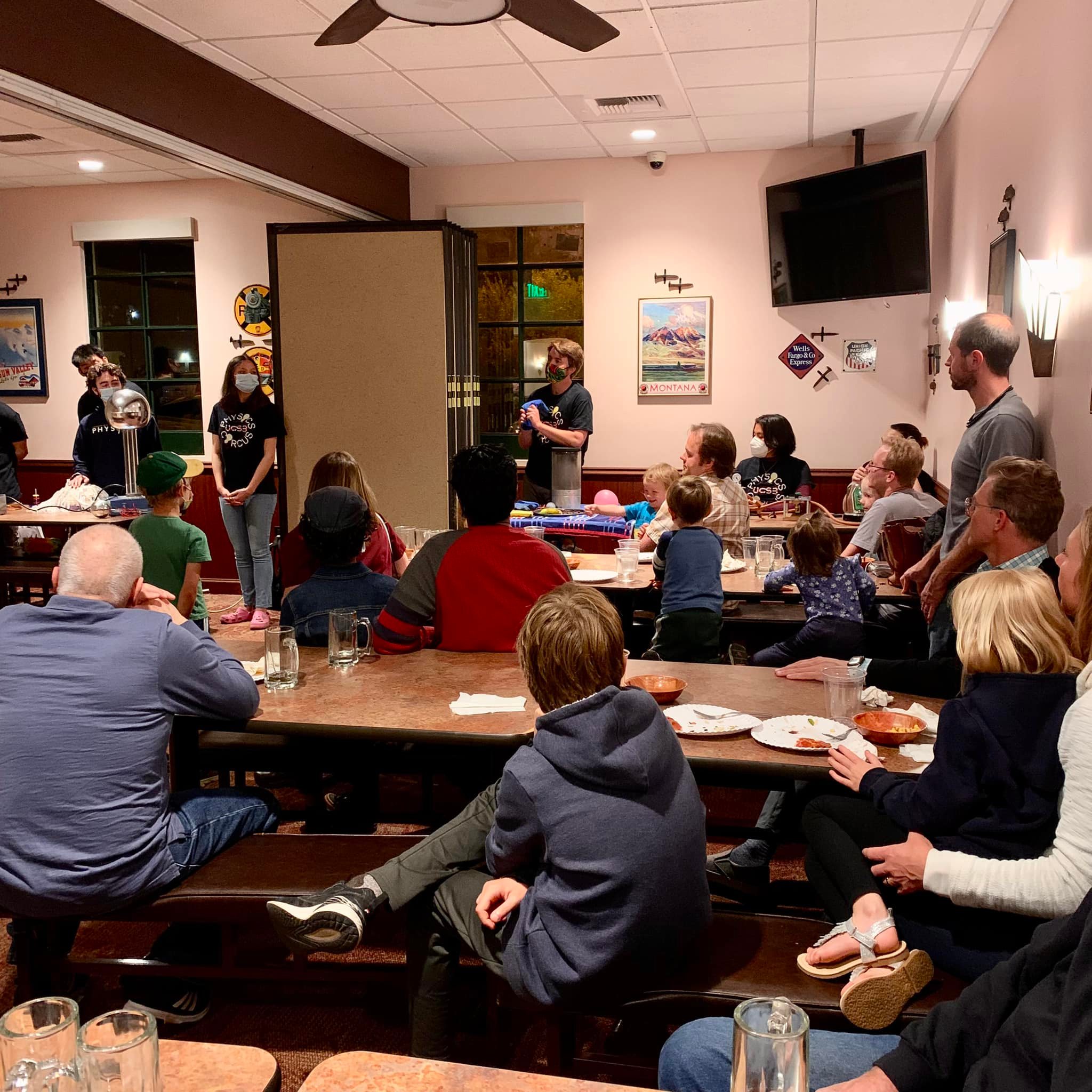
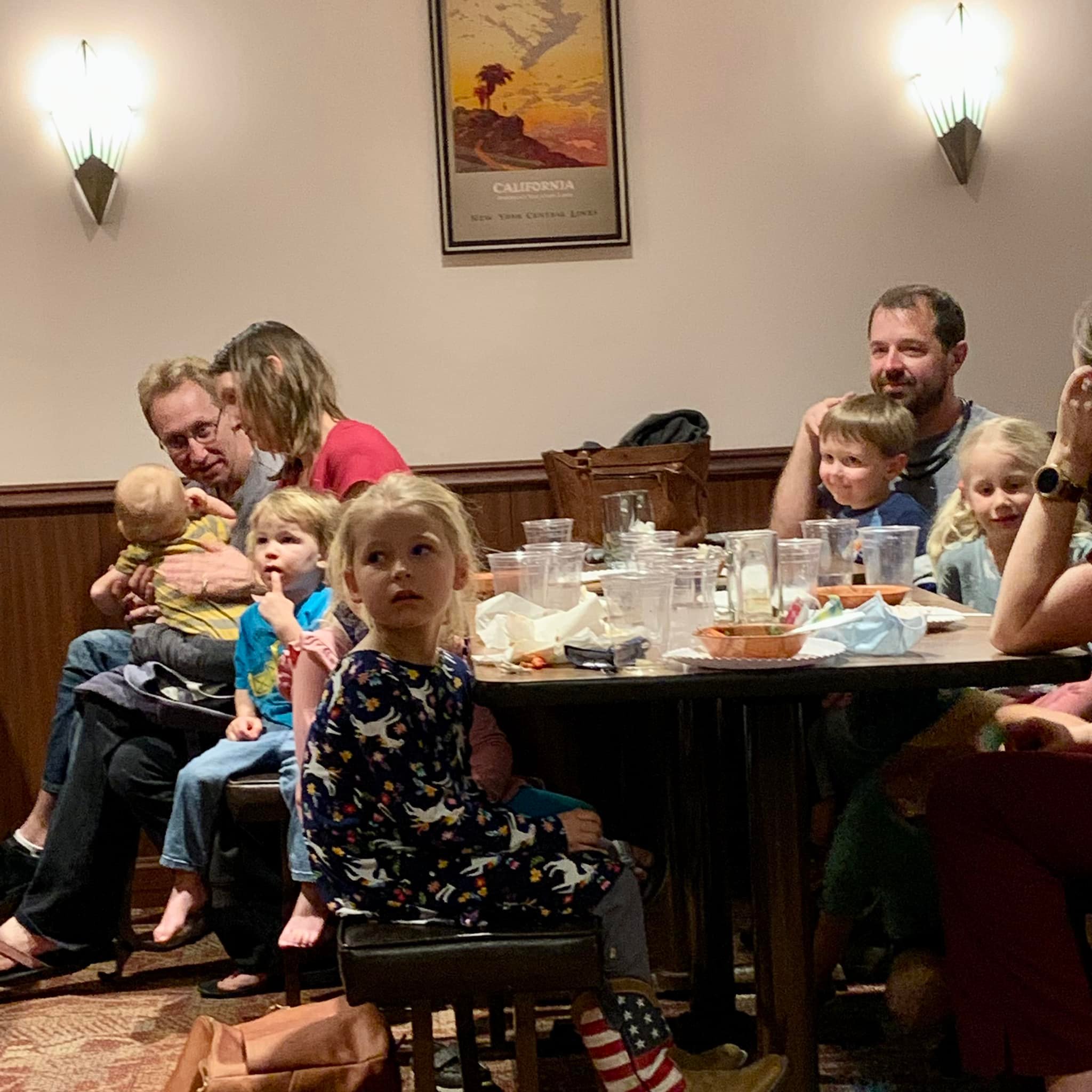
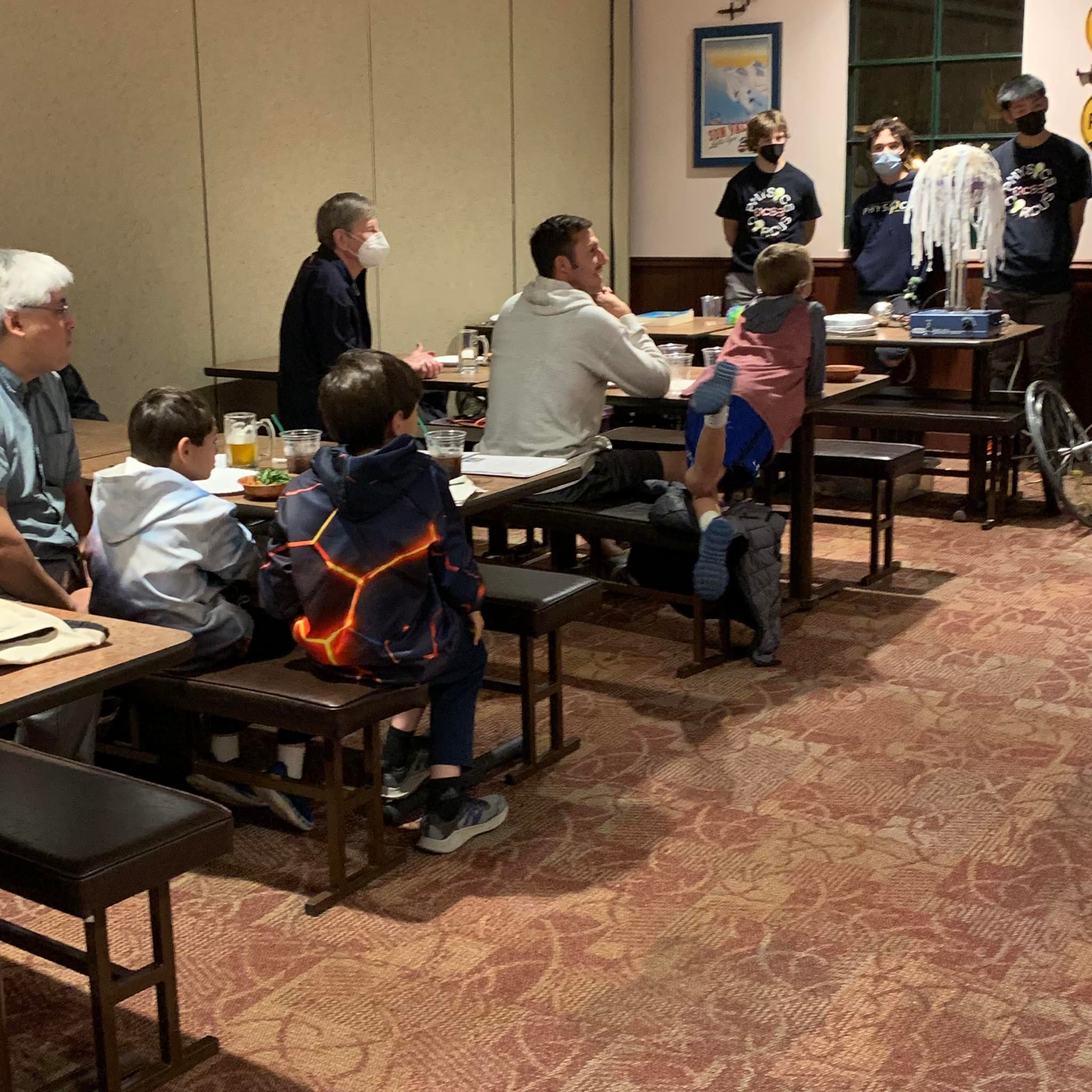
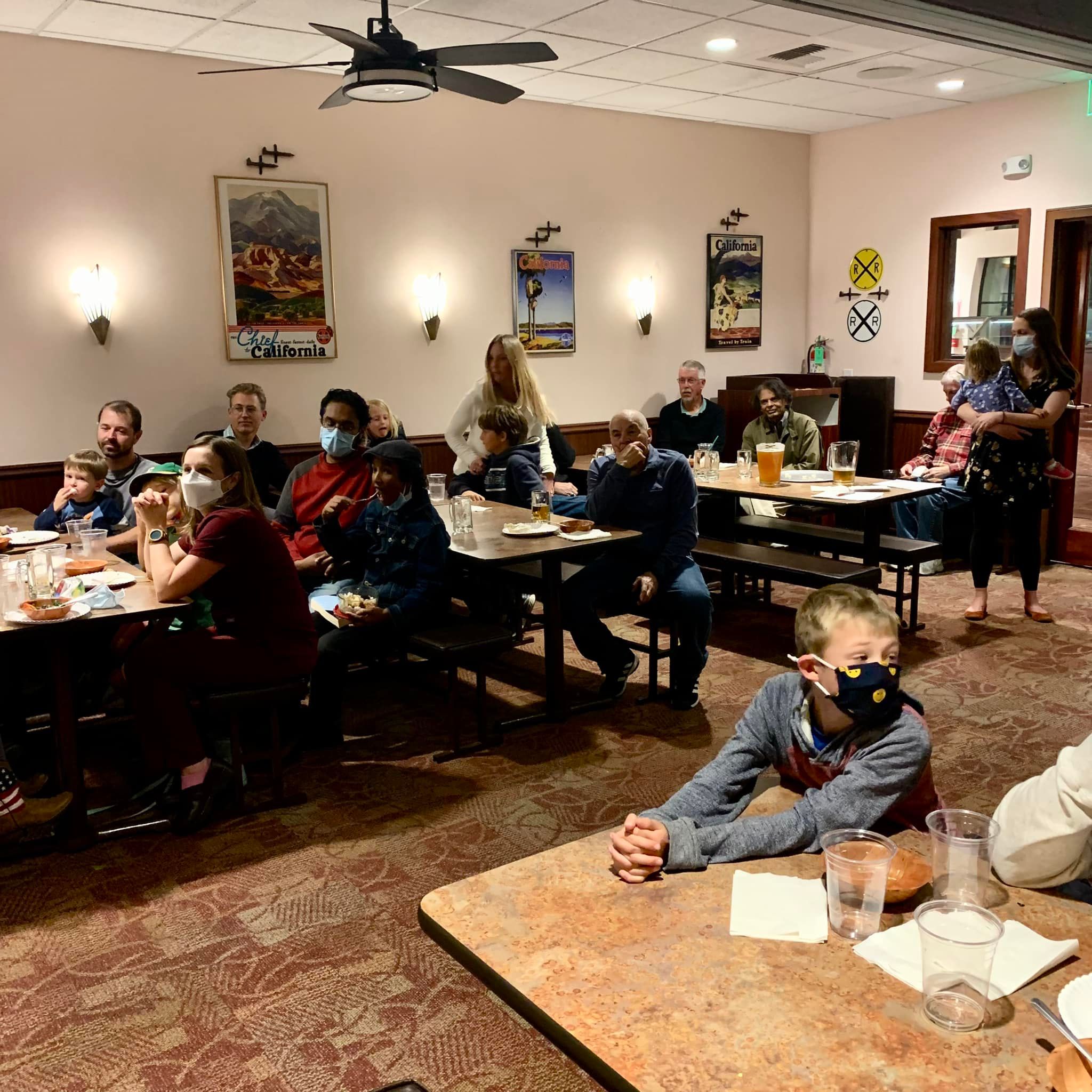
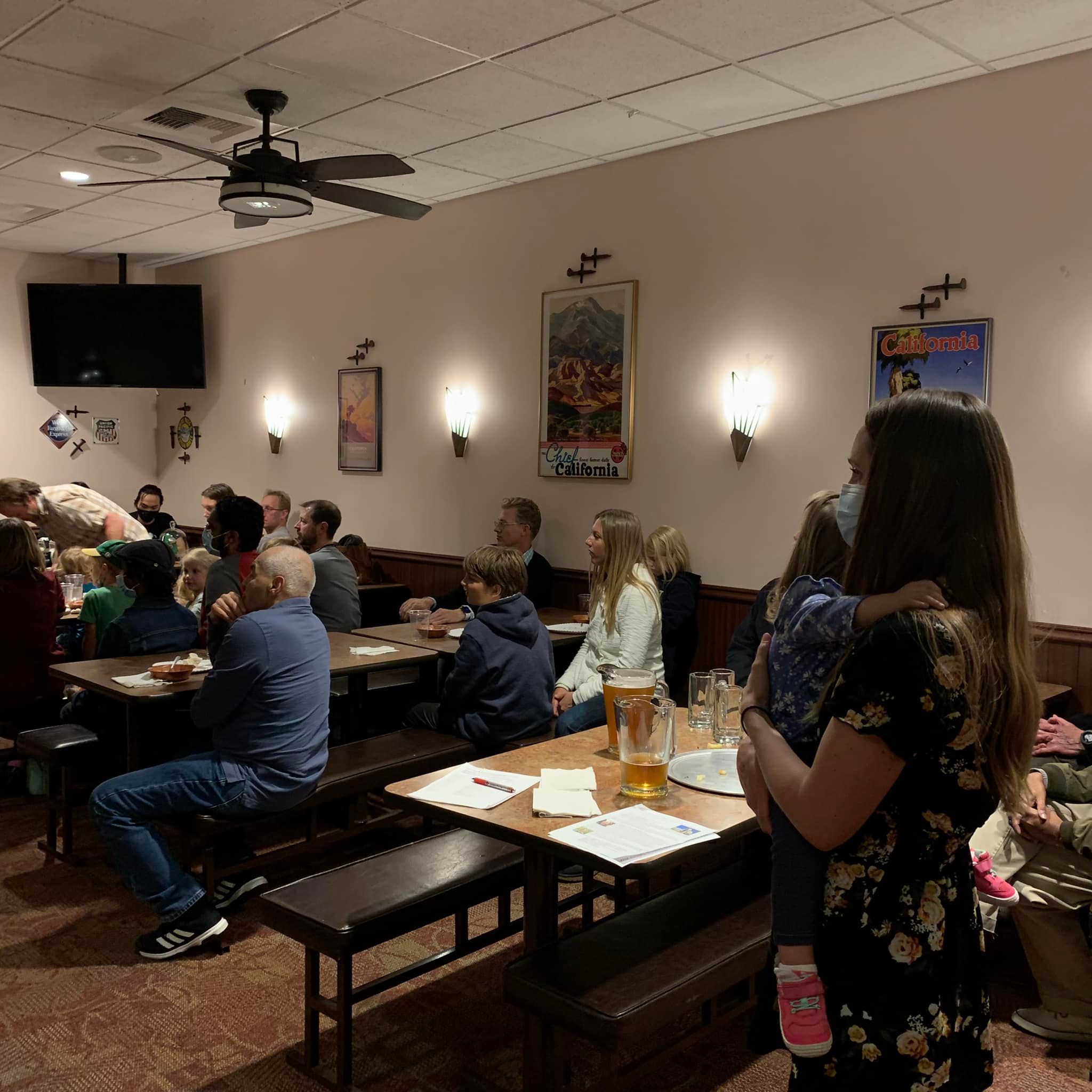
January 2022 speaker: Dr. Behrooz Parhami
Affiliation: Electrical and Computer Engineering Department, UCSB
Title: "Interconnection Networks for Parallel Processors and Data Centers"
Date/Time: Wednesday, January 19, 2022; 6:30 PM PST
Venue: Zoom (details provided to those who register)
Links: Event page; Speaker's home page; Speaker's publications page; Slides; Recording
After holding its December 2021 talk in person alongside a holiday banquet, IEEE CCS returned to Zoom format, given new developments in the COVID-19 pandemic. The speaker was Dr. Behrooz Parhami, presenting one of his IEEE Computer Society Distinguished Visitors Program talks entitled "Interconnection Networks for Parallel Processors and Data Centers."
The gist of tongiht's talk was that both parallel processors and data centers are composed of a collection of compute nodes (or servers) and a set of interconnects, the latter being just as important as, if not more important than, compute nodes. In fact, chip-multiprocessors and computer networks, such as the Internet, are also similar, in that they have nodes and links, but differ in their scales. Chip-multiprocessors, which are essentially small-scale parallel processors, have given rise to the area of networks-on-chip. The Internet is not as sensitive to delays as networks for parallel processors and data centers. If you type in a Google search query, response times on the order of a second are tolerable, whereas in one second, a top-of-the-line parallel processor executes on the order of 10^18 operations (exa-ops).
Interconnecting multiple processors in a parallel supercomputer or servers in a data center constitutes a challenging problem. There are so many ways to interconnect the computing nodes that the range of options has come to be known as "the sea of interconnection networks." The talk began by outlining the theoretical underpinnings of interconnection network design in a way that exposed the challenges. In addition to the underlying, as-yet-unsolved mathematical problem known as the degree-diameter problem, practical considerations such as power-frugality, performance under realistic loads, packageability, quality of service, robustness, reliability, symmetry, scalability, and serviceability (which are referred to as the PQRS attributes) come into play. The speaker then reviewed desirable network properties and related them to various network classes that have been used or proposed. Emphasis was placed on robustness attributes of networks, given that large networks with many thousands or perhaps even millions of nodes are bound to experience malfunctions in nodes and links.
About the speaker: Behrooz Parhami (PhD in computer science from UCLA, 1973) is Professor of Electrical and Computer Engineering, and former Associate Dean for Academic Personnel, College of Engineering, at UCSB. He has research interests in computer arithmetic, parallel processing, and dependable computing. His technical publications include over 300 papers in peer-reviewed journals and international conferences, a Persian-language textbook, and an English/Persian glossary of computing terms. Among his publications are three textbooks on parallel processing (Plenum, 1999), computer arithmetic (Oxford, 2000; 2nd ed. 2010), and computer architecture (Oxford, 2005). Professor Parhami is a Life Fellow of IEEE, a Fellow of IET, a Chartered Fellow of the British Computer Society, a member of the Association for Computing Machinery and American Society for Engineering Education, and a Distinguished Member of the Informatics Society of Iran for which he served as a founding member and President during 1979-84. Professor Parhami has served on the editorial boards of IEEE Trans. Sustainable Computing (since 2016), IEEE Trans. Computers (2009-2014; 2016-now), IEEE Trans. Parallel and Distributed Systems (2006-2010), and International J. Parallel, Emergent and Distributed Systems (2006-2012). He also chaired IEEE's Iran Section (1977-1986), received the IEEE Centennial Medal in 1984, and was honored with a most-cited paper award from J. Parallel & Distributed Computing in 2010. His consulting activities cover the design of high-performance digital systems and associated intellectual property issues.
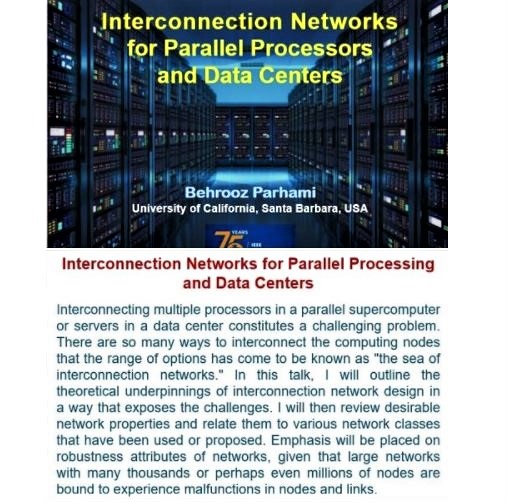
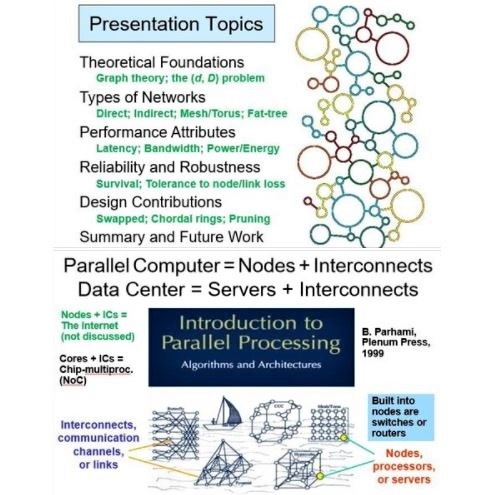
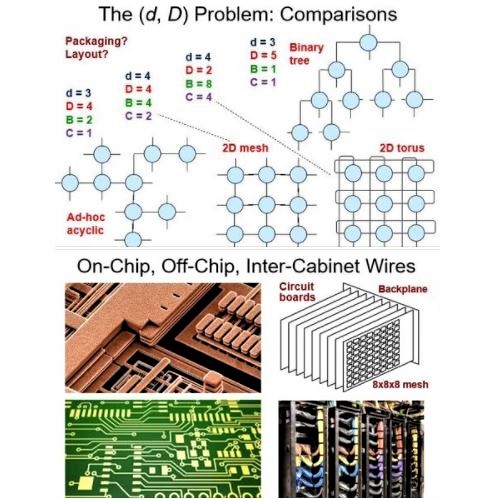
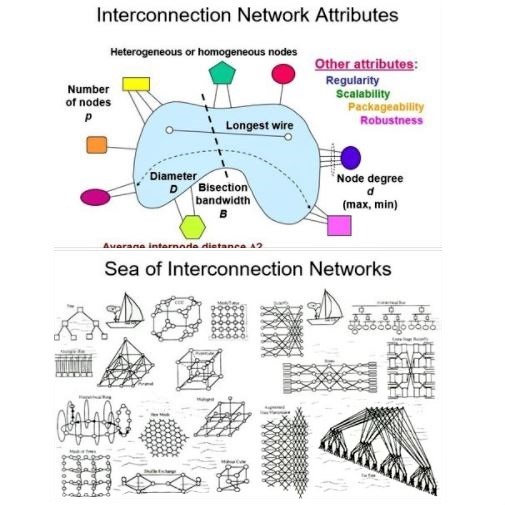
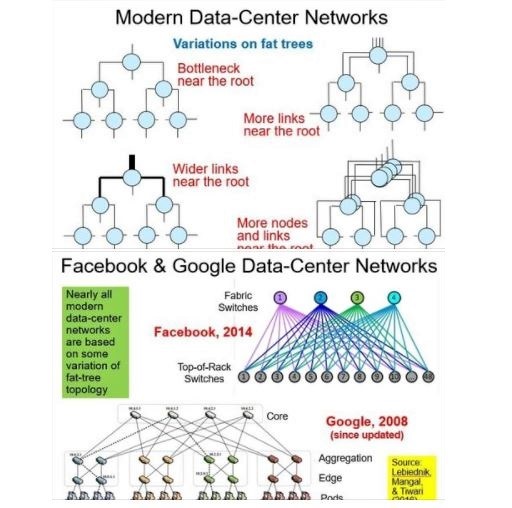
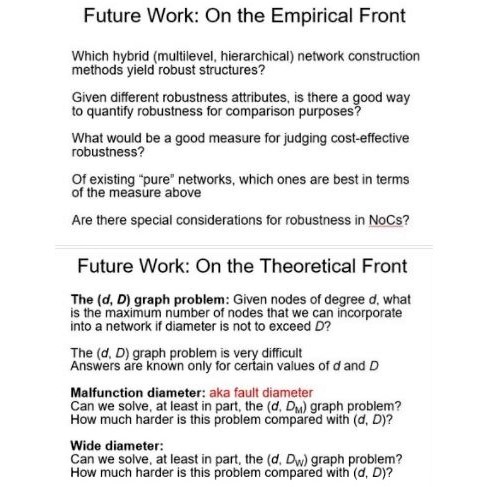
December 2021 speaker: Kristin Bell
Affiliation: Community Manager, Hub101
Title: "Bringing Entrepreneurial Ideas to Life to Build and Scale New Businesses"
Date/Time: Wednesday, December 15, 2021; 6:30-9:00 PM PST (talk at 7:30)
Venue: Mulligan's Cafe at Santa Barbara Golf Club, 3500 McCaw Ave, Santa Barbara, CA 93105
Links: IEEE CCS event page; Hub101 home page
Recording of an earlier talk on the same topic by the speaker for IEEE Buenaventura Section: YouTube video
After appetizers, salad, and main course at Santa Barbara's Mulligan's Cafe and Section Education Chair's brief review of seven upcoming IEEE CCS tech talks in early 2022, Ms. Kristin Bell (Community Manager of Hub101, Cal Lutheran University) spoke under the title "Bringing Entrepreneurial Ideas to Life to Build and Scale New Businesses."
Ms. Bell shared with the audience of ~30 aspects of how Hub101 enables entrepreneurs to bring their ideas to life and ultimately build and scale businesses. Hub101 serves startups, including collaboration through coworking, discovery through educational programs, growth through mentorship, and community-building through events. One of the incubator's newest initiatives is a 12-week, cohort-based program that takes entrepreneurs from an idea, through validation and development, to launch.
Ms. Bell also highlighted various startups that launched out of Hub101, including those that closed tens or hundreds of millions in fundraising, found their technical co-founders, received mentorship that changed their trajectories, secured substantial partnerships, and more.
Finally, Ms. Bell discussed the immense value mentors and advisors bring to an entrepreneur's journey and the various ways Hub101's network of mentors supports its programs with a "Give First" mindset—the most critical ingredient in a vibrant, resilient startup community.
About the speaker: Ms. Kristin Bell has an MBA in Enterprise Innovation & Entrepreneurship, 10+ years of experience in marketing strategy and implementation in work with early-stage and growth-stage ventures, and serves as Community Manager of Hub101, Cal Lutheran University's coworking space and launchpad for entrepreneurs and startups of various stages. She develops educational programs to guide entrepreneurs through the process of launching a business and programs to educate mentors on how to advise and engage with entrepreneurs. She also organizes Cal Lutheran's New Venture Competition, which showcases student-led startups. Ms. Bell is an entrepreneurship educator and teaches entrepreneurship at Oaks Christian School and for Cal Lutheran University's Executive MBA Program. She also manages operations, portfolio, and deal flow for Santa Barbara Angel Alliance, a group of angel investors in Southern California. Ms. Bell mentors startups in the US and abroad, including in the UK, Greece, Saudi Arabia, and Austria. She is passionate about the entrepreneurial ecosystem and supporting entrepreneurs.
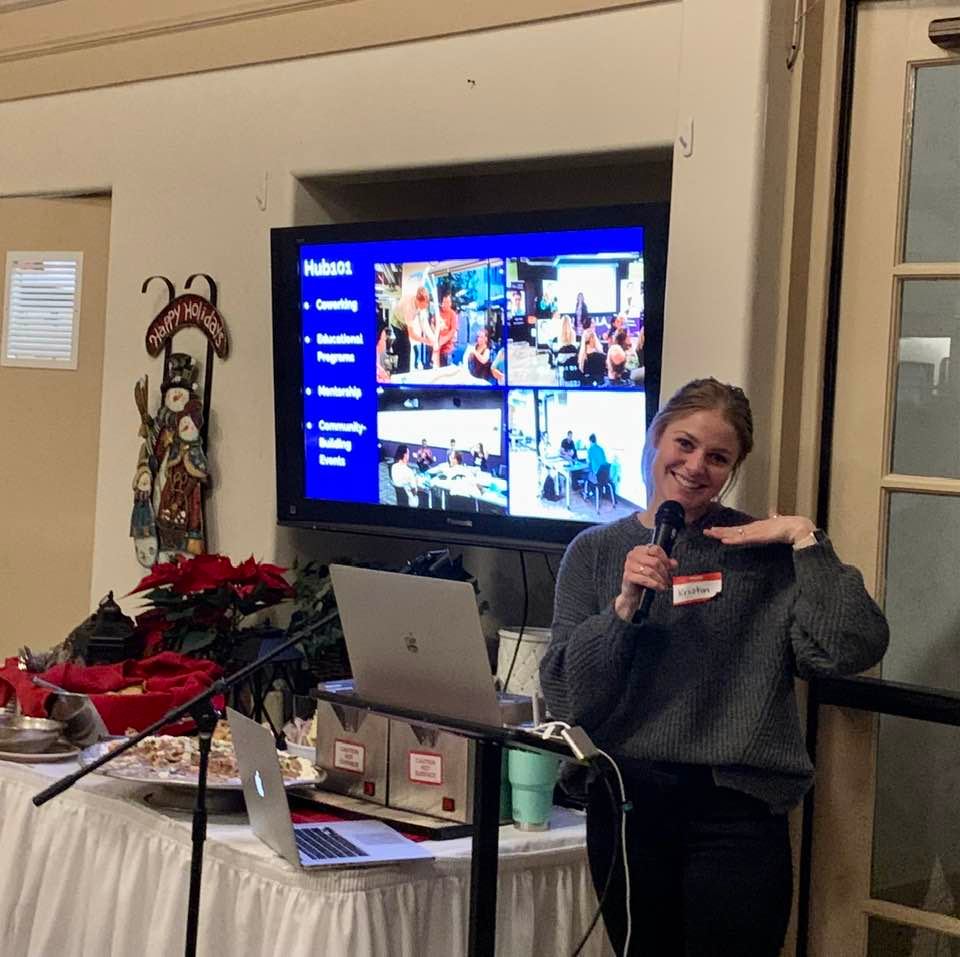
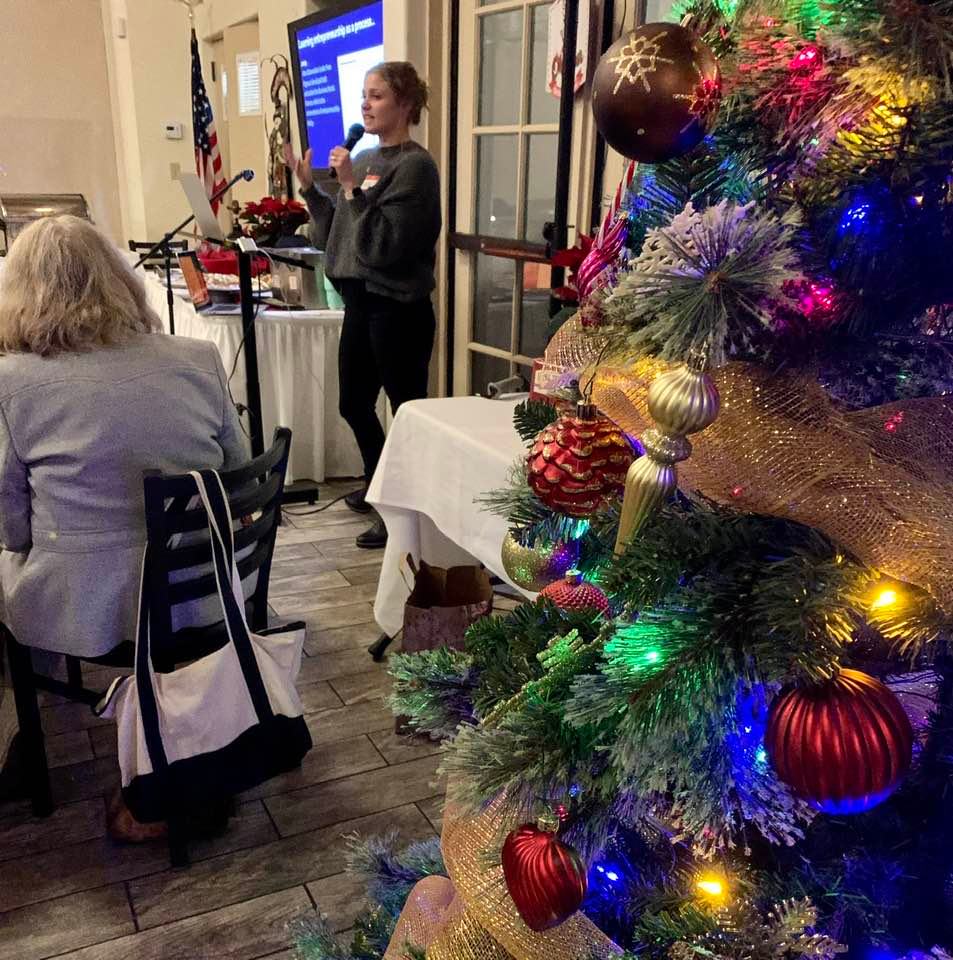
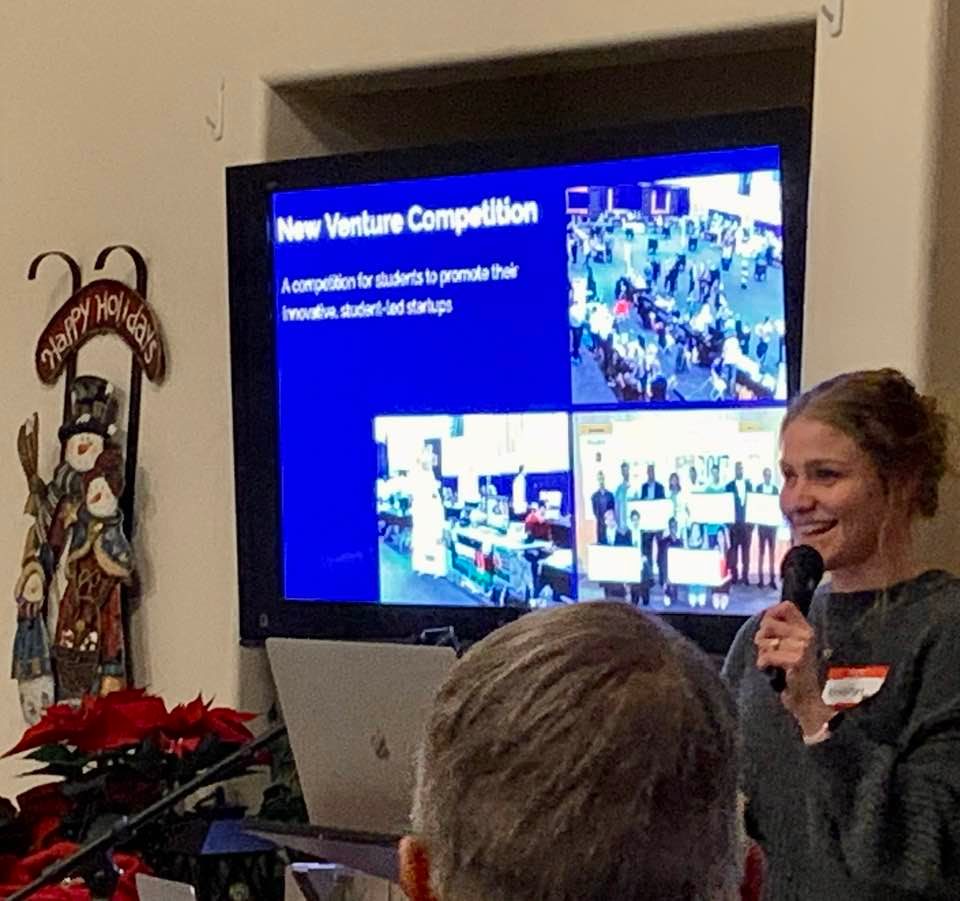
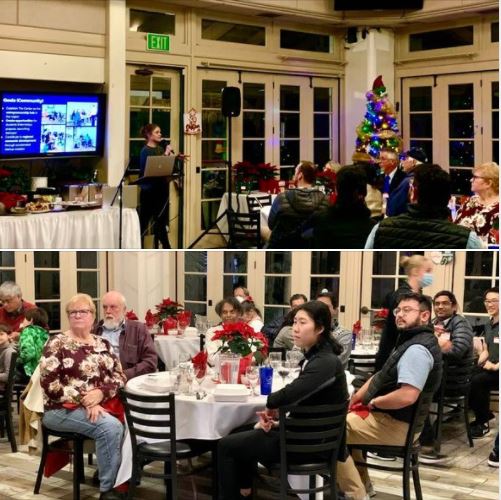
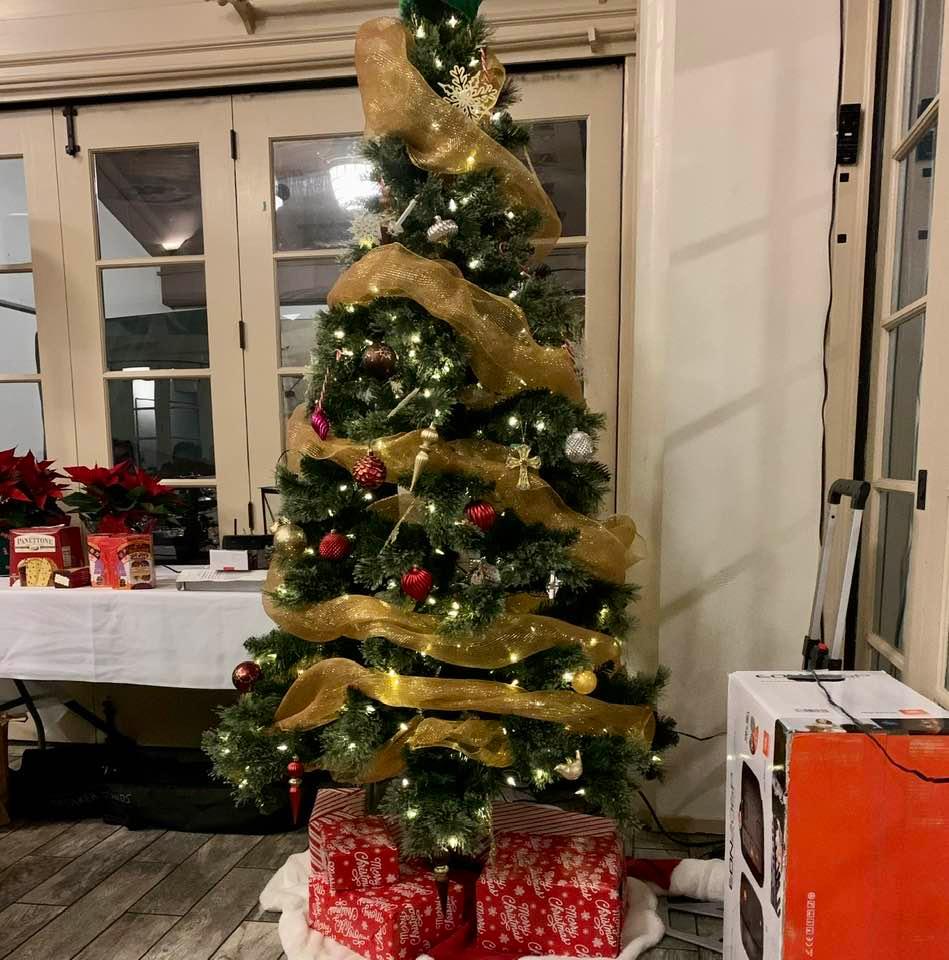
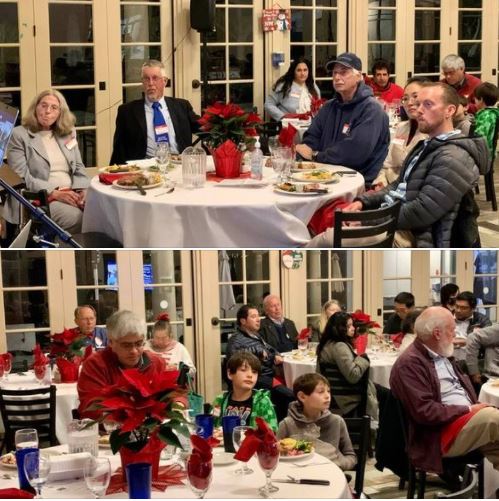
November 2021 speaker: Dr. Megan Valentine
Affiliation: Professor, Mechanical Engineering Department, UCSB
Title: "Exceptional Soft Materials, Inspired by Nature"
Date/Time: Wednesday, November 17, 2021; 6:30-8:00 PM PST
Venue: Zoom
Links: IEEE CCS event page; Speaker's home page
Summary: Nature is replete with extraordinary materials. Noteworthy properties of these materials include lasting, growing, moving, adapting, aging, and healing.
In the first half of her talk, Dr. Valentine described her group's efforts to develop ultrastiff, ultratough materials inspired by the byssal materials of marine mussels. These adhesive contacts allow mussels to secure themselves to rocks, wood, metals and other surfaces in the harsh conditions of the intertidal zone. Mimicking these properties has led to the development of medical adhesives, to cite one example. A foundational understanding of the structure-mechanics relationships and processing of the natural system would allow us to design high-performance materials that are extremely strong, without compromising extensibility, as well as macroporous materials with tunable toughness and strength.
In the second half of her talk, Dr. Valentine discussed new efforts to exploit light as a means of remote control and power. Leveraging the phototransduction pathways of highly-absorbing, negatively photochromic molecules can help drive the motion of amorphous polymeric materials as well as liquid flows. Inspired by muscles, but implemented somewhat differently, the use of photo-responsive material for actuation has many potential applications. These innovations enable improvements in packaging, connective tissue repair, soft robotics, and optofluidics.
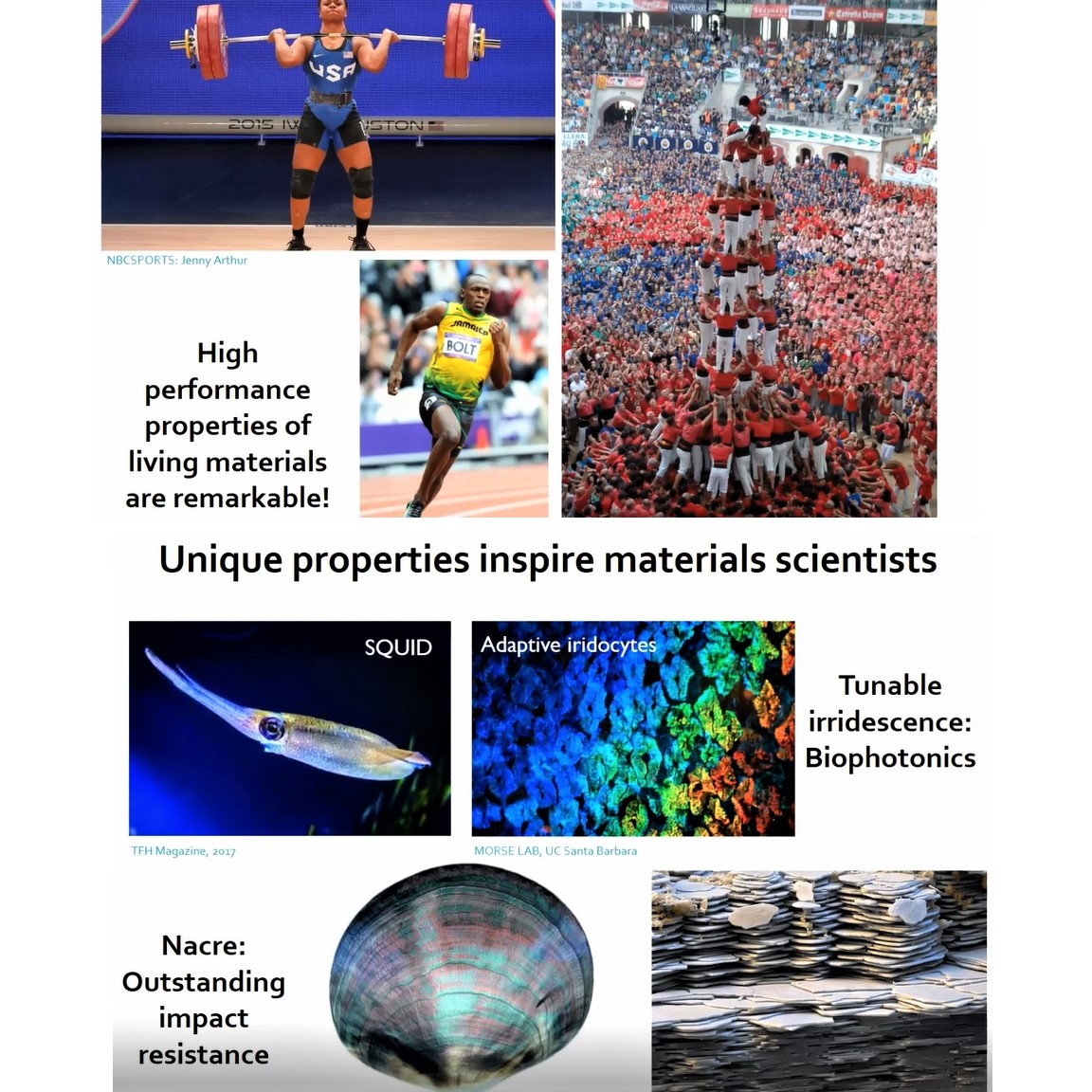
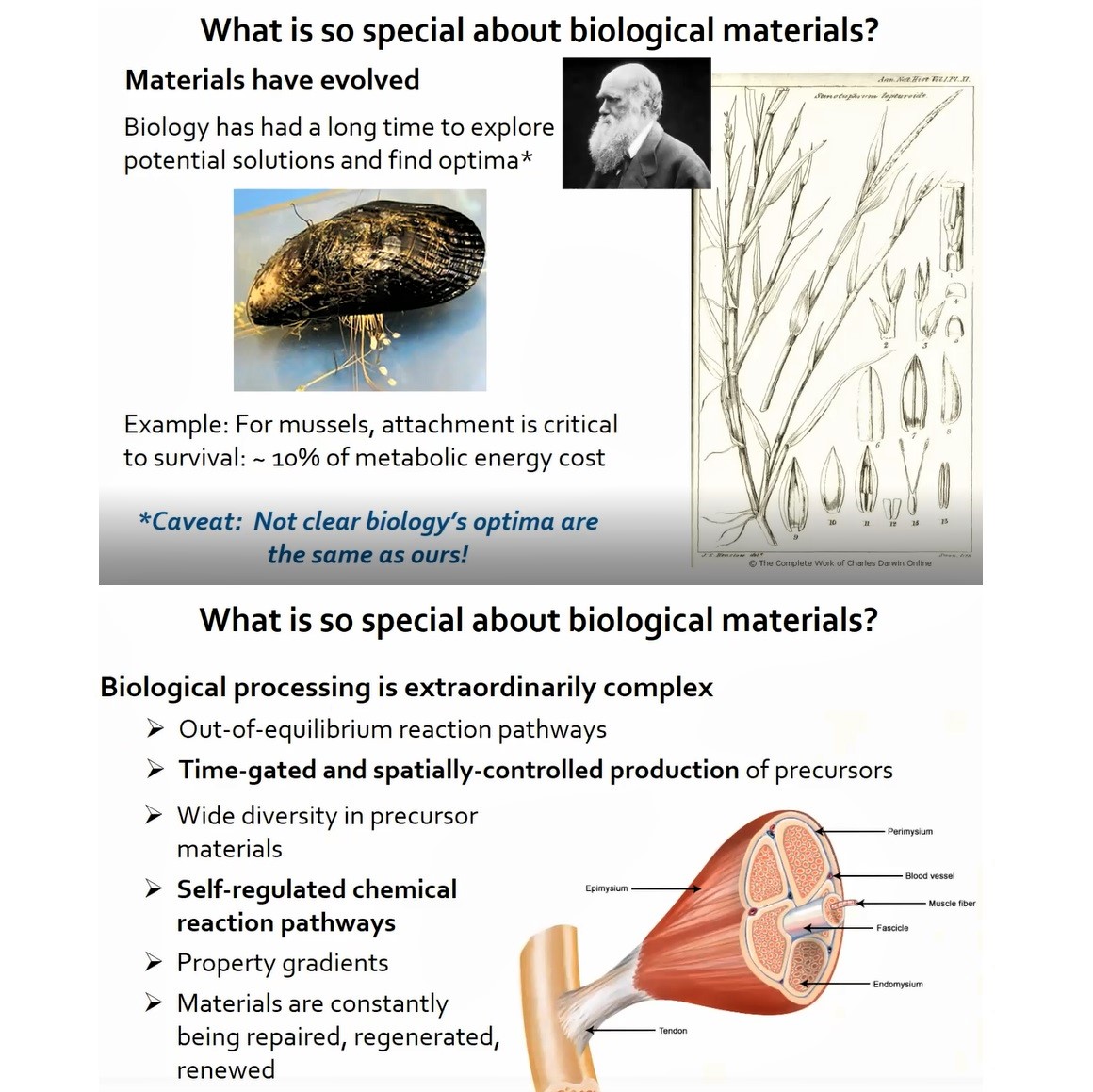
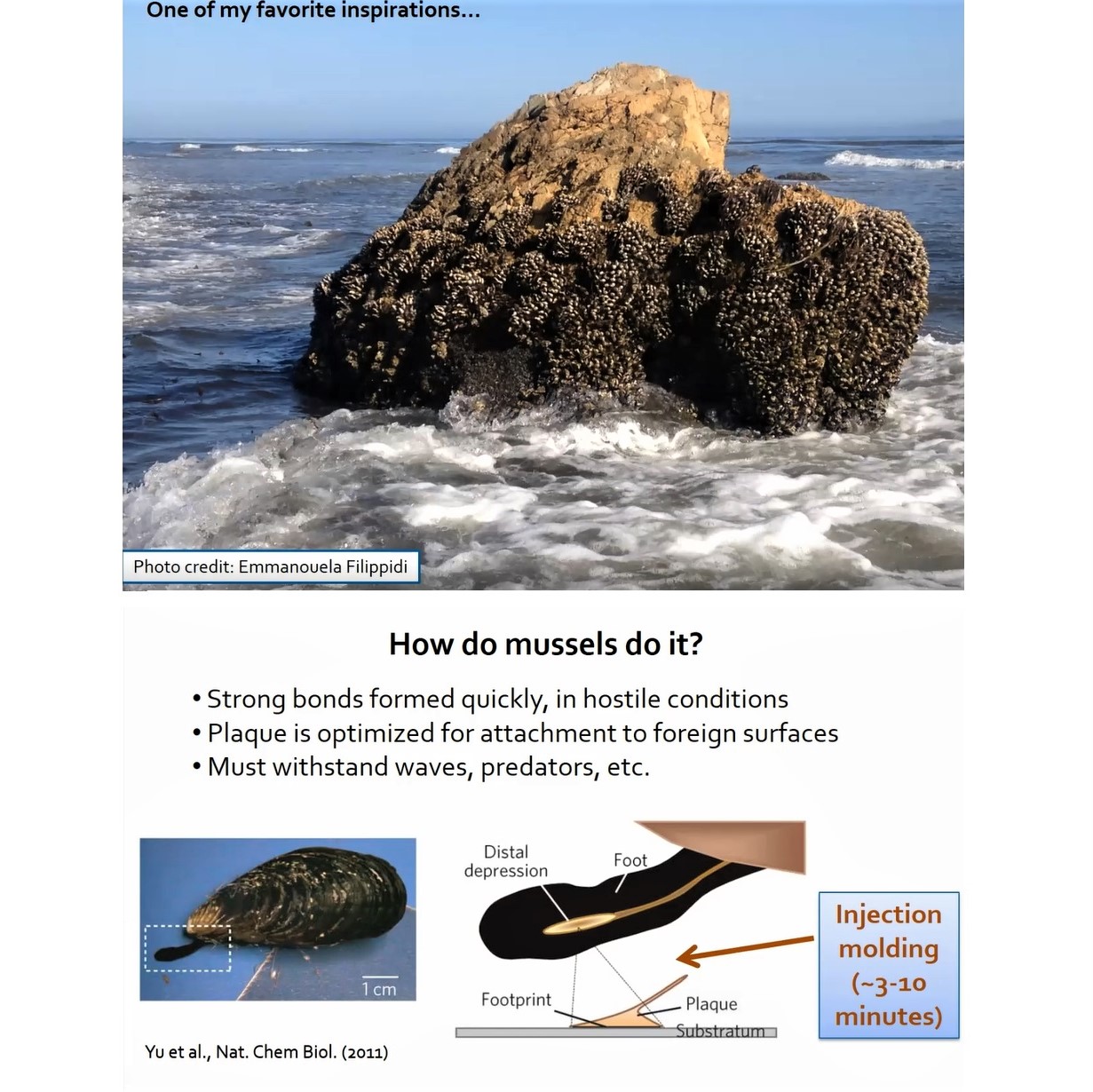
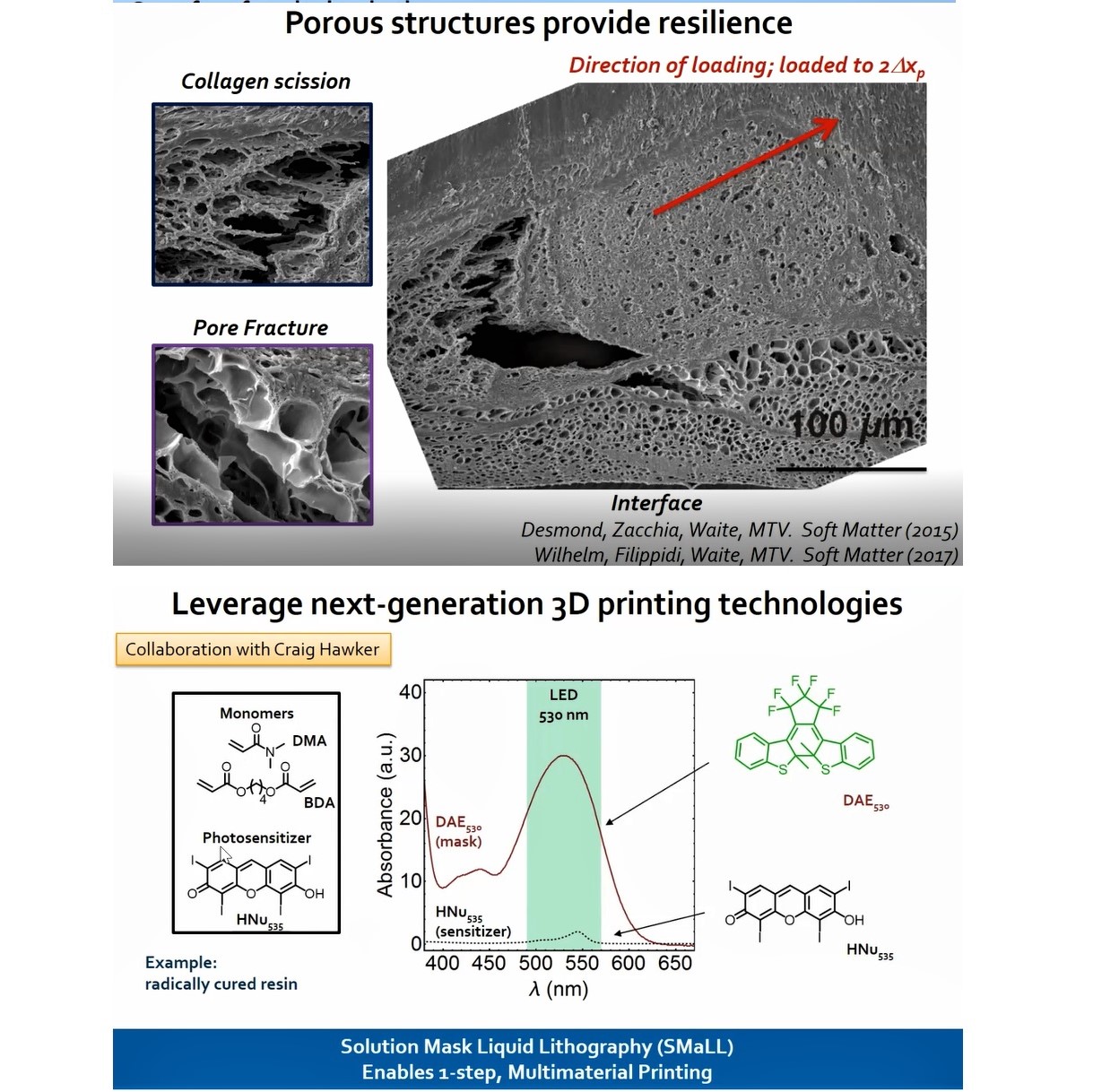
About the speaker: Dr. Megan T. Valentine is a Professor of Mechanical Engineering at the University of California, Santa Barbara. Her interdisciplinary research group investigates many aspects of biological and bioinspired materials, with an emphasis on understanding how forces are generated and transmitted in living materials, how these forces control cellular outcomes, and how the extraordinary features of living systems can be captured in man-made materials. This highly interdisciplinary experimental work lies at the intersection of engineering, physics, biology, and chemistry, and advances diverse application areas, ranging from marine-inspired materials to mechanobiology to soft robotics.
Dr. Valentine received her BS from Lehigh University ('97), MS from UPenn ('99) and PhD from Harvard ('03), all in Physics. She completed a postdoctoral fellowship at Stanford in the Department of Biological Sciences, where she was the recipient of a Damon Runyon Cancer Research Postdoctoral Fellowship, and a Burroughs Wellcome Career Award at the Scientific Interface. In 2008, she joined the faculty at the University of California, Santa Barbara, where she now serves as the Co-Director of the California NanoSystems Institute, and a co-leader of an IRG on Resilient Multiphase Soft Materials within the UC Santa Barbara Materials Research Laboratory, an NSF MRSEC. In 2013, she was awarded an NSF CAREER Award for her work on neuron mechanics, and in 2015 was awarded a Fulbright to study adhesion mechanics in Paris, France. She is a Fellow of the American Physical Society and American Institute for Medical and Biological Engineering.
November 2021 DVP Talk by Behrooz Parhami
Affiliation: Professor of Electrical & Computer Engineering, UCSB
Sponsor: IEEE Computer Society's Distinguished Visitors Program & IEEE Denver Section
Title: "Eight Key Ideas in Computer Architecture from Eight Decades of Innovation"
Date/Time: Thursday, November 11, 2021; 5:00 PM PST
Venue: WebEx; Register for free
Abstract: Computer architecture became an established discipline when the stored-program concept was incorporated into bare-bones computers of the 1940s. Since then, the field has seen multiple minor and major innovations in each decade. I will present my pick of the most important innovation in each of the eight decades, from the 1940s to the 2010s, and show how these ideas, when connected to each other and allowed to interact and cross-fertilize, produced the phenomenal growth of computer performance, now approaching exa-op/s (billion billion operations per second) level, as well as to ultra-low-energy and single-chip systems. I will also offer predictions for what to expect in the 2020s and beyond.
October 24-27, 2021, free IEEE-sponsored conference
Title: International Conference on Computer Design [Free registration]
Date/Time: Sunday, October 24, to Wednesday, October 27, 2021; Four days
October 2021 speaker: Dr. Tevfik Bultan
Affiliation: Professor & Chair, Computer Science Department, UCSB
Title: "Software, Logic, and Security"
Date/Time: Wednesday, October 20, 2021; 6:30-8:00 PM PDT
Venue: Zoom (link provided upon registration)
Links: Registration; Speaker's home page
Summary: What we tend to describe as "tech companies" are really computer companies and operate predominantly in the business of software. Currently, the world's top 5 companies in terms of market capitalization are computer companies, and all of them, except Apple, which does both hardware and software, are software-centered businesses. Software is increasing in complexity and is becoming more critical in everything we do, so ensuring its dependability is a major concern.
Software doesn't just drive the computer industry but many other R&D endeavors, such as NASA space missions, studying the human genome, and scientific discoveries in physics. Software engineering (SE), an area defined in 1968 to help find a solution to the "software crisis," continues to be front-and-center, as we deal with hackers, data leaks, and security breaches.
Dr. Bultan's research approaches the software dependability problem through three complementary approaches:
- Formal methods: Mathematical tools that support rigorous specs, design, development, & verification.
- Automation: Mechanization of SE tasks, such as bug/vulnerability detection, testing, & verification.
- Logic solvers: Automated tools that check satisfiability of logic formulas to automate SE tasks.
The connection between logic and computing goes back to the origins of the computing discipline. In recent years, automated logic solvers have become critical tools for detecting computer security vulnerabilities. By reducing the search for security vulnerabilities in computer systems to the search for satisfying solutions to logic formulas, automated logic solvers can be used as security-vulnerability detectors. As a concrete example, Dr. Bultan described the detection and elimination of access control vulnerabilities in cloud computing platforms using the computing-logic connection.
Speaker's bio: Dr. Tevfik Bultan is a Professor and the Chair of UCSB's Department of Computer Science, having previously served as departmental Vice Chair during 2005-2009. His research interests are in software verification, program analysis, software engineering, and computer security. He has authored more than 100 refereed research papers, participated on more than 50 technical program committees of international conferences & workshops, and served on multiple journal editorial boards. Dr. Bultan is a regular speaker at academic and professional venues, including as keynote speaker, and he has received numerous fellowships, best-paper awards, and other technical honors. Among his achievements are UCSB Academic Senate's Outstanding Graduate Mentor Award and recognition as an ACM Distinguished Scientist, both in 2016.
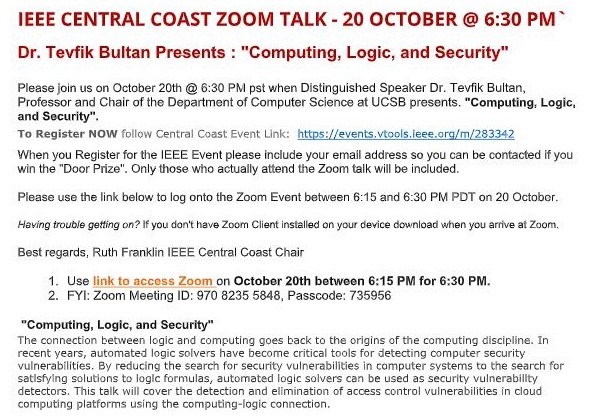
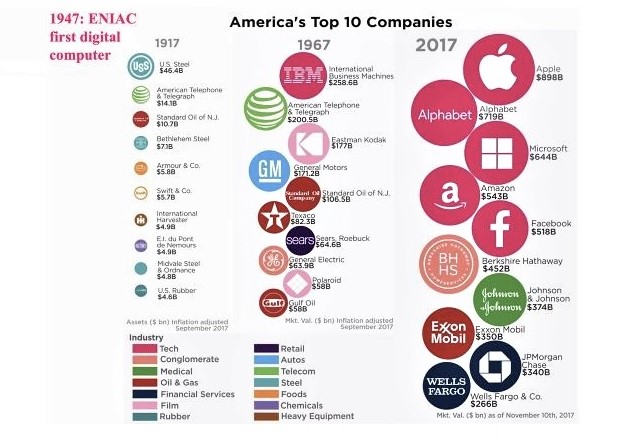
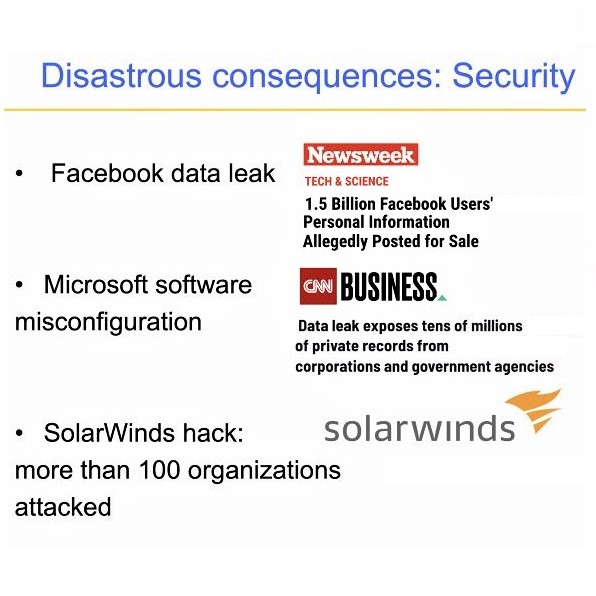
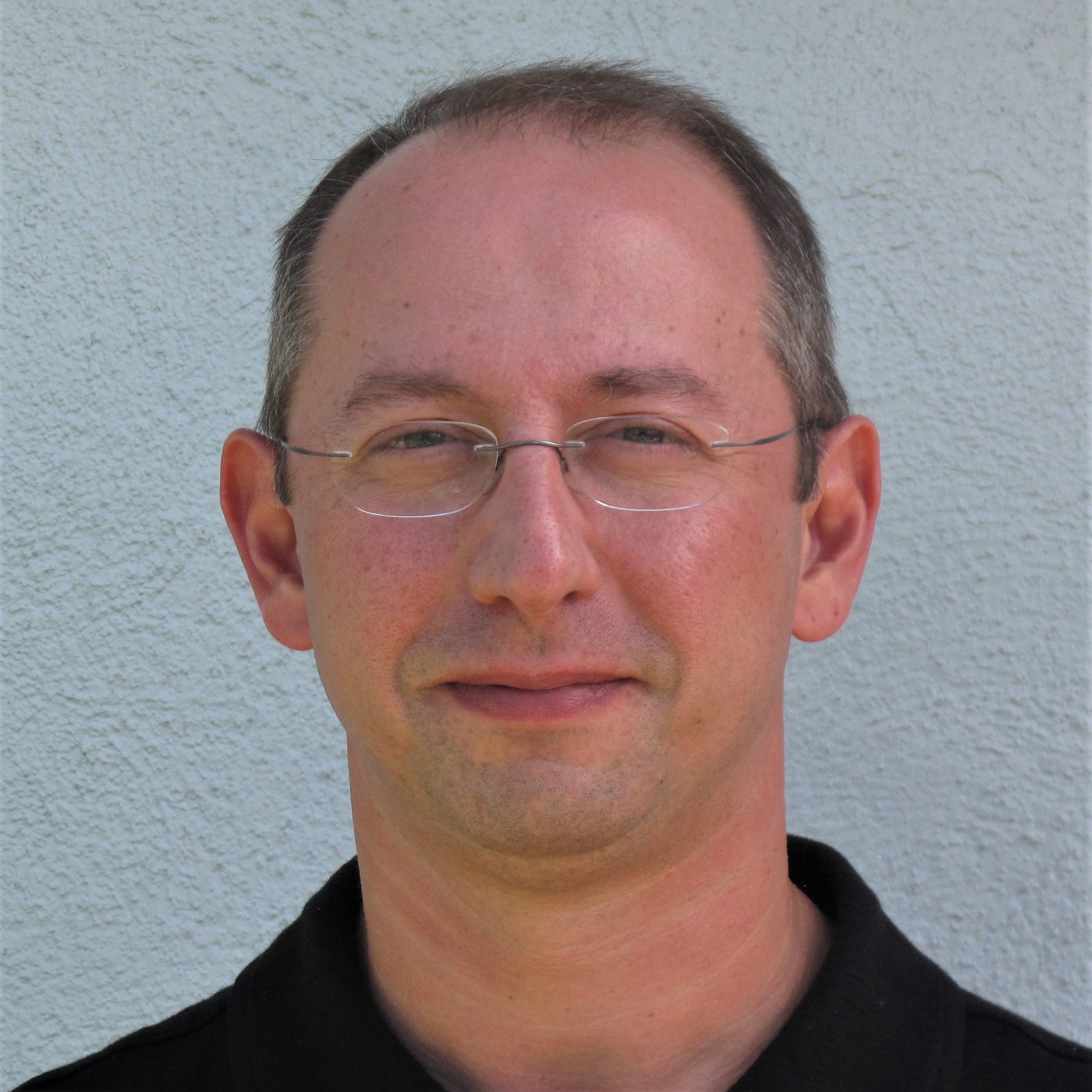
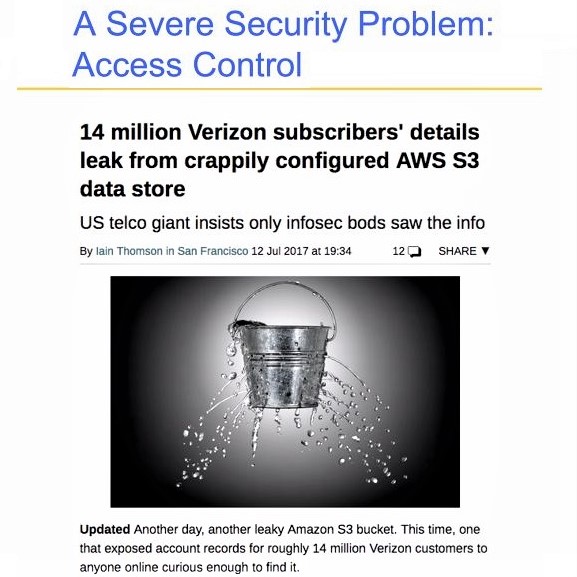
September 2021 DVP Talk by Behrooz Parhami
Affiliation: Professor of Electrical & Computer Engineering, UCSB
Sponsors: IEEE CS's Distinguished Visitors Program and IEEE Rock River Valley Section (Illinois)
Title: "Recursive Synthesis of Digital Circuits"
Date/Time: Thursday, September 30, 2021; 5:15 PM PDT
Venue: On-line
Abstract: Recursion is often associated with algorithm design and programming. In this talk, I will show that recursion can also be used for hardware synthesis, resulting in a number of benefits in design time, verification/validation, component reuse, and VLSI-friendly structure. In way of introduction, I will illustrate the method and its advantages using a well-known (FFT networks) and two lesser-known (multipliers; sorting networks) examples. I will then present a detailed description of my own research on the recursive synthesis of counting networks, which have several varieties known as parallel counters, weight-checkers, threshold and inverse-threshold circuits, and between-limits counters, to name a few examples.
September 2021 DVP Webinar by Behrooz Parhami
Affiliation: Professor of Electrical & Computer Engineering, UCSB
Sponsor: IEEE Computer Society's Distinguished Visitors Program
Title: "Eight Key Ideas in Computer Architecture from Eight Decades of Innovation"
Date/Time: Thursday, September 30, 2021; 8:00 AM PDT
Venue: On-line; Register for free
Abstract: Computer architecture became an established discipline when the stored-program concept was incorporated into bare-bones computers of the 1940s. Since then, the field has seen multiple minor and major innovations in each decade. I will present my pick of the most important innovation in each of the eight decades, from the 1940s to the 2010s, and show how these ideas, when connected to each other and allowed to interact and cross-fertilize, produced the phenomenal growth of computer performance, now approaching exa-op/s (billion billion operations per second) level, as well as to ultra-low-energy and single-chip systems. I will also offer predictions for what to expect in the 2020s and beyond.
September 2021 Talk by Dan Hart
Affiliation: President & CEO of Virgin Orbit
Sponsor: Institution of Engineering and Technology (IET)
Title: "The New Era of Space Architecture"
Date/Time: Saturday, September 18, 2021; 10:00 AM PDT
Venue: YouTube video (the talk starts at the 11:20 mark)
As part of the "IET at 150" global engineering talks series, Dan Hart, President & CEO of Virgin Orbit, spoke about the future of satellite launches, including the application of smartphone technology, minimizing environmental impacts, rapid development via additive manufacturing, and the possibility of space launches from airports.
We can now launch satellites from a Boeing 747 climbing to 35,000 feet (already 2/3 of the way to space), using much less energy and not needing a rocket launch base. This makes space technologies accessible to many countries who would not be able to do it with the current launch technology. Many 747s are becoming available now. They can be modified to serve as satellite launch vehicles, a technology that is transportable to anywhere in the world.
As we open up space for participation by diverse industrial and international collaborations, we must be mindful of the space environment, just as we are of Earth's environment. Challenges such as space debris require ingenious engineering solutions. The space economy will grow from the current $400 billion to over $1 trillion in a couple of decades. New technologies are lowering the barriers to entry into space projects. Two decades ago, launching a satellite would have required $500 million in funding; now, it's two orders of magnitude smaller.
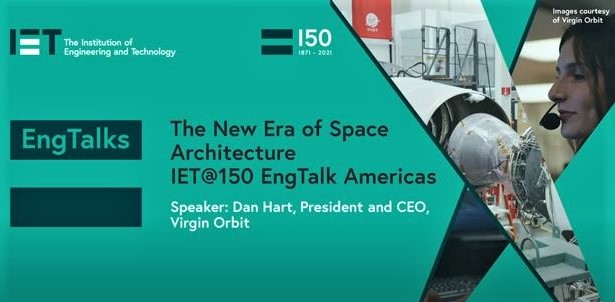
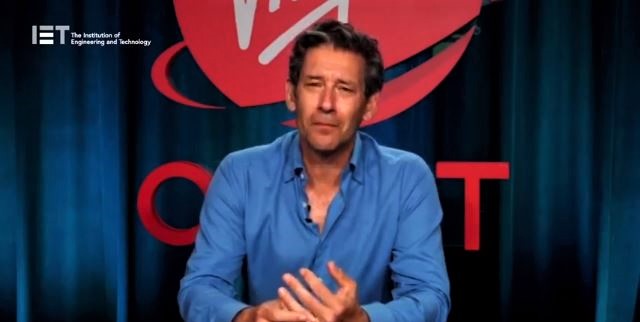
September 2021 speakers: Jared Call, Eve J. Pereira, Harvey Elliott
Affiliation: Jet Propulsion Laboratory (JPL)
Title: "Connecting with Mars: The Evolution of Relay Telecommunication Networks for Mars"
Date/Time: Wednesday, September 15, 2021; 6:30-8:00 PM PDT
Venue: Virtual (Zoom)
Links: IEEE CCS Event Page; IEEE CCS Technical Talks page
Tonight's Zoom talk, featuring three speakers from JPL discussing telecommunications challenges at and with Mars had 21 participants.
In the 1960s, we were excited about efforts to land humans on the Moon. Now, six decades later, we can't stop talking about going to Mars. On route to landing humans on Mars, many shorter-term milestones must be met, including returning soil samples from Mars. The goal of humans setting foot on Mars in a decade or two entails many challenges, not the least of which is devising an appropriate communications infrastructure, given that radio signals take ~600 times as long to reach Earth from Mars compared with from Moon (13 ± 7 minutes vs. 1.3 seconds).
The Mars Relay Network is a major component of NASA's ongoing exploration of Mars that has evolved organically over the years to meet the needs of the various operations scenarios. This talk introduced the benefits and challenges of telecommunications at Mars, touching upon many interrelated topics such as space exploration, triumph, adversity, clashing superpowers, human-made crater formation, 400-MHz radio waves, planning tools, network topologies, international cooperation, tragedy, commensal symbionts, multi-mission operations, communication protocols & CCSDS space standards, Beagles, space cats, balloons, and surface penetrators!
The three speakers covered various aspects of the challenges of communicating at and with Mars. Jared Call provided an overview of the Mars telecommunications problems, the history, various players & projects, technical roadblocks, and future plans. Eve Pereira discussed the enormous scheduling and coordination challenges, among different NASA teams and with international collaborators. Harvey Elliott focused on communications architectures, implementations, & protocols.
I will add a few more images from the speakers' slides when I get them.
Here are three of the questions from the Q&A period.
Q1: From your timeline, one gathers than humans will not land on Mars until at least 2030. Is this correct? (A: Yes)
Q2: Where/how are collected data stored for researchers to access/analyze? (A: A huge team handles databases & access to them)
Q3: Signal transmission delay from Mars is on the order of 5-20 minutes, compared with 1.3 s from the Moon. This is okay for imaging and other data collection applications. What about command & control? (A: Mars missions will rely extensively on automation, where decisions are made on the spot, rather than from the Earth)
Speakers' bios: Jared, Eve, and Harvey all work on Mars relay telecommunications at NASA JPL.
Jared Call has a degree in Applied Mathematics from Cal Poly Pomona and an Astronautics degree from University of Southern California and has been at JPL since 2002.
Eve J. Pereira started at JPL in 2001. She has a degree in Computer Science from Cal State LA and an Executive MBA from Claremont Graduate University.
Harvey Elliott has degrees in Planetary Science (focused on Mars) and Space Systems Engineering from University of Michigan. After a short stint at Planetary Resources in Seattle, he joined JPL in 2019 to work on relay operations for MAVEN Mars Orbiter and ExoMars Trace-Gas Orbiter (TGO).
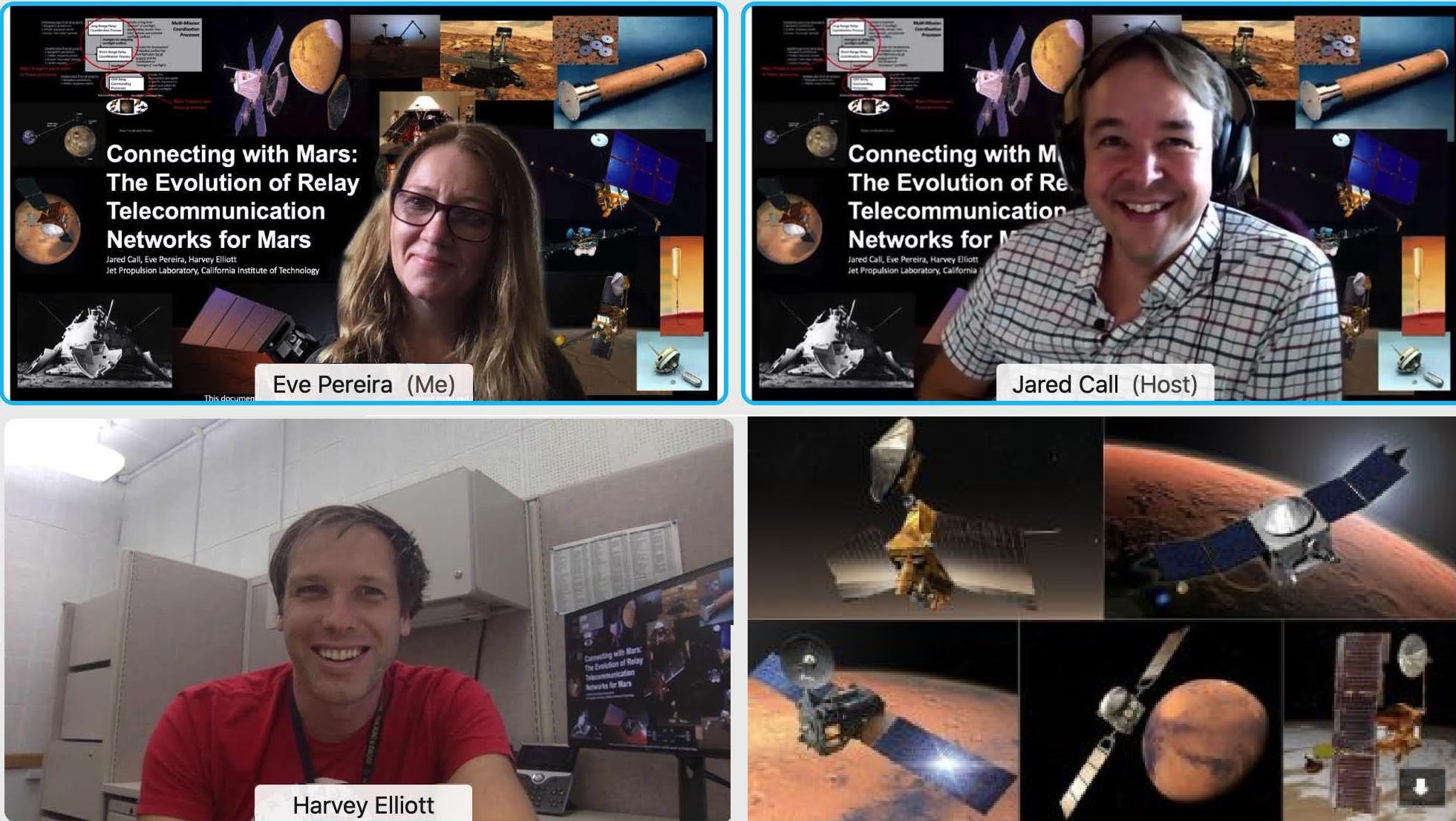
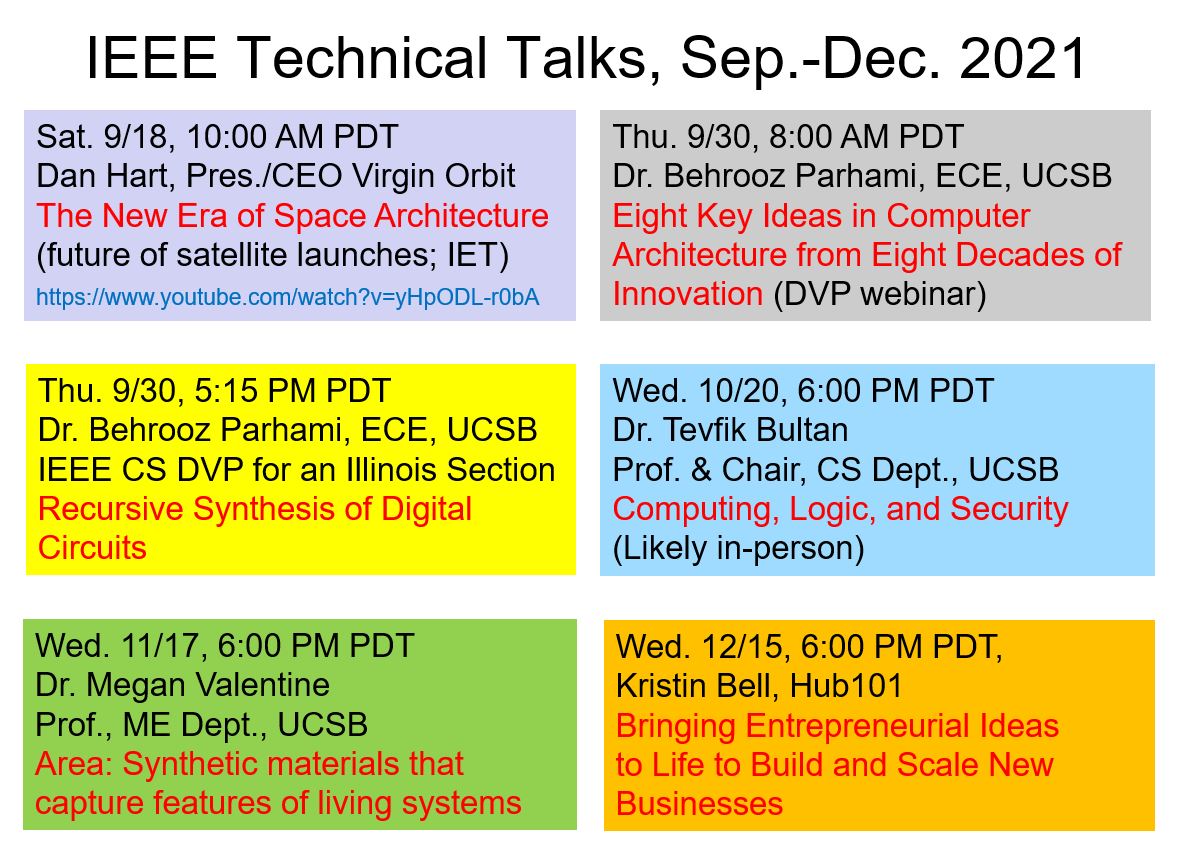
August 2021 speaker: Dr. Faramarz Davarian
Affiliation: Manager, Deep Space Network Technology, Jet Propulsion Laboratory (JPL)
Title: "Connecting with the Moon: Can We Provide Communications Connectivity for Human Presence on the Moon Similar to What We Have on Our Planet?"
Date/Time: Wednesday, August 18, 2021; 6:30-8:00 PM PDT
Venue: Virtual (Zoom); Registration/Event link
Although humans have already visited the Moon, brought Lunar samples back to Earth, and made many Earth-based and space-based observations of the Moon, there is much about the Moon that remains unexplored. Furthermore, the Moon provides opportunities that are unique and attractive. For example, the far side of the Moon is shielded from radio emissions generated by human activity, hence, it provides a great opportunity to observe the universe with radio telescopes free from man-made noise and Earth's atmosphere. Recent observations have indicated that there is water on the Moon, with the highest concentration at the poles, particularly the South Pole. The Moon is also rich in minerals and has a much lower gravity pull than the Earth. Therefore, the Moon has been suggested as a convenient station on the way to other destinations, such as Mars. Using the resources of the Moon, humans can develop rockets to take off in the low Lunar gravity rather than taking off from Earth.
Imagine a scenario where there are human colonies on the moon, and robots are performing tasks not suitable for humans. Moreover, the surface of the Moon is dotted with radio telescopes and other scientific instruments. Lunar dwellers, humans and robots, need to be connected to each other and to Earth. How do we provide connectivity for the above scenario? In this talk, we examine options for lunar communications and provide examples of networks that can provide connectivity for the Moon.
Topics discussed by Dr. Davarian with regard to communications requirements for lunar exploration included contacting the moon, relay satellites to allow indirect transmissions from/to Earth, challenges in selecting relay-satellite orbits (stable or "frozen" orbits), on-the-ground large antennas to receive signals from lunar relays, communication modes/delays/bandwidths, supporting an Internet-of-things on the Moon, and a the structure of a wire-mesh radio-telescope to be built by robots over a lunar crater.
Speaker's technical bio: Dr. Faramaz Davarian (Manager of Deep-Space Network Technology at NASA's Jet Propulsion Laboratory, JPL) specializes in planetary communications and tracking. Presently, he is focused on connectivity with the Moon to support robotic and human lunar exploration. In the past, he has contributed to the development of several enabling technologies, including modernization of NASA's Deep-Space Network, development of novel approaches for deep-space communications, and an antenna-array-radar concept for imaging of distant space objects.
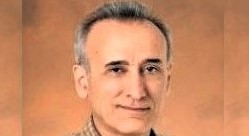
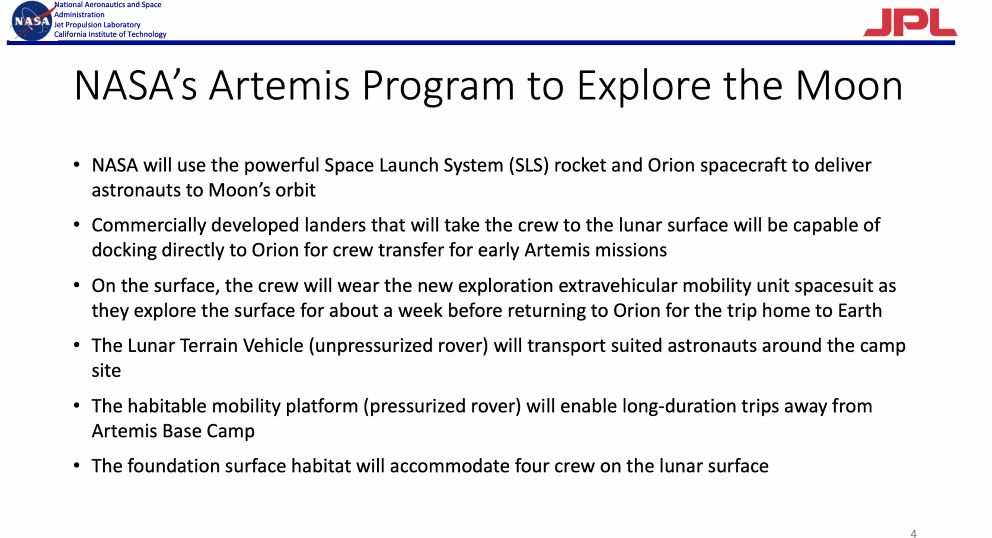
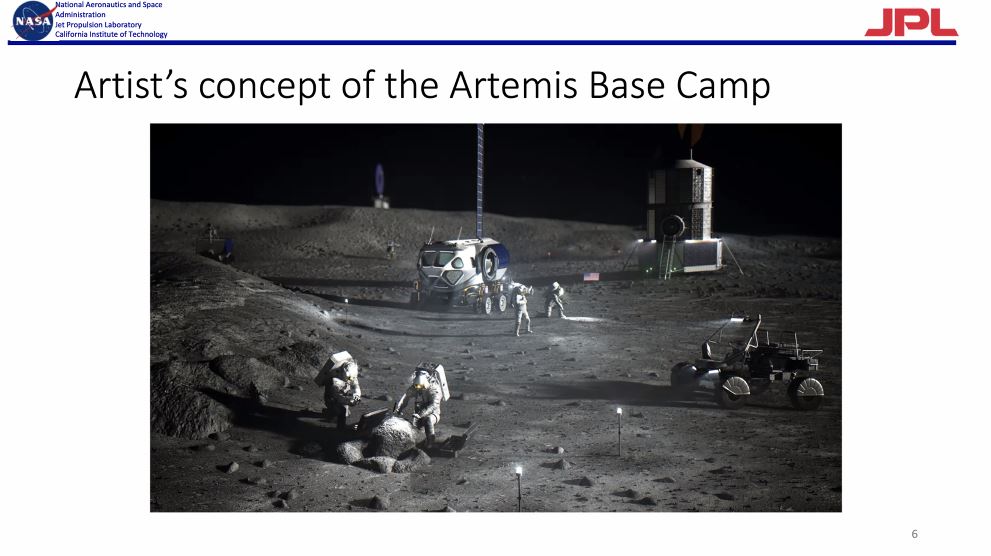
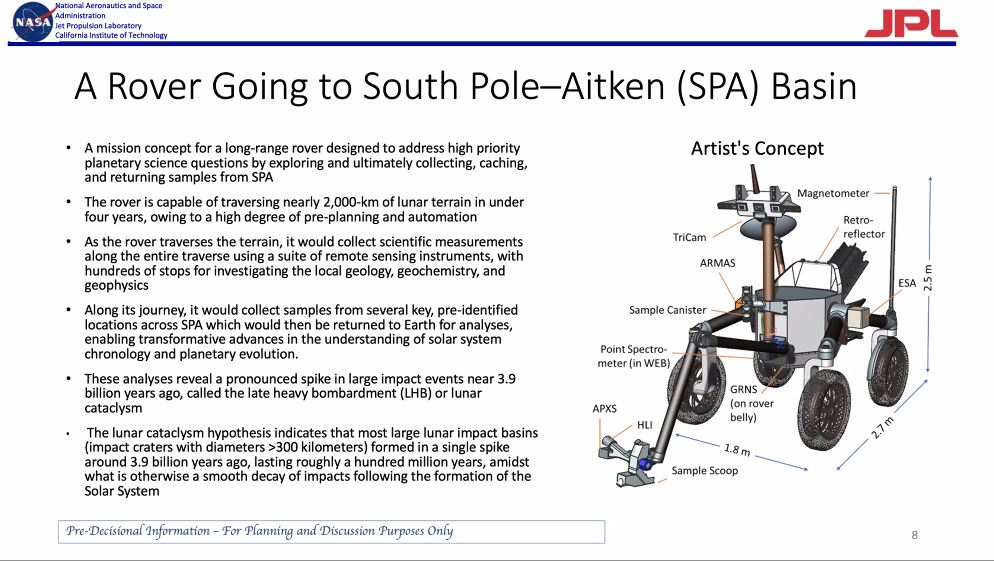
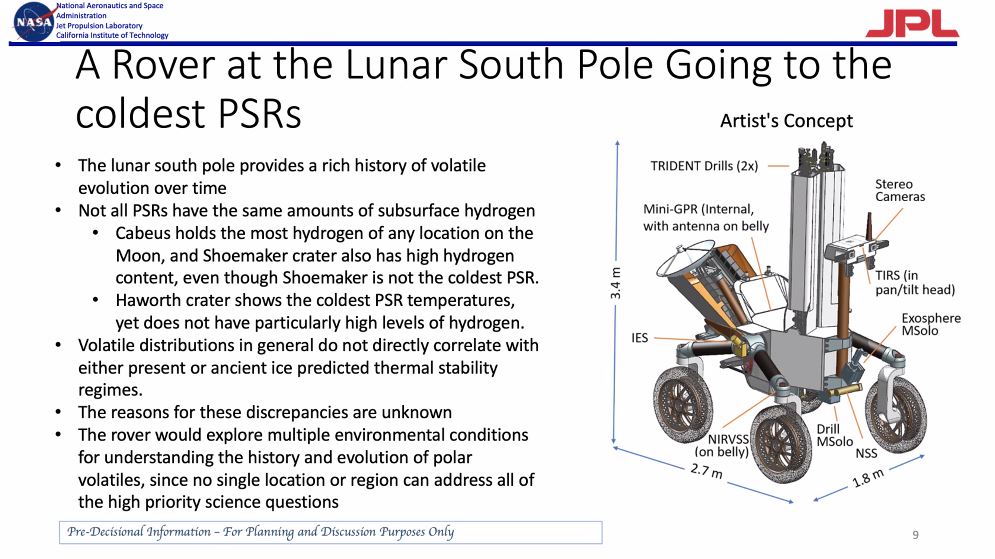
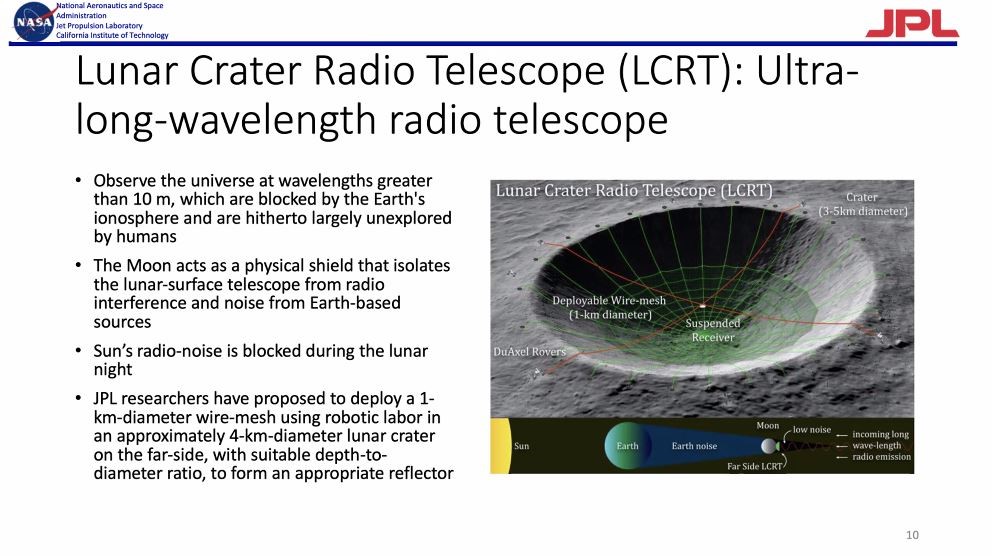
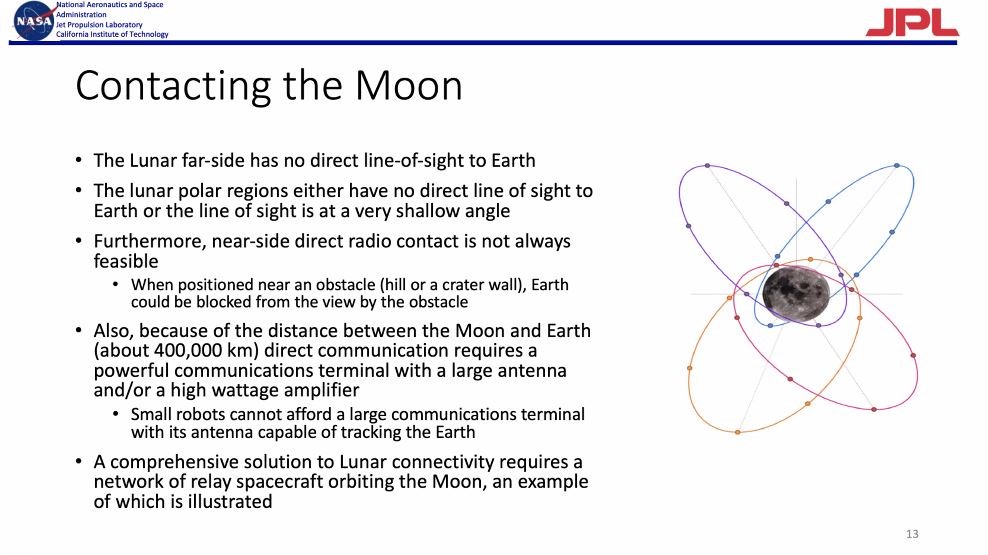
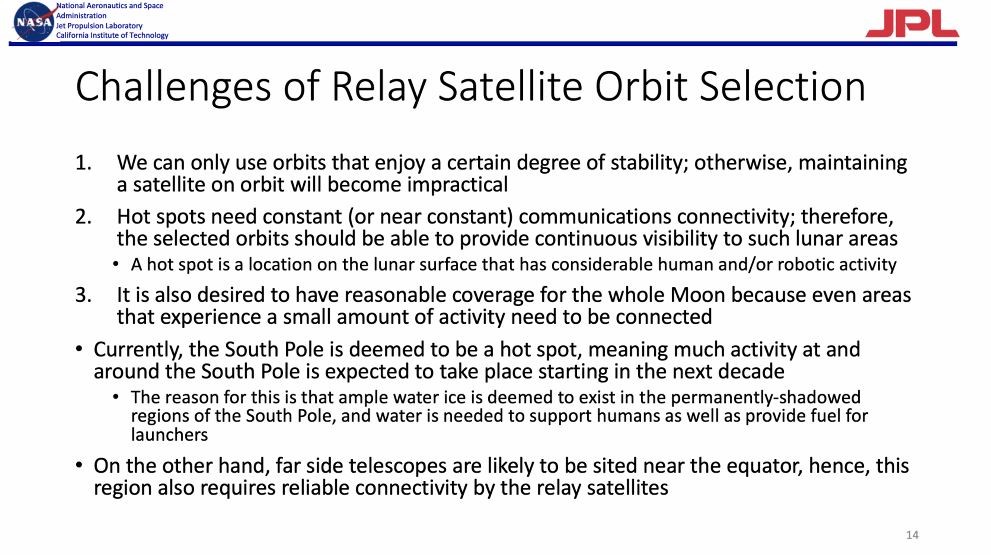
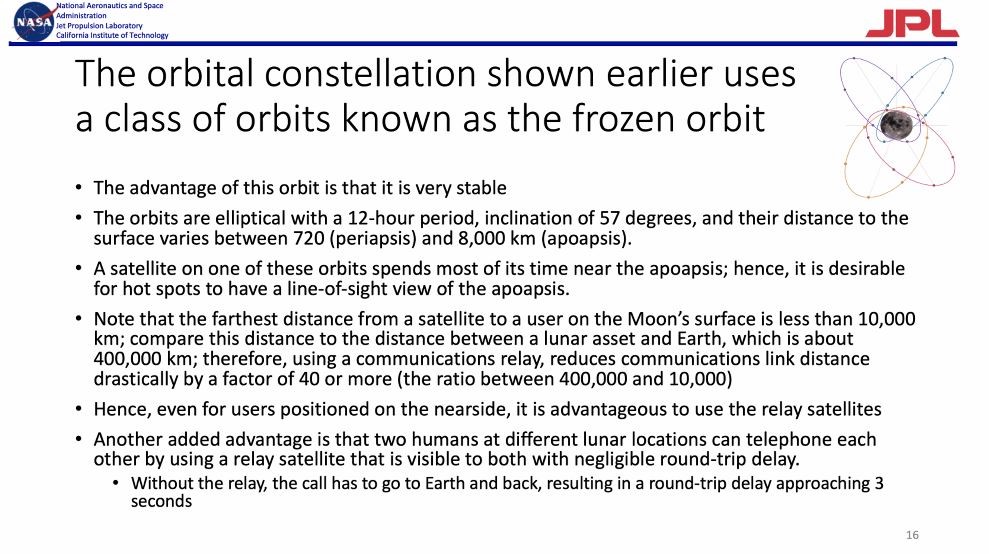
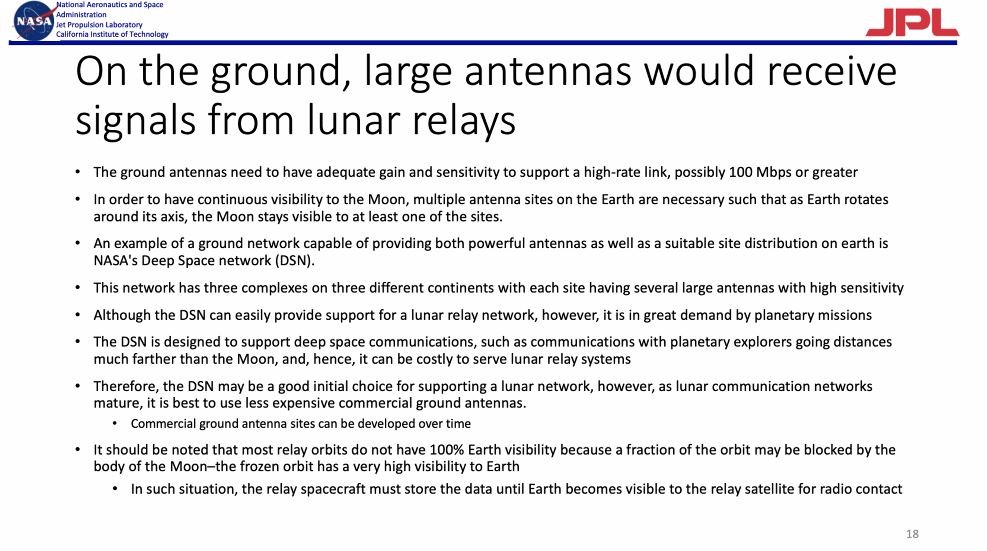
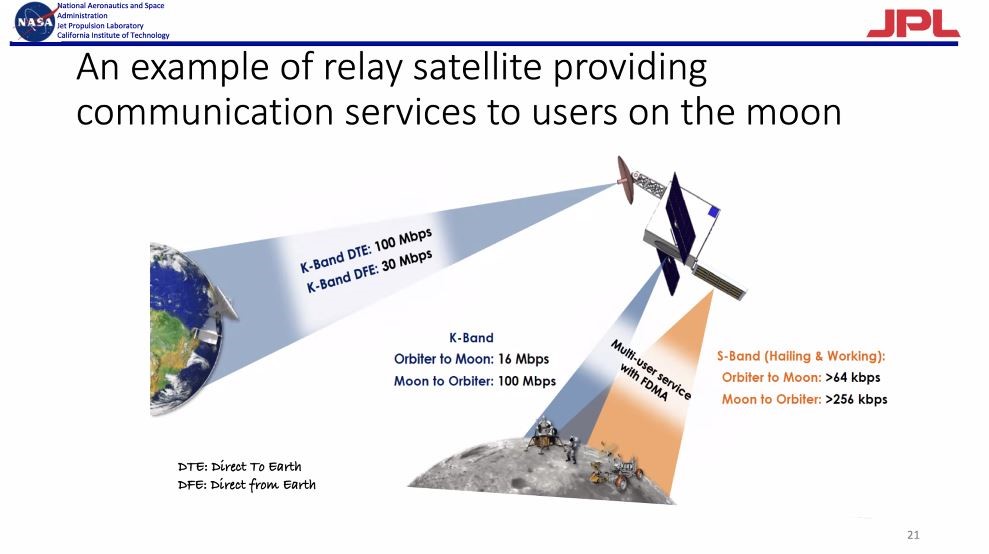
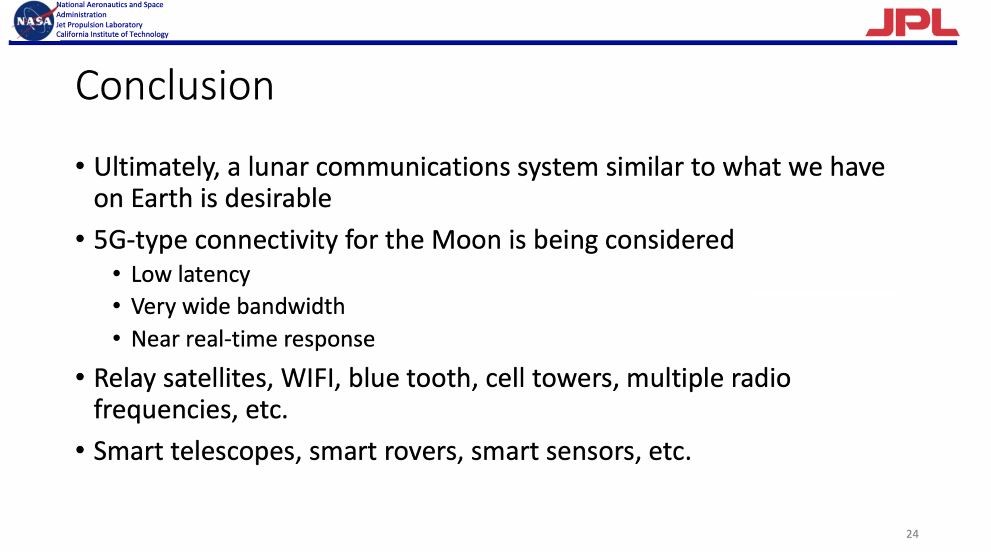
July 2021 speaker: Mr. Momin Quddus
Professional Engineer (PE); IEEE Senior Member
Title: "EV Technology and Its Implications on Climate Change"
Date/Time: Wednesday, July 21, 2021; 6:00-8:00 PM PDT
Venue: Virtual (WebEx); Registration link follows (Joinly sponsored with IEEE's BuenaVentura Section)
Links: Recorded lecture; IEEE BVS Event Page; IEEE BVS Web site; IEEE CCS Event Page
Tonight's talk was arranged by our sister BuenaVentura Section and co-sponsored by IEEE CCS. At its peak, the session had ~30 participants.
California will phase out gasoline-powered cars by 2035, joining 15 countries that have built a roadmap to boost technical innovation toward a zero-emission transportation and develop regulations to accelerate the transition from fossil fuel vehicles to electric vehicles (EVs). From a sustainable engineering perspective, an electric vehicle will emit less greenhouse gas at the car/truck level but the benefit on climate change involves a large array of additional factors.
In the first part of his talk, Mr. Quddus presented an overview of the EV technology, including types of battery and considerations of charging, range, and efficiency. He reviewed the power trains of the currently-used internal combustion engine (ICE) vs. existing and emerging EV options. Internal combustion engines are complicated and have many moving parts subject to inefficiencies, wear, and tear. The electric power train is much simpler and more efficient (Tesla claims an efficiency of 97%, vs. ICE's ~35%).
In the second part of his talk, Mr. Quddus discussed the future of EVs and their implication in slowing down global warming and climate change. EVs offer only marginal benefits if the electric energy they need is generated from coal and other fossil fuels. However, as we move toward greater use of renewable energy, the benefits of EVs will become more pronounced, constituting a main tool in our fight against climate change. He concluded by touching upon financial markets' interest in EVs.
Speaker's technical bio: Mr. Momin Quddus, a senior member of IEEE and a PE, currently chairs IEEE's BuenaVentura Section. He has worked in avionics, wireless communication, and aerospace industries for over 30 years. He holds a patent on wireless antenna design. Mr. Quddus earned a BSEE degree from University of Texas and an MSEE degree from Florida Atlantic University. He is interested in analyzing topics in terms of economics and analytics. He enjoys playing tennis, field hockey, and soccer. He coaches youth sports teams, volunteers at youth outreach events such as science fairs and academic decathlons, and serves on advisory boards of STEAM programs.
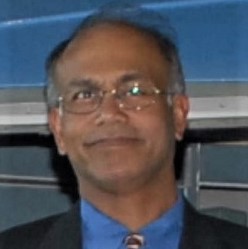
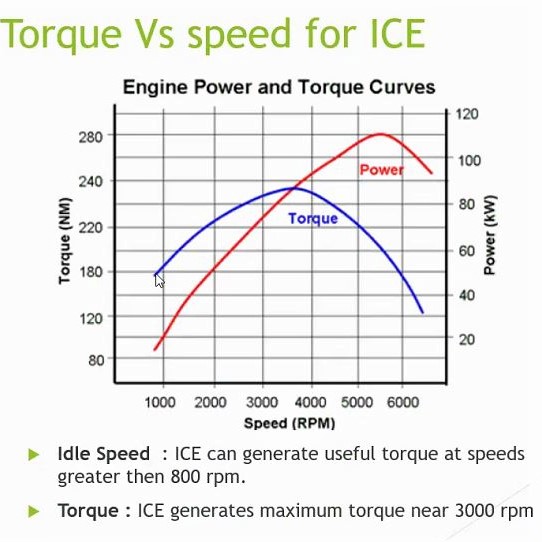
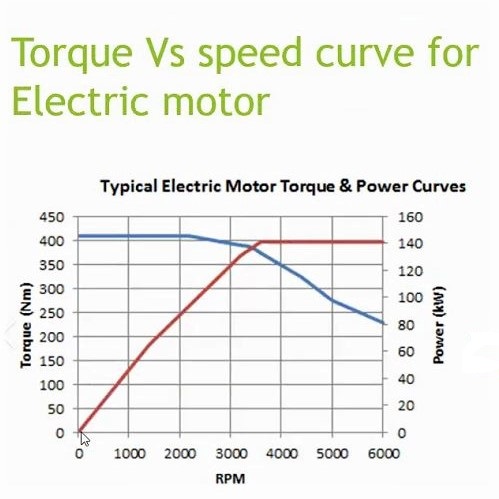
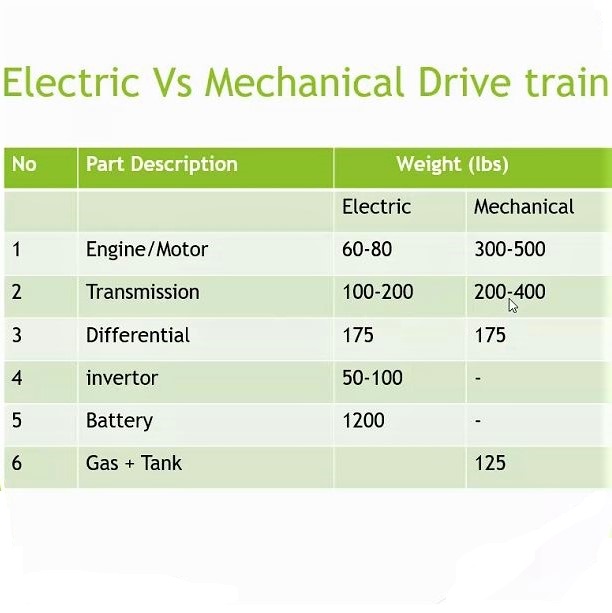
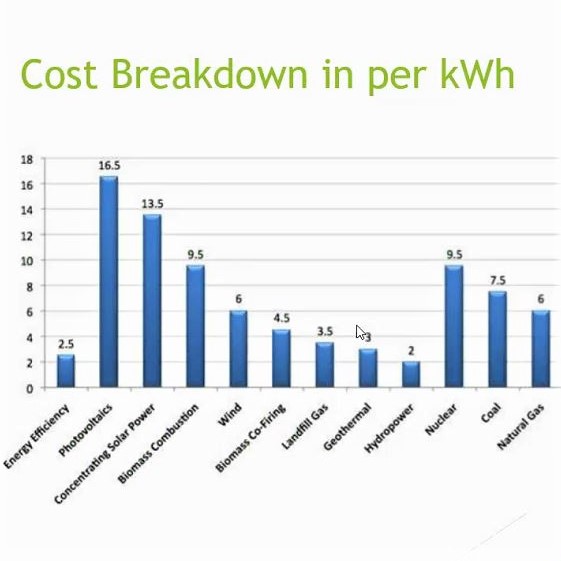
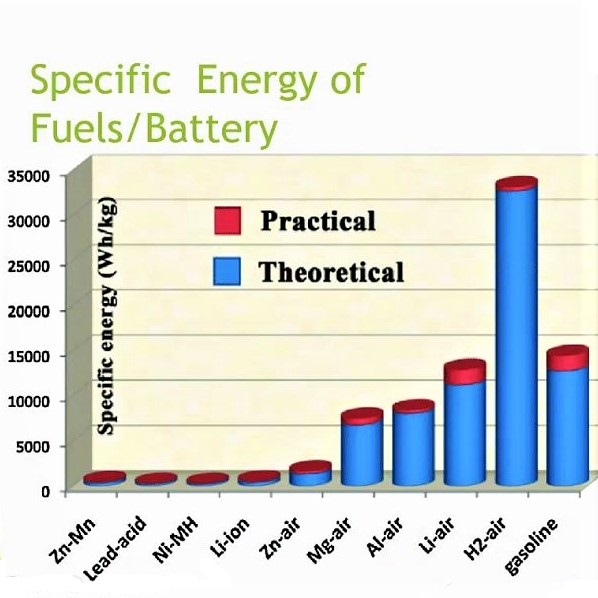
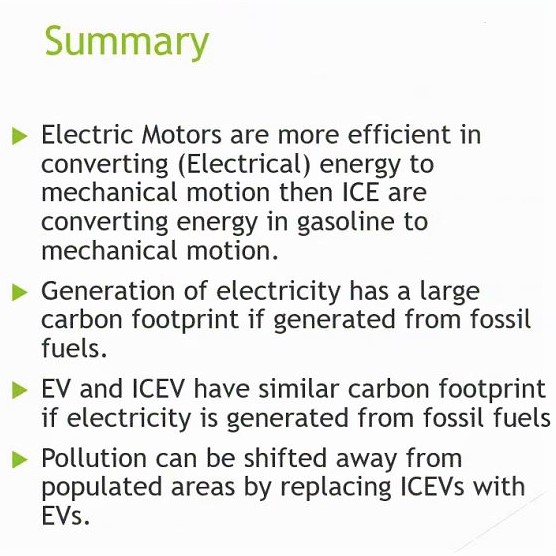
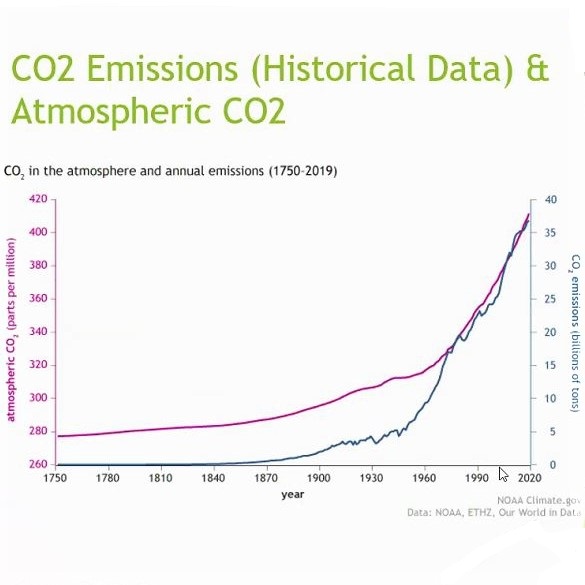
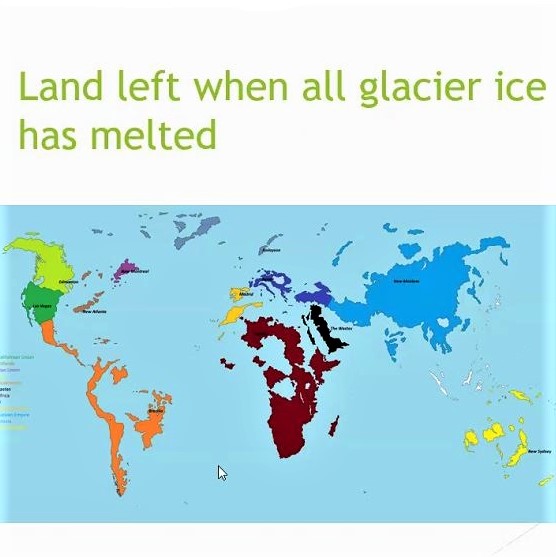
June 2021 speaker: Mr. Momin Quddus
Professional Engineer (PE); IEEE Senior Member
Title: "Bitcoin, Blockchain & Cryptocurrency, in Simple Terms"
Date/Time: Wednesday, June 16, 2021; 6:30-8:00 PM PDT
Venue: Virtual (Zoom); Please register at the event page below
Links: IEEE CCS Event Page; IEEE BuenaVentura Section Web site
Mr. Momin Quddus (MSEE, PE) talked under the title "Bitcoin, Blockchain, Cryptocurrency, in Simple Terms," a talk he generously agreed to repeat for our section, having previously offered it to our sister BuenaVentura Section. We are bombarded daily with information about bitcoin, a special kind of cryptocurrency, and blockchain, hyped as a cure-all for everything that ails our society. So, it is particularly timely to become acquainted with these notions and be able to separate hype from facts.
Public opinion on cryptocurrency is divided. A small group of people with a deep understanding of the topic believe in this form of currency and are passionate about what it represents. Then there's the rest of us, who feel that it is a cryptic topic, true to the name (the skeptics and the curious). Mr. Quddus attempted to bridge the gap between these communities. He explained the origins of cryptocurrency and what it means to society in general in the near future. He also briefly discussed cryptocurrency investment opportunities of various kinds.
Even though businesses and even governments are getting involved with cryptocurrency, in the end, such currencies are not intended to replace normal world currencies such as dollar or euro. Ironically, cryptocurrency provides both transparency (in the sense that everyone can see the transactions and nothing is hidden from anyone) and anonymity (currency is tied to digital wallets, rather than personal identities). Digital wallets can be transferred between individuals, such as at the time of the owner's death. There have been instances when someone has lost a digital wallet, thus losing the assets in it. However, anonymity seems to be going away, as evidenced by the US government tracing ransomware payments and recovering the money paid.
Speaker's bio: Mr. Momin Quddus, a senior member of IEEE and a PE, currently chairs IEEE's BuenaVentura Section. He has worked in avionics, wireless communication, and aerospace industries for 30+ years, and he holds a wireless-antenna patent. Mr. Quddus earned a BSEE degree from U. Texas and an MSEE degree from Florida Atlantic U. He is interested in analyzing topics in terms of economics & analytics. He enjoys playing tennis, field hockey, and soccer. He coaches youth sports teams, volunteers at youth outreach events such as science fairs and academic decathlons, and serves on advisory boards of STEAM programs.
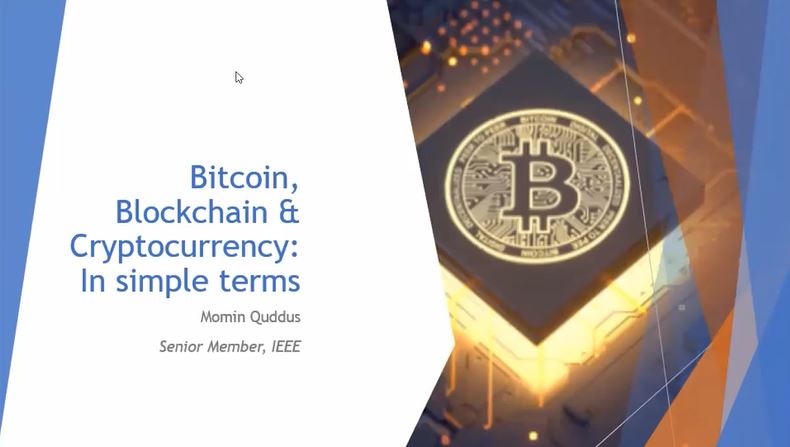
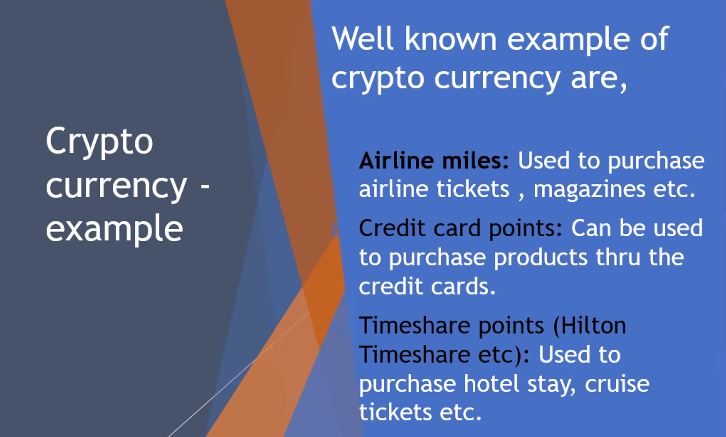
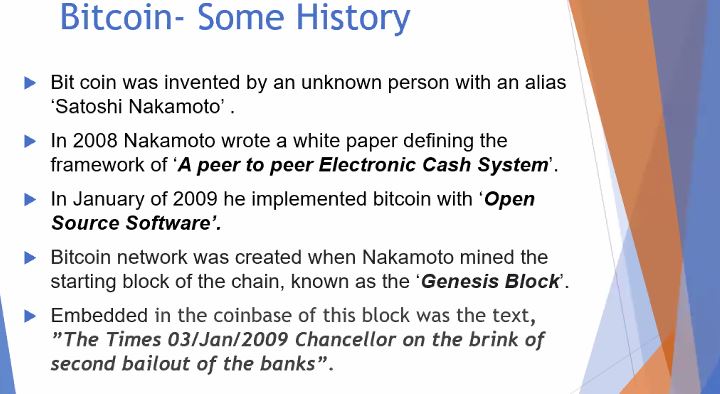
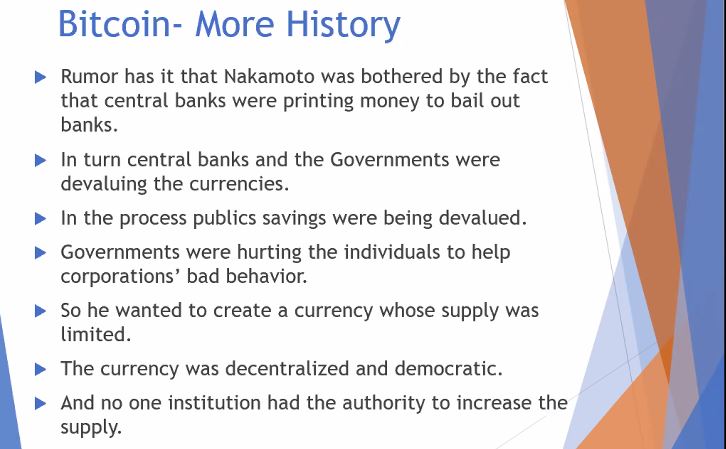
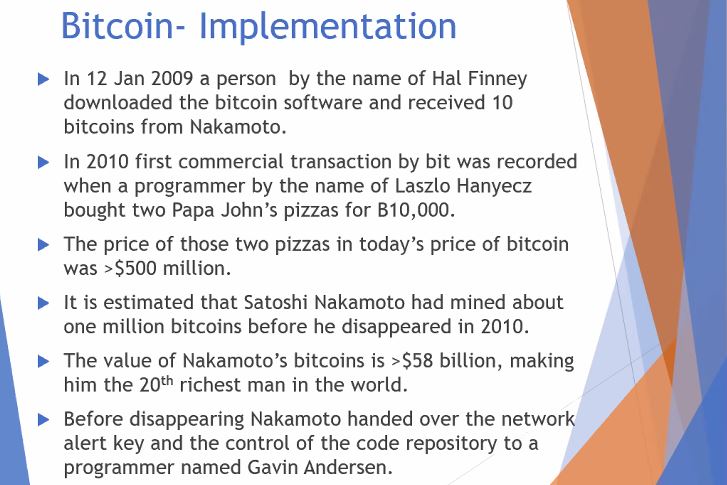
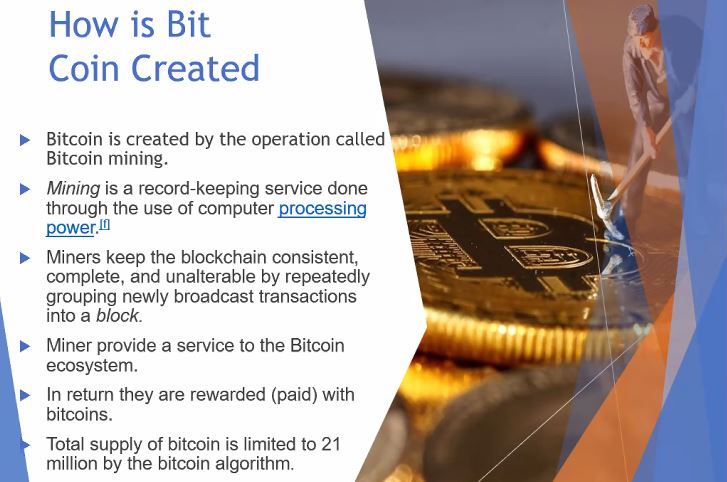
May 2021 speaker: Dr. Farinaz Koushanfar
Electrical and Computer Engineering Department, UCSD
Title: "Machine Learning on Encrypted Data: Hardware to the Rescue"
Date/Time: Wednesday, May 19, 2021; 5:30-7:00 PM PDT
Venue: Virtual (Zoom)
Links: IEEE CCS Event Page; Speaker's Home Page
Dr. Farinaz Koushanfar (Professor of ECE and Henry Booker Faculty Scholar, UCSD) spoke at 5:30 this evening under the title "Machine Learning on Encrypted Data: Hardware to the Rescue." Dr. Koushanfar's research addresses several aspects of efficient computing and embedded systems, with a focus on system and device security, safe AI, privacy-preserving computing, as well as real-time/energy-efficient AI under resource constraints, design automation, and reconfigurable computing. Professor Koushanfar has been widely honored for her research, mentorship, teaching, and outreach activities.
Machine Learning on encrypted data is a yet-to-be-addressed challenge. Important recent advances across different layers of the system, from cryptography and mathematics to logic synthesis and hardware, are paving the way for practical realization of privacy-preserving computing for certain target applications. As a simple example, consider that Alice and Bob have private values x and y. A question of interest is whether we can compute f(x, y), for example, deciding whether x > y, without revealing y to Alice or x to Bob, even though they both learn the computed value of f(x, y).
Dr. Koushanfar's talk highlighted the crucial role of hardware and innovations in computing architecture in supporting recent advances in the field. Dr. Koushanfar outlined the main technologies and mixed computing models, centering her talk on the recent progress in synthesis of "garbled circuits" that provide a leap in scalable realization of machine learning on encrypted data. She also explored how hardware could pave the way for navigating the complex space of privacy-preserving computing, thus enabling scalable mixed-protocol solutions. She concluded with a brief discussion of the challenges and opportunities ahead.
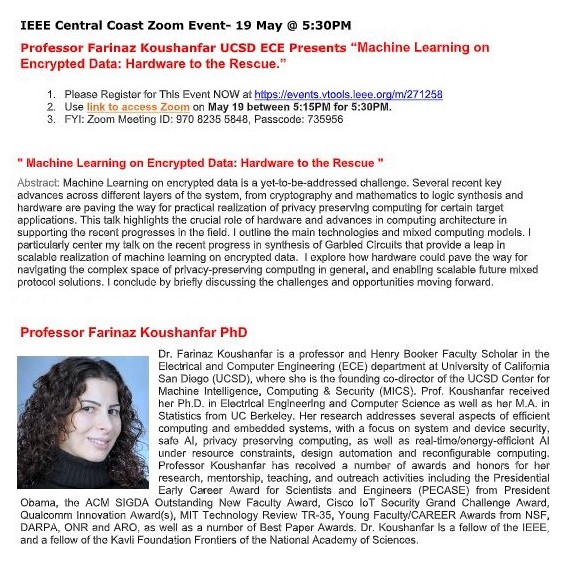
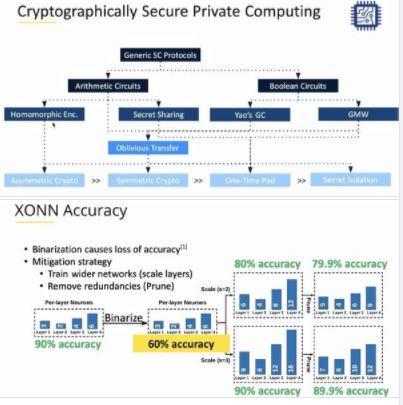
Special May 2021 talk by Mr. Momin Quddus
Hosted by IEEE BuenaVentura Section
Title: "Bitcoin, Blockchain & Cryptocurrency, in Simple Terms"
Date/Time: Tuesday, May 04, 2021; 6:30 PM PDT
Venue: Virtual (WebEx Event Number: 130 975 5575; Password: Entrepreneurship)
This talk will be repeated on June 16, 2021, for IEEE's Central Coast Section
Links: WebEx participation link; Event flyer; IEEE BuenaVentura Section Web site
Special May 2021 talk by Dr. Li-C. Wang
Affiliation: Electrical and Computer Engineering Department, UCSB
Hosted by: IEEE UCSB Student Branch
Title: "Machine Learning in Test Data Analytics"
Date/Time: Monday, May 03, 2021; 6:30-8:00 PM PDT
Venue: Virtual (Zoom); Link below
Links: Join Zoom Meeting; IEEE Event Page; Speaker's Home Page
April 2021 speaker: Dr. Ramtin Pedarsani
Affiliation: ECE Department, UCSB
Title: "Efficient Transportation in the Face of a Pandemic"
Date/Time: Wednesday, April 21, 2021; 6:30-8:00 PM PDT [postponed from 2020/05/20]
Venue: Virtual (Zoom)
Links: IEEE CCS Event Page; Speaker's Home Page
Dr. Ramtin Pedarsani (Assistant Professor of ECE, UCSB) spoke under the title "Efficient Transportation in the Face of a Pandemic." Dr. Pedarsani has research interests in machine learning, optimization, coding & information theory, applied probability, and intelligent transportation systems. Before joining UCSB in 2016, he was a postdoctoral scholar in the EECS Department at UC Berkeley, where he obtained his PhD in 2015. He received his MSc degree from EPFL in 2011 and his BSc degree from University of Tehran in 2009. He is the recipient of the Communications Society and Information Theory Society Joint Paper Award in 2020, the best paper award in from IEEE International Conference on Communications in 2014, and the NSF CISE Research Initiation Initiative award in 2017.
COVID-19 has led to many deaths, short- & long-term health challenges, economic disruption, and a host of other social ills. That's the half-empty-glass part of the picture. The half-full-glass part is that it has also challenged researchers and healthcare professionals to come up with ways of managing pandemics and their various impacts. Just at UCSB, many research programs have been initiated to help mitigate the impact of COVID-19 and to prepare for and tackle possible future pandemics. Tonight, Dr. Pedarsani focused on some challenges arising from people becoming more hesitant to use public transport post-COVID.
Dr. Pedarsani began by noting that while many countries are in a reopening stage, some effects of the pandemic on people's behavior are expected to last much longer, including in the choice between different modes of transportation. Experts predict delayed recovery of public transport options, as many try to avoid crowded places. In turn, significant increases in traffic congestion are expected, due to preference for private cars or taxis over riskier and more crowded options such as the railway. In his work, Dr. Pedarsani has proposed to use financial incentives to set the trade-off between risk of infection and congestion to achieve safe and efficient transportation networks. To render this framework useful in various cities and times of the day without much designer effort, the model also includes a data-driven approach to learning human preferences about transport options.
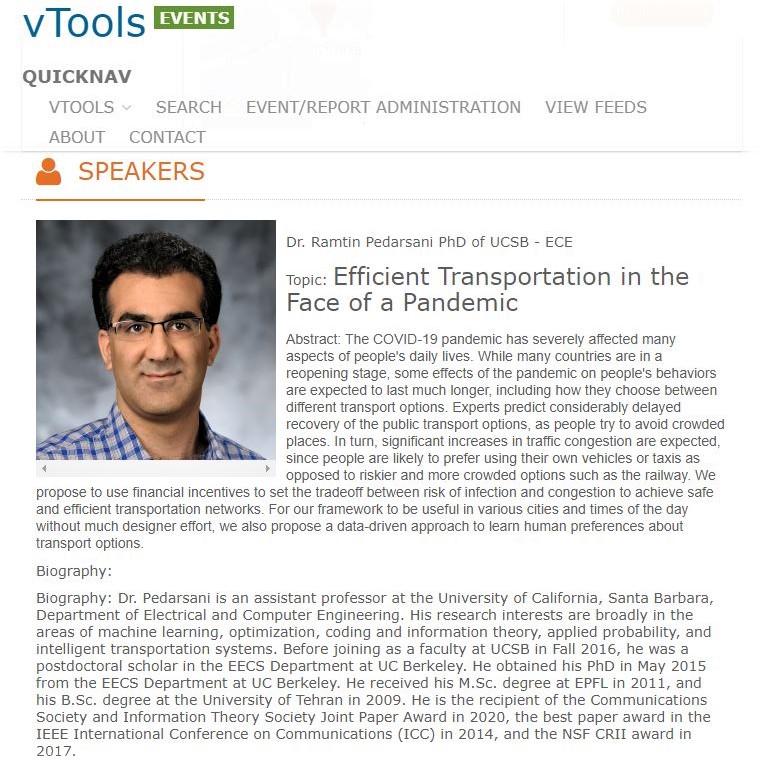
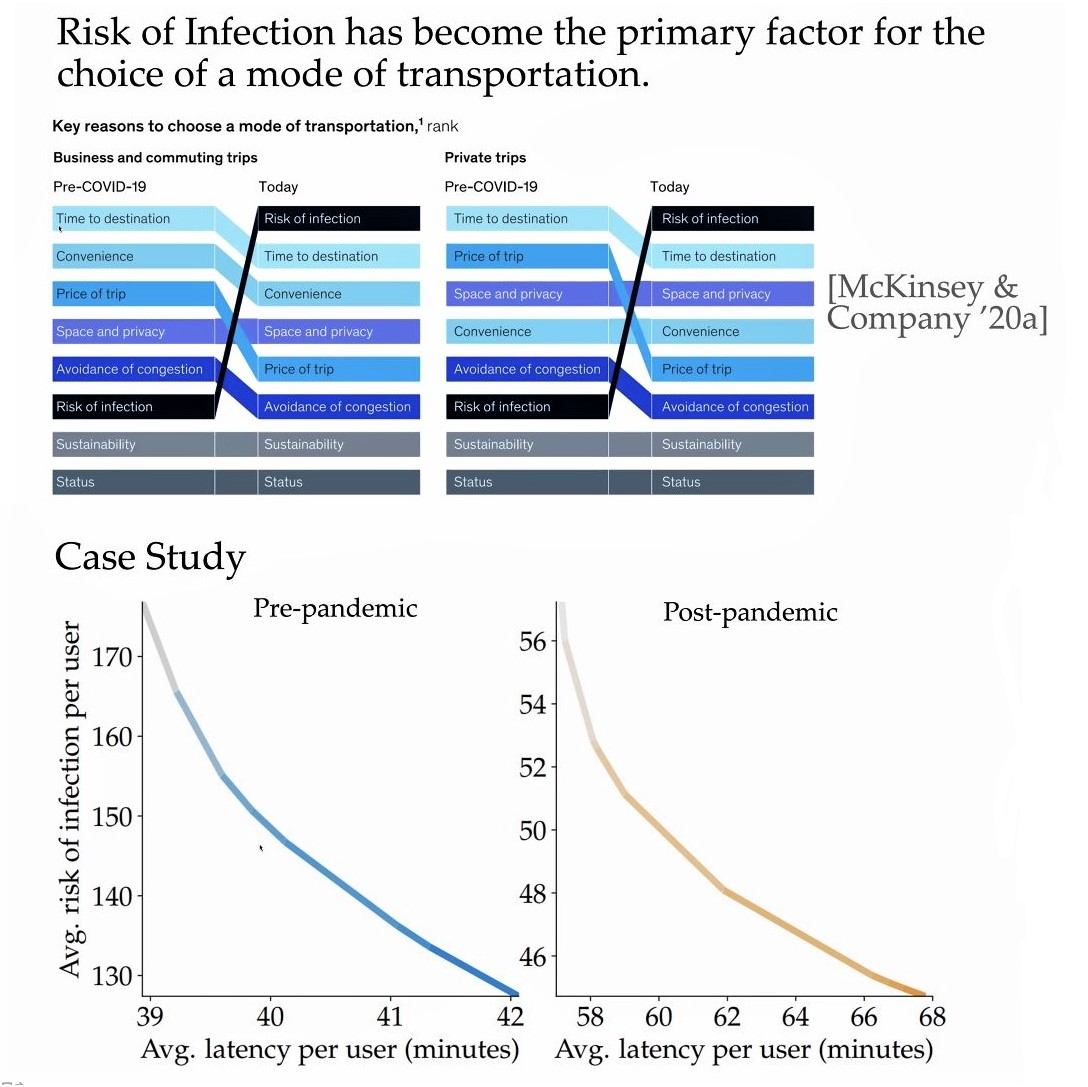
March 2021 speaker: Dr. Behrooz Parhami
Affiliation: ECE Department, UCSB (IEEE Computer Society Distinguished Visitor, 2021-2023)
Title: "Eight Key Ideas in Computer Architecture from Eight Decades of Innovation"
Date/Time: Wednesday, March 17, 2021; 6:30-8:00 PM PST
Venue: Over Zoom
Links: IEEE CCS Event Page; Speaker's home page; Speaker's slides
We all like to read top-10 lists of universities, cities to live in, travel destinations, historical figures, movies (all-time, or of a particular decade), songs, novels, and so on. On occasion, we disagree with the picks or feel satisfaction that the list-compiler agrees with us on some of the items. When we try to make such lists on our own, the difficulty becomes apparent. This talk is an academic version of such list-making tendencies. Dr. Parhami began his efforts with computer architecture, but he plans to compile similar lists for his other areas of research/technical expertise.
Computer architecture became an established discipline when the stored-program concept was incorporated into bare-bones computers of the 1940s. Since then, the field has seen multiple minor and major innovations in each decade. Dr. Parhami presented his pick of the most-important innovation in each of the eight decades, from the 1940s to the 2010s, and showed how these ideas, when connected to each other and allowed to interact and cross-fertilize, produced the phenomenal growth of computer performance, now approaching exa-op/s (billion billion operations per second) level, as well as to ultra-low-energy and single-chip systems.
1940s: Stored-program converted calculating machines into powerful computational and inference engines.
1950s: Microprogramming systematized hardware design and showed that HW and SW aren't that different.
1960s: Parallelism allowed the upward scaling of computational capabilities, with no theoretical upper bound.
1970s: Cache memory allowed the realization of large, low-cost, and ultra-high-speed computer memories.
1980s: Pipelining allowed the attainment of high throughput with modest amounts of time-shared circuitry.
1990s: FPGAs offered the advantages of low cost due to mass production for building limited-volume systems.
2000s: GPUS, a first step in specialization, devoted hardware mostly to computation, not to control overhead.
2010s: Specialization reduced control and programmability overheads in frequently-used computations.
Dr. Parhami ended his talk by discussing some of the ideas that are being developed for the 2020s and beyond. Come back in 2040, when the list will turn into a top-10 list!
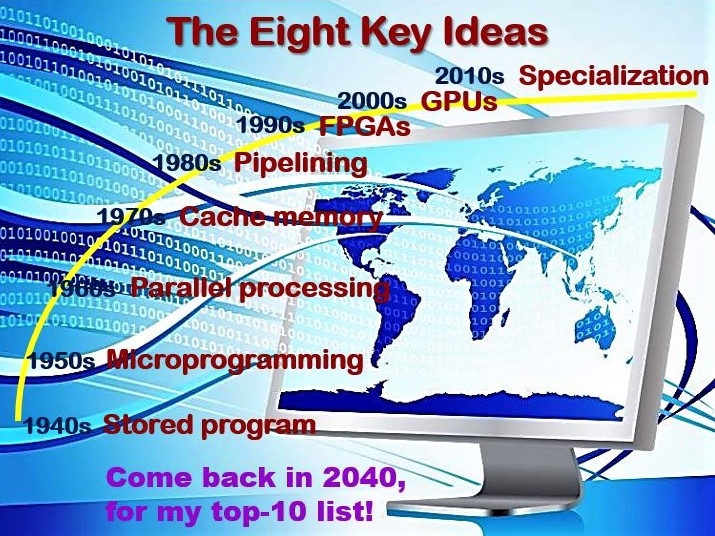
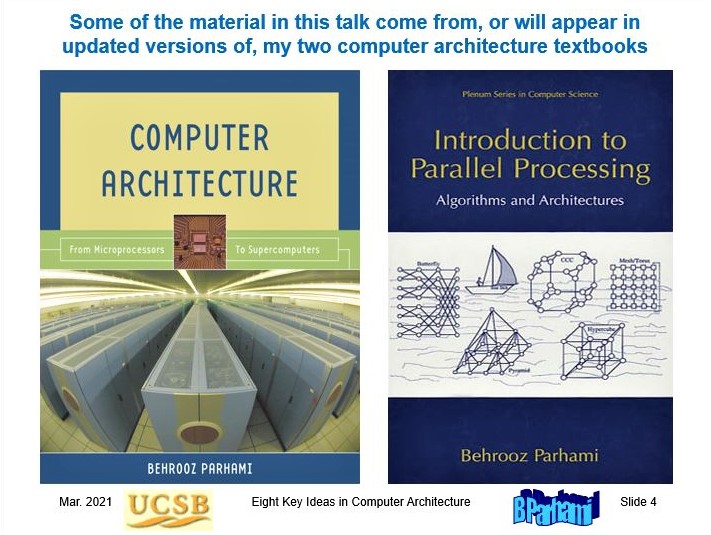
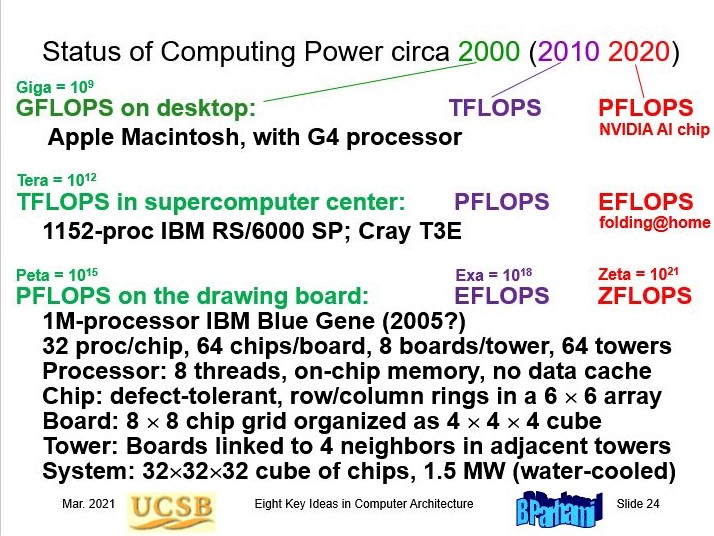
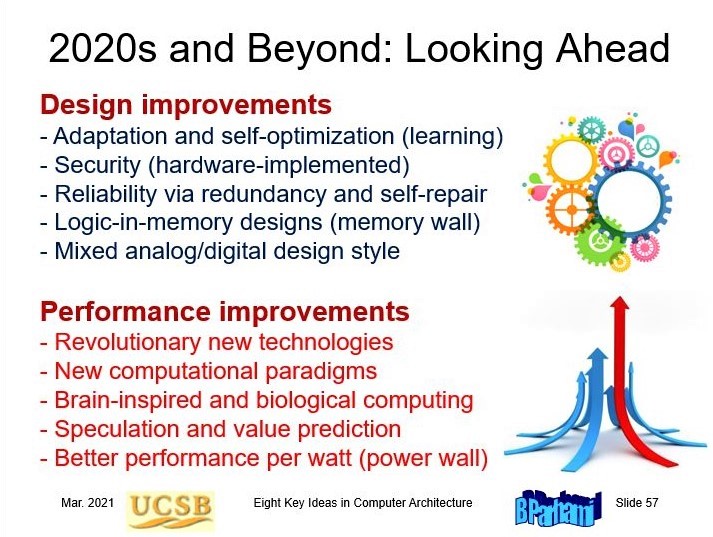
February 2021 special event, Dr. Valerie E. Taylor
Director, Mathematics and Computer Science Division & Distinguished Fellow, Argonne National Laboratory
Title: "Energy-Efficiency Tradeoffs for Parallel Scientific Applications"
Date/Time: Monday, February 22, 2021; 6:00 PM PST
Venue: Over Zoom (Courtesy of IEEE Santa Clara Valley Section; Registration link)
Dr. Taylor began by reviewing the energy consumption landscape among Top500 & Green500 supercomputers. We are now looking at tens of gigaFLOPS performance per watt of power. With application-level tuning, we can achieve up to 10% energy efficiency while sacrificing under 1% in speed and up to 14% energy savings with 5.5% slowdown. The tuning is aided by the use of some 39 hardware counters to instrument applications, in order to determine what needs to be done to reduce energy.
In answer to my question about whether loop unrolling, which is used to improve performance, also helps with energy efficiency, Dr. Taylor replied that it does. When significant reduction in computation time is achieved, even if it is accompanied by some increase in power consumption, the product of the the two, which represents energy, can and does go down significantly.
The following images show a few screenshots from the Zoom meeting.
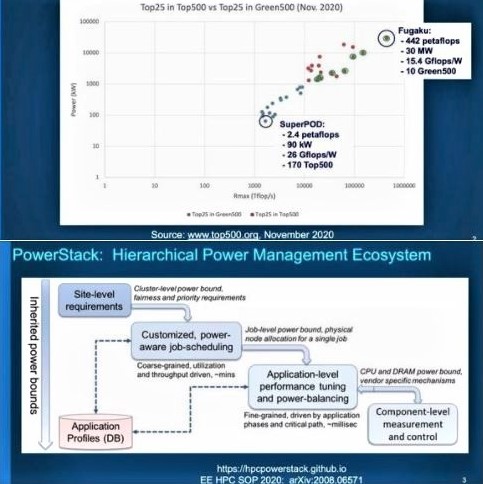
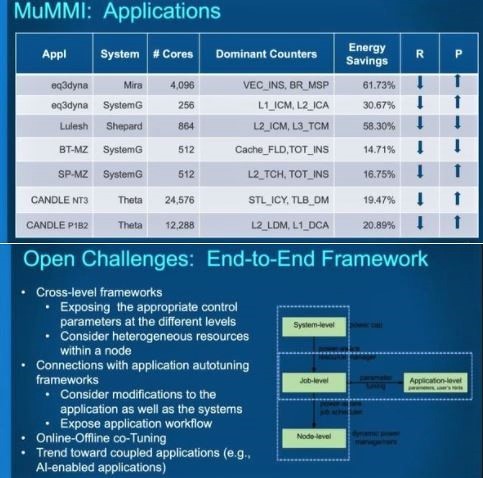
February 2021 speaker: Dr. Kerem Camsari
Affiliation: Department of Electrical and Computer Engineering, UCSB
Title: "Understanding Quantum Computing Through Negative Probabilities"
Date/Time: Wednedsay, February 17, 2021; 6:30-8:00 PM PST
Venue: Over Zoom
Links: IEEE CCS Event Page; Speaker's home page
Dr. Kerem Camsari (ECE Dept., UCSB) spoke under the title "Understanding Quantum Computing Through Negative Probabilities." Eighteen Section members and guests attended this enlightening talk.
Dr. Camsari began by lowering expectations about the term "Understanding" in his title, quoting physicist Richard Feynman who famously said "nobody understands quantum mechanics." Despite this tongue-in-cheek statement, Feynman provided one of the clearest conceptual pictures of quantum behavior in terms of a path formulation of quantum mechanics.
Dr. Camsari's approach is to try to understand the quantum universe by starting from a probabilistic world. As Feynman observed some 40 years ago, the main difference between a probabilistic world and a quantum world can be traced to the idea that probabilities need to be generalized to involve negative (or even complex) values. An outcome with negative probability cancels a similar one with positive probability, unlike in the case of normal probabilities, which always add up. The latter property allows us to do approximate computations by ignoring outcomes with very low probabilities.
After presenting certain applications that can be handled by probabilistic computing, which is more-easily realizable than quantum computing, Dr. Camsari proceeded to show how the difference above can be related to the recent groundbreaking demonstration of quantum advantage in engineered quantum computers and discussed some recent developments of probabilistic computing that can help accelerate the solution of computationally-hard problems. The following images show a few screenshots from the Zoom meeting.
[Further readings: The article "p-Bits for Probabilistic Spin Logic," by K. Y. Camsari et al. (Applied Physics Reviews, Vol. 6, #011305, 2019), provides technical details about the topics discussed. Dr. Camsari also has a just-published article in IEEE Spectrum magazine (April 2021), which is less technical than the above.]
The following images show a few screenshots from the Zoom meeting.
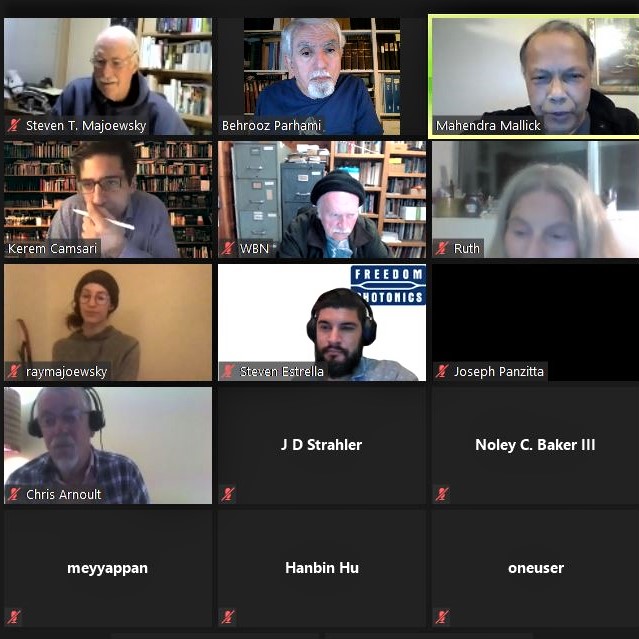
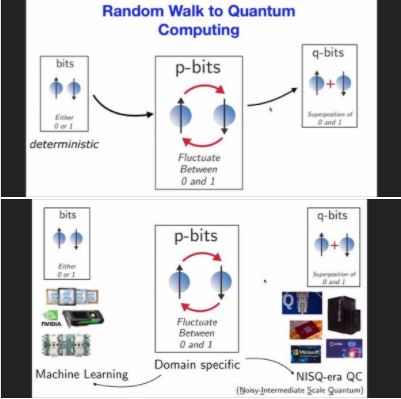
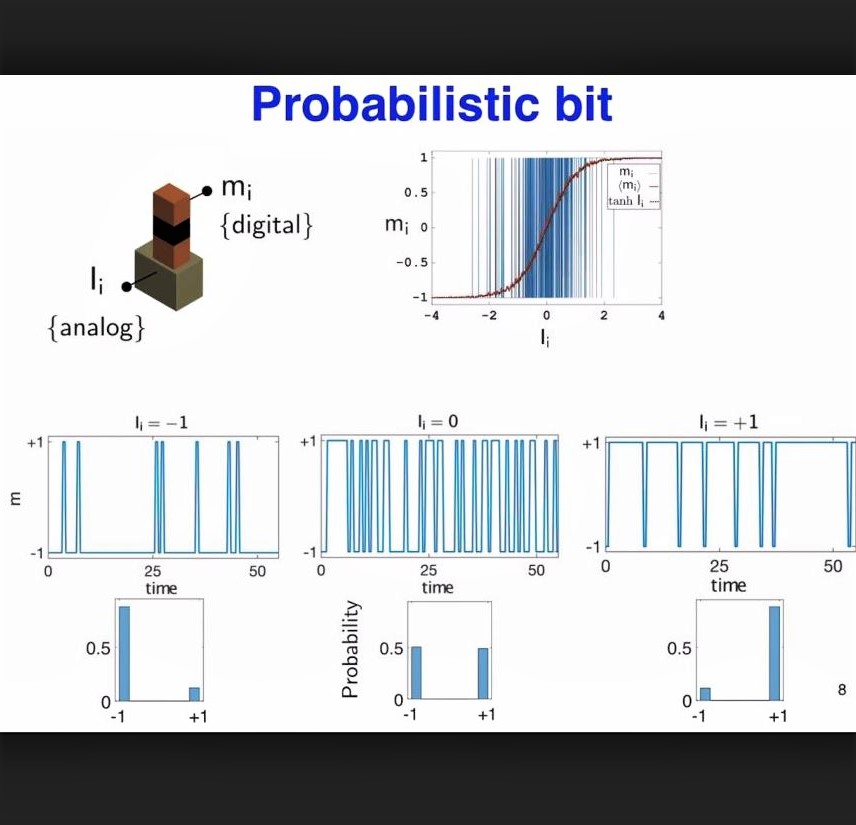
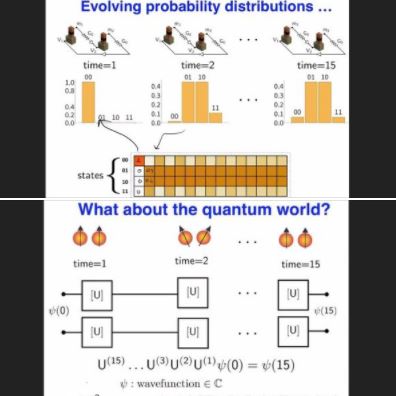
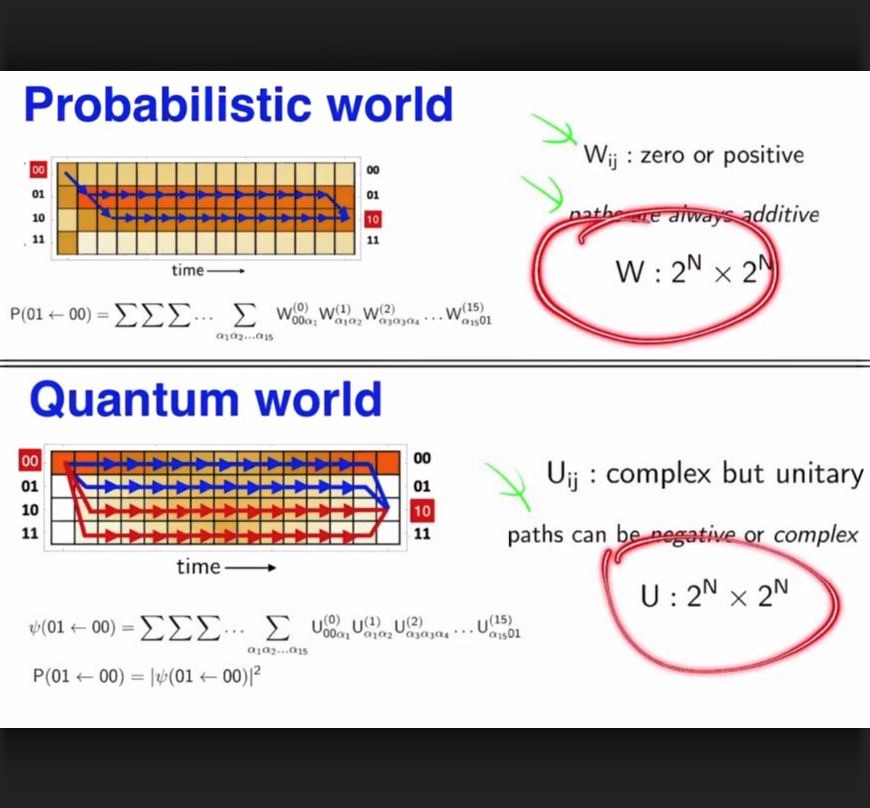
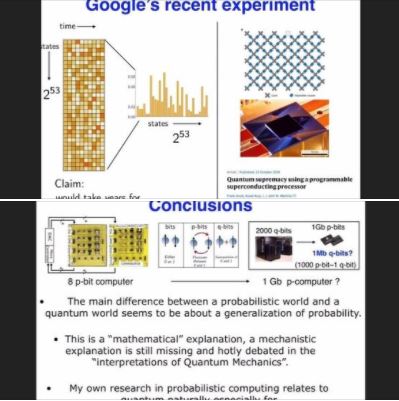
January 2021 speaker: Dr. Misha Sra
Affiliation: Department of Computer Science, UCSB
Title: "Perceptual Engineering"
Date/Time: Wednedsay, January 20, 2021; 6:30-8:00 PM PST
Venue: Zoom
Links: IEEE CCS Event Page; Speaker's home page; Photo
Dr. Misha Sra (John and Eileen Gerngross Assistant Professor, Computer Science Department, UCSB) spoke under the title "Perceptual Engineering." Perceptual (or perception) engineering encompasses:
- Technology development motivated by models of perception and cognition of biological systems.
- Technology development for analysis and understanding of human perception/cognition processes.
The web digitized information while social media digitized people and relationships. Technology and global events are now transforming not only the nature of work but also where it is done and when. We are likely to continue living in both our physical and digital worlds (even more so because of COVID-19) leading to the question: how can both worlds become more integrated to help shape our future hybrid lives? Dr. Sra presented work from her Perceptual Engineering lab that explores how we might design our hybrid lives with spatial computing technologies, sensor data, and AI algorithms.
Like any area of advanced technology, ethical challenges loom around every corner on Dr. Sra's work. For example, deep-fake videos enabled by research in perceptual engineering are seen as inherently evil, because we have seen them used maliciously. However, there are a large number of benevolent uses for the same technology, and perception manipulation more generally (say, in education), that Dr. Sra outlined in her talk. Ethical considerations of this line of research tie nicely into topics discussed in our December 2020 talk by Dr. Jessica Santana.
A lively Q&A period followed, during which issues such as requirements for experimenting with human subjects, the "arms race" between faking schemes and the corresponding detection algorithms, the Turing test, and living in the Matrix were raised.
The following images show a few screenshots from the Zoom meeting.
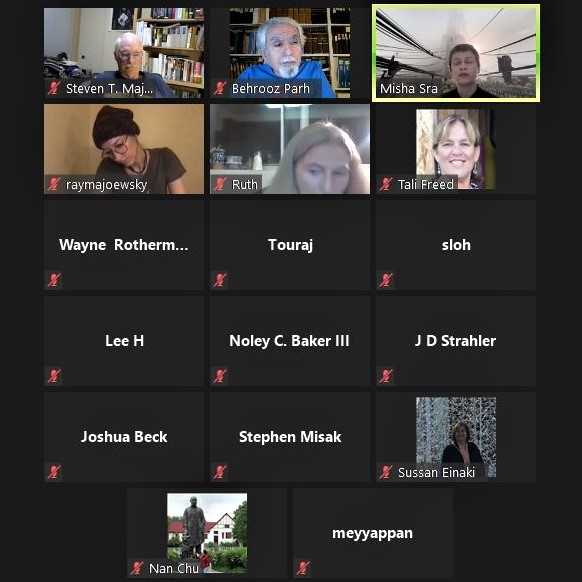
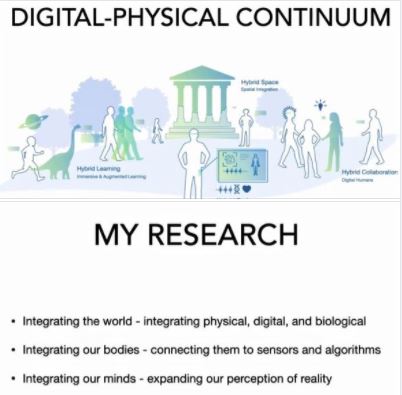
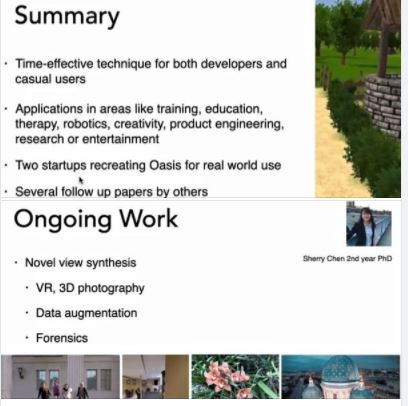
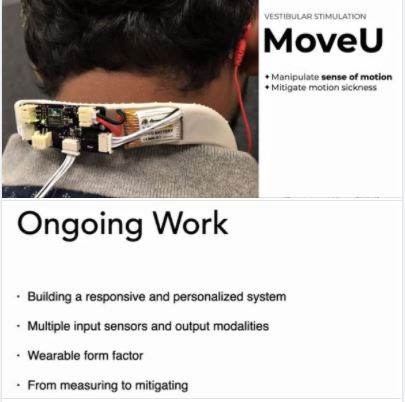
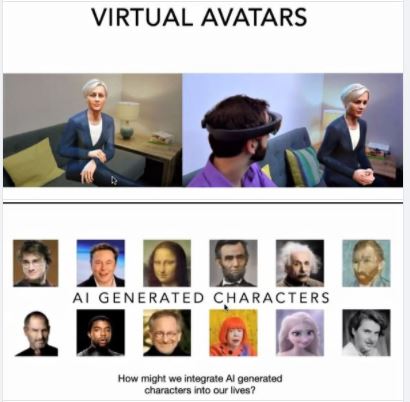
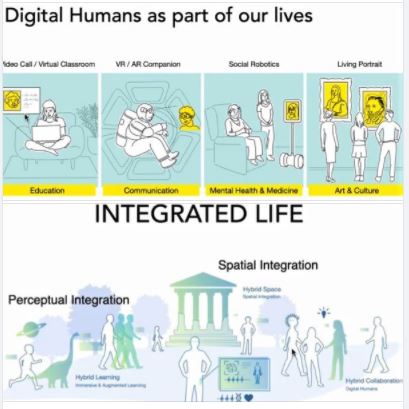
December 2020 speaker: Dr. Jessica Santana
Affiliation: Technology Management Program, UCSB
Title: "Using Natural Language Processing to Measure Ethical Convergence in Scientific Discourse"
Date/Time: Wednedsay, December 16, 2020; 6:30-8:00 PM PST
Venue: Zoom (link provided upon registration)
Links: IEEE CCS Event Page; Speaker's home page; Photo
Dr. Jessica Santana (Assistant Professor, Technology Management Program, UCSB) spoke under the title "Using Natural Language Processing to Measure Ethical Convergence in Scientific Discourse." TMP was established within UCSB's College of Engineering in 2004, following several years of experimentation with mentoring students in the business and management aspects of technology, including how to produce business plans.
While the title represents Dr. Santana's recent research, she presented in the first half of her talk a general discussion of ethics in science and technology, beginning with the Tuskegee syphilis experiment and proceeding to a number of modern-day versions of the same type of unethical behavior. Examples include the recent dispute at Google over an employee's publication of an ethics paper that led to her firing and machine-caused discrimination in the criminal justice system.
In the second half of her talk, Dr. Santana outlined the relationship between ethics and innovation. Innovation requires a certain level of boldness, which manifests itself in working at the boundaries (gray areas). Dr. Santana then focused on how codes of ethics in various professions and industry segments emerge from scientific discourse over the boundary work and how natural-language processing can be used to detect contentious issues and the path to common standards.
A Q&A period followed, during which it was emphasized that paying attention to ethics is increasingly necessary, as high-tech implements and highly-complex AI algorithms embedded therein create the risk of ethical violations. Engineering programs are becoming aware of the importance of ethics as part of their curricula. Federal legislation in the US unfortunately lags the norms set by other countries (notably EU) and even some individual states.
Technical bio: Dr. Jessica J. Santana is an Assistant Professor in the Technology Management Program at UCSB, where she studies the role of networks in innovation and entrepreneurship. Her recent research investigates the relationship between innovation and ethics in contexts such as synthetic biology and cryptocurrency crowdfunding. She also explores how entrepreneurs use peers and rhetoric to navigate sensemaking and stigma following startup failure. Her work is driven by insights from organizational theory, economic sociology, social psychology, and network science. She relies on a variety of methodological approaches, including experimental, statistical, and computational analyses. Dr. Santana holds a PhD and an MA in Sociology from Stanford University and a Master of Information Management and Systems degree from UC Berkeley's School of Information, with certification in the Management of Technology from the Haas School of Business.
The following images show a few screenshots from the Zoom meeting.
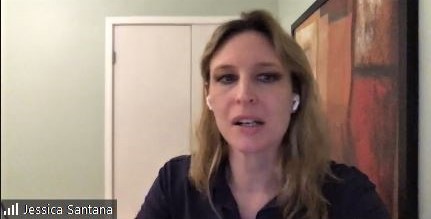
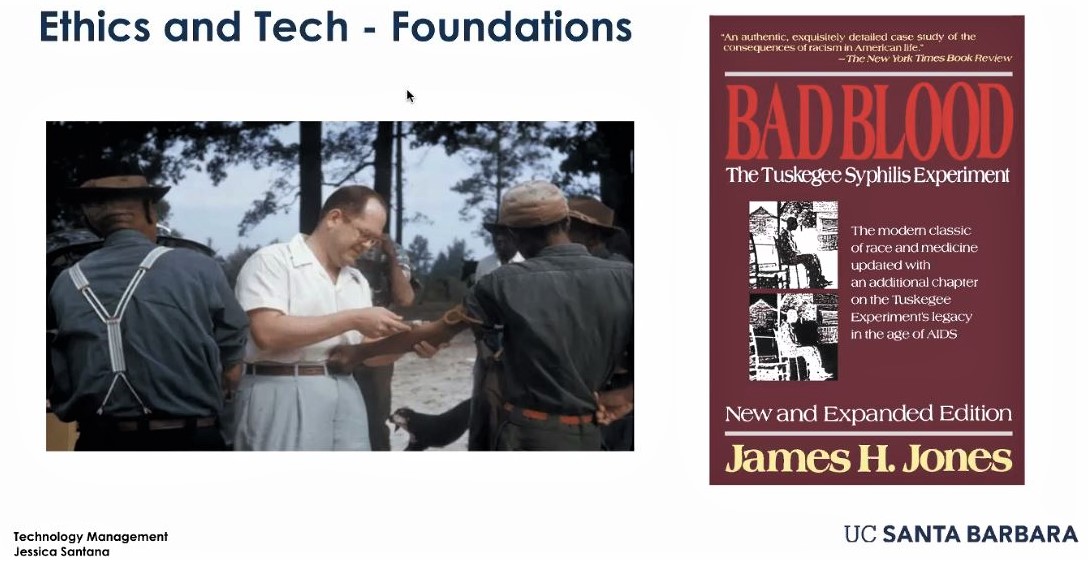
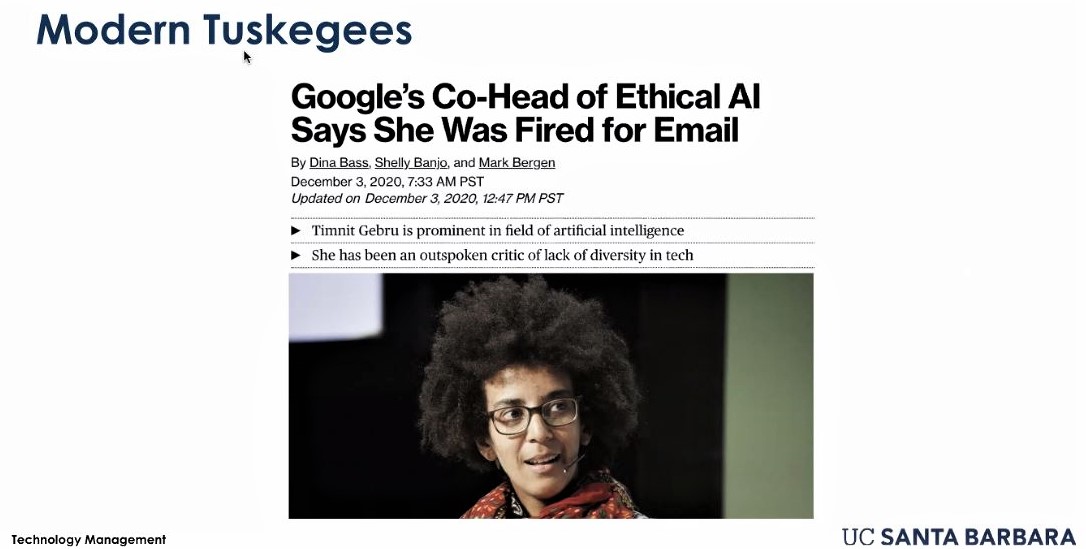
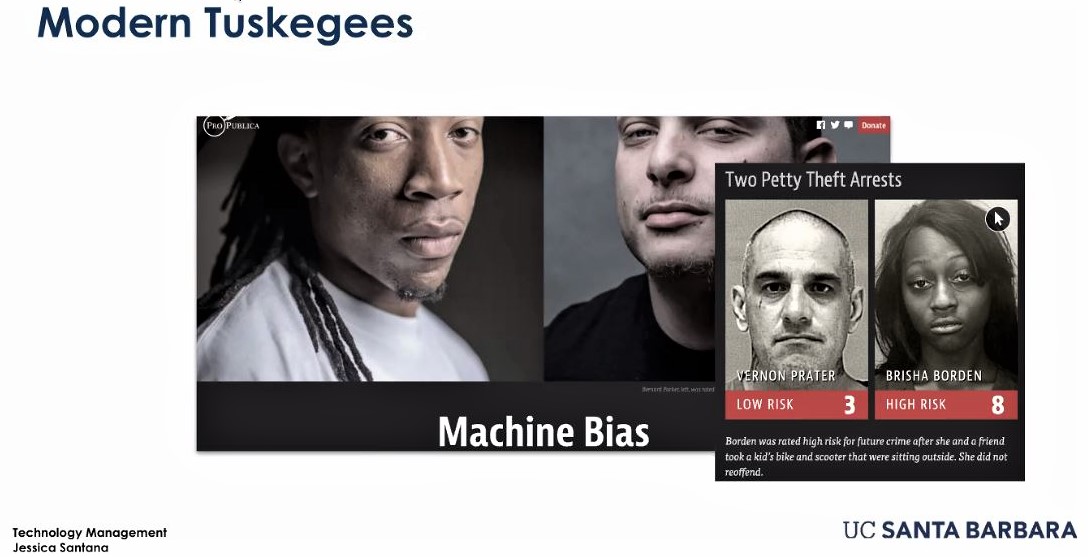
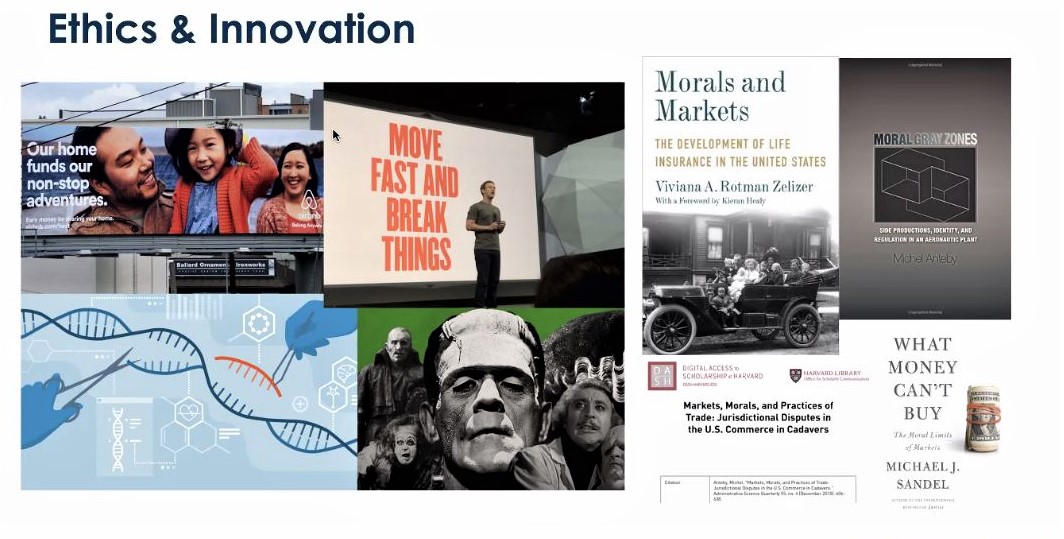
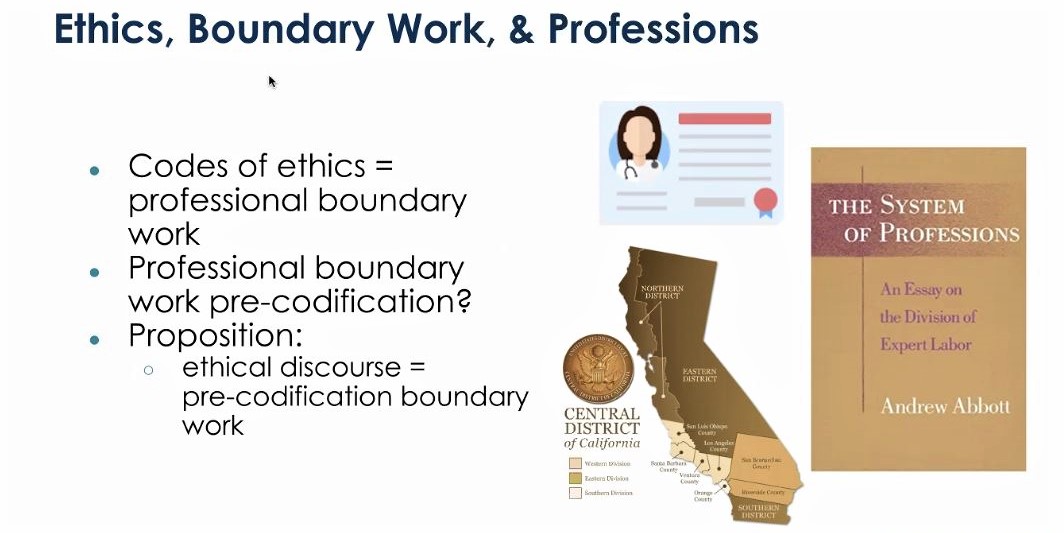
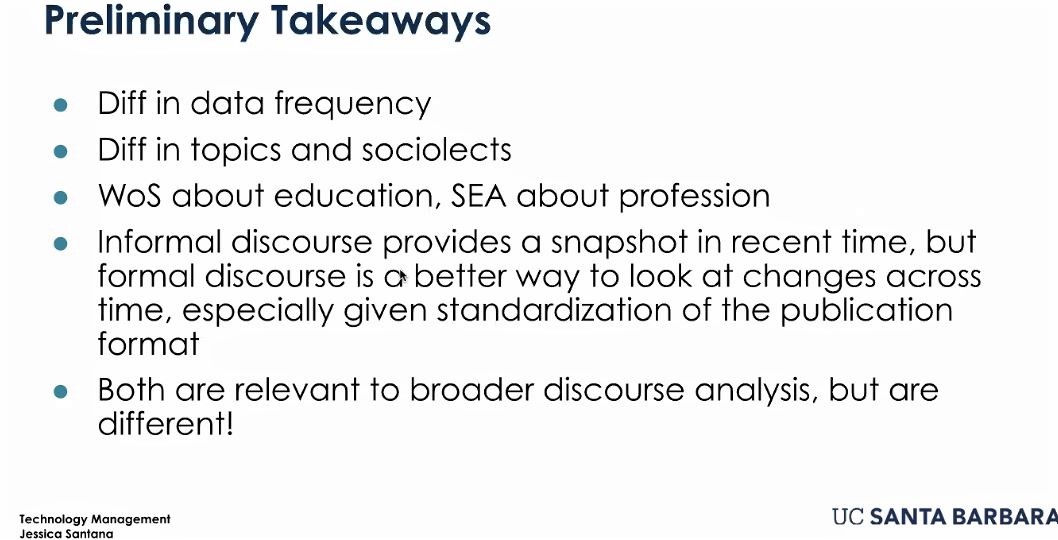
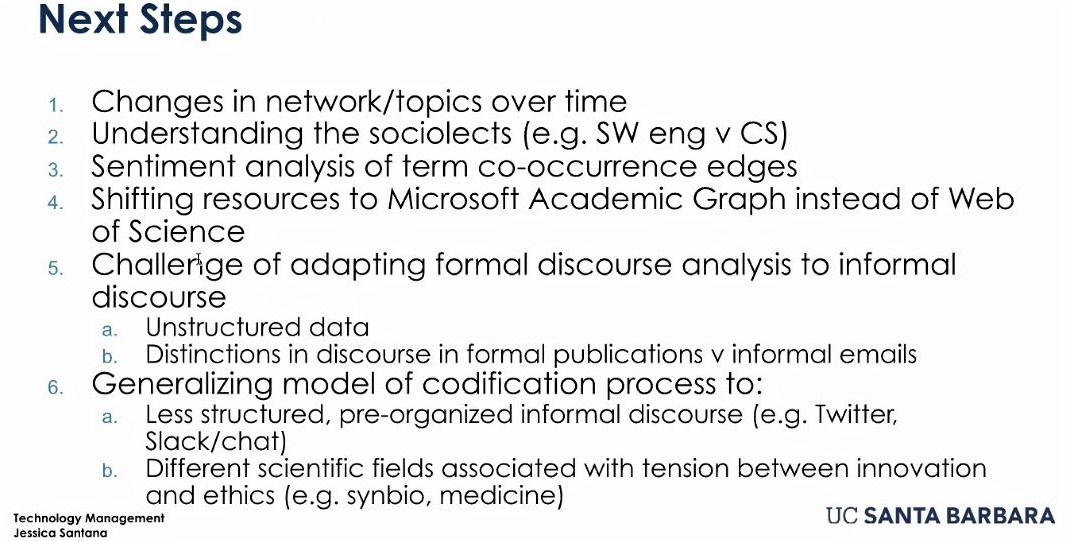
December 2020 IEEE CS Phoenix Chapter speaker: Mark Goldstein
Affiliation: President of International Research Center
Title: "Next-Generation Wireless Overview & Outlook"
Date/Time: Wednedsay, December 09, 2020; 6:00-8:00 PM PST
Venue: WebEx, link provided upon free registration [Link]
November 2020 speaker: Dr. Rich Wolski
Affiliation: Computer Science Department, UCSB
Title: "Experiences with IoT and The New Internet as a Platform of Things"
Date/Time: Wednesday, November 18, 2020; 6:30-8:00 PM
Venue: Zoom
Links: IEEE CCS Event Page; Speaker's home page; Photo
Dr. Rich Wolski (Professor and holder of Duval Presidential Chair in Energy Efficiency, Department of Computer Science, UCSB) spoke under the title "Experiences with IoT and The New Internet as a Platform of Things."
The Internet of Things (IoT) is a rapidly approaching technological change that envisions ubiquitous and network-accessible digital instrumentation and actuation of literally every "thing" we encounter in daily life. Like the World Wide Web (now simply called The Internet) before it, which brought changes comparable to that of the printing press, IoT will likely represent another societal sea change, as objects in the physical world become network-enabled so that they can communicate and interact with people and, autonomously, with each other.
This technological vision comes with significant new challenges. Given estimates of between 50 billion and 1 trillion network-connected IoT devices in the next 20 years, the energy efficiency of these devices and the network technologies that interconnect them is paramount to their utility. And power efficiency does not just affect battery life, but raises the need for new infrastructure planning and implementation. Moreover, the current Internet architecture, which is evolving to accommodate cloud computing, will require substantial additional innovation and augmentation before IoT will come to complete fruition.
Dr. Wolski discussed some of the computer science research questions that have grown from early experiences in architecting and deploying working IoT systems and infrastructure. In particular, the talk focused on a potentially new approach to software infrastructure that is designed to meet many of the current and future IoT challenges. Dr. Wolski used the example of sensing and actuation for improving productivity and protecting against extreme weather conditions in a citrus grove to illustrate some of the challenges in IoT deployment, communications, and data analysis.
To save power, reduce network latency, and ease network congestion, devices export data and actuation services that are accessed by applications running in the cloud. Unlike services such as e-commerce and Netflix, where large volumes of data flow to users and precious few clicks are captured in the other direction, IoT entails data primarily flowing in the reverse direction. "Flipping" the current Internet architecture, with services at the extreme edge of the network and applications running at the core (i.e., in the cloud), requires a new technological approach that creates a Software Platform of Things—SPOT—spanning devices, computing elements located at the edge (e.g., edge clouds), and traditional cloud data centers.
Technical bio: Dr. Rich Wolski is a Professor of Computer Science at UCSB, where he holds the Duval Presidential Chair in Energy Efficiency. Having received his MS and PhD degrees from UC Davis (while a research scientist at Lawrence Livermore National Laboratory) he has also held positions at UC San Diego, University of Tennessee, San Diego Supercomputer Center, and Lawrence Berkeley National Laboratory. Dr. Wolski has led several national-scale research efforts in the area of distributed systems and is the progenitor of the Eucalyptus open source cloud project.
The following images show a few sample slides used in the talk.
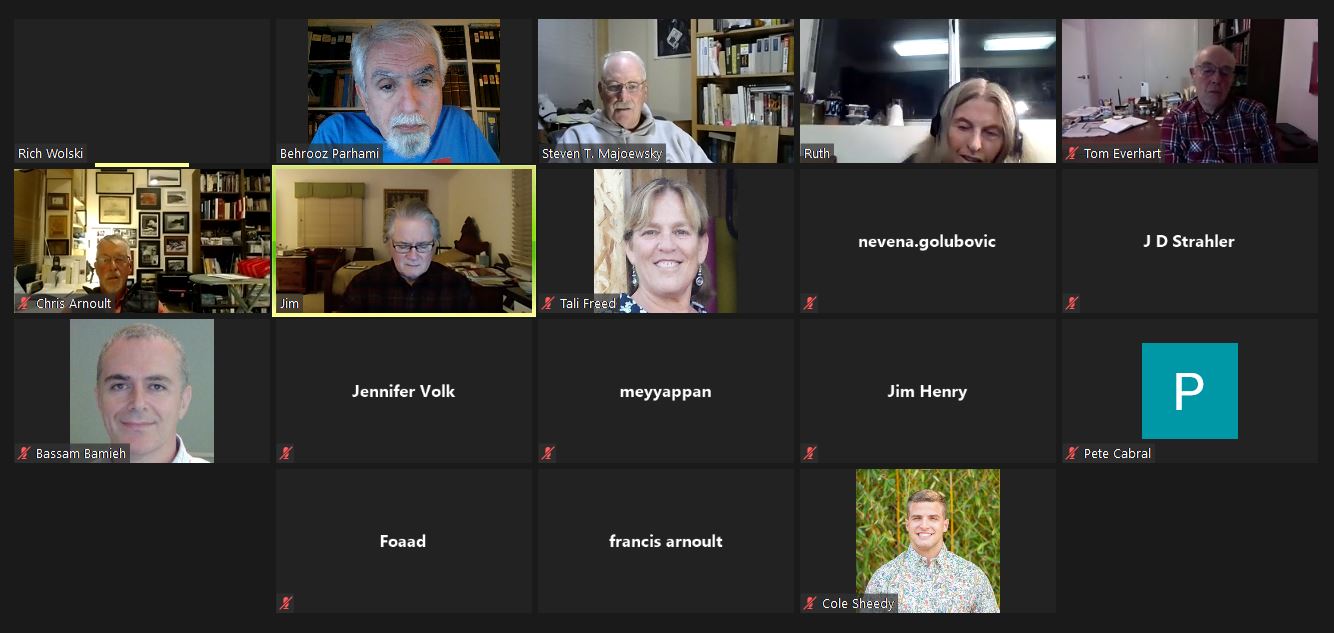
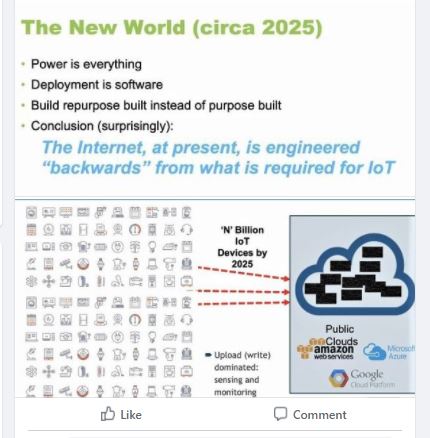
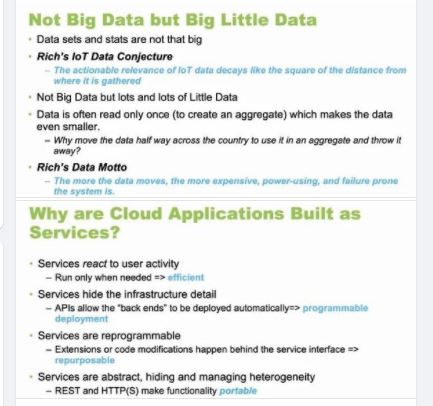
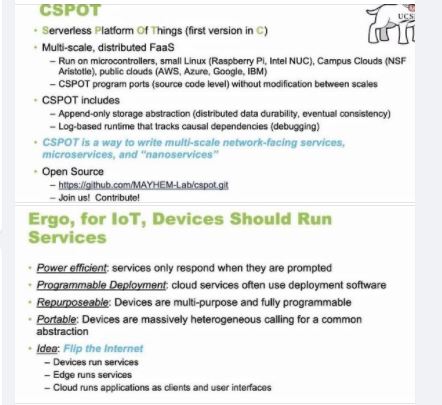
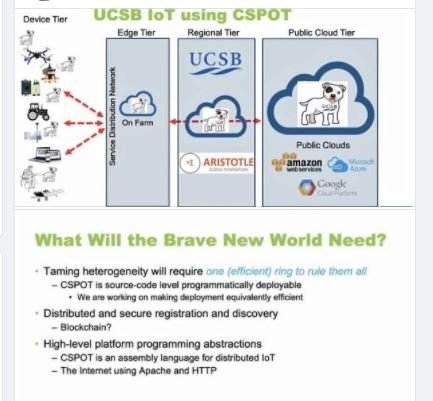
October 2020 speaker: Dr. Yangying Zhu
Affiliation: Mechanical Engineering Department, UCSB
Title: "Microscale Thermal-Fluids Engineering for Next-generation Energy and Electronic Systems"
Date/Time: Wednedsay, October 21, 2020; 6:30-8:00 PM
Venue: Zoom
Links: IEEE CCS Event Page; Speaker's home page
Dr. Yangying Zhu (Assistant Professor, Department of Mechanical Engineering, UCSB) spoke under the title "Microscale Thermal-Fluids Engineering for Next Generation Energy and Electronics Systems."
Professor Zhu began her talk with some very recent work in applying thermo-fluid science and engineering to understanding the spread of coronavirus, a topic that is on everyone's mind these days, both at a personal level and in academic circles, where researchers in diverse fields are trying to develop mitigation methods.
Professor Zhu's work in this domain has contributed to a more precise delineation of social-distancing requirements. Briefly, virus-bearing droplets leaving an infected person behave differently according to environmental conditions, such as humidity and temperature. Some droplets fall to the ground under the pull of gravity, but the distance they travel (a function of environmental conditions) is in many cases more than 6 feet (~2 m), commonly recommended as a safe distance. Some of the droplets evaporate, turning into dry, virus-bearing aerosols that can travel even further. The two modes of virus transmission (breathing in droplets or aerosols) change in opposite directions. In a warm state such as Texas, the droplets travel shorter distances, whereas the heat leads to the production of more aerosol particles. The net result is that safe social-distancing requirements are different, based on geographic location.
Professor Zhu then moved on to the main part of her talk about effective management of heat, which has become a critical challenge in many energy and electronic applications due to the increasing power density and shrinking length scales. For example, next-generation lithium-based batteries for electric vehicles are designed to be charged at ~10 times of the electric current used now, which means ~100 times higher joule heating; high-performance gallium nitride based power electronic devices require heat dissipation of ~1000 W/cm^2, which is 1/6 of the heat flux at the surface of the Sun. Improving the thermal performance of these systems is necessary to ensure safe and efficient operations and requires manipulating the heat and fluid transport at the microscopic length scale.
Professor Zhu discussed solutions to the challenging heat-removal problem which leverage micro-scale modeling, fabrication, and characterization capabilities to provide new insights into thermal effects in lithium-based batteries and achieve aggressive cooling of electronics. She told the audience about the discovery of a microscopic heat-triggered battery failure mechanism through in-situ local temperature sensing using micro-Raman spectroscopy and a novel graphene transducer. The high spatial resolution and the in-situ capability enables direct observation of the correlation between local temperature hotspot and accelerated Li growth, which leads to internal shorting of the Li battery.
Additionally, Professor Zhu described the development of a two-phase microchannel heat sink that significantly enhances temperature stability and achieves a 60% improvement in heat-flux dissipation for electronics. These improvements are realized through integrating micropillar structures into microchannels, which are optimized with thermo-fluid modeling to maximize capillary wicking.
These examples demonstrate the potential of combining fundamental thermo-fluid science and advanced micro/nano engineering approaches to address many of the pressing thermal challenges in next-generation energy and electronic systems. Research teams across the world are working towards integrating the heat-removal structures discussed above with the manufacturing process for electronic components on silicon or other kinds of integrated-circuit chips.
Speaker's bio: Professor Yangying Zhu (PhD, MIT) joined UCSB's ME Department in July 2019. Her work focuses on advanced thermal management and characterizations of energy and electronic systems. At MIT, under the mentorship of Professor Evelyn Wang, she developed microsystems for aggressive cooling of electronics. During her post-doc with Professor Yi Cui at Stanford University, she investigated thermal effects in lithium-based batteries. She received the Meredith Kamm Memorial Award for Outstanding PhD Thesis and the graduate Women of Excellence Award from MIT.
The following images show a few sample slides used in the talk. Dr. Zhu has kindly provided us with her complete set of slides.
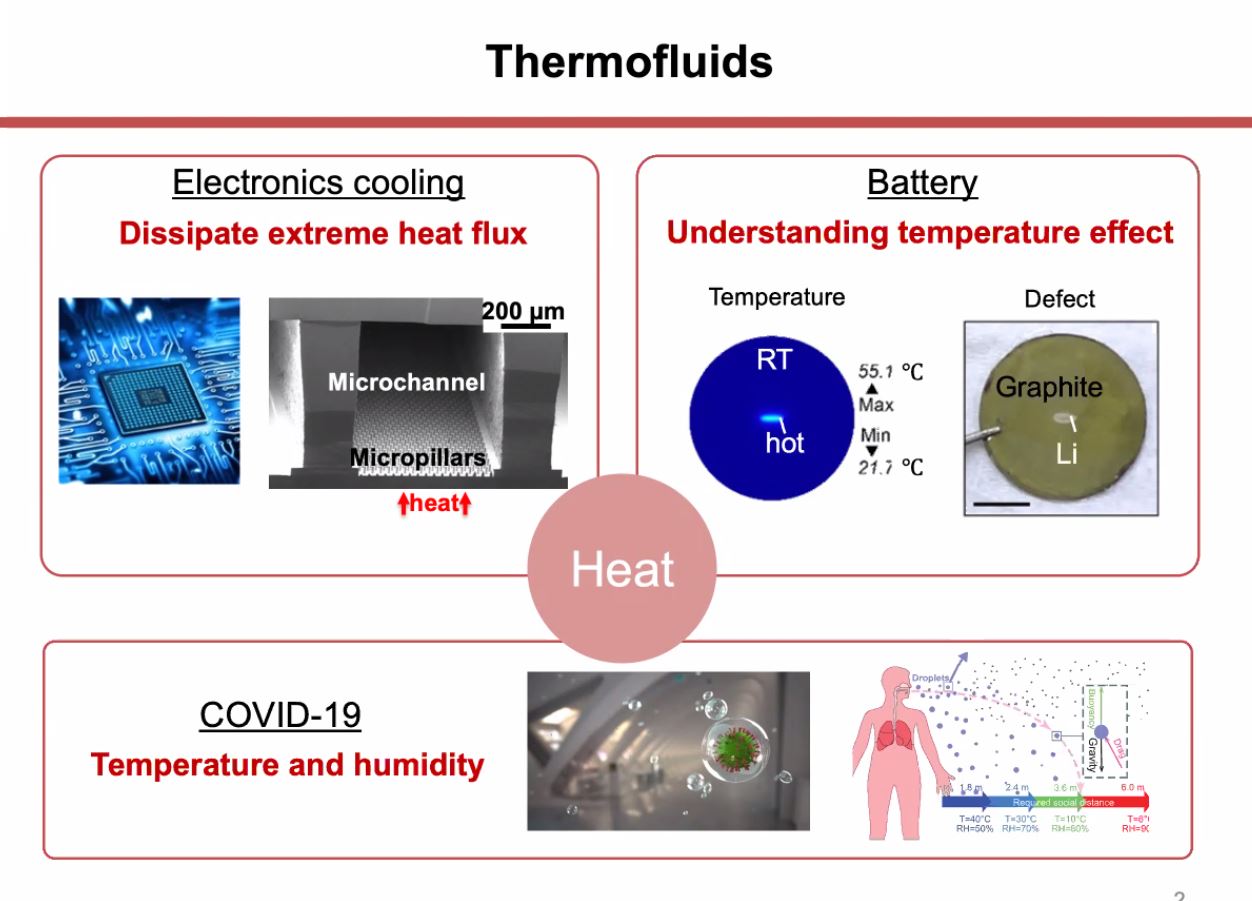
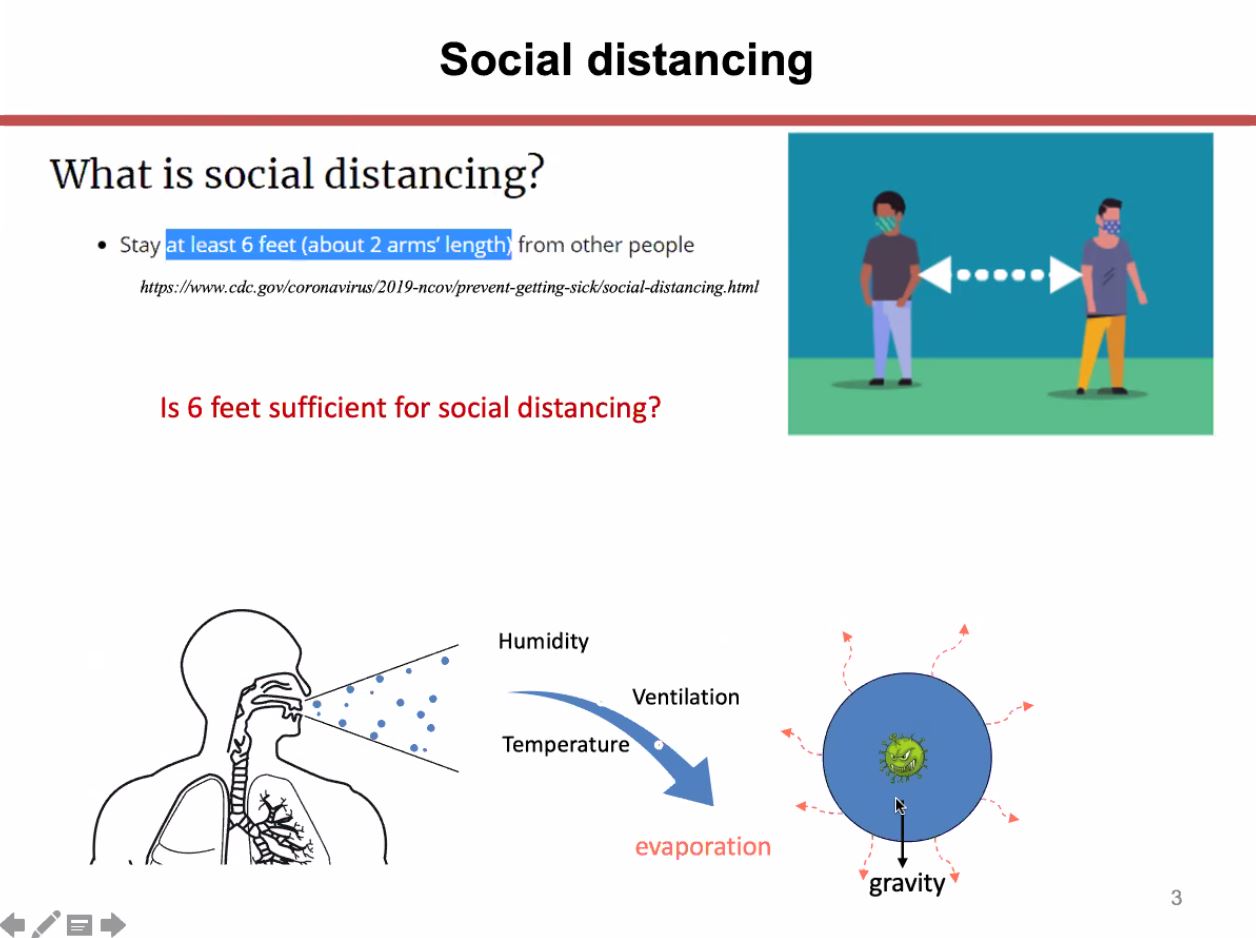
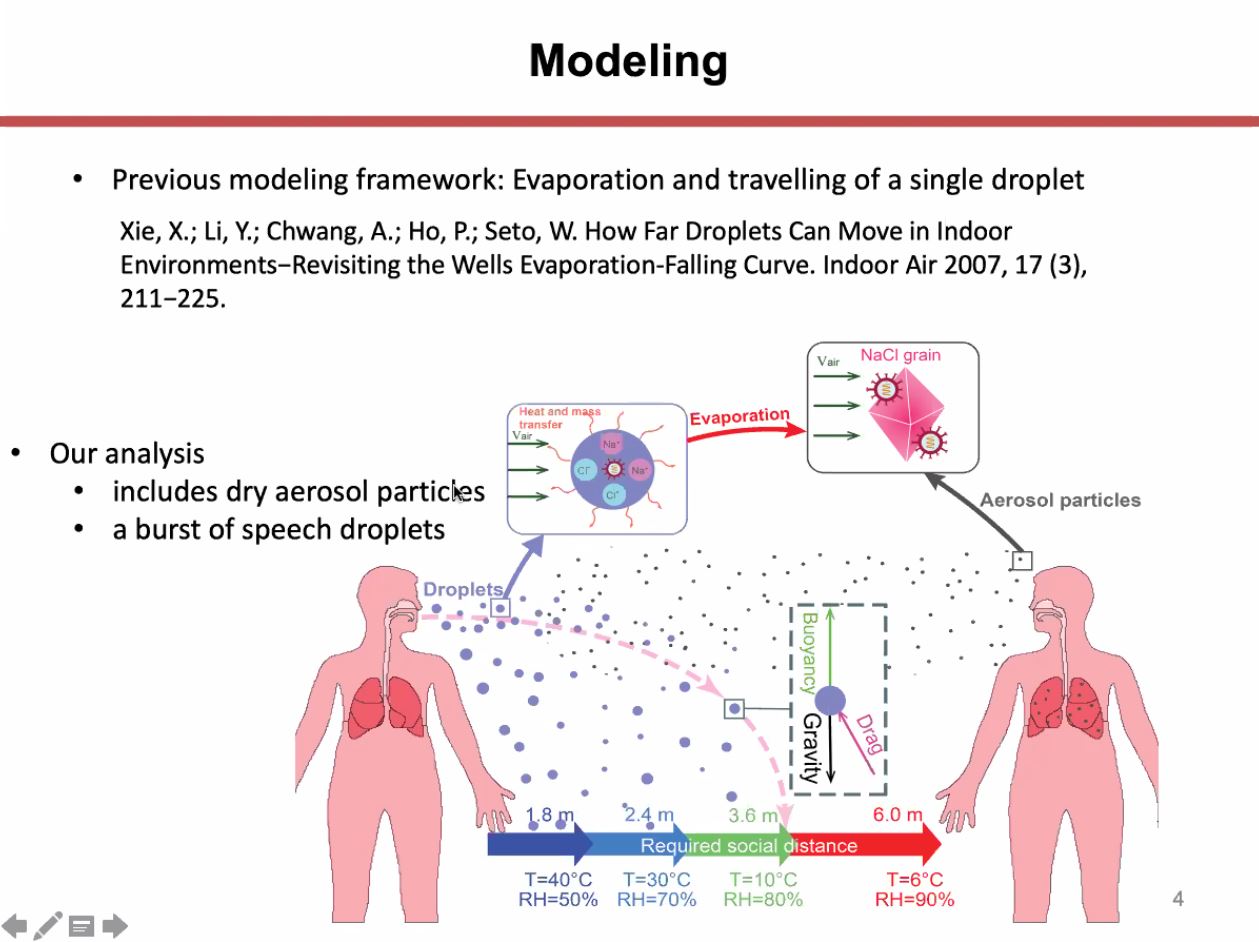
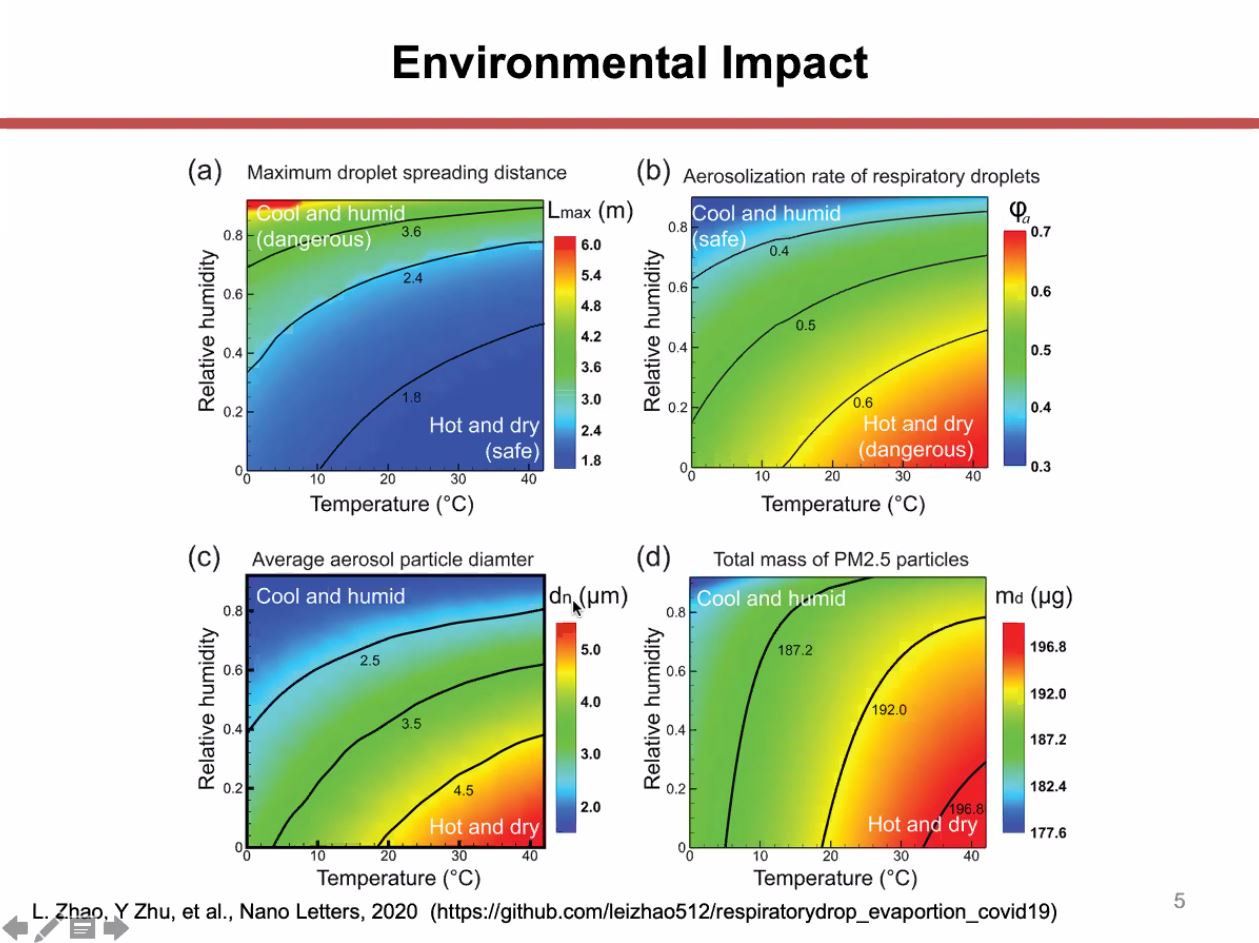
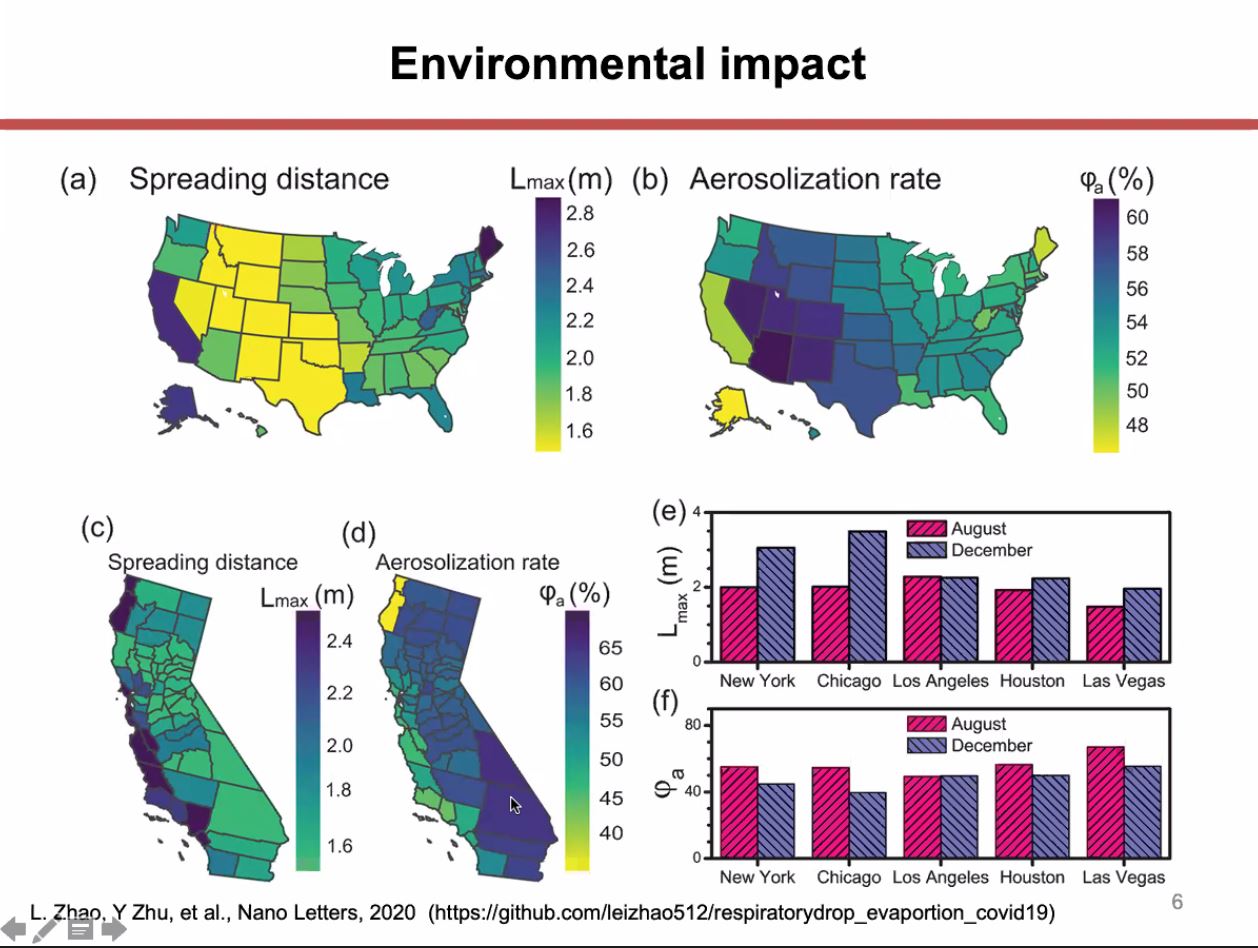
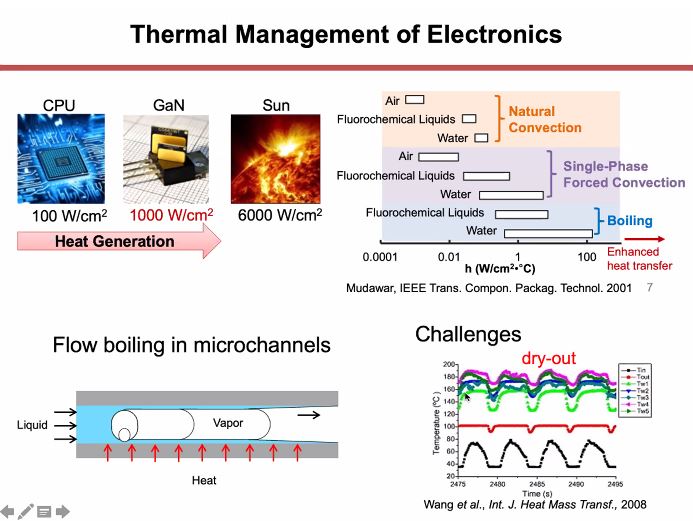
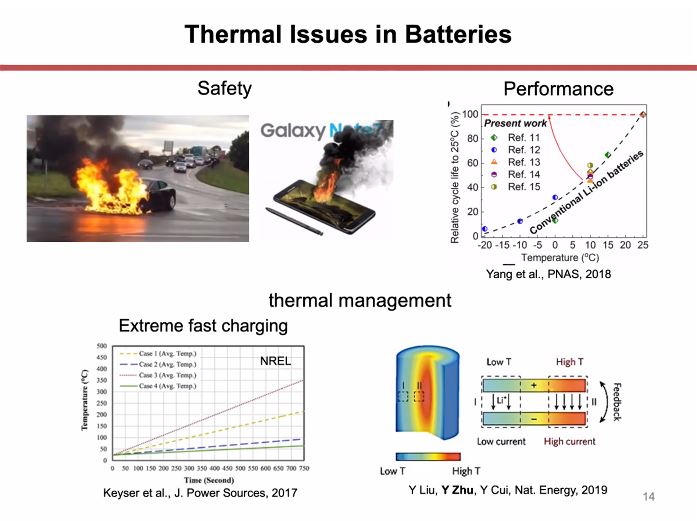
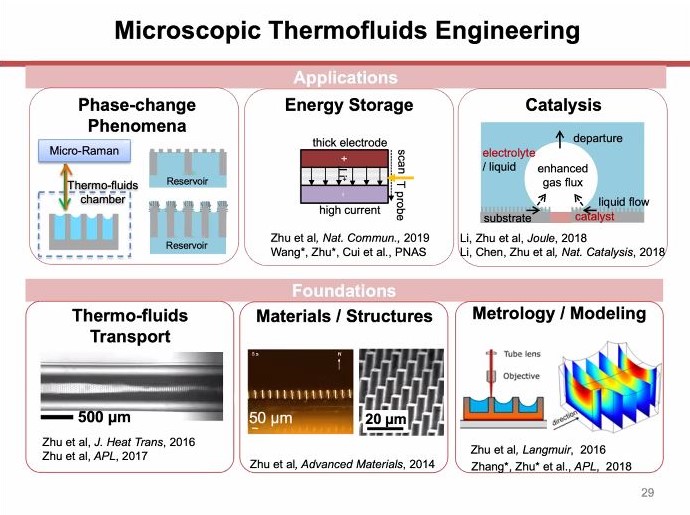
September 2020 speaker: Dr. Luke Theogarajan
Affiliation: Electrical and Computer Engineering Department, UCSB
Title: "Electronics Meets Biology"
Date/Time: Wednedsay, September 16, 2020; 6:30-8:00 PM
Venue: On-line (Zoom link provided with registration for the event)
Links: IEEE CCS Event Page; Speaker's home page; Facebook post; Tweet
The vision of electronics closely integrated with biology, popularized in science-fiction, is now becoming a reality. Dr. Theogarajan outlined the role of electronics in biology, within the two areas of neural interfacing and biosensing. Rapid advances in CMOS devices with the ever-shrinking transistor dimension has enabled the packing of unprecedented power in a small silicon area. However, there has not been a concomitant advance in the technology currently used for therapeutic devices. Some fundamental reasons as to why this is the case and ways of overcoming the barriers were outlined. Additionally, work in biosensing and interfacing at the micro-, nano-, and macro-scale done by Dr. Theogarajan's research group was highlighted. Challenges of remote-powering of these devices and some of the clever techniques that have been explored constituted another area of discussion. The continued role played by electronics in advancing human health concluded the talk.
The following images show a few sample slides from the talk.
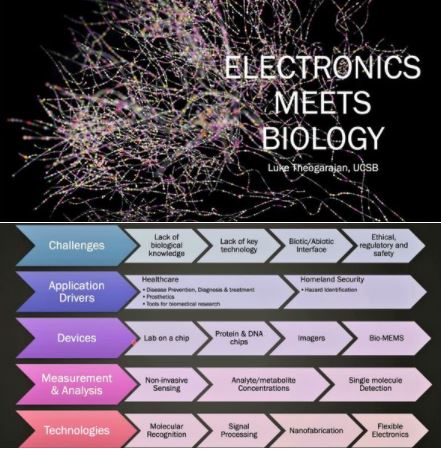
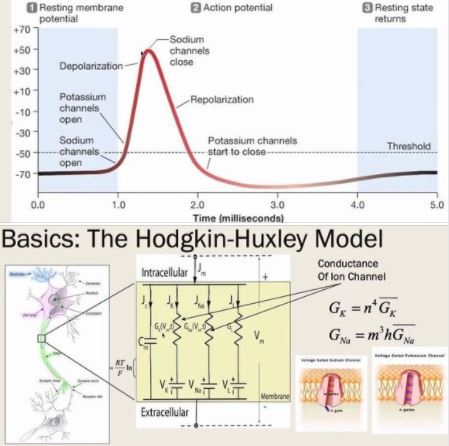
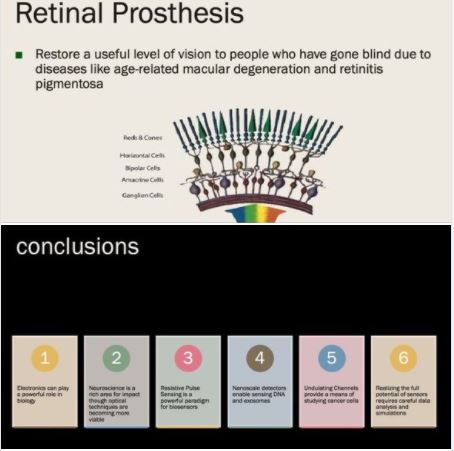
August 2020 speaker: Dr. Eckart Meiburg
Affiliation: Mechanical Engineering Department, UCSB
Title: "Modeling the Pacific Ocean on the computer"
Date/Time: Wednedsay, August 19, 2020; 6:00-8:00 PM
Venue: Santa Barbara's Arnoldi's Cafe, 600 Olive St.
Links: IEEE CCS Event Page; Speaker's home page; Speaker's slides (281 MB)
Today's event was held over dinner, beginning at 6:00 PM, in the courtyard of Santa Barbara's Arnoldi's Cafe. Dr. Eckart Meiburg, Distinguished Professor of Mechanical Engineering at UCSB, spoke under the title "Modeling the Pacific Ocean on the Computer." This interesting and highly-relevant climate-related talk was our first live event, after two months of cancellations and another two months of on-line talks.
Professor Meiburg earned his PhD degree from U. Karlsruhe, Germany, in 1985 and joined UCSB in 2000, after appointments at Stanford U., Brown U., and USC. A Fellow of American Physical Society and American Society of Mechanical Engineers, Dr. Meiburg has been widely honored for his research on computational fluid dynamics, focusing on environmental and multiphase flows.
The transport of heat, CO2, and other substances by ocean currents plays a crucial role in shaping Earth's climate. Dr. Meiburg highlighted some of the important mechanisms that dominate the dynamics of the ocean and generate large-scale ocean currents. He discussed the basic concepts underlying his research team's approaches to modeling and predicting the dynamics of the ocean on the computer, introducing some of the smaller-scale models developed in his research group. To illustrate the power of such computational models, he showed several computer-generated movies of oceanic transport processes.
Some of the interesting facts alluded to in this talk included ocean currents and their effects on global climate, movement of sediments that enter the oceans from rivers and how they create underwater landslides and canyons, underwater ocean waves, and differences in computational requirements and accuracies between fine-grain and coarse-grain models.
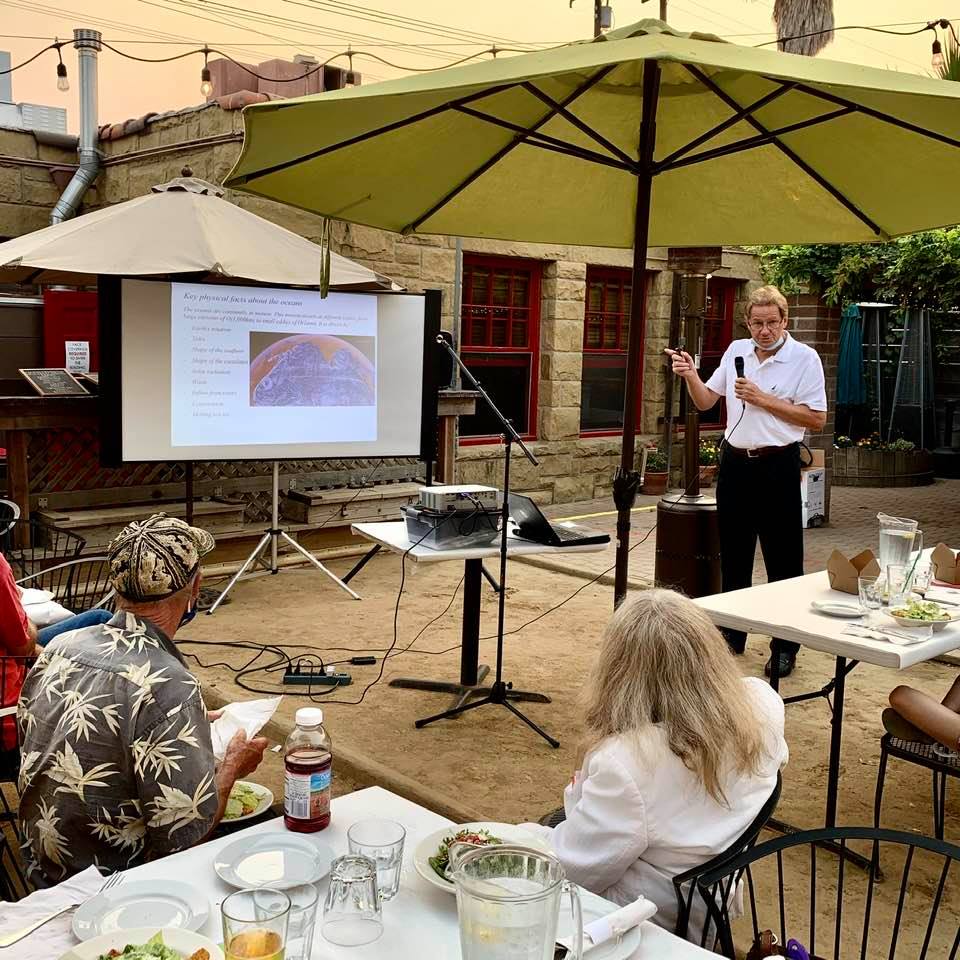
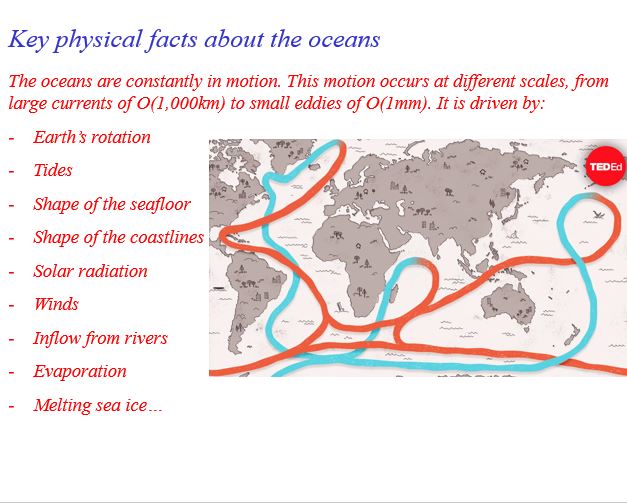
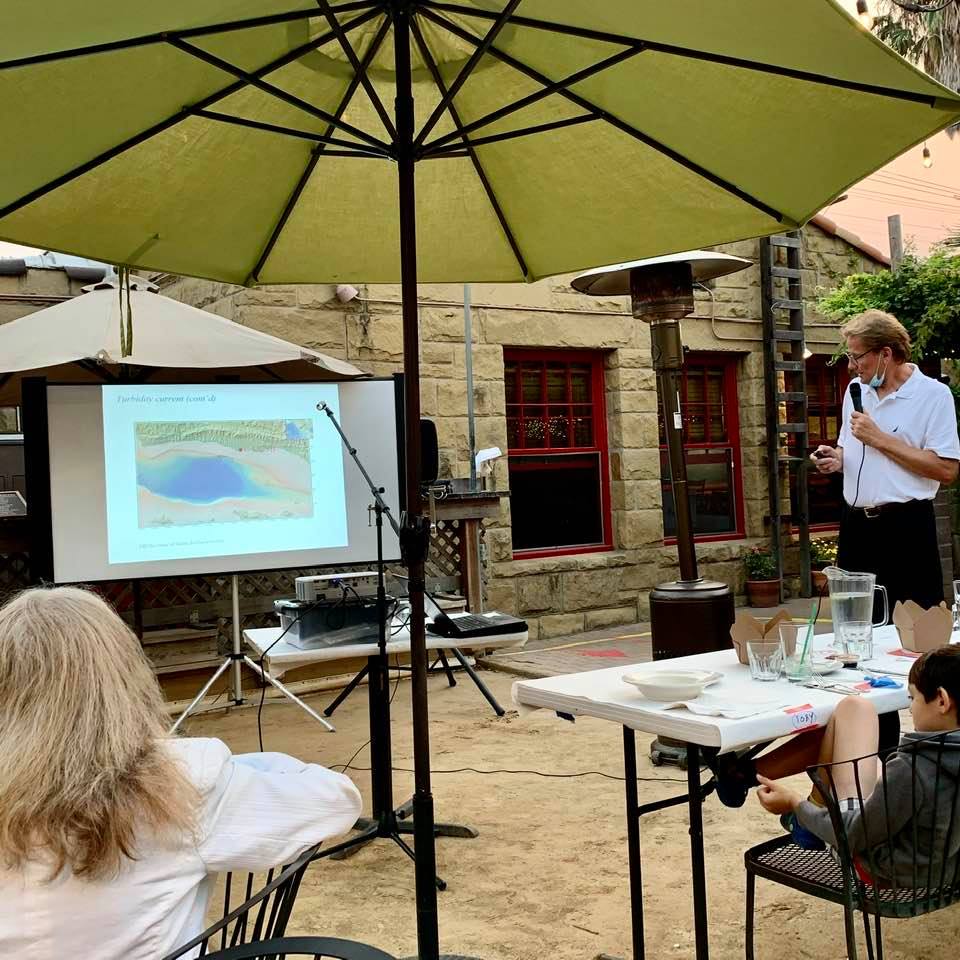
July 2020 speaker: Dr. Behrooz Parhami
Affiliation: Electrical and Computer Engineering Department, UCSB
Title: "Recursive Synthesis of Digital Circuits: Advantages and Examples"
Date/Time: Wednedsay, July 15, 2020; 6:30-8:00 PM
Venue: On-line via Zoom (details to be provided to those who register in response to IEEE invitation)
Links: IEEE CCS Event Page; Speaker's home page; Speaker's publications page
Offered today via Zoom to 16 participants, the talk, entitled "Recursive Synthesis of Digital Circuits: Advantages and Examples," covered the role and benefits of recursion in hardware design via a well-known example (FFT networks), a lesser-known strategy (recursive multipliers & squarers), and a new class of circuits (counting networks). A few of the talk's slides follow.
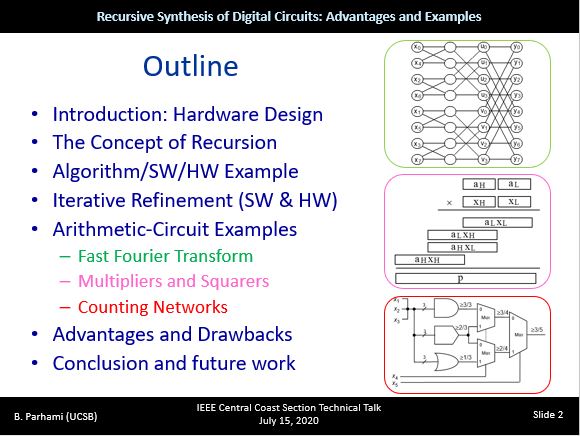
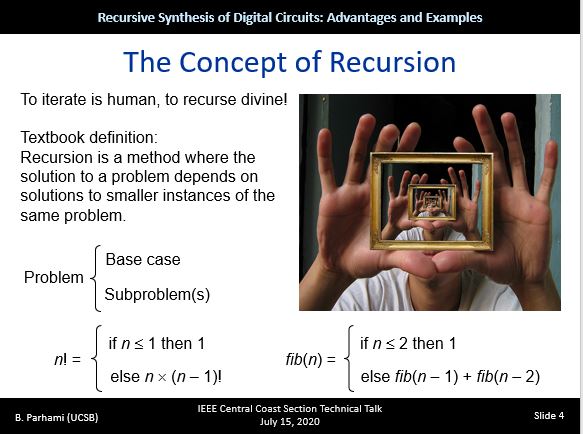
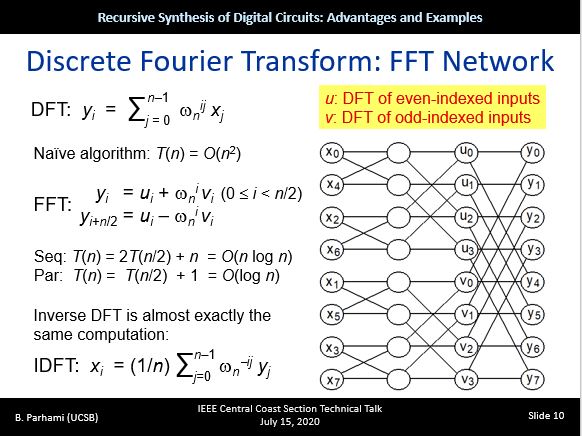
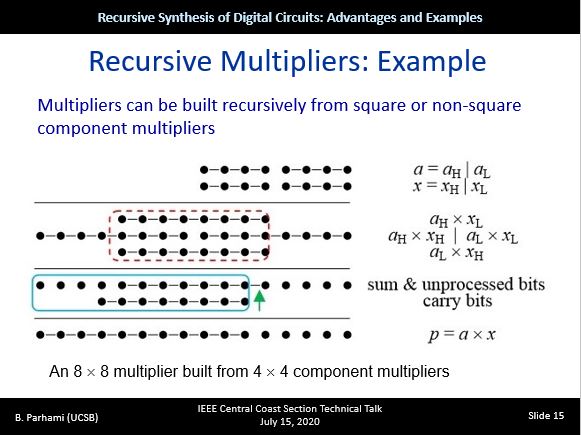
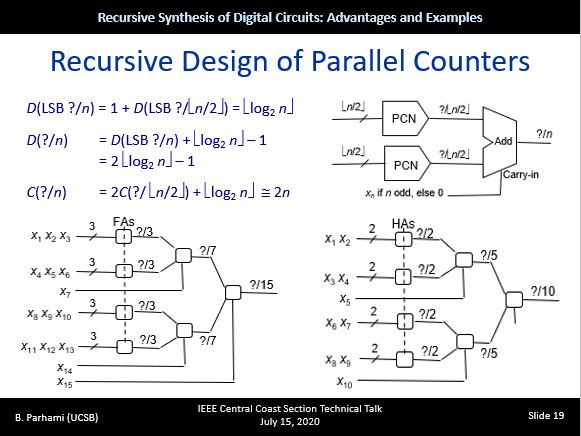
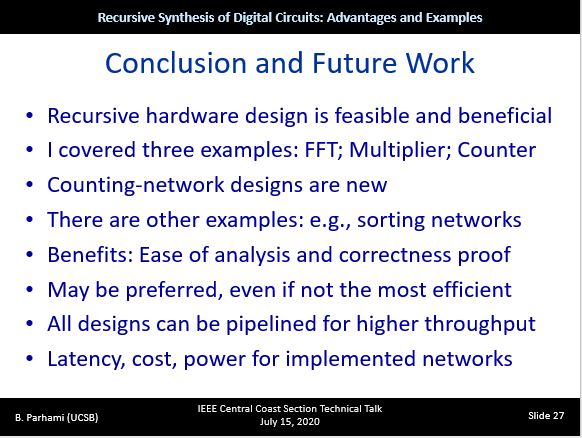
July 2020 speaker: Dr. Sumita Pennathur (postponed)
Affiliation: Mechanical Engineering Department, UCSB
Area: Bioengineering; Nanotech; Thermal science; Fluid mechanics
Postponed from the original scheduled date (Wednesday, July 15, 2020; 6:30 PM). New date TBD.
April-July 2020 alternative learning opportunities
In lieu of the talks for April and May 2020, we have put together a list of free recorded IEEE Webinars to get us through the stay-at-home and social-distancing period. IEEE Proceedings being a general-interest journal is quite suitable as a source of technical talks that would be beneficial to many members.
List of all IEEE Proceedings webinars
"Flexible Electronic Skin" (released March 2020): Linked to the October 2019 special issue
"Electricity for All" (released October 2019): Linked to the September 2019 special issue
"Machine Ethics" (released May 2019): Linked to the September 2019 special issue
"3D Imaging and Display Technologies" (released October 2017): Linked to the May 2017 special issue
IEEE Women in Engineering International Leadership Conference: Comprised of one-hour sessions throughout June 2020, the conference is free with advance registration. This site has the program details, registration links, and a library of pertinent videos. I particularly recommend the session on June 23, 2020, 1:00 PM EDT, during which director Ashley Maria will make a presentation about the documentary film "Pioneers in Skirts."
Free Virtual MATLAB Day: Thursday, June 18, 2020 (Info/Registration Link)
Session 1: "Data Analysis and Visualization with MATLAB for Beginners," 10:00-11:00 AM PDT
Session 2: "Machine Learning with MATLAB," 12:00-1:00 PM PDT
Session 3: "Deep Learning with MATLAB," 3:00-4:00 PM PDT
Session 4: "Learning MATLAB and Career Paths," 4:30-5:00 PM PDT
[P.S.: This June 3 MATLAB event may also be of interest: "Accelerating and Optimizing MATLAB Code" (Info)]
Additional learning opportunities:
Free access to IEEE Computer Society's educational courses.
IEEE CS webinar: "IT and the Fight Against COVID-19" (May 26, 2020; 6:00 PM EDT)
June 2020 speaker: Dr. Di Liang
Affiliation: Hewlett Packard Labs, HP Enterprise Systems
Title: "Photonics in High-Performance Computing"
Date/Time: Wednedsay, June 17, 2020; 6:30-8:00 PM
Venue: On-line via Zoom (details to be provided to those who register in response to IEEE invitation)
Links: Event page on IEEE CCS Web site; Speaker's LinkedIn profile
Speaker's abstract: High performance computing (HPC) is penetrating deeply in people's daily lives and playing a mission-critical role to fight this unprecedented global pandemic. Photonics can enable novel HPC architecture, unprecedented performance prowess, and more affordable capital and operation cost. As the world's #1 commercial HPC vendor, Hewlett Packard Enterprise has devoted over a decade of R&D to develop world-leading HPC systems and photonic interconnect solutions. In this talk, I will review our photonics technology roadmap and discuss our most recent fully-integrated silicon photonic platform. It is capable of providing nearly all performance metrics (energy efficiency, bandwidth, latency, cost, etc.) for conventional HPC applications, as well as emerging technologies such as neuromorphic computing.
[P.S.: Virtual pizzas and beverages provided courtesy of IEEE Central Coast Section; see the last image!]
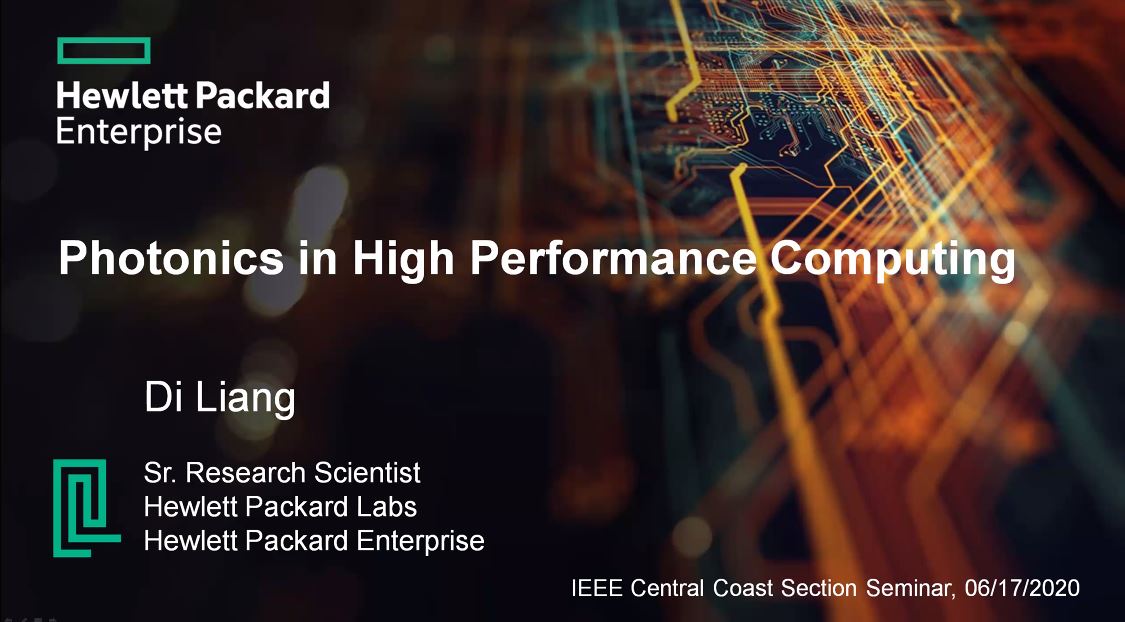
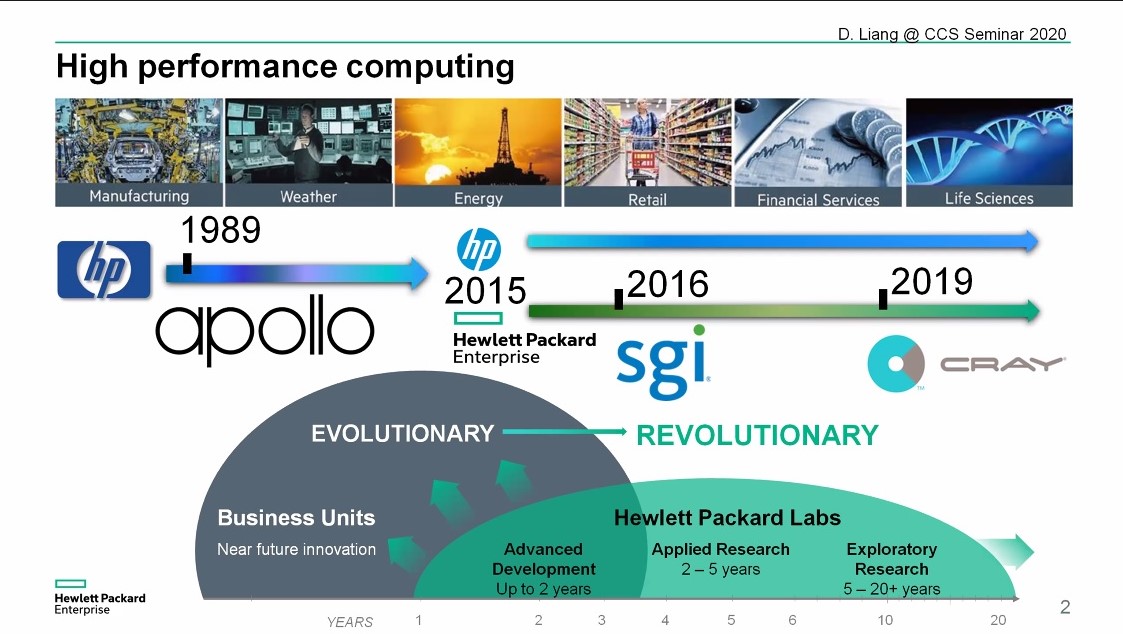
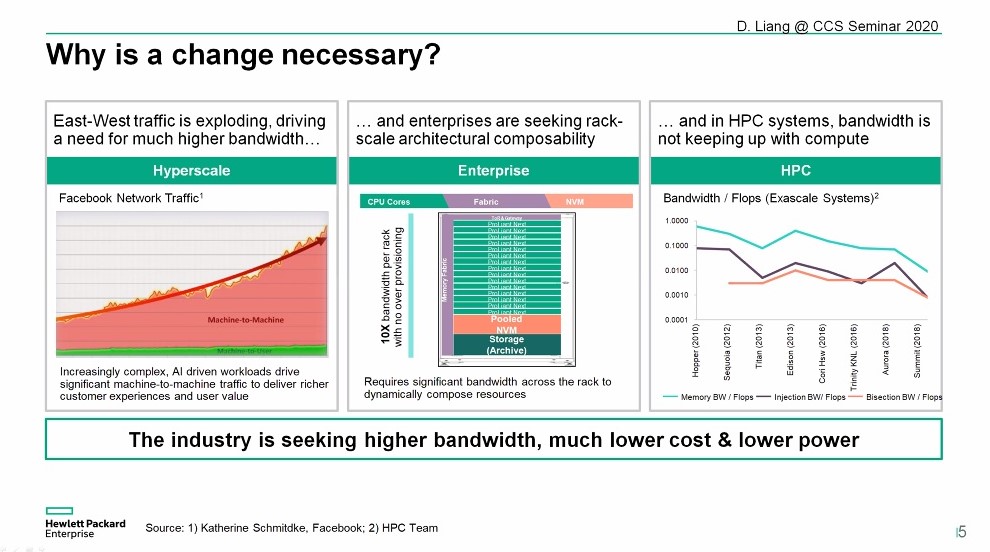
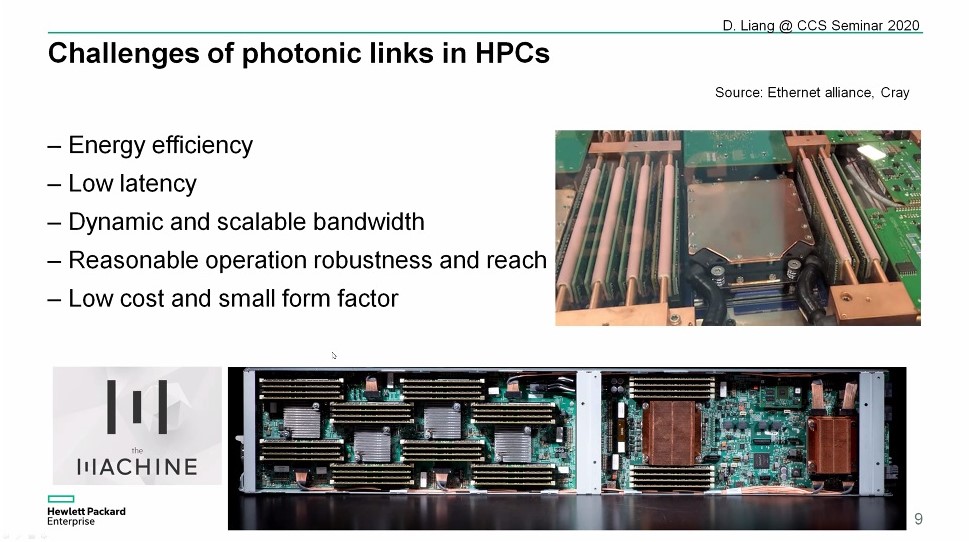
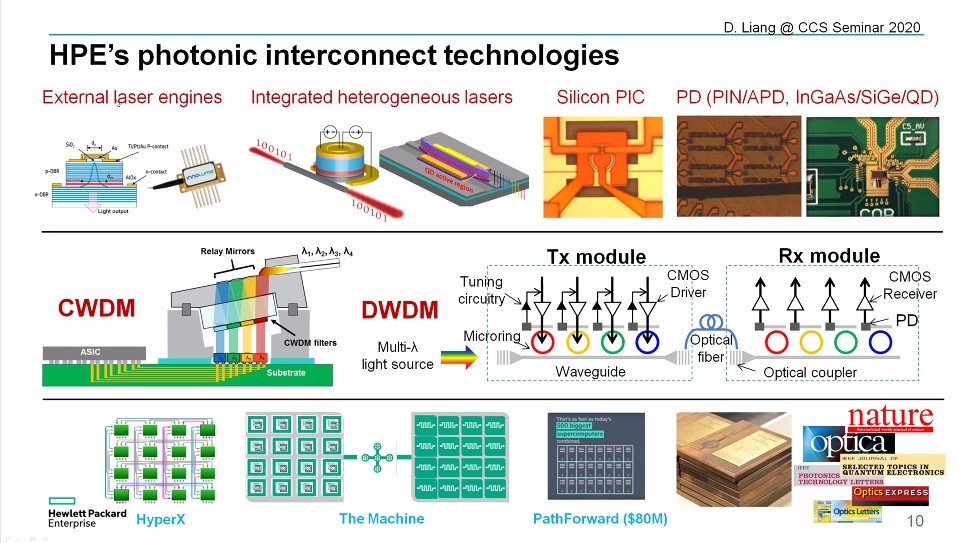
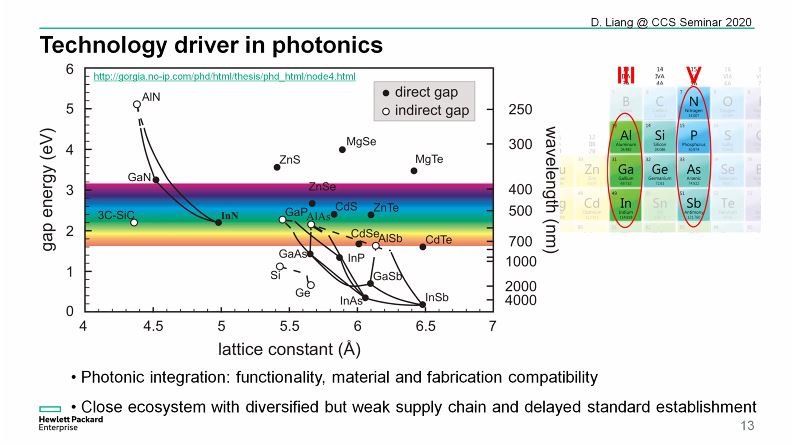
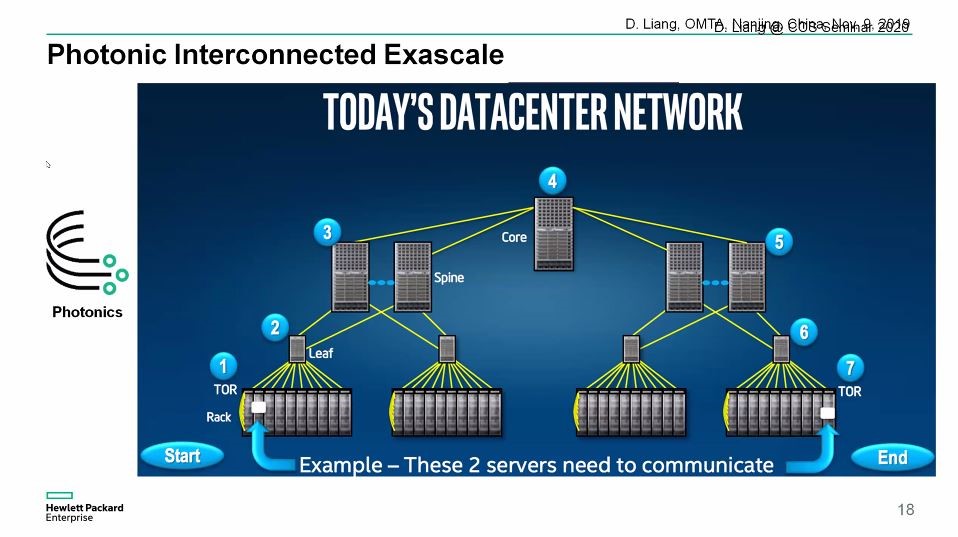
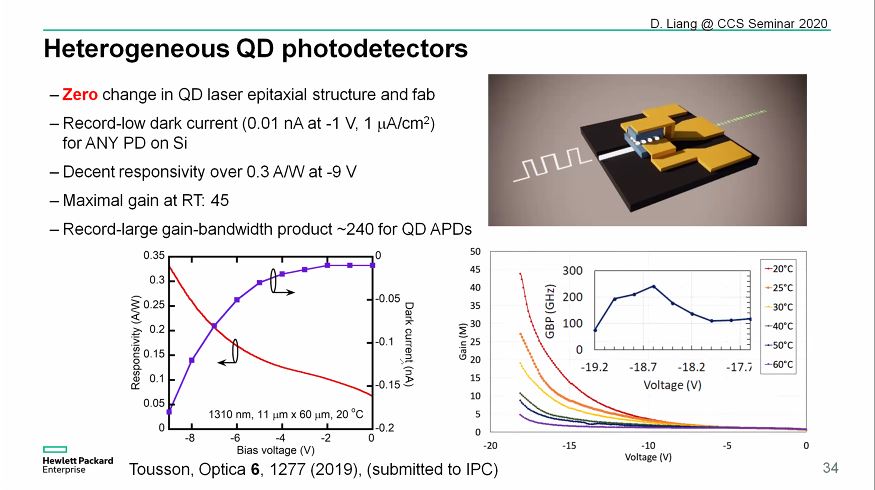
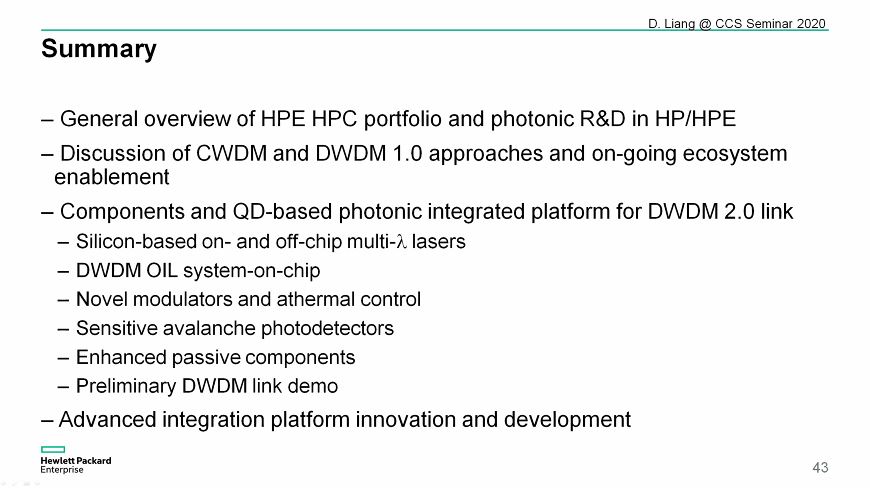
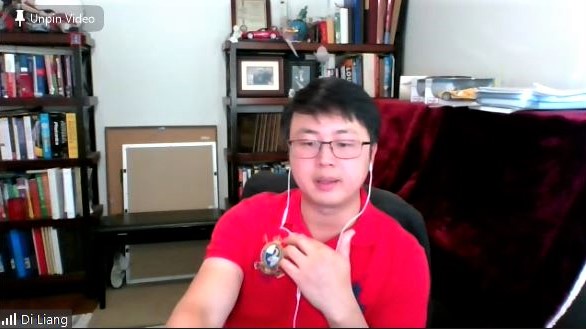
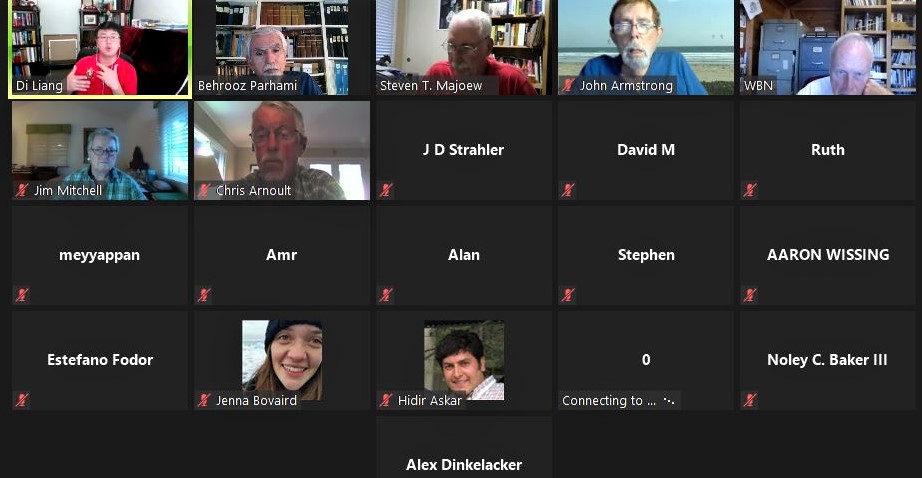

May 2020 speaker: Dr. Ramtin Pedarsani (postponed)
Affiliation: Electrical and Computer Engineering Department, UCSB
Title: "Self-Driving Cars"
Postponed from the original scheduled date (Wednesday, May 20, 2020; 6:30 PM). New date TBD.
April 2020 speaker: Dr. Chandra Krintz (postponed)
Affiliation: Computer Science Department, UCSB
Title: "Advancing Agriculture and Conservation Science with the Cloud and Big Data Analytics"
Postponed from the original scheduled date (Wednesday, April 15, 2020; 6:30 PM). New date TBD.
March 2020 speaker: Dr. Aycan Hacioglu
Affiliation: Customer Success Engineer, MathWorksTitle: "Data Analysis and Visualization with MATLAB for Beginners"
Date/Time: Wednedsay, March 18, 2020; 5:30-8:00 PM
Venue: Due to the coronavirus threat, this event was moved on-line (Webex registration link)
[Your registration approval e-mail will have the requisite info and a button for joining the meeting]
Links: Event page on IEEE CCS Web site; PDF course slides (Username = customer; Password = MathWorks); Recorded webinars; Upcoming webinars; MATLAB Onramp; MATLAB trial license
This 2.5-hour course was presented remotely, via Webex, by Dr. Aycan Hacioglu (Customer Success Engineer, MathWorks). Mathworks Application Engineers Dr. Bo Luan and Dr. Sharon Kim were also in attendance, as were 20 IEEE Central Coast Section members taking the course.
MATLAB is a programming environment for algorithm development, data analysis, visualization, and numerical computation. With MATLAB, one can solve technical computing problems faster than with traditional programming languages, such as C, C++, and Fortran.
During the first 75 minutes of this introductory course, Dr. Hacioglu provided an overview of MATLAB and its powerful statistical analysis and visualization capabilities, demonstrated how to acquire, analyze, and visualize data, briefly discussed desktop tools for editing and debugging code, and showed how to publish the results.
Highlights included:
- Accessing data from files, spreadsheets, and other sources
- Performing statistical analysis, curve and surface fitting routines
- Developing algorithms and applications to automate one's workflow
- Generating reports in HTML and other file formats to share one's work
A one-hour hands-on session, involving MATLAB Onramp training, followed. The final 15 minutes of the course consisted of a short competition, with winners getting unspecified prizes, to be sent to them via e-mail.
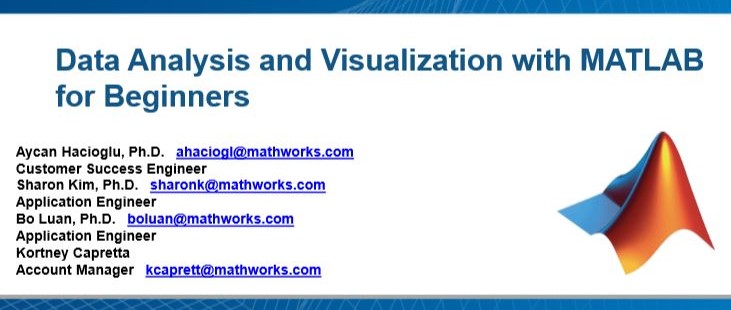
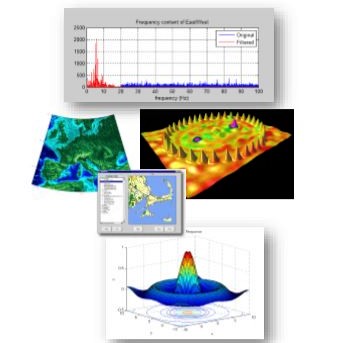
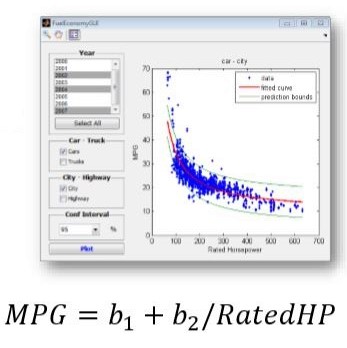
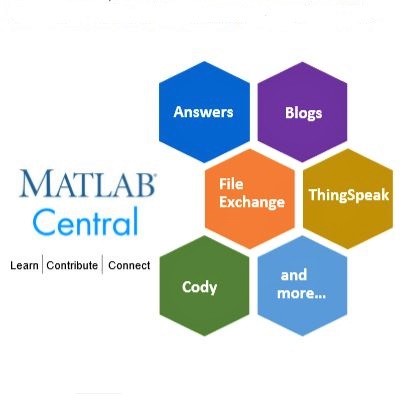
February 2020 speaker: Dr. Jerry Gibson
Affiliation: UCSB Department of Electrical and Computer EngineeringTitle: "Compression of Everything"
Date/Time: Wednedsay, February 19, 2020; 6:00 PM (food, beverages), 6:30 PM (talk)
Venue: Rusty's Pizza (large meeting room), 5934 Calle Real, Goleta, CA 93117
Links: Event page on IEEE CCS Web site; Speaker's home page; Speaker's PDF slides
The speaker for our February 19, 2020, technical talk, "Compression of Everything," was Dr. Jerry Gibson, UCSB Distinguished Professor of Electrical and Computer Engineering, Fellow of IEEE, and author of multiple text/reference books (PhD, SMU, 1973; MS, SMU, 1971; BS, UT Austin, 1969). Dr. Gibson's other honors and awards, details of which can be found on the IEEE CCS event page and speaker's home page (linked above) include service on editorial boards of two IEEE Transactions, Distinguished Lectureship for IEEE Communications Society, and multiple technical-achievement and best-paper awards.
As the talk's title suggests, compression is widely used. Our cell phones and other electronic devices contain sophisticated, continually-improving compression and decompression facilities that allow us to store and transmit ever-larger volumes of data. As storage capacities, processing power, and communication bandwidth continue their exponential growths, with multi-terabyte personal storage devices and the dawn of 5G communication, our appetite for more photos, higher-quality videos, and all things digital grows correspondingly, making compression as essential today as it was in the days of 2G and its predecssors.
Compression, defined as the representation of a signal in digital form with as few bits as possible while retaining the quality required for the given application, is largely hidden behind the physical and network distribution layers. The technologies used for voice, audio, still images, and video all differ but broadly consist of time or frequency domain decompositions, quantization, and lossless coding. Dr. Gibson began his talk by establishing the need for compression and them proceeded to provide details of the surprisingly complicated compression methods, with particular emphasis on the signal processing required. Developing compression applications for biological signals such as EEG, ECG, and EMG were also discussed.
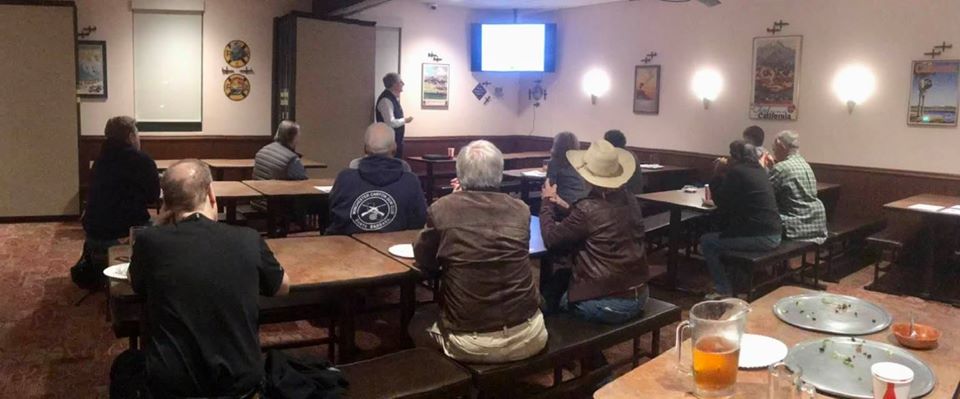
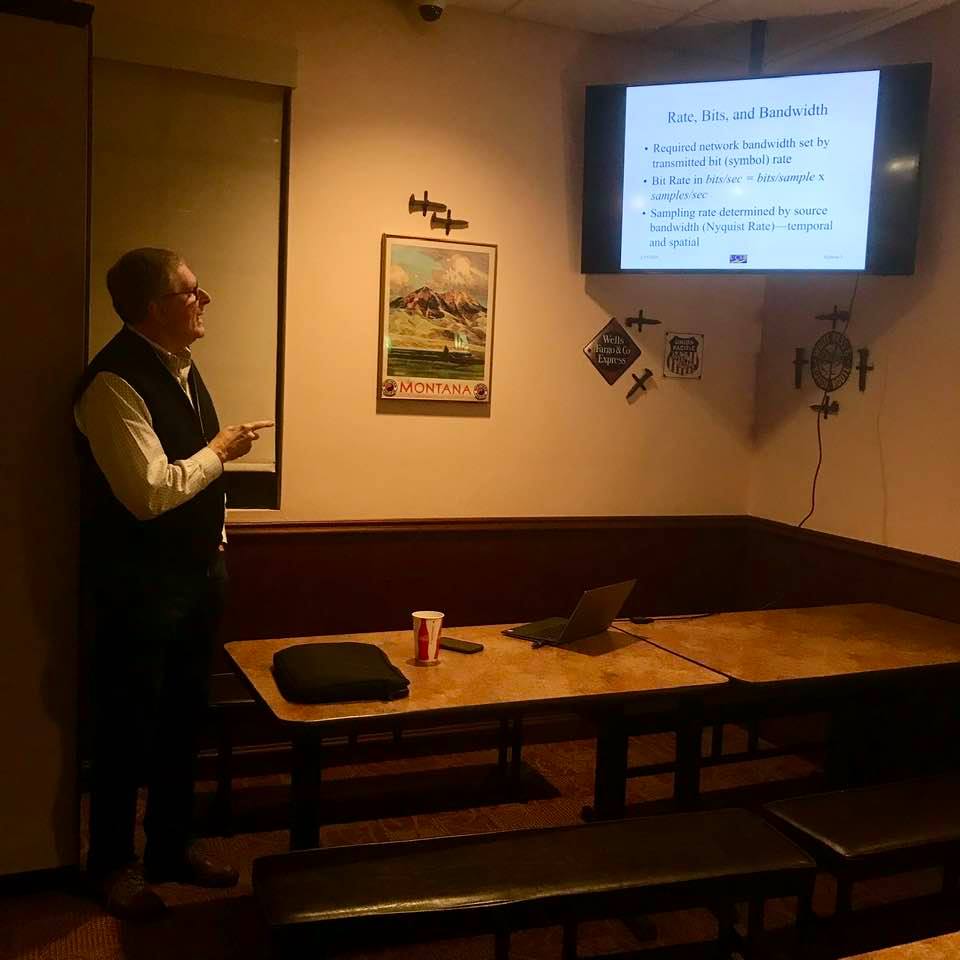
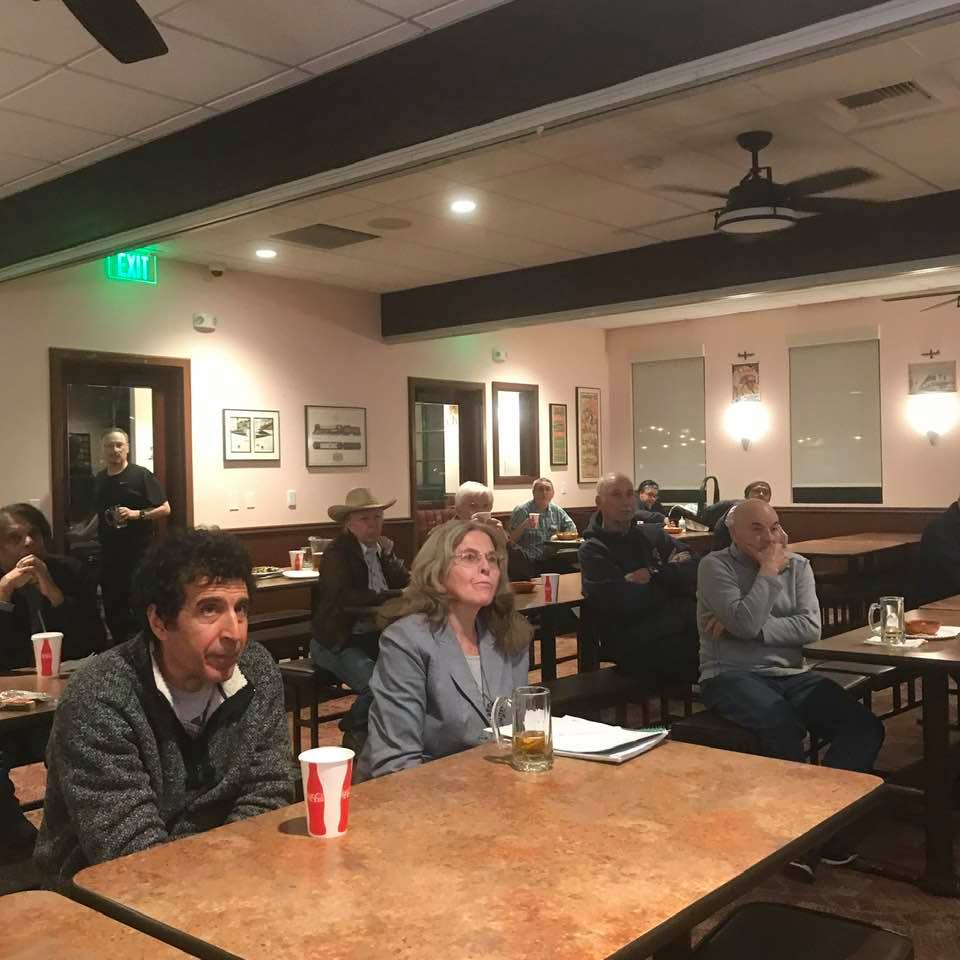
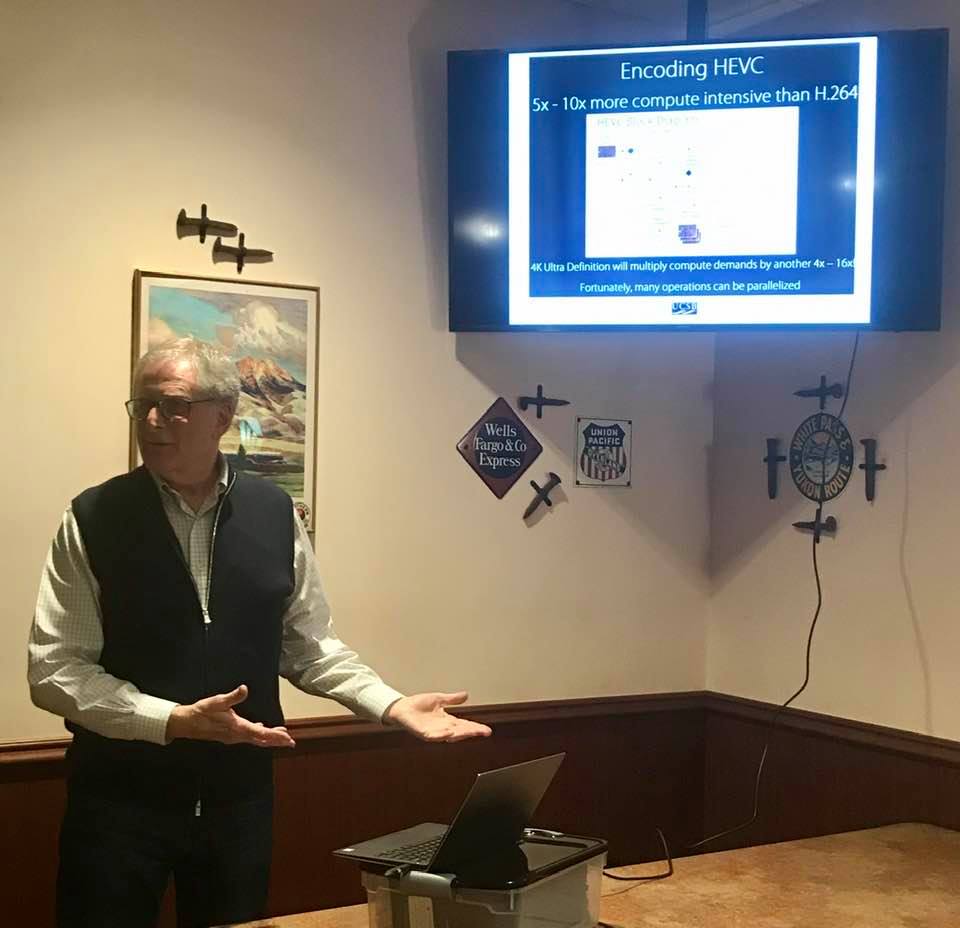
February 2020 special Monday event
Presenter: Nicole Lvoff, Goleta Valley Public LibraryTitle: "3D-Printing Demonstration"
Date/Time: Monday, February 03, 2020; 5:30 PM
Venue: Goleta Valley Public Library (multipurpose room), 500 N. Fairview Ave., Goleta, CA 93117
Links: Event page on IEEE CCS Web site; Facebook post; Tweet
A 3D-printer introduction and demo session was held this evening at Goleta Valley Public Library, where two Dagoma 3D-printers are available for educational activities and to print patrons' orders at a cost of $1.00 per hour of printing time (a small object may take 2-3 hours to print). The Library's printers use plastic-corn filaments (Polyplus, Polymax) of various colors.
Nicole Lvoff, one of the librarians familiar with the 3D-printer workings, gave the 15 attendees an overview, helped us navigate Web sites where one can find/create interesting objects to print, and told us how to submit our orders to library staff. Patrons can go to Thingiverse.com, search/browse for various interesting objects, download the object's digital file, and e-mail the file to Library staff at goletavalleylibrary@cityofgoleta.org. Alternatively, a number of services can be used to create custom designs. Here are the Library's recommended user-friendly Web sites:
[Cults 3D]
[SketchUp]
[Tinkercad]
[Blender]
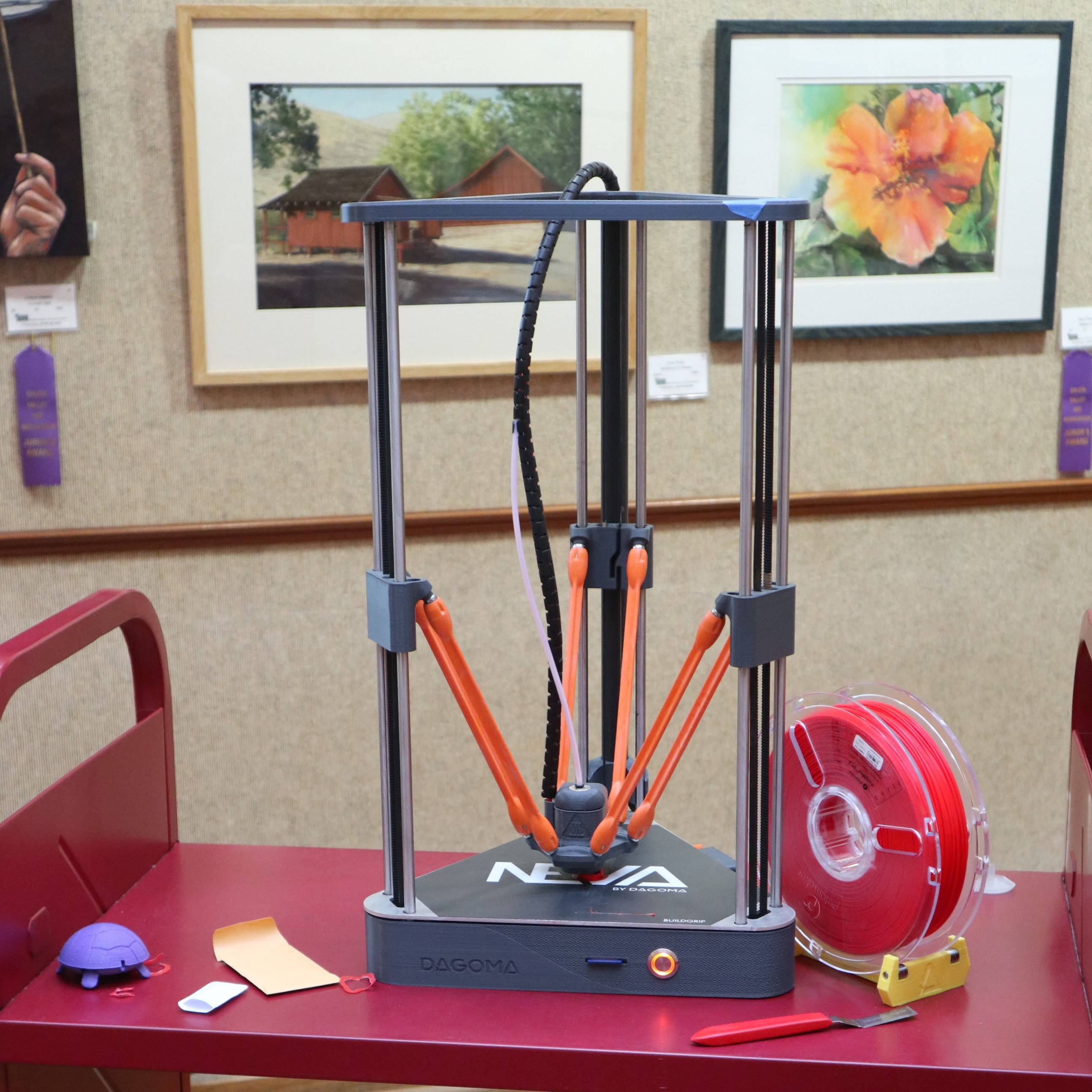
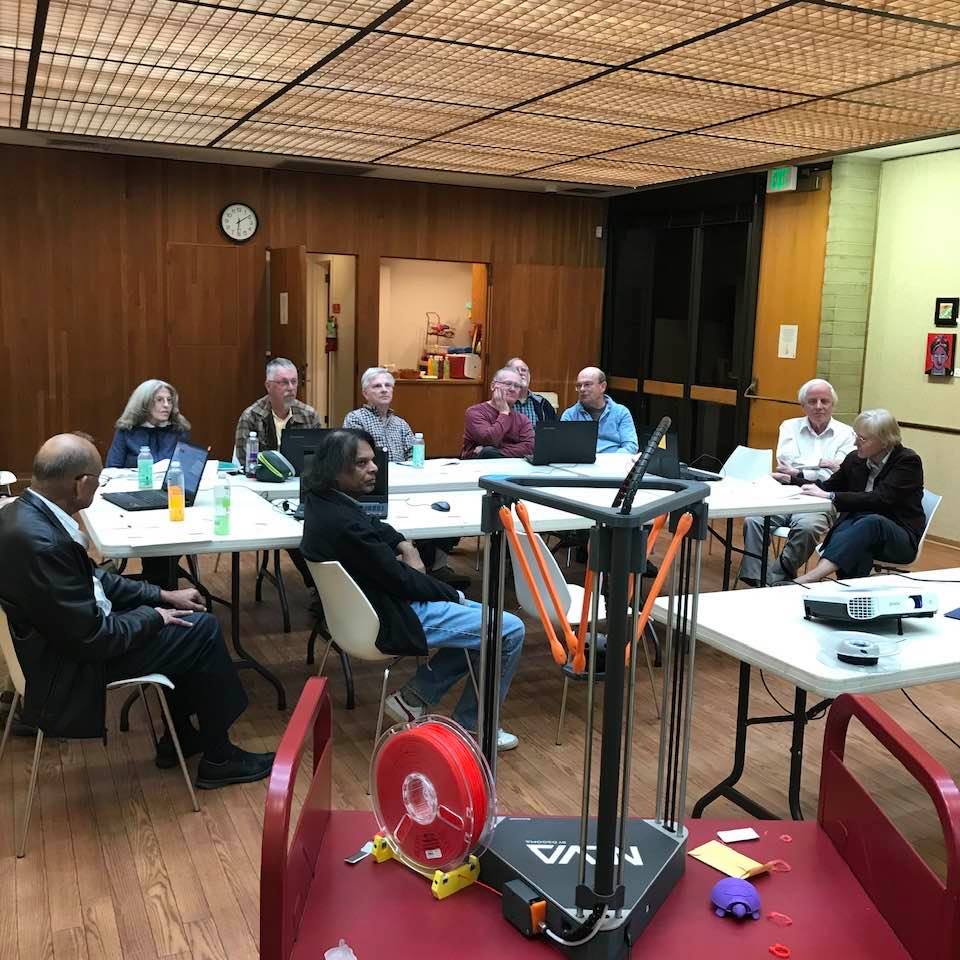
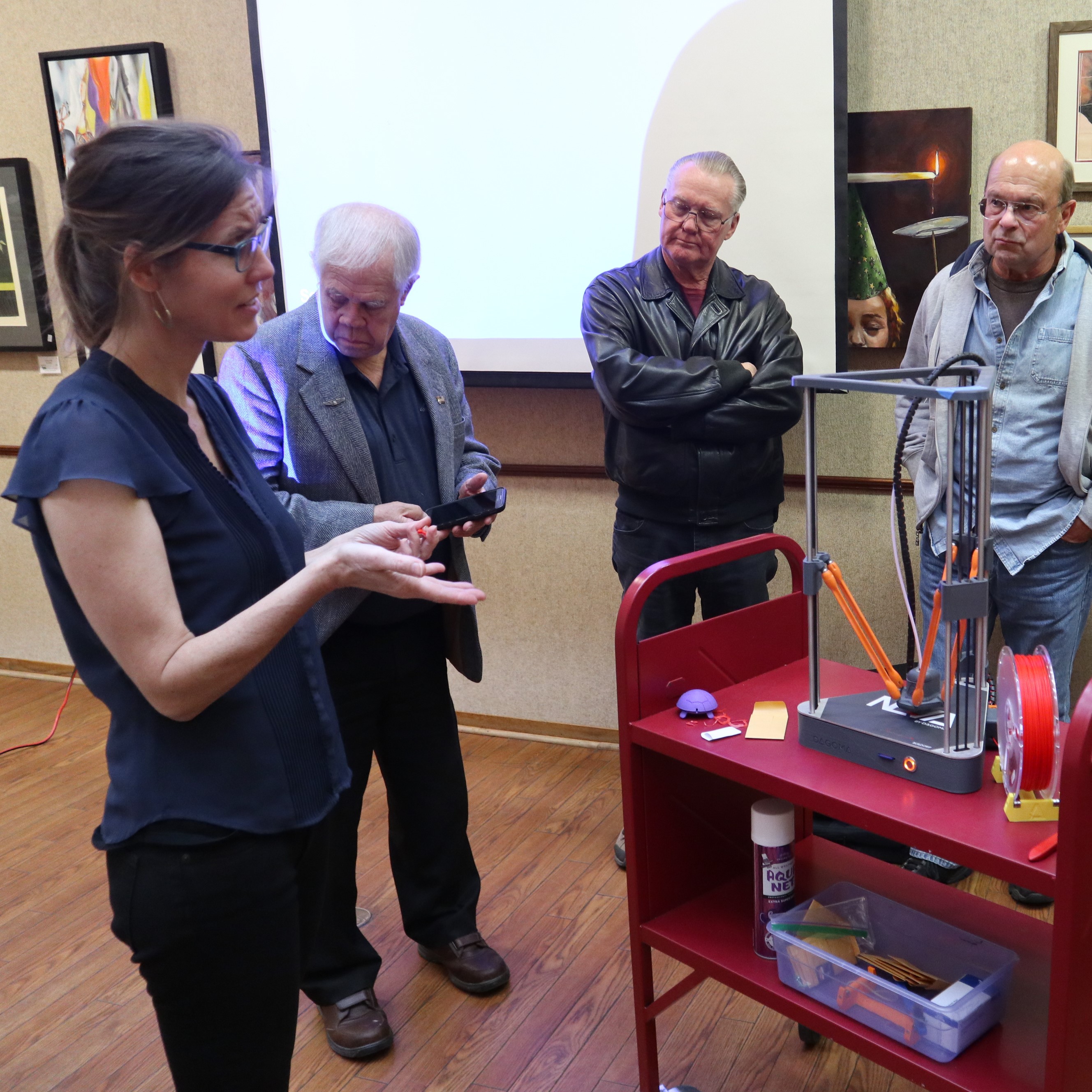
January 2020 speaker: Dr. Payam Heydari
Affiliation: UC Irvine (IEEE Distinguished Microwave Lecturer 2019-2021)Title: "Shattering Fundamental Design Barriers of End-to-End Ultrahigh Data-Rate Transceivers: Direct Modulation in RF Domain"
Date/Time: Wednedsay, January 15, 2020; 6:00 PM (food, beverages), 6:30 PM (talk)
Venue: Rusty's Pizza (large meeting room), 5934 Calle Real, Goleta, CA 93117
Links: Event page on IEEE CCS Web site; Speaker's slides; Speaker's home page; DML speaker page
The speaker for our January 15, 2020, technical talk, "Shattering Fundamental Design Barriers of End-to-End Ultrahigh Data-Rate Transceivers: Direct Modulation in RF Domain," was Dr. Payam Heydari, Professor of Electrical Engineering at University of California, Irvine, Fellow of IEEE, and Distinguished Lecturer for IEEE Microwave Society, DML 2019-2021 (PhD, USC, 2001; BS & MS, Sharif University of Technology, Tehran, 1992 & 1995). Dr. Heydari's other honors and awards can be found on the IEEE CCS event page and DML speaker page, both linked above.
All-digital RF transceivers are reaching their limits that make going beyond 10 Gbps incredibly challenging in silicon technologies. Dr. Heydari elaborated on the nature of the challenges and argued that realizing modulation and demodulation schemes directly in RF domain can take us to data rates of 100 Gbps and beyond. Dr. Heydari then discussed transmitter/receiver chip prototypes developed by his research group to achieve extremely power-efficient 15+ Gbps data rates.

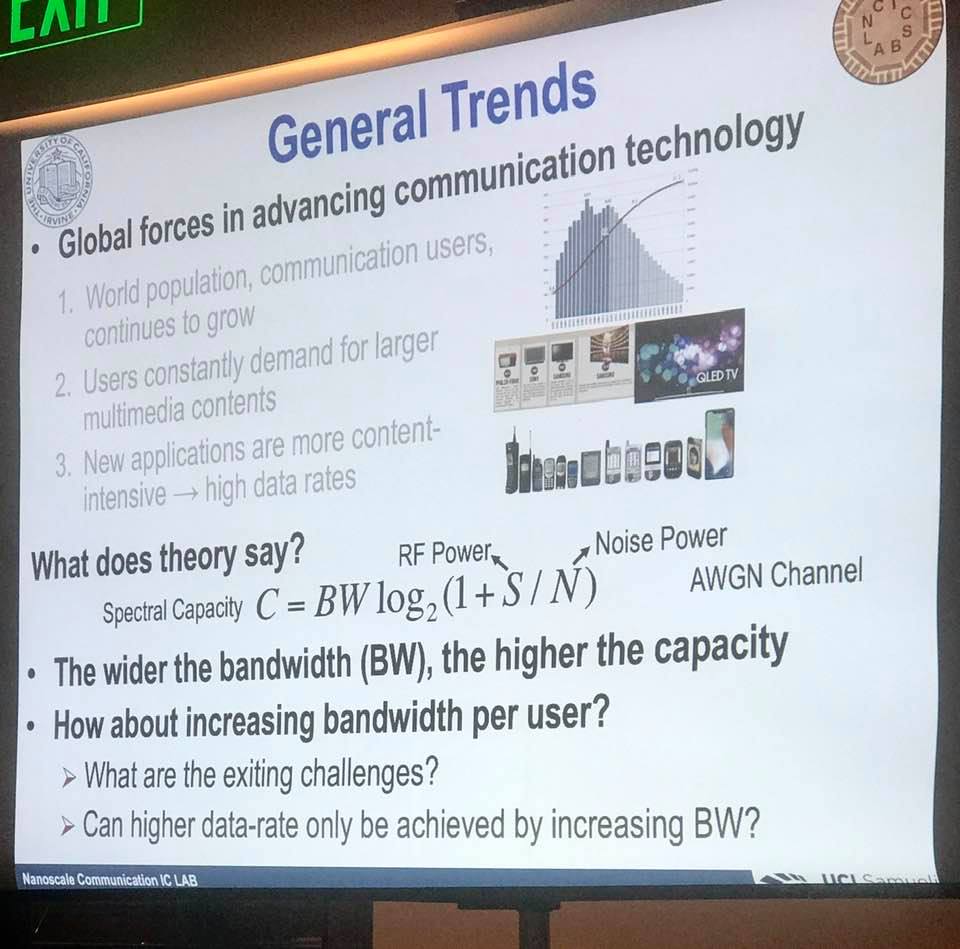
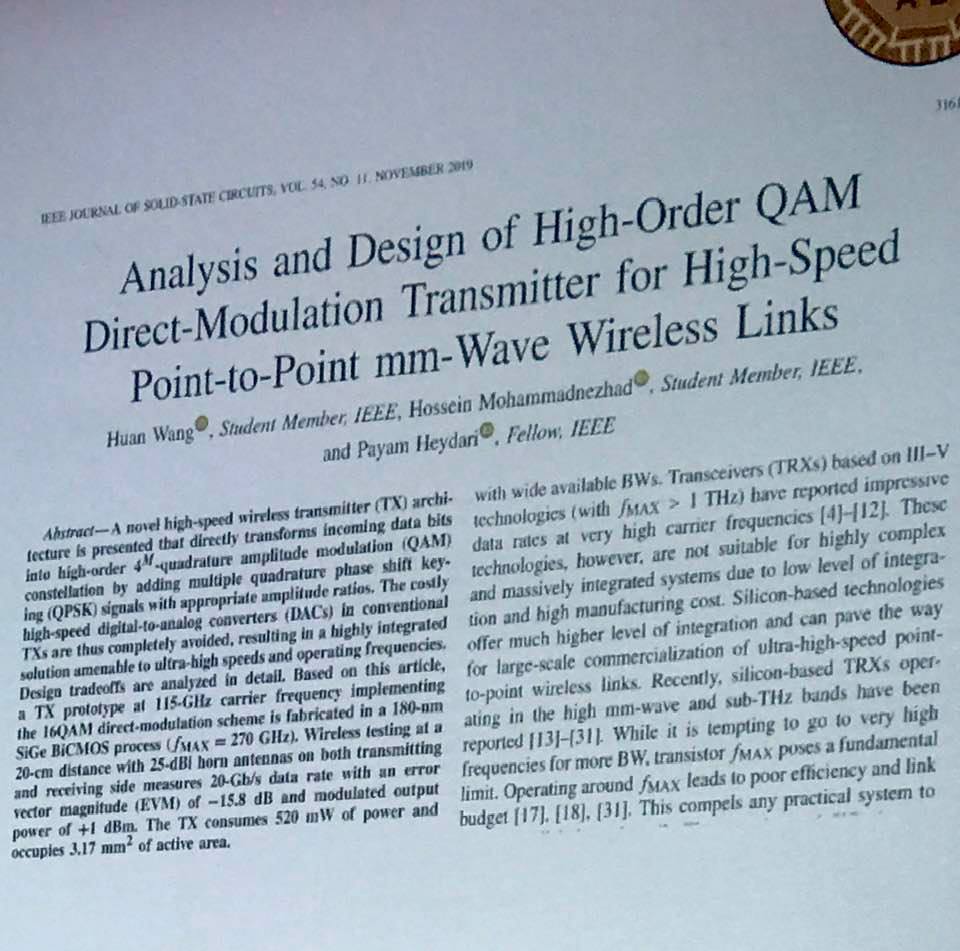
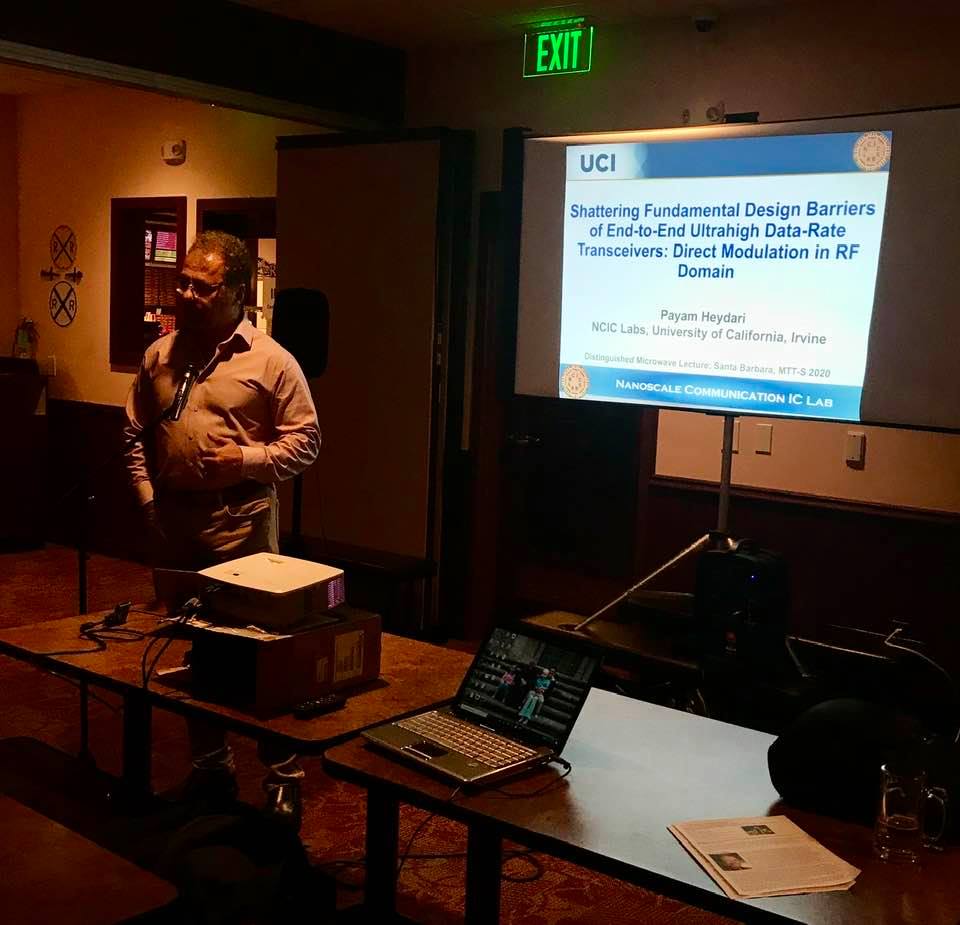
December 2019 speaker: Dennis Horwitz
Affiliation: Co-founder and VP Sales & Marketing, Micronor Inc.Title: "Awesome Photons—A Fiber Optic Technology Update"
Date/Time: Wednedsay, December 18, 2019; 6:00 PM (appetizers), 6:30 PM (banquet dinner), 7:00 PM (talk)
Venue: Mulligan's Cafe & Bar at Santa Barbara Golf Course (3500 McCaw Ave., SB, CA 93105)
Links: Event page on IEEE CCS Web site; Speaker's slides; Company Web site
[Tonight's IEEE Central Coast Section technical meeting had ASME Channel Islands Chapter as a co-sponsor]
In a talk held at Mulligan's Cafe, Santa Barbara Golf Club, and attended by 36 IEEE/ASME members & guests, Mr. Dennis Horwitz (Co-founder and VP Sales & Marketing, Micronor Inc.) spoke under the title "Awesome Photons—A Fiber Optic Technology Update." The gathering doubled as CCS Section's holiday banquet, where end-of-year award certificates were given out by the Section Chair and small gifts were presented to several attendees via random drawings.
Fiber optics has revolutionized the world of communications since its commercial inception nearly 4 decades ago. The technology is about more than pushing data over long distances at bandwidth many thousands of times greater than possible with copper wires. It has been used to create unique sensors and is being applied in manufacturing, energy, aerospace, transportation, medicine, infrastrucure, consumer goods, and art. The cost of applying the technology is still problematic in some cases, but that may change over time. This entertaining and informative talk included an explanation of how fiber optics works and an overview of the technology's current status. Many example applications were cited and described.

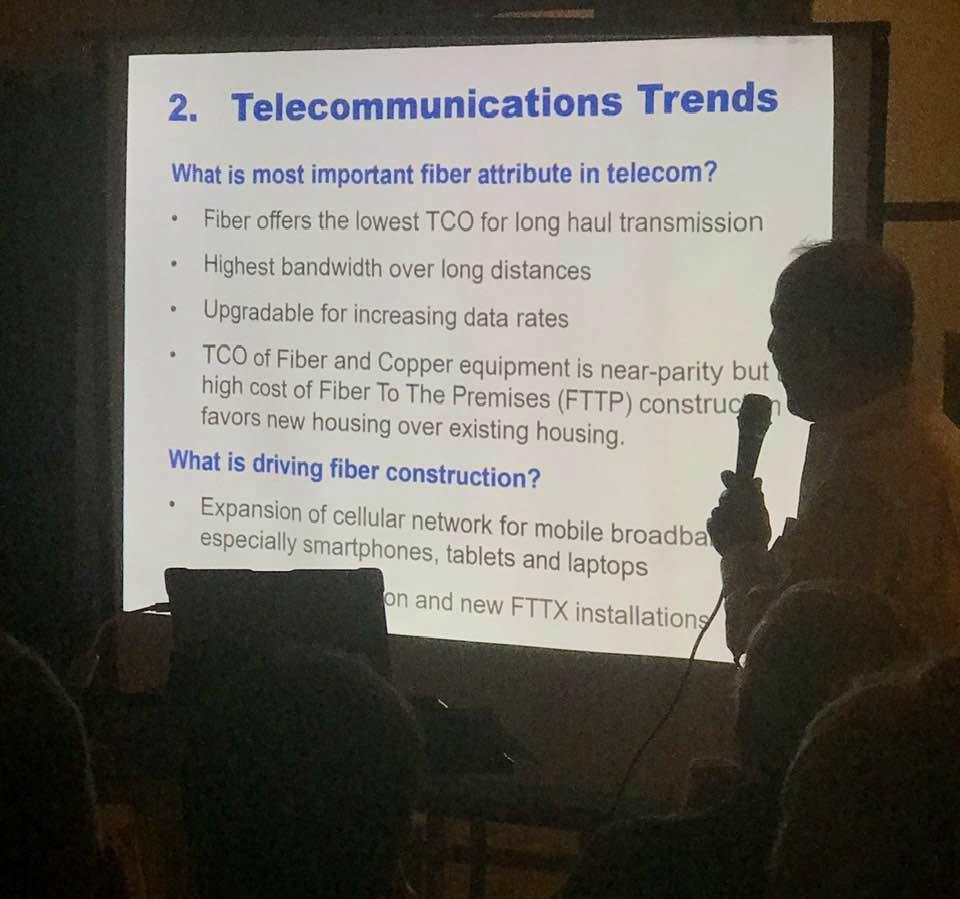
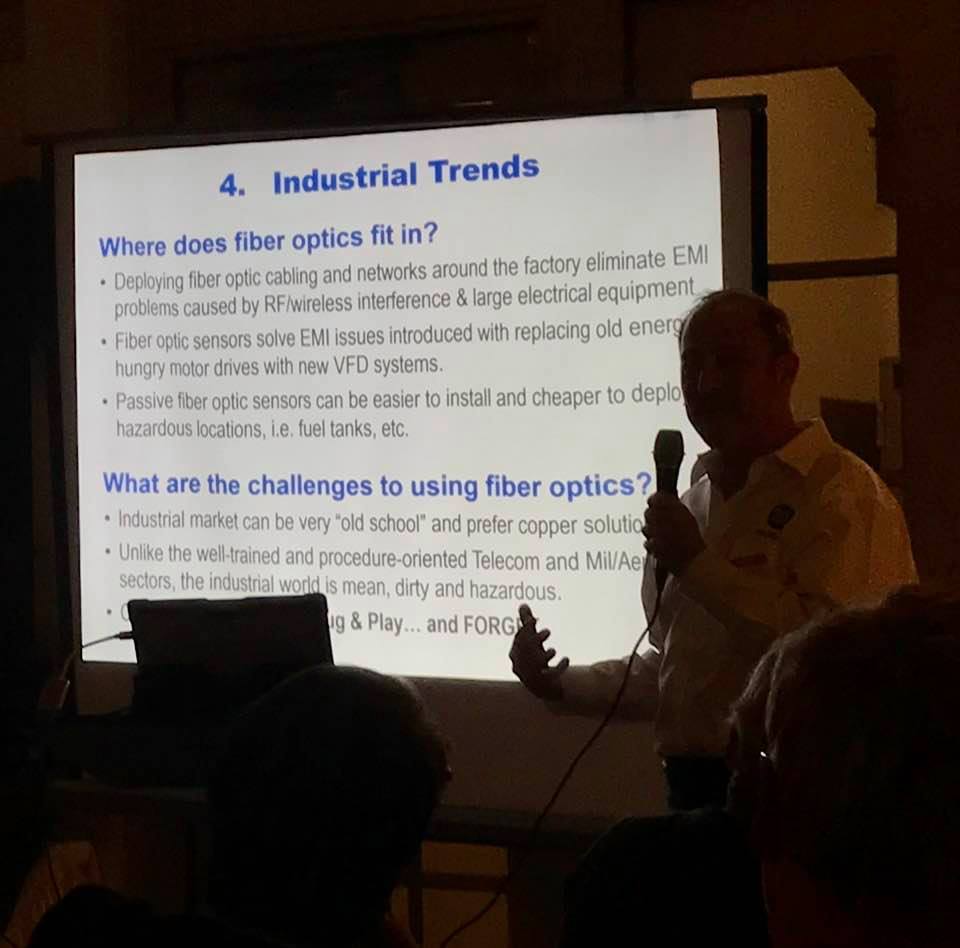
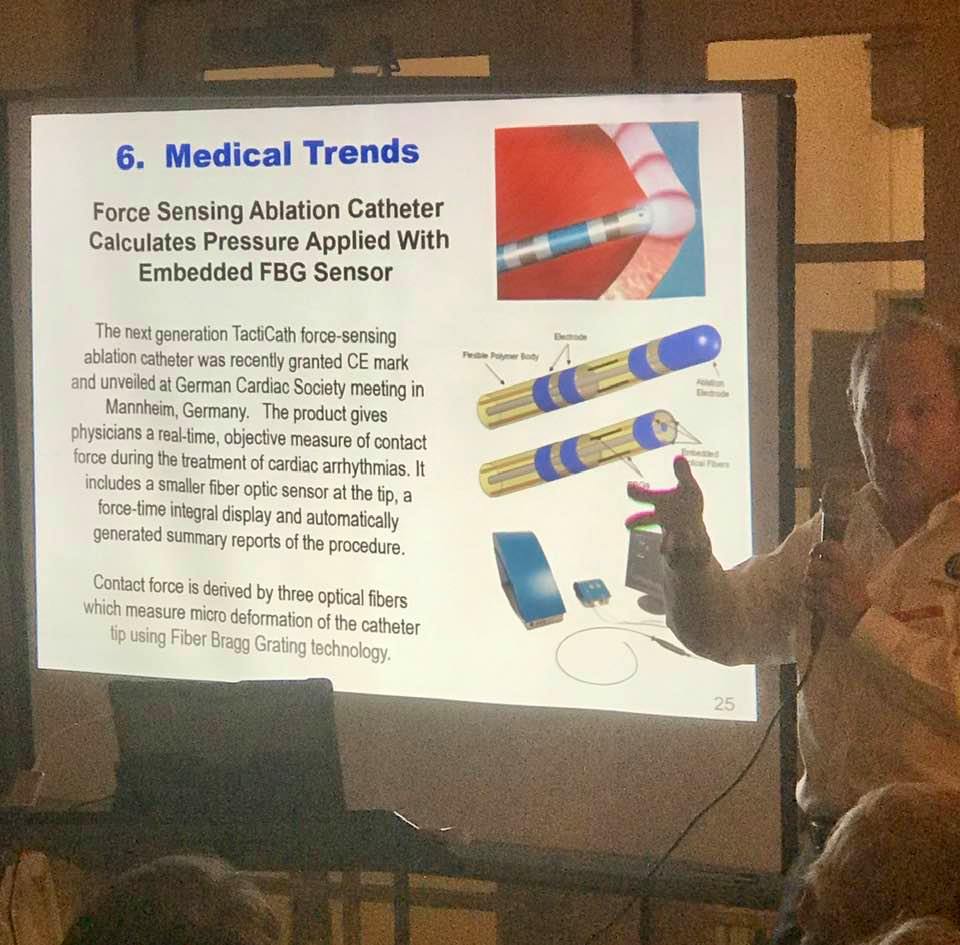
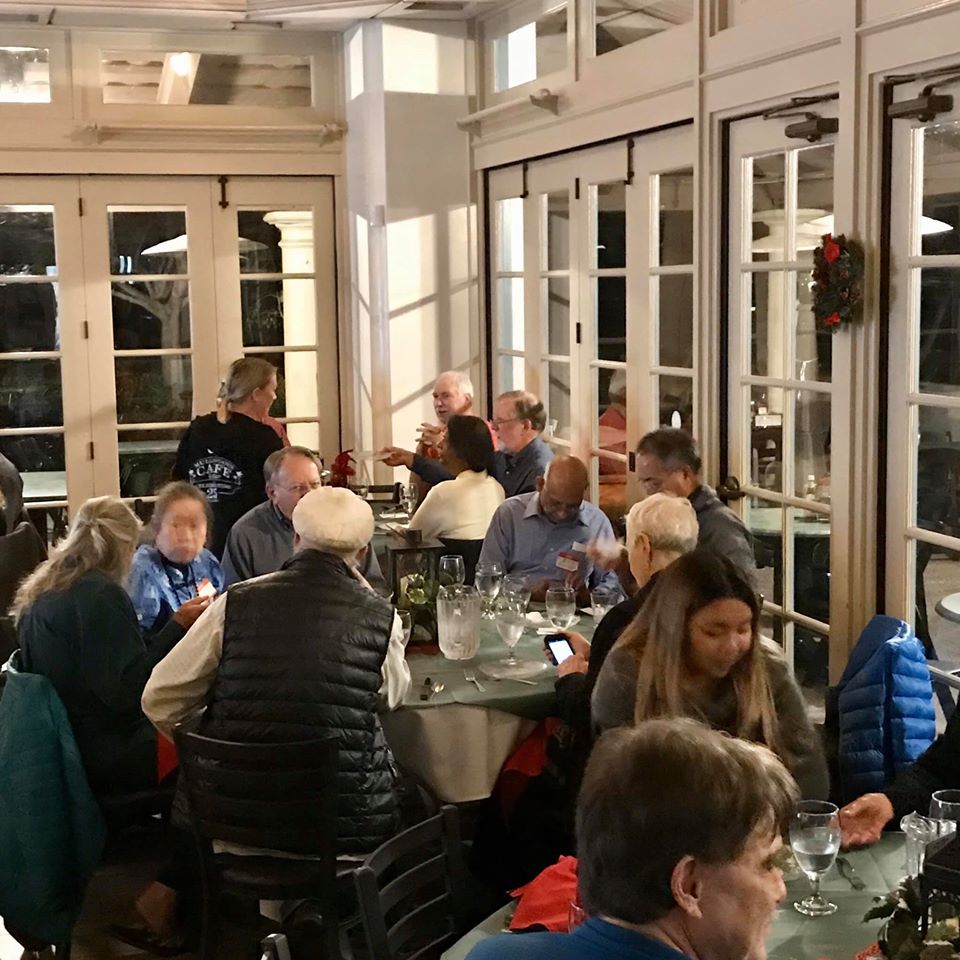
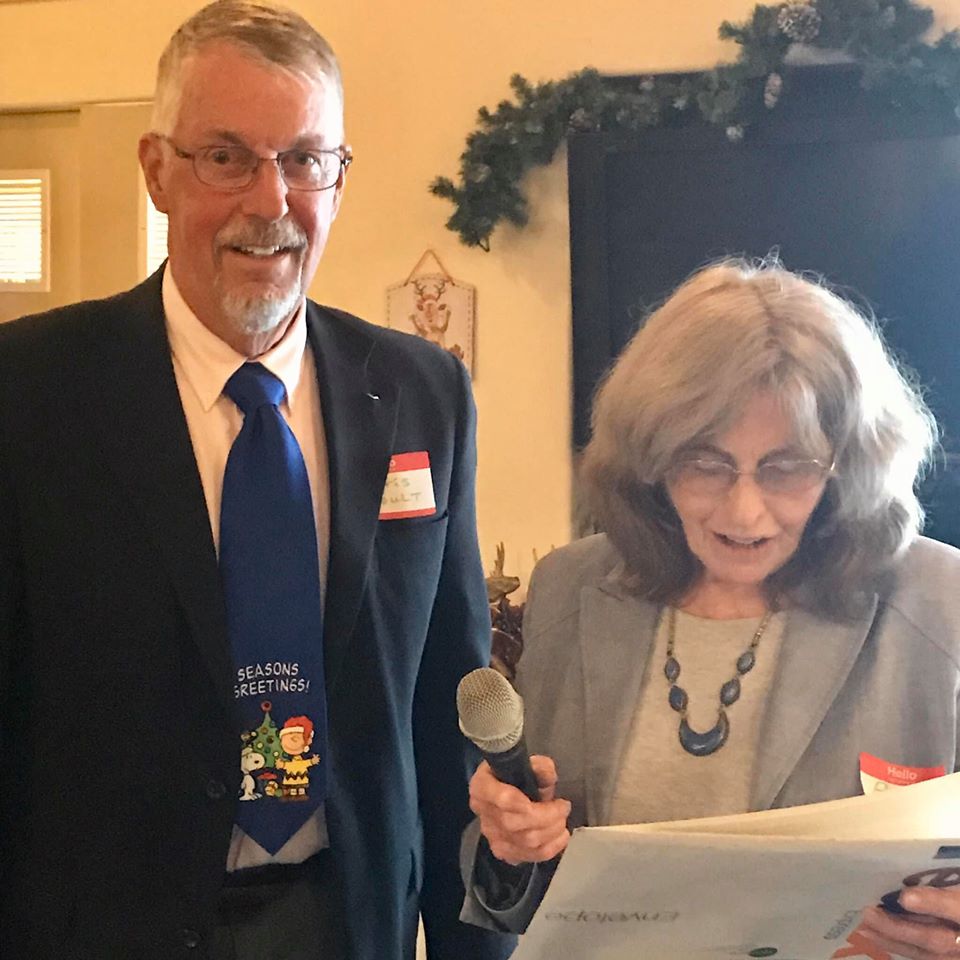
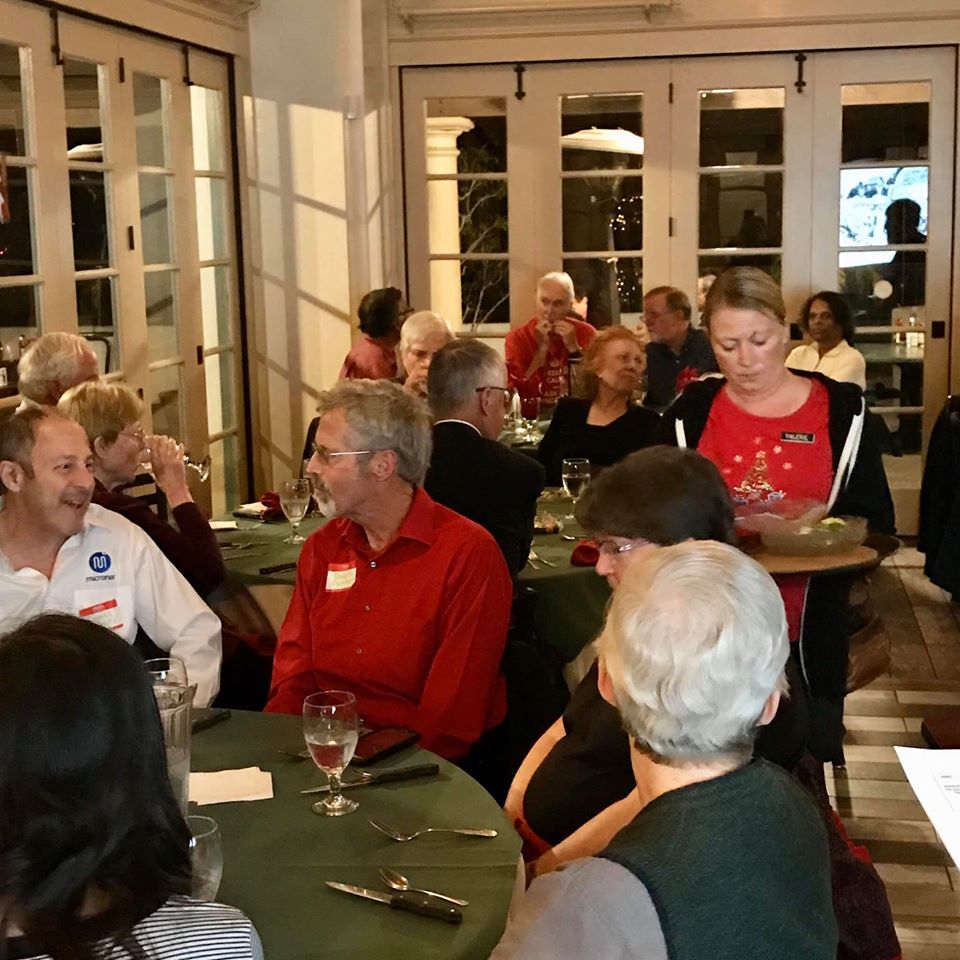
November 2019 speaker: Dr. Roger Helkey
Substitute for Dr. John BowersAffiliation: Assoc. Director, UCSB Institue for Energy Efficiency; West-Coast Assoc. Director, AIM Photonics
Title: "Using Photonics to Make More Energy-Efficient Data Centers & Communication"
Date/Time: Wednedsay, November 20, 2019; 6:00 PM (food, beverages), 6:30 PM (talk)
Venue: Rusty's Pizza (large meeting room), 5934 Calle Real, Goleta, CA 93117
Links: Event page on IEEE CCS Web site; Speaker's slides; Speaker's home page
In a sparsely-attended talk (due to glitches in IEEE's e-mail notification and reminder system), Dr. Roger Helkey (Assoc. Director of UCSB Center for Energy Efficiency, and West-Coast Assoc. Director of AIM Photonics) spoke under the title "Using Photonics to Make More Energy Efficient Data Centers & Communication."
Advantages of photonics are twofold: (1) Increasing the interconnect bandwidth density, and (2) Reducing energy consumption in communication, which is emerging as a bigger limitation than the energy used for computation within logic circuits. Without reducing the energy used per communicated bit, the exponential growth in data usage, which drives our information society, would not be sustainable. The use of photonics brings with it the promise of communication over distances from 1 mm to 1 km with the same energy (20 fJ/bit) and simplicity as local electrical wires on a chip.
A focus of research by Dr. Helkey and his co-workers is on using quantum-dot lasers and integration on silicon for low-threshold, high-efficiency sources, capability for operation at higher temperatures, isolator-free implementation, and superior mode-locking.
This talk ties in nicely with our December 18, 2019, talk by Dennis Horwitz, entitled "Awesome Photons—A Fiber Optic Technology Update." Announcements for the latter talk will be coming shortly.

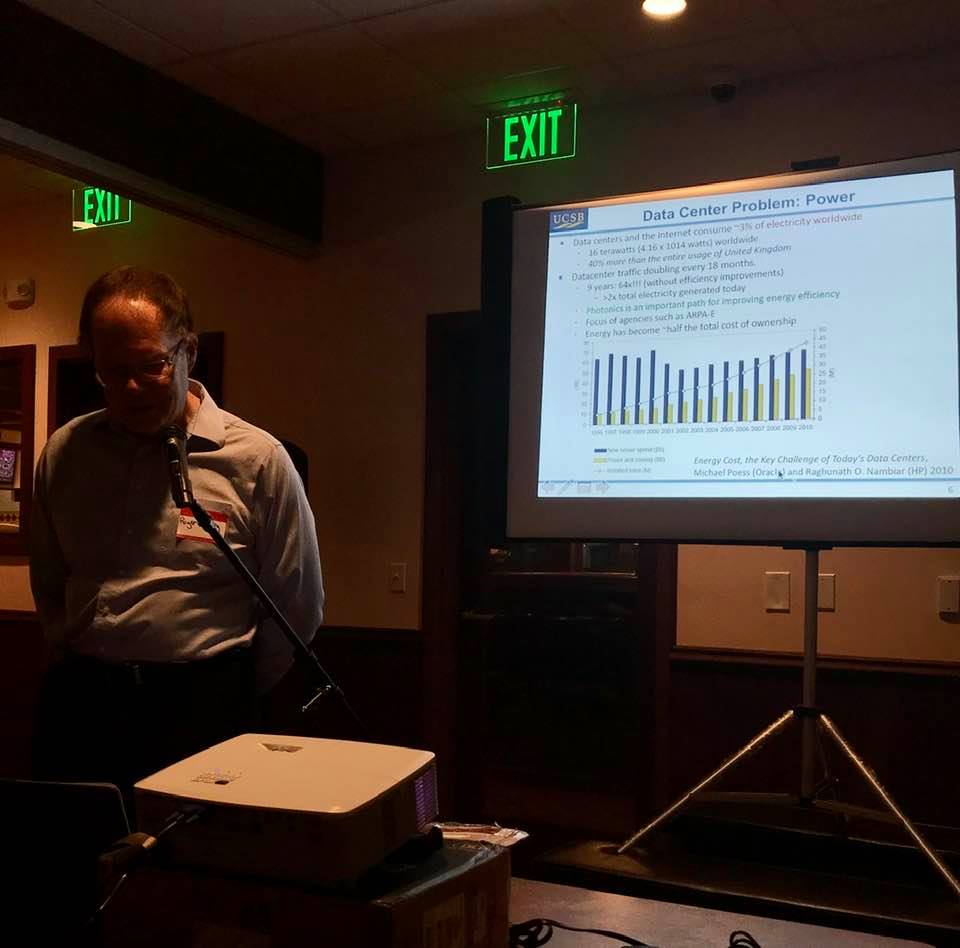
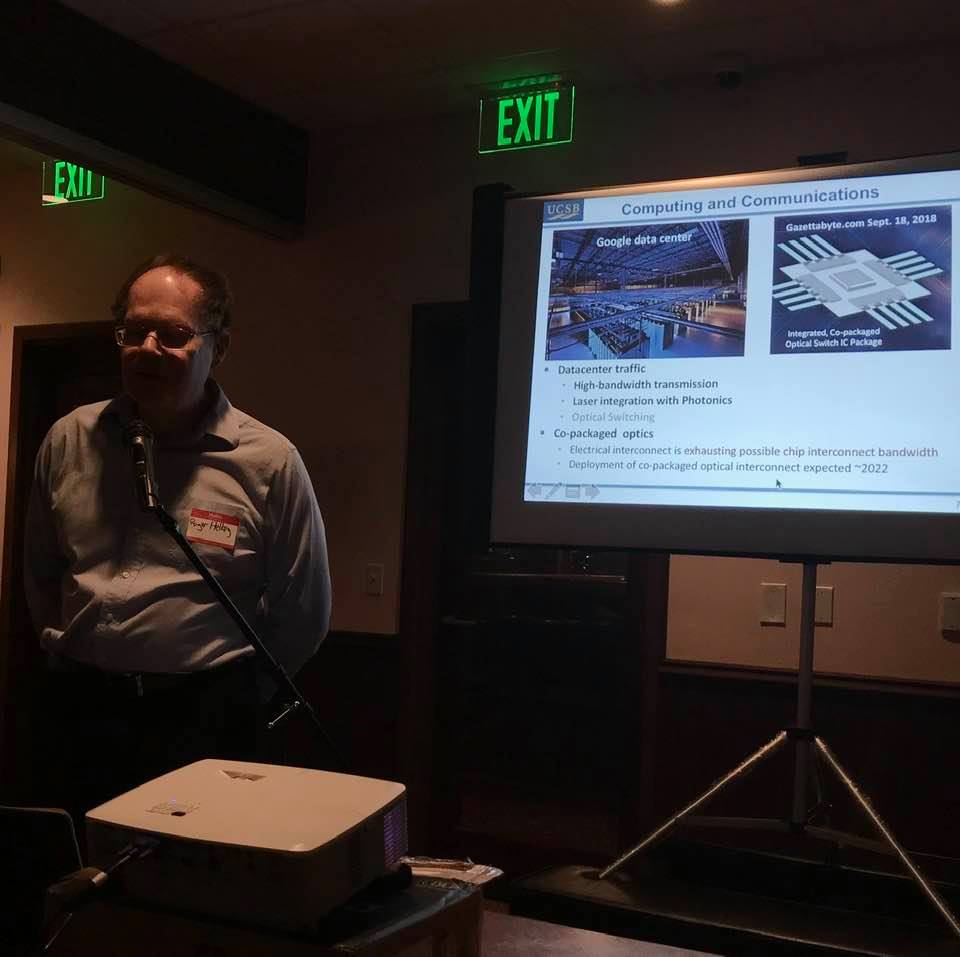
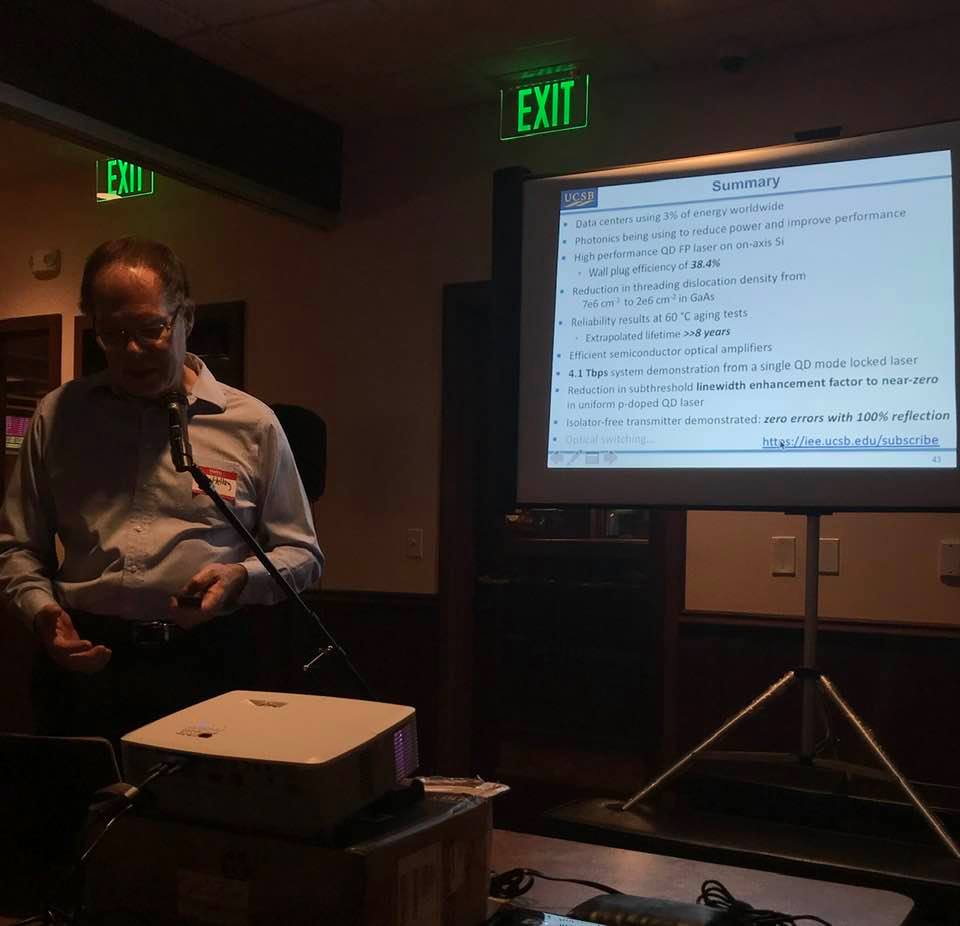
October 2019 speaker: Dr. Mahnoosh Alizadeh
Affiliation: Assistant Professor, Electrical and Computer Engineering Department, UCSBTitle: "Sustainable Electric Transportation Systems"
Date/Time: Wednedsay, October 16, 2019; 6:00 PM (food, beverages), 6:30 PM (talk)
Venue: Rusty's Pizza (large meeting room), 5934 Calle Real, Goleta, CA 93117
Links: Event page on IEEE CCS Web site; Speaker's home page
In a well-attended general talk that generated much spirited discussion, Dr. Mahnoosh Alizadeh (UCSB Assistant Professor of Electrical and Computer Engineering; PhD 2014, UC Davis) outlined the challenges and some solutions in directing our society "Towards Sustainable Electric Transportation Systems."
Everyone agrees that electric vehicles, preferably charged using renewable energy sources, are the way to go. But several challenges remain to be addressed if this worthy goal is to become realizable. While we have come a long way in mitigating the old problem of limited range for electric vehicles, we still need to resolve long wait times at popular charging locations, shifting the charging load to more desirable times of day (e.g., by providing price incentives), upgrading the electric grid infrastructure to support the added load and the changing profile, and coming up with reasonably accurate models for human behavior in the face of varying transportation needs and price incentives.
Professor Alizadeh discussed some parts of her research program, which aims to guide the EV population to use transportation, charging, and power-system infrastructure more efficiently. Her work addresses both long term behavioral and structural modifications, as well as short-term strategies to make the best use of already-available resoruces.

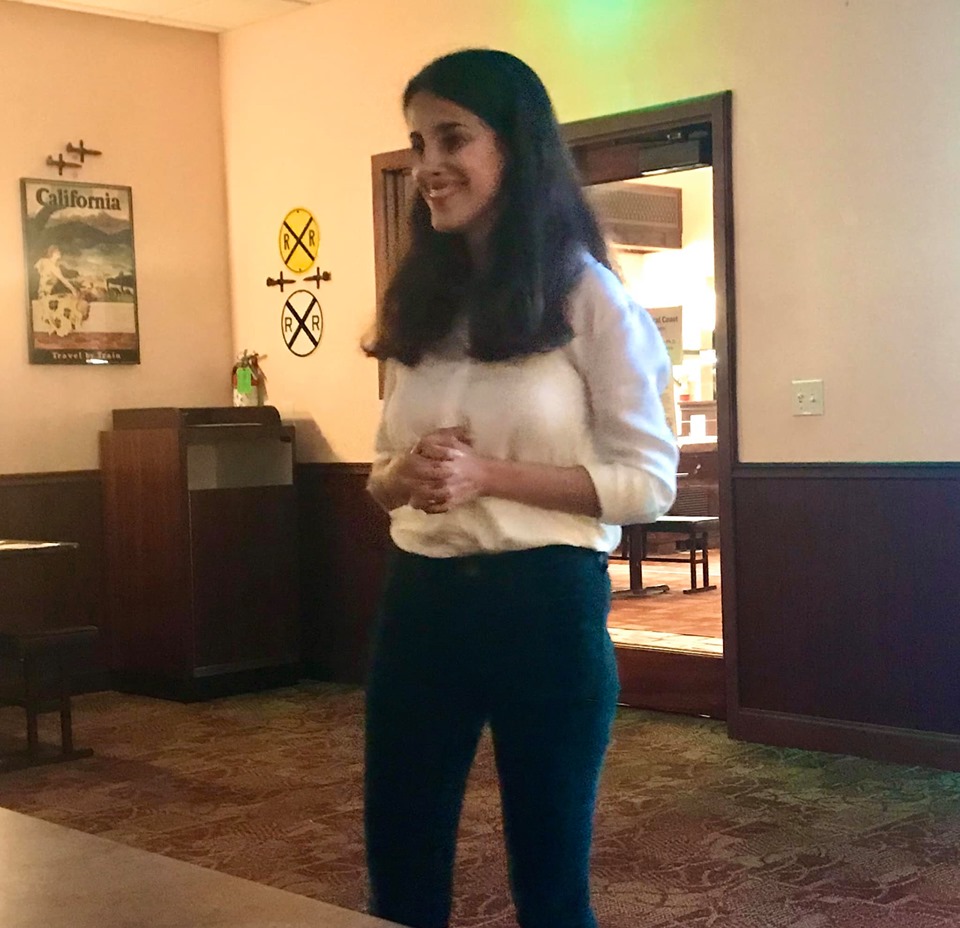
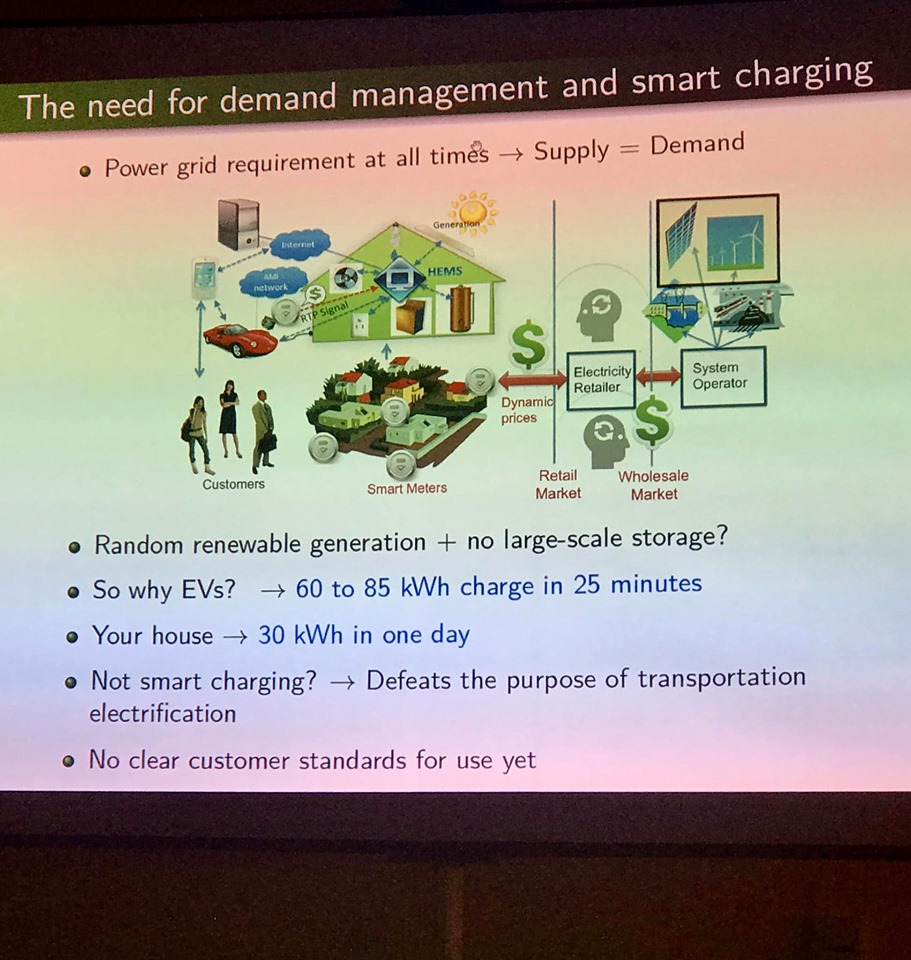
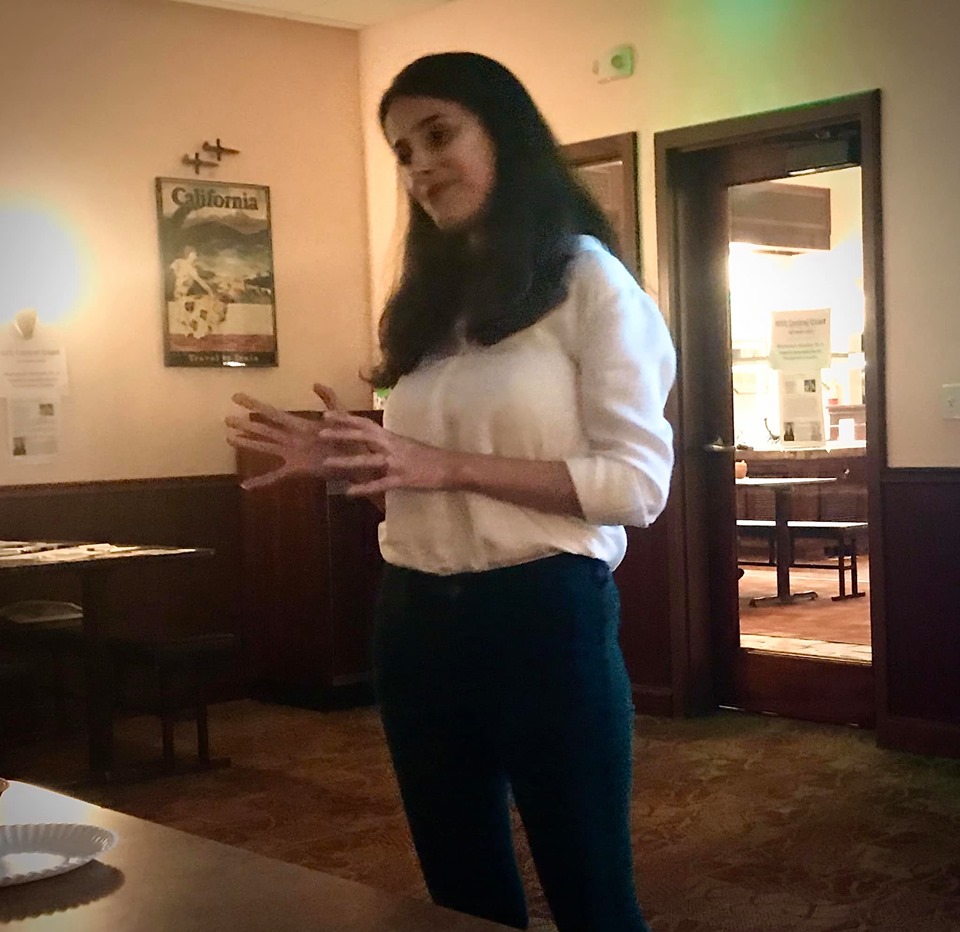
September 2019 speaker: Dr. Yasamin Mostofi
Affiliation: Professor, Electrical and Computer Engineering Department, UCSBTitle: "Robotics Meet Wireless Communications: Opportunities and Challenges"
Date/Time: Wednedsay, September 18, 2019; 6:00 PM (food, beverages), 6:30 PM (talk)
Venue: Rusty's Pizza (large meeting room), 5934 Calle Real, Goleta, CA 93117
Links: Event page on IEEE CCS Web site; Speaker's home page
Abstract: Recent years have seen a great progress in the area of robotics. Communication signals are also ubiquitous these days. In this talk, I will explore the opportunities and challenges at this intersection, for sensing and communication.
In the first part of the talk, I will focus on robotic sensing, and ask the following question: "Can everyday communication signals, such as WiFi signals, give new sensing capabilities to unmanned vehicles?" For instance, imagine two unmanned vehicles arriving behind thick concrete walls. Can they image every square inch of the invisible area through the walls with only WiFi signals? I will show that this is indeed possible, and discuss how our methodology for the co-optimization of path planning and communication has enabled the first demonstration of 3D imaging through walls with only drones and WiFi. I will also discuss other new RF sensing capabilities that have emerged from our approach, such as the first demonstration of through-wall crowd counting and occupancy analytics with only WiFi signals, without relying on people to carry a device, or the first demonstration of person identification through walls with only WiFi signals.
In the second part of the talk, I will focus on communication-aware robotics, a term we coined to refer to robotic systems that explicitly take communication issues into account in their decision making. This is an emerging area of research that not only allows a team of unmanned vehicles to attain the desired connectivity during their operation, but can also extend the connectivity of the existing communication systems through the use of mobility. I will then discuss our latest results along this line. I will show how each robot can realistically model the impact of channel uncertainty for the purpose of path planning. I will then show how the unmanned vehicles can properly co-optimize their communication, sensing and navigation objectives under resource constraints. This co-optimized approach can result in a significant performance improvement and resource saving, as we shall see. I will also discuss the role of human collaboration in these networks.
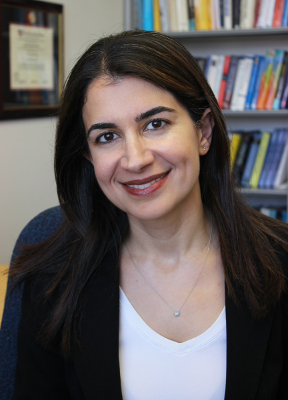
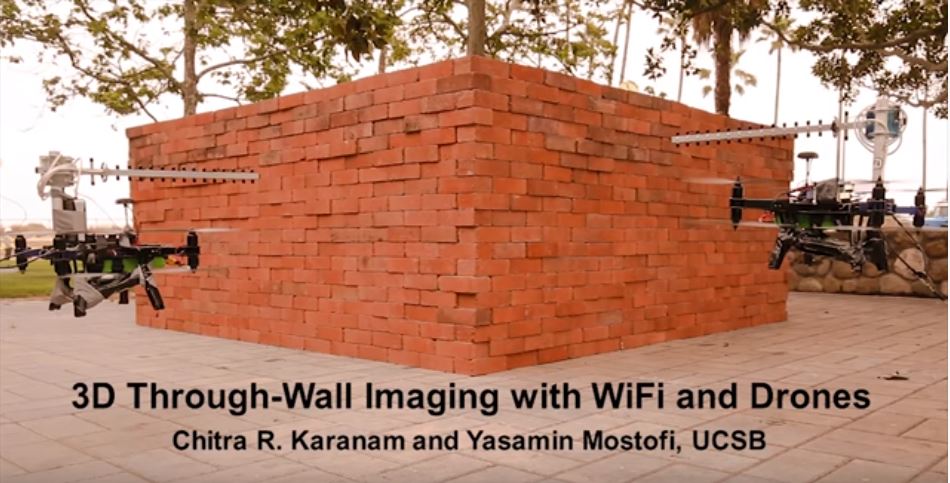
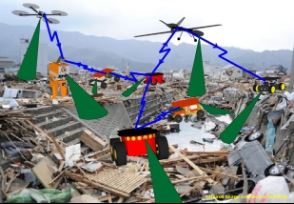
August 2019 speaker: Dr. Tali Freed
Affiliation: Professor, Industrial & Manufacturing Engineering Department, Cal Poly, San Luis ObispoTitle: "UAV-RFID for Outdoor Applications"
Date/Time: Wednedsay, August 21, 2019; 6:00 PM (food, beverages), 6:30 PM (talk)
Venue: Flightline Restaurant and Lounge (large meeting room), 521 Firestone Rd., Goleta, CA 93117
Links: Event page on IEEE CCS Web site; Speaker's home page; 54-minute video of talk
Dr. Freed's talk consisted of three parts. In the first part, she introduced PolyGAIT (Cal Poly's Interdisciplinary Center for Global Automatic Identification Technologies, which she directs), including its mission, collaboraters, and ongoing projects. In the rest of her talk, Dr. Freed discussed two specific ongoing projects.
The first project entails optimizing a UAV-RFID cattle search tour, with the goal of allowing a UAV with limited battery life to optimally scan a pasture for RFID-tagged cattle to determine their locations. Such problems are known to be NP-hard in general, but when the UAV is equipped with long-range sensing capability, the number of cells, the centers of which must be visited to ensure complete coverage of the pasture, is small enough to allow the determination of an optimal tour with acceptable computation time.
The second project concerns the efficient management of oil-field equipment inventory. In way of an example, Dr. Freed mentioned that the tubes forming part of a drilling shaft are tagged with their properties and history, making it easy to locate and use an appropriate set of tubes for a specific drilling task. In this and the previous application, use of a UAV along with RFID tags replaces the labor-intensive process of collecting the required information manually.
The RFID tags used can be active or passive, each category coming in different varieties (with respect to range, say) that affect their costs. The more valuable the assets being managed, the higher the cost that can be justified for RFID tags. As an example, the use of higher-cost, and thus more capable, tags can be justified when race-horses, as opposed to cows, are being monitored.
The talk was preceded by a buffet dinner and followed by a lively discussion period, with many interesting questions and comments. [More photos from Dr. Freed's talk, courtesy of Chris Arnoult.]

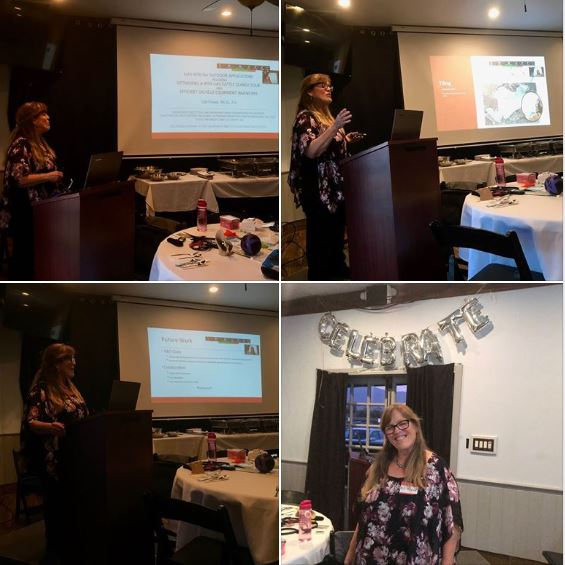
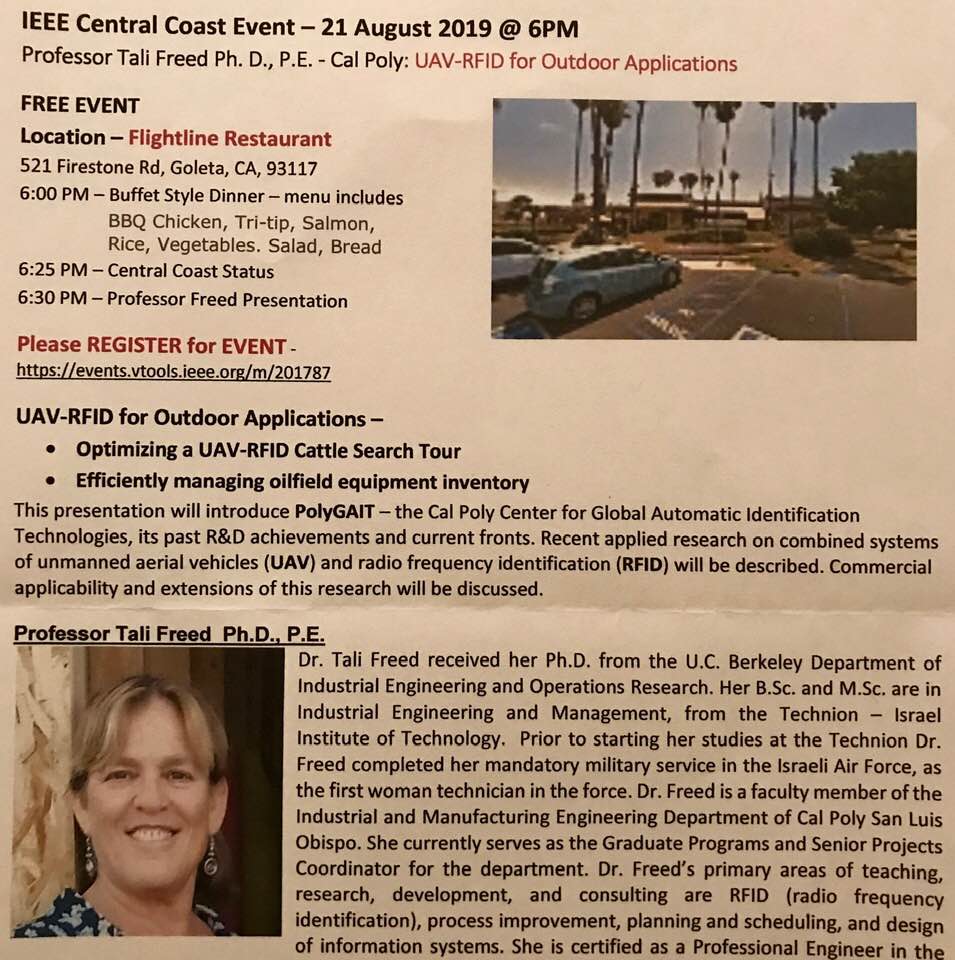
July 2019 speaker: Dr. Dmitri Strukov
Affiliation: Professor, Department of Electrical and Computer Engineering, UCSBDistinguished Lecturer: IEEE Nanotachnology Council
Title: "Alternative Computing with Memristors"
Date/Time: Wednedsay, July 17, 2019; 6:00 PM (food, beverages), 6:30 PM (talk)
Venue: Goleta Public Library (multipurpose room), 500 N. Fairview Ave., Goleta, CA 93117
Links: Event page on IEEE CCS Web site; Slides (forthcoming); Speaker's home page
Dr. Strukov is one of the pioneers of memristive (resistive switching) technology and its applications. Memristors offer two key properties that are essential to brain-inspired or neuromorphic computing: High device density and nonvolatile storage. Dr. Strukov's recent focus has been on metal-oxide memristors, whose 3D version resolves Feynman grand challenge of implementing an 8-bit adder in 50-nm cube. Dr. Strukov covered the application of memristors to neuromorphic and alternative-style computing. He also planned to discuss his lab's work on memristor-based security primitives, but there was insufficient time to do so. Slides for Dr. Strukov's talk will be posted to this page for those who could not attend and interested individuals who would like to review the material not covered.
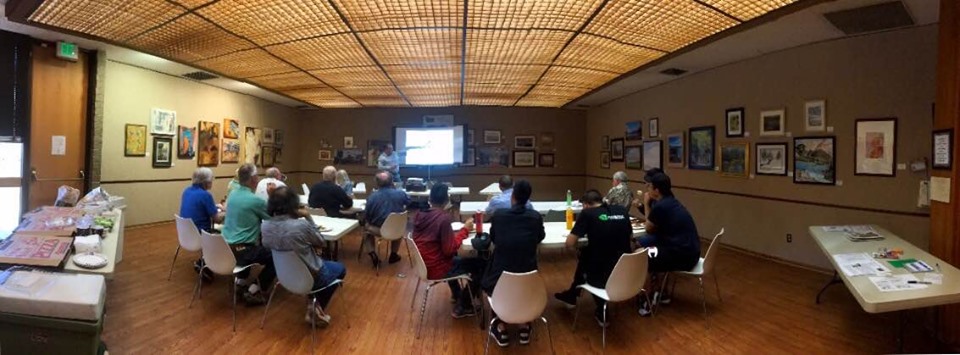
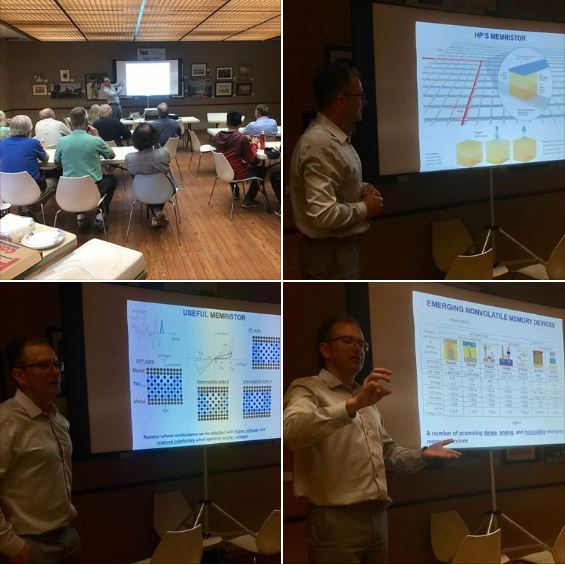
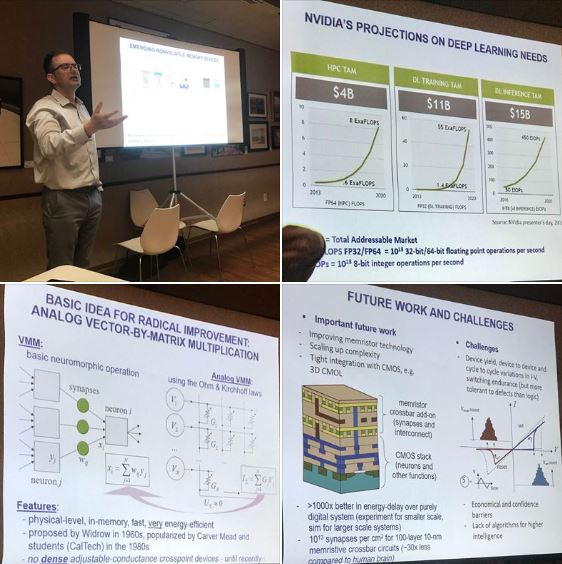
June 2019 speaker: Dr. B. S. Manjunath
Affiliation: Distinguished Professor, Department of Electrical and Computer Engineering, UCSBTitle: "Computer Vision, Deep Learning and Big Data: Opportunities and Challenges"
Date/Time: Wednedsay, June 19, 2019; 6:00 PM (food, beverages), 6:30 PM (talk)
Venue: Rusty's Pizza (large meeting room), 5934 Calle Real, Goleta, CA 93117
Links: Event page on IEEE CCS Web site; Speaker's home page
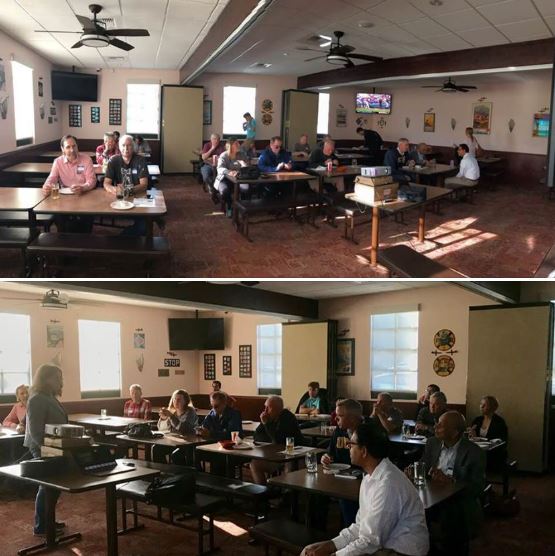
May 2019 speaker: Dr. Katie Byl
Affiliation: Associate Professor, Department of Electrical and Computer Engineering, UCSBTitle: "Mesh-Based Tools to Analyze Deep Reinforcement Learning Policies for Underactuated Biped Locomotion"
Date/Time: Wednedsay, May 15, 2019; 6:00 PM (food, beverages), 6:30 PM (talk)
Venue: Rusty's Pizza (large meeting room), 5934 Calle Real, Goleta, CA 93117
Links: Event page on IEEE CCS Web site; Speaker's home page; Report of the talk on Facebook
[Summary of notes from Dr. Byl, with suggested references and videos: Here is a very good YouTube tutorial describing the algorithm we used: Proximal Policy Optimization (PPO). We actually use the PPO2 implementation by OpenAI, but it's basically PPO. Also, here is the DeepMind video I showed (which is linked to a paper on arXiv). Key takeaways are that there are a lot of hyperparameters to be tuned for this sort of stuff to work for a new problem, and there aren't good methods for verifying/quantifying robustness. Here is some work using deep reinforcement learning for a real quadruped robot in Switzerland (ETH Zurich). We were very excited by the video but a bit more deflated by the actual paper. Little detail was given to any sort of meta-strategy for parameter tuning (which seemed to involve potentially lengthy hand-tuning/guessing by one or more graduate students). Our group is interested in understanding what's actually going on (within a high-dimensional state space) when deep reinforcement learning "works" vs. not, to avoid hand-tuning and to better understand the resulting closed-loop dynamics.]
April 2019 speaker: Dr. Pradeep Sen
Affiliation: Associate Professor, Department of Electrical and Computer Engineering, UCSBTitle: "Monte Carlo Denoising"
Date/Time: Wednedsay, April 17, 2019; 6:00 PM (pizza and refreshments), 6:30 PM (talk)
Venue: Rusty's Pizza (large meeting room), 5934 Calle Real, Goleta, CA 93117
Links: Event page on IEEE CCS Web site; Speaker's home page; Brief report on the talk
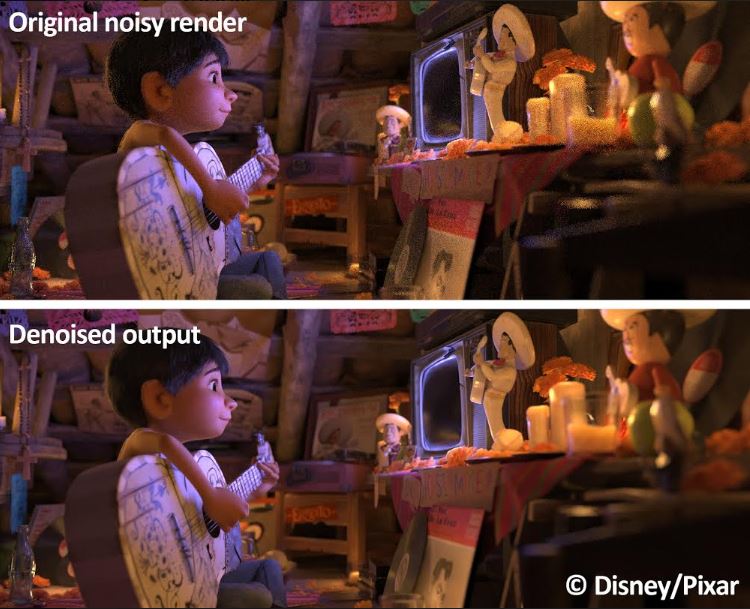
March 2019 speaker: Dr. Walter L. Whipple
Affiliation: Independent consultant; Several IEEE positions, including former Chair of IEEE CCSTitle: "Job Shopping for Fun and Profit: A Step-by-Step Guide to Temporary Assignments in the Gig Economy"
Date/Time: Wednedsay, March 20, 2019; 6:00 PM (pizza, salad, beverages), 6:30 PM (talk)
Venue: Rusty's Pizza (large meeting room), 5934 Calle Real, Goleta, CA 93117
Links: Event page on IEEE CCS Web site
February 2019 speaker: Dr. Behrooz Parhami
Affiliation: Professor, Department of Electrical and Computer Engineering, UCSBTitle: "Promoting Technological Literacy through Mathematical and Logical Puzzles"
Date/Time: Wednedsay, February 20, 2019; 6:00 PM (pizza, salad, beverages), 6:30 PM (talk)
Venue: Rusty's Pizza (large meeting room), 5934 Calle Real, Goleta, CA 93117
Links: Event page on IEEE CCS Web site; PDF slides; Speaker's home page
